TP Link Technologies WR841HPV3 300Mbps High Power Wireless N Router User Manual Users manual
TP-Link Technologies Co., Ltd. 300Mbps High Power Wireless N Router Users manual
Users manual
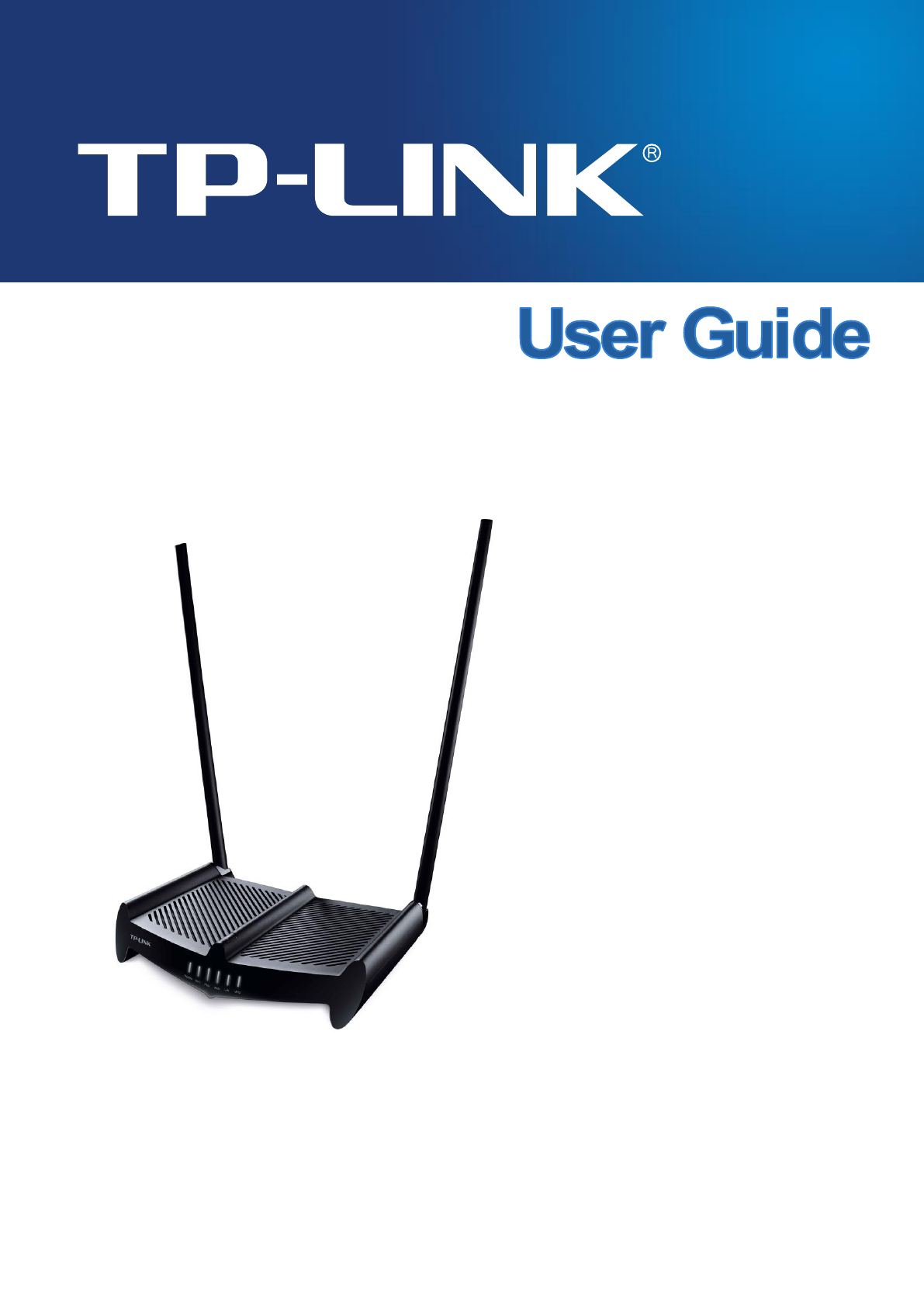
TL-WR841HP
300Mbps High Power Wireless N Router
REV3.0.0
1910011563

COPYRIGHT & TRADEMARKS
Specifications are subject to change without notice. is a registered trademark
of TP-LINK TECHNOLOGIES CO., LTD. Other brands and product names are trademarks or
registered trademarks of their respective holders.
No part of the specifications may be reproduced in any form or by any means or used to make any
derivative such as translation, transformation, or adaptation without permission from TP-LINK
TECHNOLOGIES CO., LTD. Copyright © 2016 TP-LINK TECHNOLOGIES CO., LTD. All rights
reserved.
http://www.tp-link.com

FCC STATEMENT
This equipment has been tested and found to comply with the limits for a Class B digital device,
pursuant to part 15 of the FCC Rules. These limits are designed to provide reasonable protection
against harmful interference in a residential installation. This equipment generates, uses and can
radiate radio frequency energy and, if not installed and used in accordance with the instructions,
may cause harmful interference to radio communications. However, there is no guarantee that
interference will not occur in a particular installation. If this equipment does cause harmful
interference to radio or television reception, which can be determined by turning the equipment off
and on, the user is encouraged to try to correct the interference by one or more of the following
measures:
Reorient or relocate the receiving antenna.
Increase the separation between the equipment and receiver.
Connect the equipment into an outlet on a circuit different from that to which the receiver
is connected.
Consult the dealer or an experienced radio/ TV technician for help.
This device complies with part 15 of the FCC Rules. Operation is subject to the following two
conditions:
1) This device may not cause harmful interference.
2) This device must accept any interference received, including interference that may
cause undesired operation.
Any changes or modifications not expressly approved by the party responsible for compliance
could void the user’s authority to operate the equipment.
Note: The manufacturer is not responsible for any radio or TV interference caused by
unauthorized modifications to this equipment. Such modifications could void the user’s authority
to operate the equipment.
FCC RF Radiation Exposure Statement:
This equipment complies with FCC RF radiation exposure limits set forth for an uncontrolled
environment. This device and its antenna must not be co-located or operating in conjunction with
any other antenna or transmitter.
“To comply with FCC RF exposure compliance requirements, this grant is applicable to only
Mobile Configurations. The antennas used for this transmitter must be installed to provide a
separation distance of at least 20 cm from all persons and must not be co-located or operating in
conjunction with any other antenna or transmitter.”
CE Mark Warning
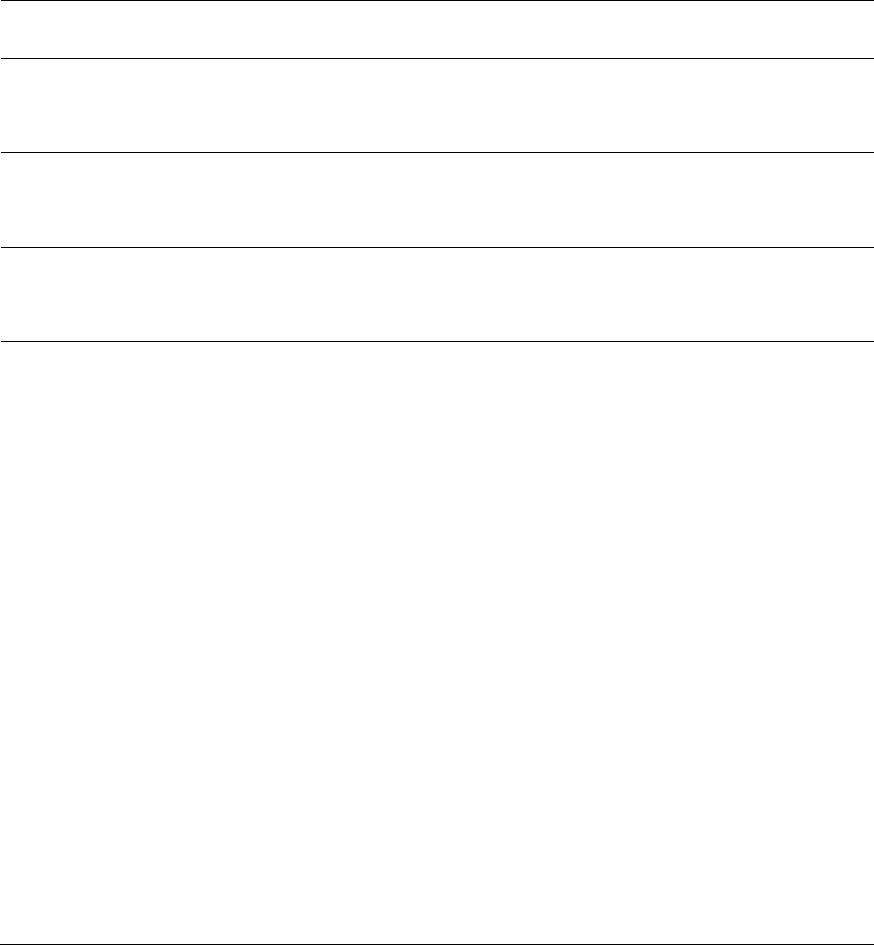
This is a class B product. In a domestic environment, this product may cause radio interference, in
which case the user may be required to take adequate measures.
RF Exposure Information
This device meets the EU requirements (1999/519/EC) on the limitation of exposure of the
general public to electromagnetic fields by way of health protection.
The device complies with RF specifications when the device used at 20 cm from your body.
National Restrictions
This device is intended for home and office use in all EU countries (and other countries following
the EU directive 1999/5/EC) without any limitation except for the countries mentioned below:
Country
Restriction
Reason/remark
Belarus
Not
implemented
Norway
Implemented
This subsection does not apply for the geographical area within
a radius of 20 km from the centre of Ny-Ålesund on Svalbard.
Italy
Implemented
The public use is subject to general authorisation by the
respective service provider.
Russian
Federation
Limited
implementation
1. SRD with FHSS modulation
1.1. Maximum 2.5 mW e.i.r.p.
1.2. Maximum 100 mW e.i.r.p. Permitted for use SRD for
outdoor applications without restriction on installation height
only for purposes of gathering telemetry information for
automated monitoring and resources accounting systems.
Permitted to use SRD for other purposes for outdoor
applications only when the installation height is not exceeding
10 m above the ground surface.
1.3.Maximum 100 mW e.i.r.p. Indoor applications.
2. SRD with DSSS and other than FHSS wideband
modulation
2.1. Maximum mean e.i.r.p. density is 2 mW/MHz. Maximum
100 mW e.i.r.p.

2.2. Maximum mean e.i.r.p. density is 20 mW/MHz. Maximum
100 mW e.i.r.p. It is permitted to use SRD for outdoor
applications only for purposes of gathering telemetry
information for automated monitoring and resources
accounting systems or security systems.
2.3. Maximum mean e.i.r.p. density is 10 mW/MHz. Maximum
100 mW e.i.r.p. Indoor applications.
Ukraine
Limited
implementation
e.i.r.p. ≤100 mW with built-in antenna with amplification factor
up to 6 dBi.
ATTENTION: Due to EU law, the country settings must be identical to the country where the
device is operating (important due to non-harmonised frequencies in the EU).
Canadian Compliance Statement
This device complies with Industry Canada license-exempt RSSs. Operation is subject to the
following two conditions:
1) This device may not cause interference, and
2) This device must accept any interference, including interference that may cause undesired
operation of the device.
Le présent appareil est conforme aux CNR d’Industrie Canada applicables aux appareils radio
exempts de licence. L’exploitation est autorisée aux deux conditions suivantes :
1) l’appareil ne doit pas produire de brouillage;
2) l’utilisateur de l’appareil doit accepter tout brouillage radioélectrique subi, meme si le
brouillage est susceptible d’en compromettre le fonctionnement.
This radio transmitter (IC:8853A-WR841HP/Model:TL-WR841HP) has been approved by Industry
Canada to operate with the antenna types listed below with the maximum permissible gain
indicated. Antenna types not included in this list (Appendix C), having a gain greater than the
maximum gain indicated for that type, are strictly prohibited for use with this device.
Le présent émetteur radio (IC:8853A- WR841HP /Model: TL-WR841HP) a été approuvé par
Industrie Canada pour fonctionner avec les types d'antenne énumérés ci-dessous et ayant un
gain admissible maximal. Les types d'antenne non inclus dans cette liste (Annexe C), et dont le
gain est supérieur au gain maximal indiqué, sont strictement interdits pour l'exploitation de
l'émetteur.
Radiation Exposure Statement:
This equipment complies with IC radiation exposure limits set forth for an uncontrolled

environment. This equipment should be installed and operated with minimum distance 20cm
between the radiator & your body.
Déclaration d'exposition aux radiations:
Cet équipement est conforme aux limites d'exposition aux rayonnements IC établies pour un
environnement non contrôlé. Cet équipement doit être installé et utilisé avec un minimum de 20
cm de distance entre la source de rayonnement et votre corps.
Industry Canada Statement
CAN ICES-3 (B)/NMB-3(B)
Korea Warning Statements:
당해 무선설비는 운용중 전파혼신 가능성이 있음.
NCC Notice & BSMI Notice
注意!
依據 低功率電波輻射性電機管理辦法
第十二條 經型式認證合格之低功率射頻電機,非經許可,公司、商號或使用者均不得擅自變更頻
率、加大功率或變更原設計之特性或功能。
第十四條 低功率射頻電機之使用不得影響飛航安全及干擾合法通行;經發現有干擾現象時,應立
即停用,並改善至無干擾時方得繼續使用。前項合法通信,指依電信規定作業之無線電信。低功率
射頻電機需忍受合法通信或工業、科學以及醫療用電波輻射性電機設備之干擾。
減少電磁波影響,請妥適使用。
安全諮詢及注意事項
請使用原裝電源供應器或只能按照本產品注明的電源類型使用本產品。
清潔本產品之前請先拔掉電源線。請勿使用液體、噴霧清潔劑或濕布進行清潔。
注意防潮,請勿將水或其他液體潑灑到本產品上。
插槽與開口供通風使用,以確保本產品的操作可靠並防止過熱,請勿堵塞或覆蓋開口。
請勿將本產品置放於靠近熱源的地方。除非有正常的通風,否則不可放在密閉位置中。
請不要私自打開機殼,不要嘗試自行維修本產品,請由授權的專業人士進行此項工作。

Продукт сертифіковано згідно с правилами системи УкрСЕПРО на відповідність вимогам
нормативних документів та вимогам, що передбачені чинними законодавчими актами
України.
Safety Information
When product has power button, the power button is one of the way to shut off the product;
when there is no power button, the only way to completely shut off power is to disconnect the
product or the power adapter from the power source.
Don’t disassemble the product, or make repairs yourself. You run the risk of electric shock
and voiding the limited warranty. If you need service, please contact us.
Avoid water and wet locations.
Adapter shall be installed near the equipment and shall be easily accessible. The plug
considered as disconnect device of adapter.
Use only power supplies which are provided by manufacturer and in the original packing
of this product. If you have any questions, please don't hesitate to contact us.
Alert to service person
CAUTION
DOUBLE POLE / NEUTRAL FUSING
This product can be used in the following countries:
AT
BG
BY
CA
CZ
DE
DK
EE
ES
FI
FR
GB
GR
HU
IE
IT
LT
LV
MT
NL
NO
PL
PT
RO
RU
SE
SG
SK
TR
UA
US

Explanation of the symbols on the product label
Symbol
Explanation
RECYCLING
This product bears the selective sorting symbol for Waste electrical and electronic
equipment (WEEE). This means that this product must be handled pursuant to
European directive 2012/19/EU in order to be recycled or dismantled to minimize
its impact on the environment.
User has the choice to give his product to a competent recycling organization or to
the retailer when he buys a new electrical or electronic equipment.
DC voltage

TP-LINK TECHNOLOGIES CO., LTD
TP-LINK TECHNOLOGIES CO., LTD.
Building 24 (floors 1, 3, 4, 5), and 28 (floors 1-4) Central Science and Technology Park, Shennan Rd,
Nanshan, Shenzhen, China
DECLARATION OF CONFORMITY
For the following equipment:
Product Description: 300Mbps High Power Wireless N Router
Model No.: TL-WR841HP
Trademark: TP-LINK
We declare under our own responsibility that the above products satisfy all the technical
regulations applicable to the product within the scope of Council Directives:
Directives 1999/5/EC, Directives 2004/108/EC, Directives 2006/95/EC, Directives 1999/519/EC,
Directives 2011/65/EU
The above product is in conformity with the following standards or other normative documents
EN 300 328 V1.9.1
EN 301 489-1 V1.9.2 & EN 301 489-17 V2.2.1
EN 55022: 2010 + AC: 2011
EN 55024: 2010
EN 60950-1: 2006 + A11: 2009 + A1: 2010 + A12: 2011 + A2: 2013
EN 50385: 2002
EN 50581: 2012
The product carries the CE Mark:
Person responsible for making this declaration:
Yang Hongliang
Product Manager of International Business
Date of issue: Dec.20, 2015
EN61000-3-2:2014/EN61000-3-3:2013
I
CONTENTS
Package Contents ....................................................................................................... 1
Chapter 1. Introduction ............................................................................................. 2
1.1 Overview of the Router ................................................................................................... 2
1.2 Conventions .................................................................................................................... 2
1.3 Main Features ................................................................................................................. 3
1.4 Panel Layout ................................................................................................................... 4
1.4.1 The Front Panel .................................................................................................. 4
1.4.2 The Rear Panel ................................................................................................... 5
Chapter 2. Connecting the Internet .......................................................................... 6
2.1 System Requirements .................................................................................................... 6
2.2 Installation Environment Requirements .......................................................................... 6
2.3 TCP/IP Configuration ...................................................................................................... 6
2.4 Connecting the router ..................................................................................................... 8
2.4.1 Before you start ................................................................................................... 8
2.4.2 Router Mode ....................................................................................................... 9
2.4.3 Range Extender Mode ...................................................................................... 11
2.4.4 Access Point Mode ........................................................................................... 13
Chapter 3. Configuration for Router Mode ............................................................ 16
3.1 Login ............................................................................................................................. 16
3.2 Quick Setup .................................................................................................................. 16
3.3 Basic ............................................................................................................................. 16
3.3.1 Network Map ..................................................................................................... 16
3.3.2 Internet .............................................................................................................. 17
3.3.3 Wireless ............................................................................................................ 22
3.3.4 Guest Network .................................................................................................. 23
3.4 Advanced ...................................................................................................................... 23
3.4.1 Status ................................................................................................................ 24
3.4.2 Network ............................................................................................................. 25
3.4.3 Wireless ............................................................................................................ 35
3.4.4 Wireless Statistics ............................................................................................. 45
3.4.5 Guest Network .................................................................................................. 46
3.4.6 DHCP ................................................................................................................ 48
3.4.7 Forwarding ........................................................................................................ 51
3.4.8 Security ............................................................................................................. 56
II
3.4.9 Parental Control ................................................................................................ 62
3.4.10 Access Control .................................................................................................. 64
3.4.11 Advanced Routing ............................................................................................. 74
3.4.12 Bandwidth Control ............................................................................................. 76
3.4.13 IP & MAC Binding ............................................................................................. 78
3.4.14 ARP List ............................................................................................................ 80
3.4.15 Dynamic DNS ................................................................................................... 80
3.4.16 No-IP DDNS ...................................................................................................... 82
3.4.17 IPv6 Support ..................................................................................................... 83
3.4.18 System Tools ..................................................................................................... 93
3.4.19 Diagnostic ......................................................................................................... 96
3.4.20 Firmware Upgrade ............................................................................................ 97
Chapter 4. Range Extender Mode ......................................................................... 106
4.1 Login and switch the working mode ........................................................................... 106
4.2 Quick Setup ................................................................................................................ 106
4.3 Setting ......................................................................................................................... 106
4.3.1 Status .............................................................................................................. 106
4.3.2 Network ........................................................................................................... 107
4.3.3 Wireless .......................................................................................................... 109
4.3.4 DHCP .............................................................................................................. 118
4.3.5 System Tools ................................................................................................... 122
Chapter 5. Access Point Mode ............................................................................. 133
5.1 Login and switch the working mode ........................................................................... 133
5.2 Quick Setup ................................................................................................................ 133
5.3 Setting ......................................................................................................................... 133
5.3.1 Status .............................................................................................................. 133
5.3.2 Network ........................................................................................................... 134
5.3.3 Wireless .......................................................................................................... 136
5.3.4 Guest Network ................................................................................................ 147
5.3.5 DHCP .............................................................................................................. 148
5.3.6 System Tools ................................................................................................... 152
Appendix A: FAQ..................................................................................................... 163
Appendix B: Configuring the PCs ......................................................................... 169
Appendix C: Specifications .................................................................................... 173
Appendix D: Glossary ............................................................................................ 174

-1-
TL-WR841HP
300Mbps High Power Wireless N Router
Package Contents
The following items should be found in your package:
TL-WR841HP 300Mbps High Power Wireless N Router
DC Power Adapter
Quick Installation Guide
Ethernet Cable
Note:
Make sure that the package contains the above items. If any of the listed items is damaged or
missing, please contact with your distributor.

-2-
TL-WR841HP
300Mbps High Power Wireless N Router
Chapter 1. Introduction
1.1 Overview of the Router
The TL-WR841HP 300Mbps High Power Wireless N Router integrates 4-port Switch, Firewall,
NAT-Router and Wireless AP. The 300Mbps High Power Wireless N Router delivers exceptional
range and speed, which can fully meet the need of Small Office/Home Office (SOHO) networks
and the users demanding higher networking performance.
The TL-WR841HP 300Mbps High Power Wireless N Router provides up to 300Mbps wireless
connection with other 802.11n wireless clients. The incredible speed makes it ideal for handling
multiple data streams at the same time, which ensures your network stable and smooth. The
performance of this 802.11n wireless router will give you the unexpected networking experience at
speed 650% faster than 802.11g. It is also compatible with all IEEE 802.11g and IEEE 802.11b
products.
With multiple protection measures, including SSID broadcast control and wireless LAN
64/128/152-bit WEP encryption, Wi-Fi protected Access (WPA2-PSK, WPA-PSK), as well as
advanced Firewall protections, the TL-WR841HP 300Mbps High Power Wireless N Router
provides complete data privacy.
The TL-WR841HP 300Mbps High Power Wireless N Router provides flexible access control, so
that parents or network administrators can establish restricted access policies for children or staff. It
also supports Virtual Server and DMZ host for Port Triggering, and then the network administrators
can manage and monitor the network in real time with the remote management function.
Since the router is compatible with virtually all the major operating systems, it is very easy to
manage. Quick Setup Wizard is supported and detailed instructions are provided step by step in
this user guide. Before installing the router, please look through this guide to know all the
router’s functions.
1.2 Conventions
The router or TL-WR841HP mentioned in this guide stands for TL-WR841HP 300Mbps High Power
Wireless N Router without any explanation.
Simple Installation
Flexible Access Control
AccessontroInstallation
Multiple Security Protections
Incredible Speed
AccessontroInstallation

-3-
TL-WR841HP
300Mbps High Power Wireless N Router
1.3 Main Features
Complies with IEEE 802.11n to provide a wireless data rate of up to 300Mbps.
One 10/100M Auto-Negotiation RJ45 WAN port, four 10/100M Auto-Negotiation RJ45 LAN
ports, supporting Auto MDI/MDIX.
Provides WPA/WPA2, WPA-PSK/WPA2-PSK authentication, TKIP/AES encryption
security.
Shares data and Internet access for users, supporting Dynamic IP/Static IP/PPPoE Internet
access.
Supports Virtual Server, Special Application and DMZ host.
Supports UPnP, Dynamic DNS, Static Routing.
Provides Automatic-connection and Scheduled Connection on certain time to the Internet.
Built-in NAT and DHCP server supporting static IP address distributing.
Built-in firewall supporting IP address filtering, Domain Name filtering, and MAC address
filtering.
Connects Internet on demand and disconnects from the Internet when idle for PPPoE.
Provides 64/128/152-bit WEP encryption security and wireless LAN ACL (Access Control
List).
Supports Flow Statistics.
Support three working mode: Router, Range Extender, Access Point
Supports firmware upgrade and Web management.
Supports Tether App to manage the router on smart devices.
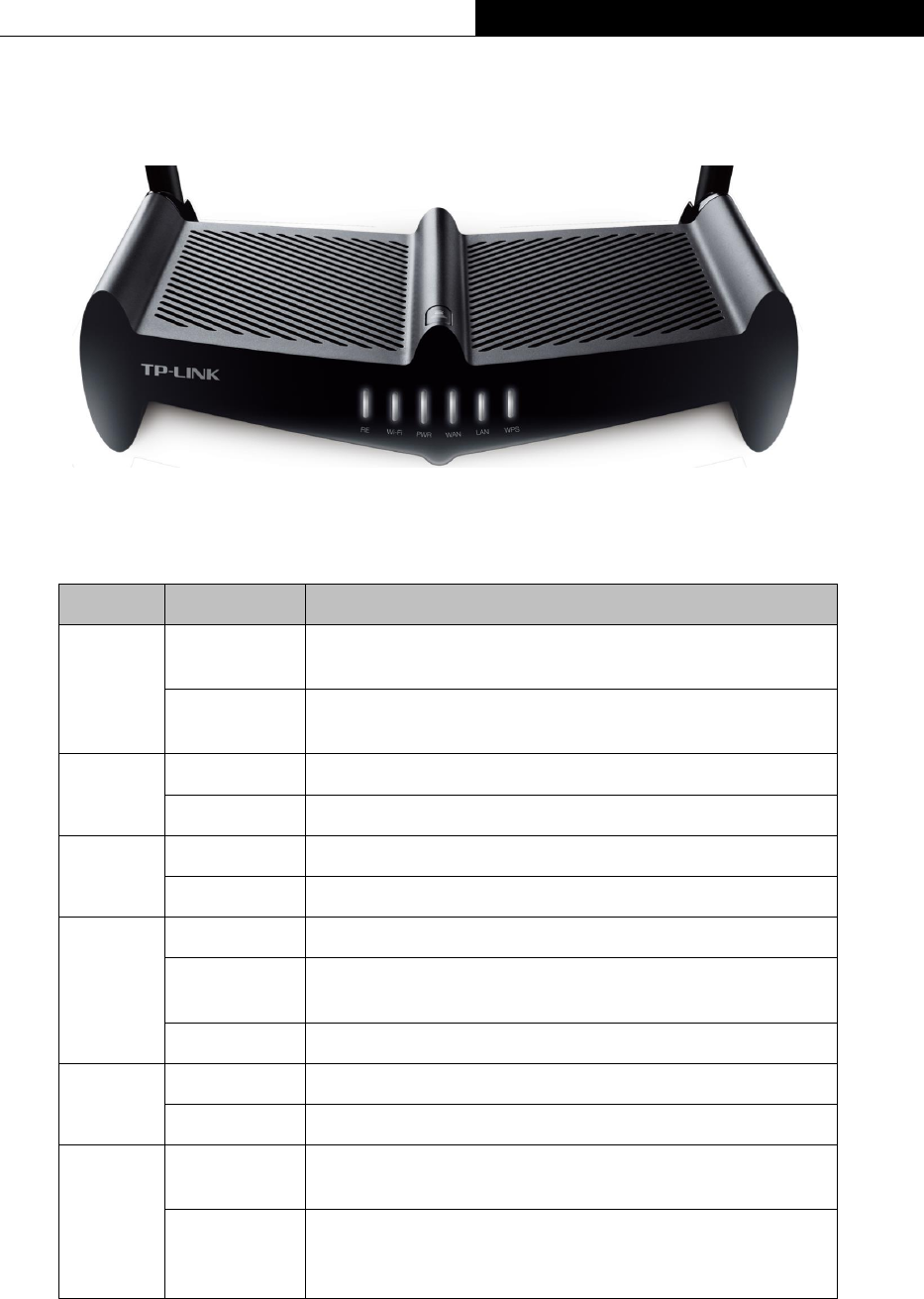
-4-
TL-WR841HP
300Mbps High Power Wireless N Router
1.4 Panel Layout
1.4.1 The Front Panel
Figure 1-1 Front Panel
The router’s LEDs are located on the front panel (View from left to right).
Name
Status
Indication
RE
Blinking
The router is connecting to the host network. This
process will last in the first 2 minutes.
On
The router has been successfully connected to the host
network, and it is working in Range Extender mode.
Wi-Fi
Off
The wireless function is disabled.
On
The wireless function is enabled.
PWR
Blinking
The router is updating or initializing.
On
The router is working in a normal status.
WAN
Off
No connection.
On(Orange)
The router’s Internet port has been connected but the
Internet is unavailable.
On
The Internet is available.
LAN
On
There is a device connected to the corresponding port.
Off
No connection.
WPS
Blinking
A wireless device is connecting to the network by WPS
function. This process will last in the first 2 minutes.
On
A wireless device has been successfully added to the
network by WPS function. The WPS LED will be off
after 5 minutes.
Table 1-1 The LEDs description
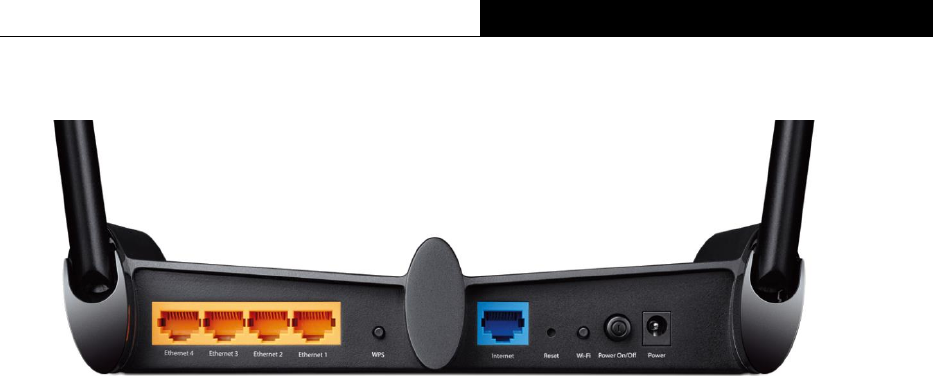
-5-
TL-WR841HP
300Mbps High Power Wireless N Router
1.4.2 The Rear Panel
Figure 1-2 Rear Panel sketch
The following parts are located on the rear panel (View from left to right).
Ethernet (1, 2, 3, 4): These ports (1, 2, 3, 4) connect the router to the local PC(s).
WPS: If your clients, such as wireless adapters, that support Wi-Fi Protected Setup, then
you can press this button to quickly establish a connection between the router and clients
and automatically configure wireless security for your wireless network. The wireless
security will be automatically configured for your wireless network.
Internet: This port is where you will connect the DSL/cable Modem, or Ethernet.
Reset: With the router powered on, press and hold the Reset button until all LEDs turn
back on momentarily. And then release the button and wait the router to reboot to its factory
default settings.
Wi-Fi: The button for the wireless function. Press and hold the wireless button for about 2
seconds to turn it on or off.
Power On/Off: The switch for the power.
Power: The Power socket is where you will connect the power adapter. Please use the
power adapter provided.
Wireless antenna: To receive and transmit the wireless data.

-6-
TL-WR841HP
300Mbps High Power Wireless N Router
Chapter 2. Connecting the Internet
2.1 System Requirements
Broadband Internet Access Service (DSL/Cable/Ethernet)
One DSL/Cable Modem that has an RJ45 connector (which is not necessary if the router is
connected directly to the Ethernet.)
PCs with a working Ethernet Adapter and an Ethernet cable with RJ45 connectors
TCP/IP protocol on each PC
Web browser, such as Microsoft Internet Explorer, Mozilla Firefox or Apple Safari
2.2 Installation Environment Requirements
Place the router in a well-ventilated place far from any heater or heating vent
Avoid direct irradiation of any strong light (such as sunlight)
Keep at least 2 inches (5 cm) of clear space around the router
Operating Temperature: 0℃~40℃ (32℉~104℉)
Operating Humidity: 10%~90%RH, Non-condensing
2.3 TCP/IP Configuration
The default domain name of the 300Mbps High Power Wireless N Router is http://tplinkwifi.net,
the default IP address is 192.168.0.1, and the default Subnet Mask is 255.255.255.0. These
values can be changed as you desire. In this guide, we all use the default values for description.
Connect the local PC to the Ethernet ports of the router, and then you can configure the IP
address for your PC by following the steps below:
1) Set up the TCP/IP Protocol in "Obtain an IP address automatically" mode on your PC. If
you need instructions as to how to do this, please refer to Appendix B: Configuring the
PCs.
2) Then the built-in DHCP server will assign IP address for the PC.
Now, you can run the Ping command in the command prompt to verify the network connection
between your PC and the router. The following example is in Windows XP.
Open a command prompt, and type ping 192.168.0.1, and then press Enter.
If the result displayed is similar to the Figure 2-1, it means the connection between your PC
and the router has been established well.
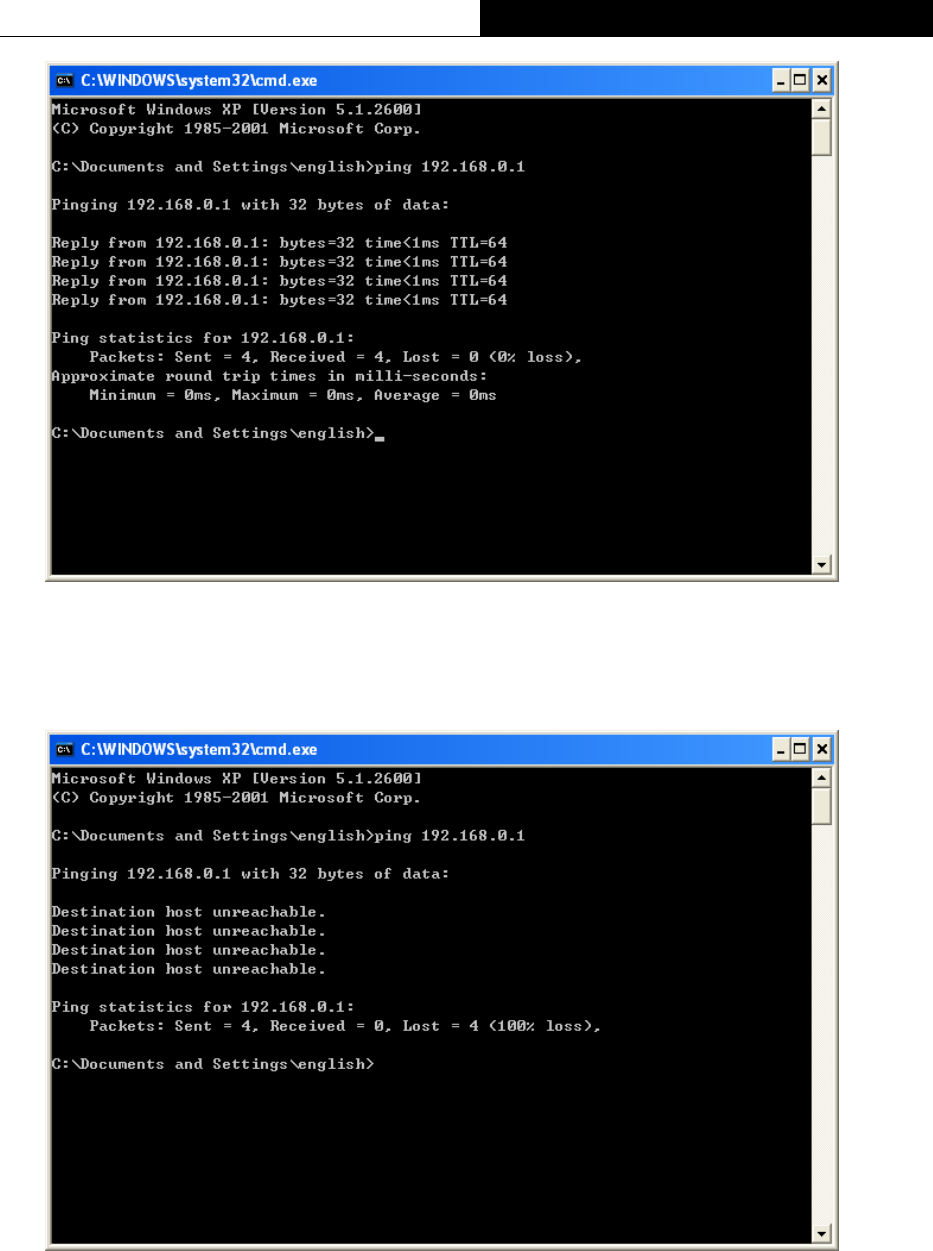
-7-
TL-WR841HP
300Mbps High Power Wireless N Router
Figure 2-1 Success result of Ping command
If the result displayed is similar to the Figure 2-2, it means the connection between your PC
and the router failed.
Figure 2-2 Failure result of Ping command
Please check the connection following these steps:
1. Is the connection between your PC and the router correct?
Note:
The 1/2/3/4 LEDs of Ethernet ports which you link to on the router and LEDs on your PC's
adapter should be lit.

-8-
TL-WR841HP
300Mbps High Power Wireless N Router
2. Is the TCP/IP configuration for your PC correct?
Note:
If the router's IP address is 192.168.0.1, your PC's IP address must be within the range of
192.168.0.2 ~ 192.168.0.254.
3. Try the IP address 192.168.0.1.
Note:
If the LAN IP of the modem connected with your router is 192.168.0.x, the default LAN IP of the
router will automatically switch from 192.168.0.1 to 192.168.1.1 to avoid IP conflict. Therefore,
in order to verify the network connection between your PC and the router, you can open a
command prompt, and type ping 192.168.1.1, and then press Enter.
2.4 Connecting the router
2.4.1 Before you start
Before installing the Router, please make sure your broadband service provided by your ISP is
available. If there is any problem, please contact with your ISP.
Please choose the operation mode you need and carry out the corresponding steps. There are
three operation modes supported by this router: Router, Range Extender and Access Point.
Please install the Antennas first by following the steps shown below before your start to use the
router.
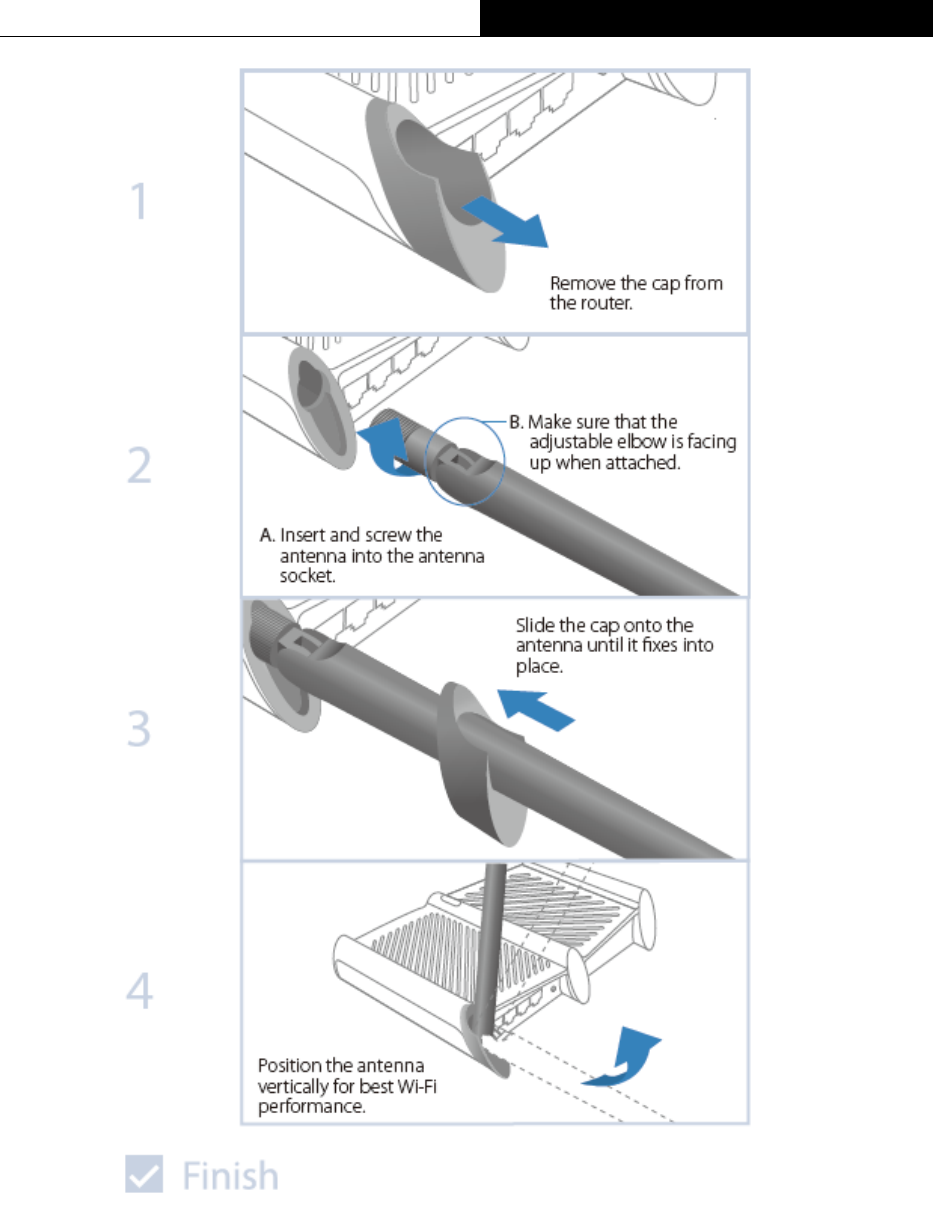
-9-
TL-WR841HP
300Mbps High Power Wireless N Router
2.4.2 Router Mode
This mode enables multiple users to share Internet connection via ADSL/Cable Modem.
2.4.2.1. Hardware Connection
If your Internet connection is through an Ethernet cable from the wall instead of through a DSL /
Cable / Satellite modem, connect the Ethernet cable directly to the router’s Internet port, then
follow steps 3 and 5 to complete the hardware connection.
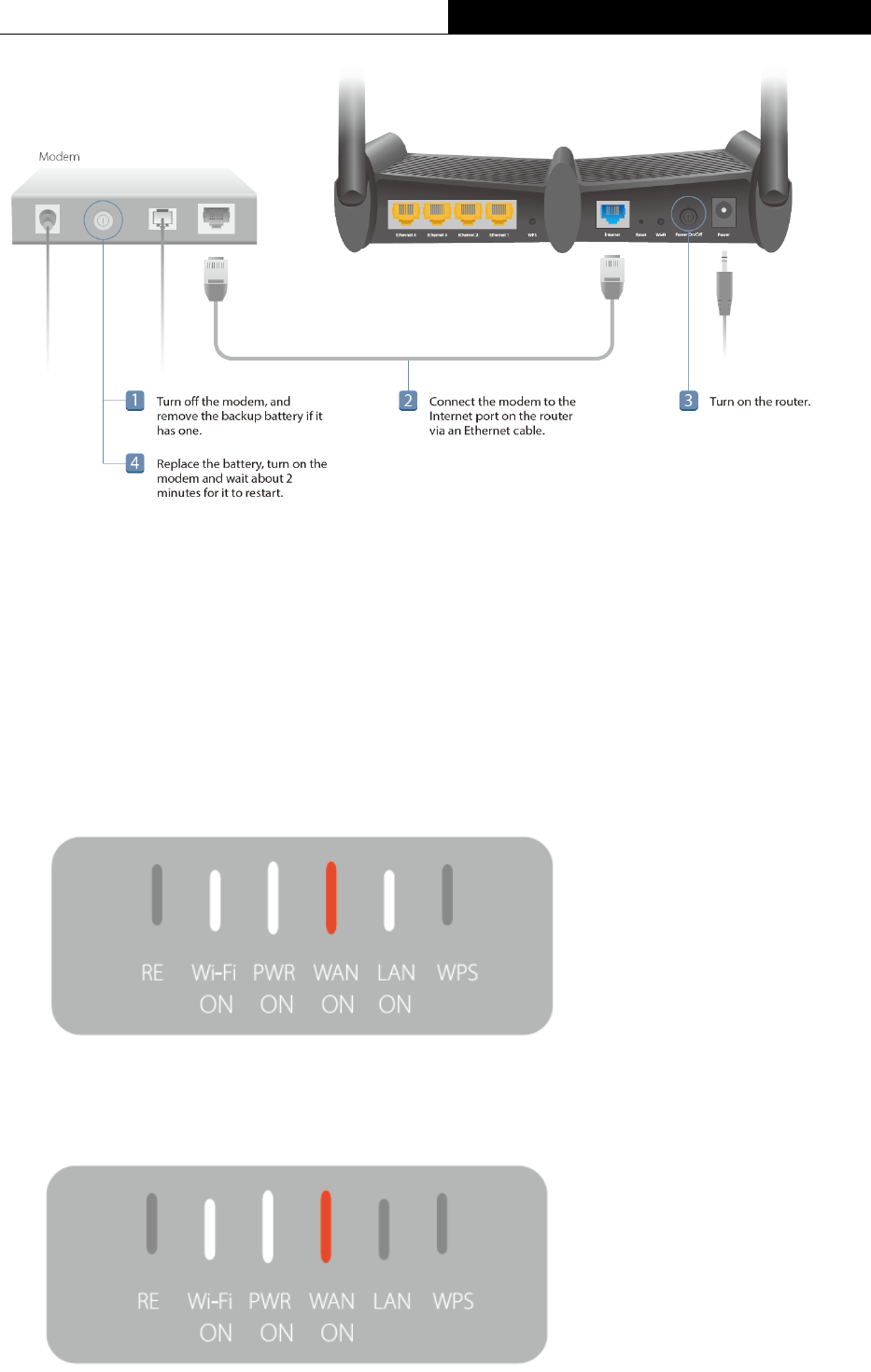
-10-
TL-WR841HP
300Mbps High Power Wireless N Router
1. Turn off the modem, and remove the backup battery if it has one.
2. Connect the modem to the Internet port on the router via an Ethernet cable.
3. Turn on the router.
4. Put the battery back, turn on the modem and wait about 2 minutes for it to restart.
5. Connect your devices to the router and check the LED lights.
Wired: Connect your computer to the router (LAN port) via an Ethernet cable.
Wireless: Connect wirelessly by using the SSID (network name) and password printed on
the bottom label of the router.
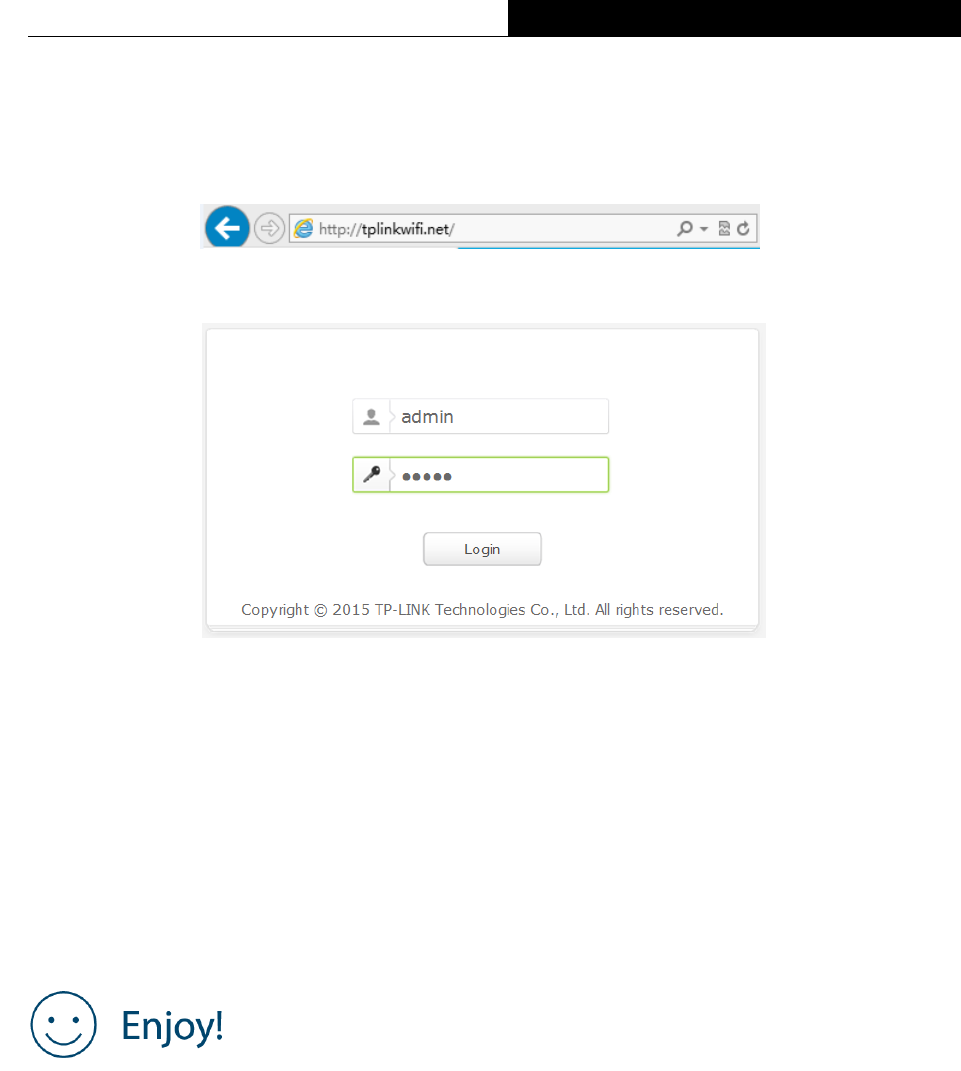
-11-
TL-WR841HP
300Mbps High Power Wireless N Router
2.4.2.2. Login and Quick Setup
1. Enter http://tplinkwifi.net in the address bar of a web browser. Use admin for both
username and password, and then click Login.
Figure 2-3 Login the Router
Figure 2-4 Login Windows
Note:
If the above screen does not pop-up, it means that your Web-browser has been set to a proxy.
Go to Tools menu > Internet Options > Connections > LAN Settings, in the screen that appears,
cancel the Using Proxy checkbox, and click OK to finish it.
2. After successfully login, follow Quick Setup to complete the configuration. For wireless
devices, you may have to reconnect to the wireless network if you have customized the
SSID (wireless name) and password during the configuration.
2.4.3 Range Extender Mode
This mode boosts your home wireless coverage.
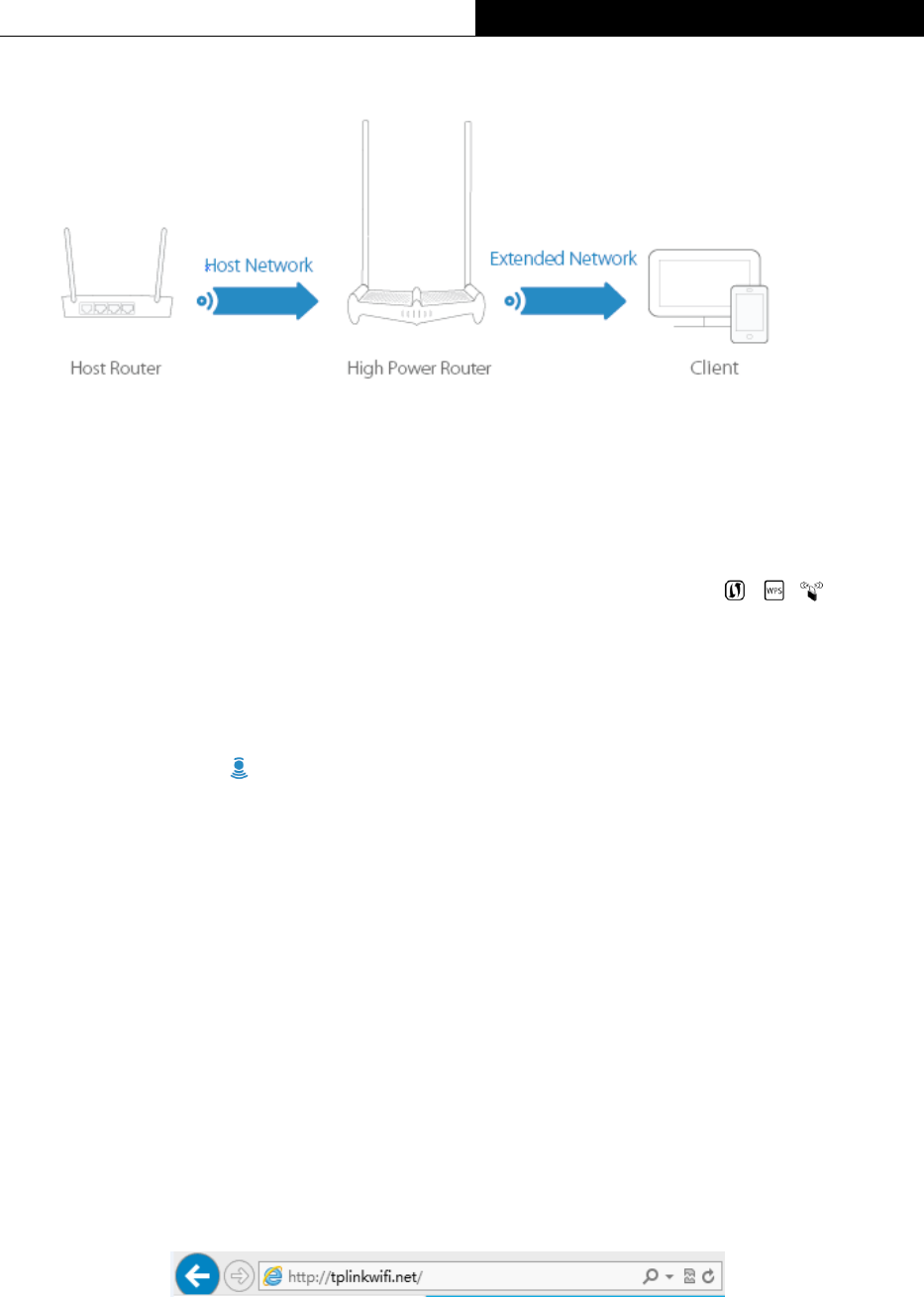
-12-
TL-WR841HP
300Mbps High Power Wireless N Router
2.4.3.1. Step one: configure
Using RE Button is an easy way to extend your host network. We recommend you to use this
way if your host router has the WPS button. The button might look like these:
Option One: Using RE Button
1. Press the WPS button on the host router.
2. Press and hold the RE button on the top panel of router for about 3 seconds within 1
minute. The router will start to reboot.
3. After rebooted, the RE LED should change from blinking to a solid state, indicating a
successful connection.
Note:
If not, please refer to the Option Two.
Option Two: Using Web Browser
1. Connect a computer to the router via an Ethernet cable or wirelessly by using the SSID
(wireless name) and password printed on the bottom label of the router.
3. Enter http://tplinkwifi.net in the address bar of a web browser. Use admin for both
username and password, and then click Login.
Figure 2-5 Login the Router
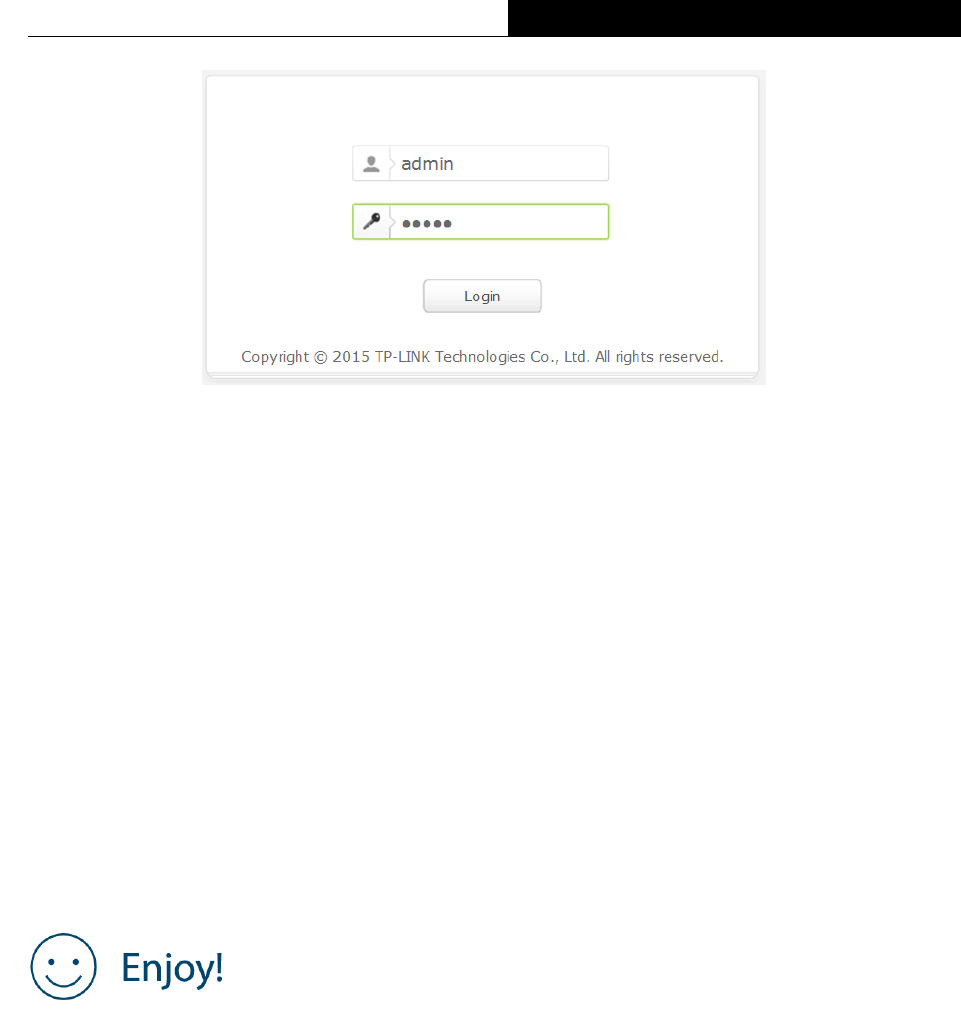
-13-
TL-WR841HP
300Mbps High Power Wireless N Router
Figure 2-6 Login Windows
Note:
If the above screen does not pop-up, it means that your Web-browser has been set to a proxy.
Go to Tools menu > Internet Options > Connections > LAN Settings, in the screen that appears,
cancel the Using Proxy checkbox, and click OK to finish it.
4. After successfully login, follow Quick Setup to complete the configuration.
Make sure to choose Range Extender and click Survey to choose your host network and
fill in its wireless password.
2.4.3.2. STEP 2: Relocate
Place the router between your host router and the Wi-Fi dead zone. The location you choose
must be within the range of your existing host network.
The extended network shares the same SSID(wireless name) and password as your host
network.
2.4.4 Access Point Mode
2.4.4.1. Hardware connection
This mode can help you to transform your existing wired network to a wireless network.
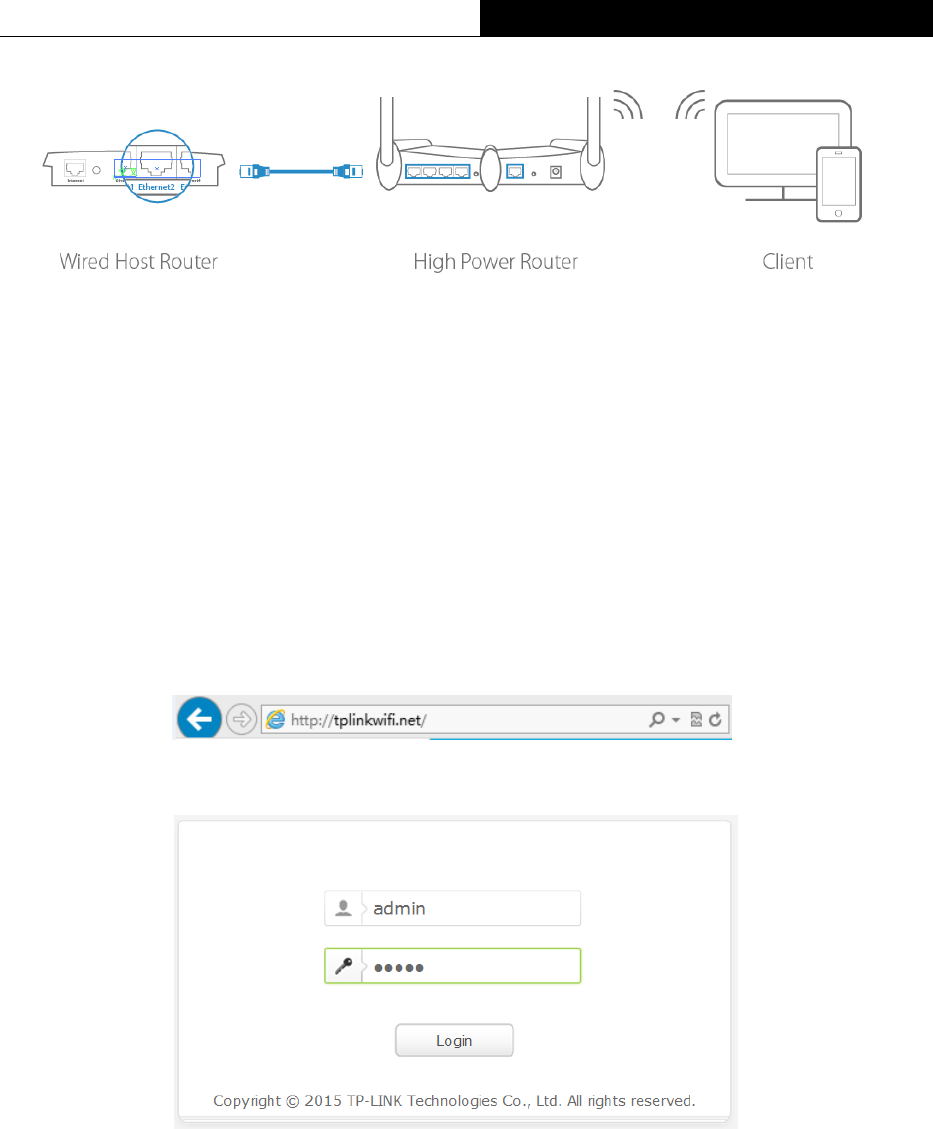
-14-
TL-WR841HP
300Mbps High Power Wireless N Router
1. Turn on the router.
2. Connect the router to your wired host router’s Ethernet port via an Ethernet cable as shown
above.
3. Connect a computer to the router via an Ethernet cable or wirelessly by using the SSID
(network name) and password printed on the bottom label of the router.
2.4.4.2. Login and Quick Setup
1. Enter http://tplinkwifi.net in the address bar of a web browser. Use admin for both
username and password, and then click Login.
Figure 2-7 Login the Router
Figure 2-8 Login Windows
Note:
If the above screen does not pop-up, it means that your Web-browser has been set to a proxy.
Go to Tools menu > Internet Options > Connections > LAN Settings, in the screen that appears,
cancel the Using Proxy checkbox, and click OK to finish it.
2. After successfully login, Click Mode button on the top-right corner of the Web Management
Page and choose Access Point and then click Save. The router will reboot automatically.
Note:
If you want to change the default SSID(network name) and the password, please follow
Quick Setup to complete the configuration.

-15-
TL-WR841HP
300Mbps High Power Wireless N Router
Connect to the wireless network by using the SSID (wireless name) and password of the router.
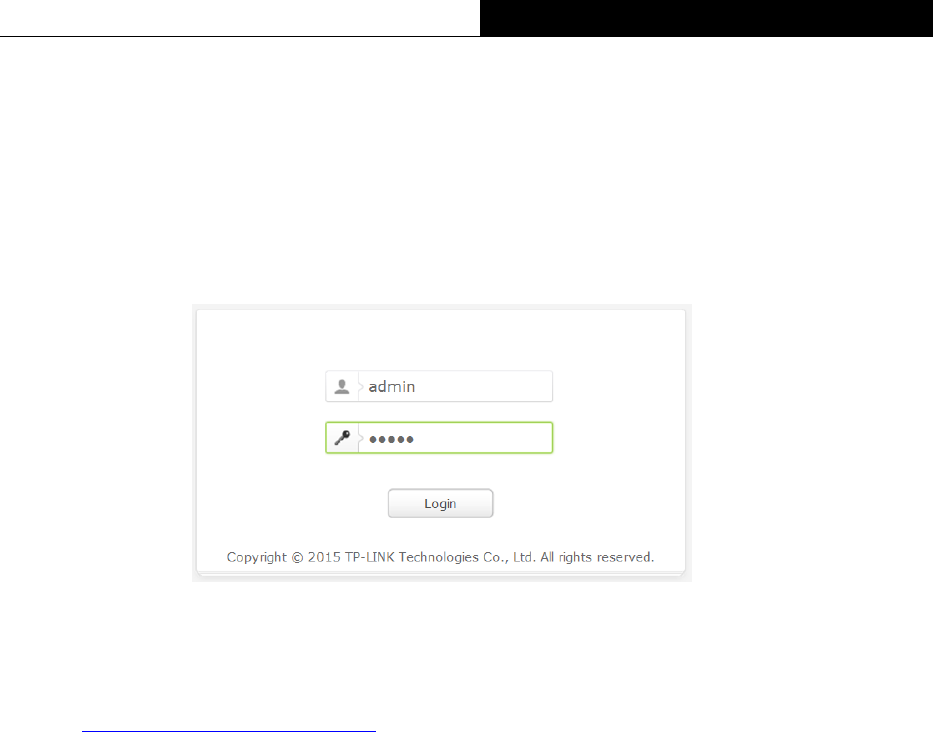
-16-
TL-WR841HP
300Mbps High Power Wireless N Router
Chapter 3. Configuration for Router Mode
3.1 Login
Enter http://tplinkwifi.net in the address bar of a web browser. Use admin for both username
and password, and then click Login.
Figure 3-1 Login
3.2 Quick Setup
Refer to Router->Login and Quick Setup
3.3 Basic
3.3.1 Network Map
Network Map provides a router-centered dashboard that shows you the status of your
Internet connection and network. You can click corresponding icons to view the detail
information. All the information is read-only.
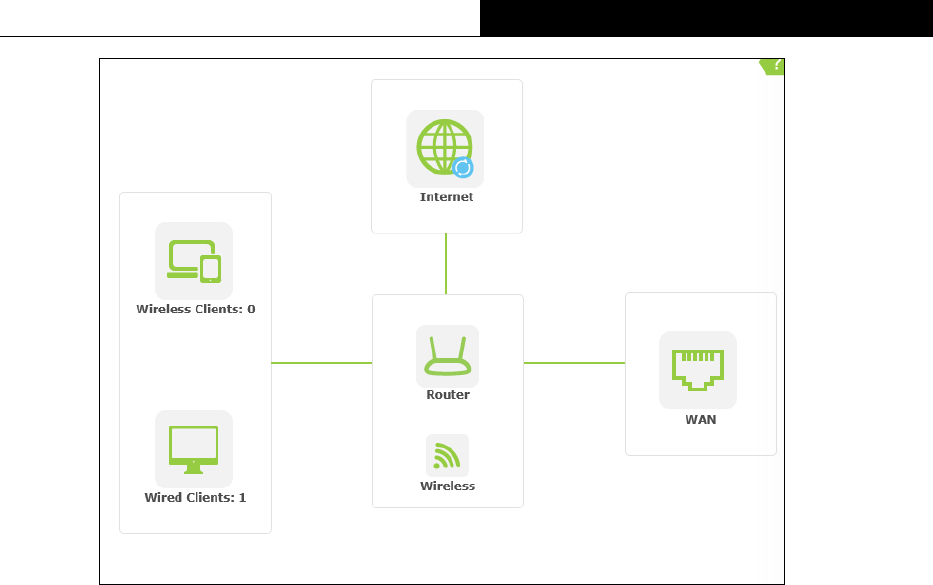
-17-
TL-WR841HP
300Mbps High Power Wireless N Router
Figure 3-2 Network Map
Internet - Click to view the ISP settings of your router.
Wireless Clients - Click to view the wireless clients connected to the router currently.
Wired Clients - Click to view the wired clients connected to the router currently.
Wireless - Click to view the current settings or information for wireless.
WAN – Click to view the current information applied to the WAN port of the router. You can
configure them in the Internet page.
3.3.2 Internet
Go to “Basic→Internet→WAN”, and you can view or change the basic ISP information for your
router.
Dynamic IP
If your ISP provides the DHCP service, please choose Dynamic IP type, and the router
will automatically get IP parameters from your ISP.
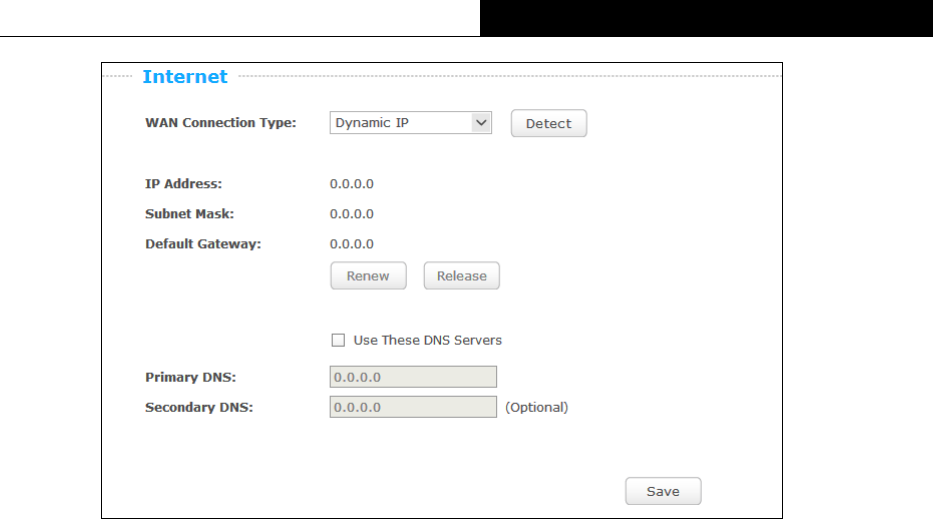
-18-
TL-WR841HP
300Mbps High Power Wireless N Router
Figure 3-3 Dynamic IP
IP Address/ Subnet Mask/ Default Gateway - Assigned dynamically by your ISP.
Click the Renew button to renew the IP parameters from your ISP. Click the Release button to
release the IP parameters.
Primary/Secondary DNS - If your ISP gives you one or two DNS addresses, select Use
These DNS Servers and enter the primary and secondary addresses into the correct fields.
Otherwise, the DNS servers will be assigned dynamically from your ISP.
Note:
If you find error when you go to a website after entering the DNS addresses, it is likely that
your DNS servers are set up improperly. You should contact your ISP to get DNS server
addresses.
Click the Save button to save your settings.
Static IP
If your ISP provides a static or fixed IP Address, Subnet Mask, Gateway and DNS setting,
select Static IP.
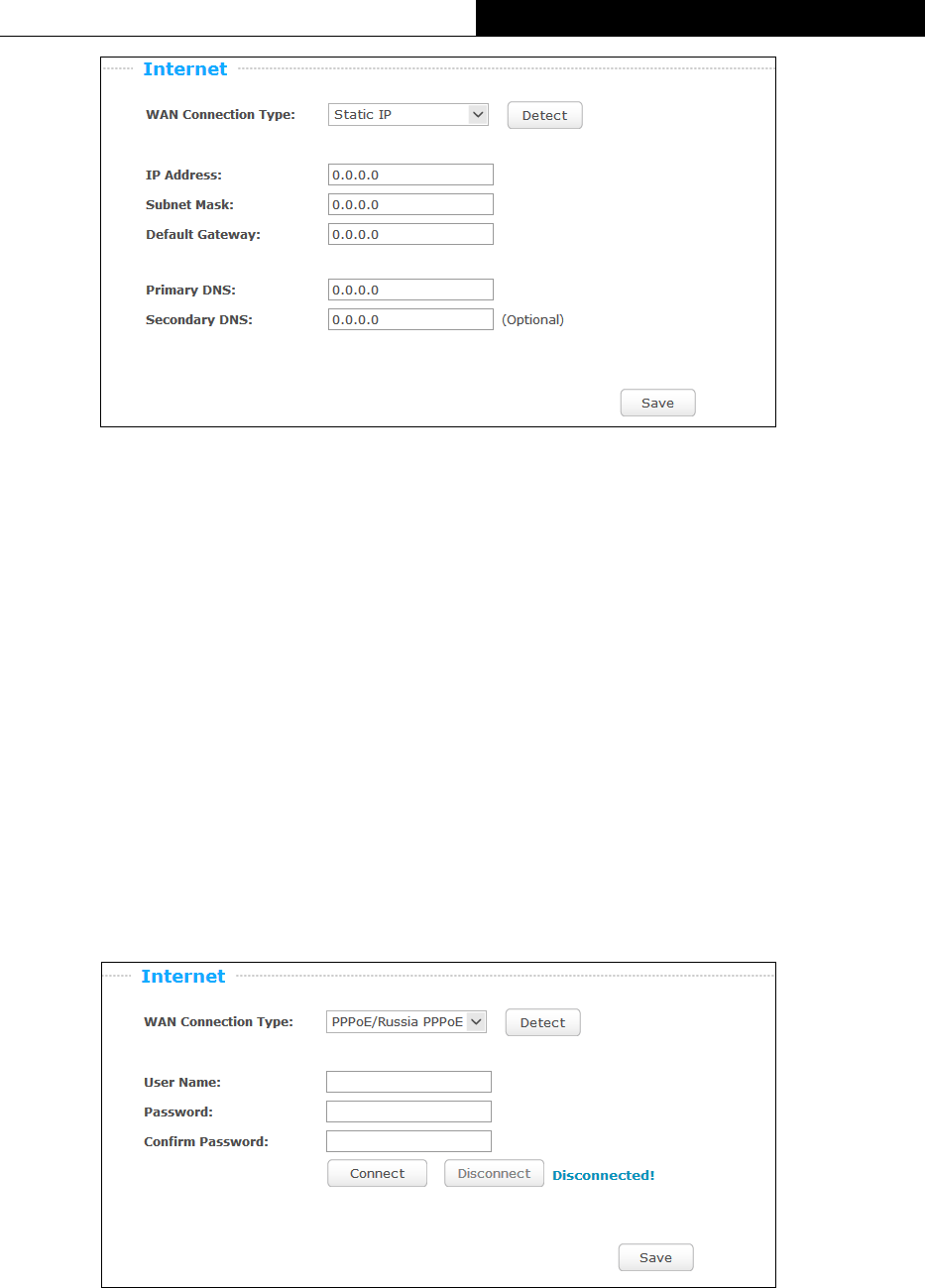
-19-
TL-WR841HP
300Mbps High Power Wireless N Router
Figure 3-4 Static IP
IP Address - Enter the IP address in dotted-decimal notation provided by your ISP.
Subnet Mask - Enter the subnet Mask in dotted-decimal notation provided by your ISP,
usually is 255.255.255.0.
Default Gateway - Enter the gateway IP address in dotted-decimal notation provided by
your ISP.
Primary/Secondary DNS - Enter one or two DNS addresses in dotted-decimal notation
provided by your ISP.
Click the Save button to save your settings.
PPPoE/Russia PPPoE
If your ISP provides a PPPoE connection, select PPPoE/Russia PPPoE option. And you
should enter the following parameters in the screen below.
Figure 3-5 PPPoE
User Name/Password - Enter the User Name and Password provided by your ISP. These
fields are case-sensitive.
Click the Connect button to connect immediately.
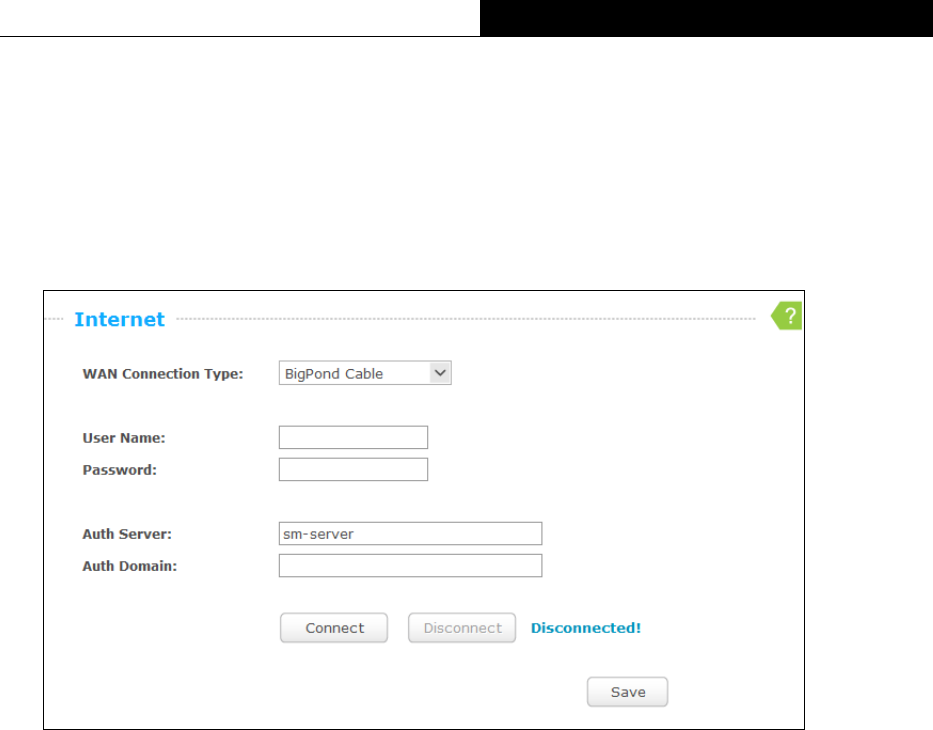
-20-
TL-WR841HP
300Mbps High Power Wireless N Router
Click the Disconnect button to disconnect immediately.
Click the Save button to save your settings.
Bigpond Cable
If your ISP provides Bigpond Cable connection, please select Bigpond Cable option. And you
should enter the following parameters in the screen below.
User Name/Password - Enter the User Name and Password provided by your ISP.
These fields are case-sensitive.
Auth Server - Enter the authenticating server IP address or host name.
Auth Domain - Type in the domain suffix server name based on your location, e.g.
NSW / ACT - nsw.bigpond.net.au
VIC / TAS / WA / SA / NT - vic.bigpond.net.au
QLD - qld.bigpond.net.au
Click Connect to connect immediately.
Click Disconnect to disconnect immediately.
Click Save to save all your settings.
L2TP/Russia L2TP
If your ISP provides L2TP connection, please select L2TP/Russia L2TP option.
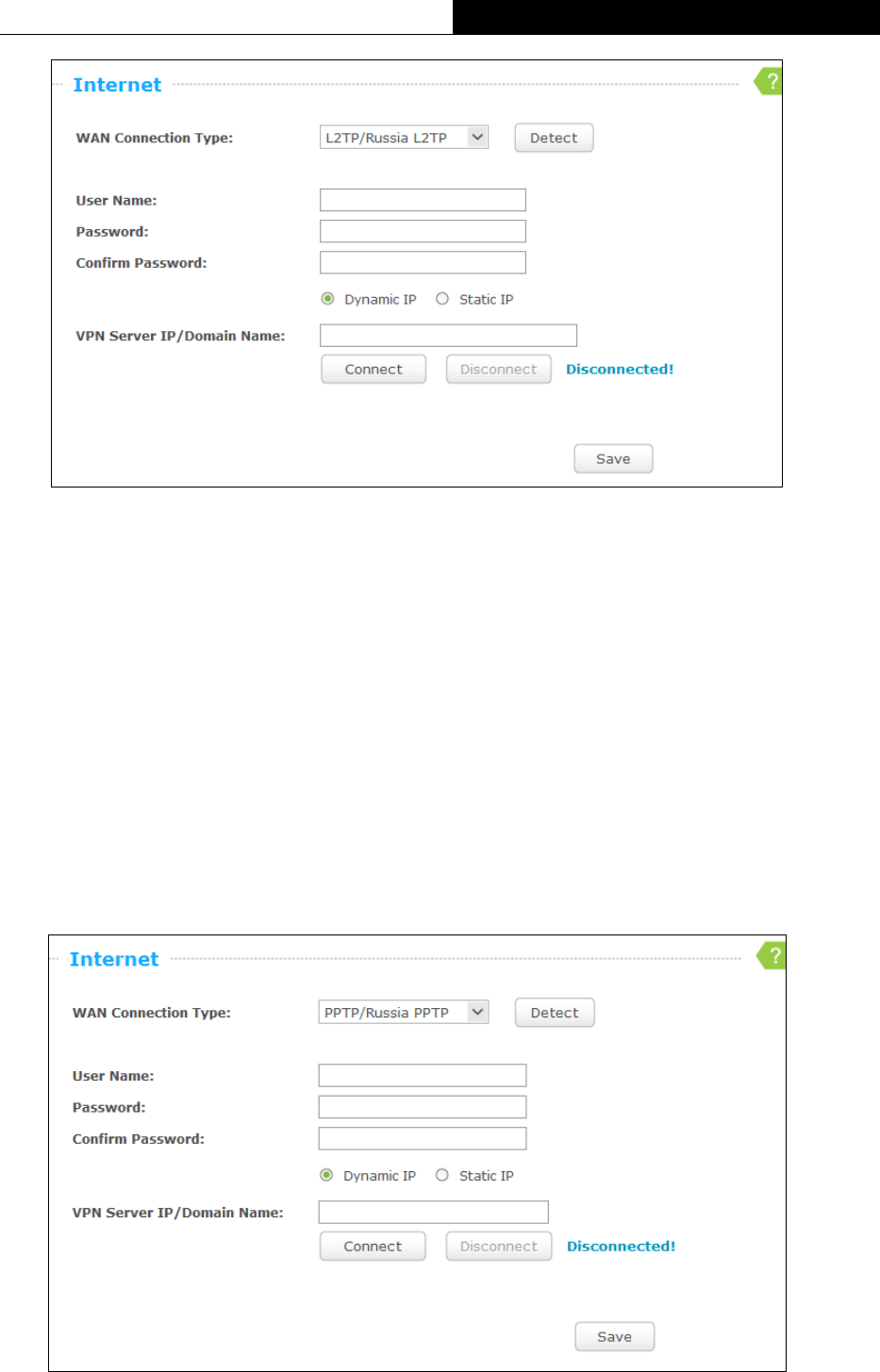
-21-
TL-WR841HP
300Mbps High Power Wireless N Router
Figure 3-6 L2TP/Russia L2TP
User Name/Password - Enter the User Name and Password provided by your ISP. These
fields are case-sensitive.
Dynamic IP/Static IP - Choose either as you are given by your ISP.
VPN Server IP/Domain Name - Enter the IP address or domain name of your VPN server.
Click the Connect button to connect immediately.
Click the Disconnect button to disconnect immediately.
Click the Save button to save your settings.
PPTP/Russia PPTP
If your ISP provides PPTP connection, please select PPTP/Russia PPTP option.
Figure 3-7 PPTP/Russia PPTP
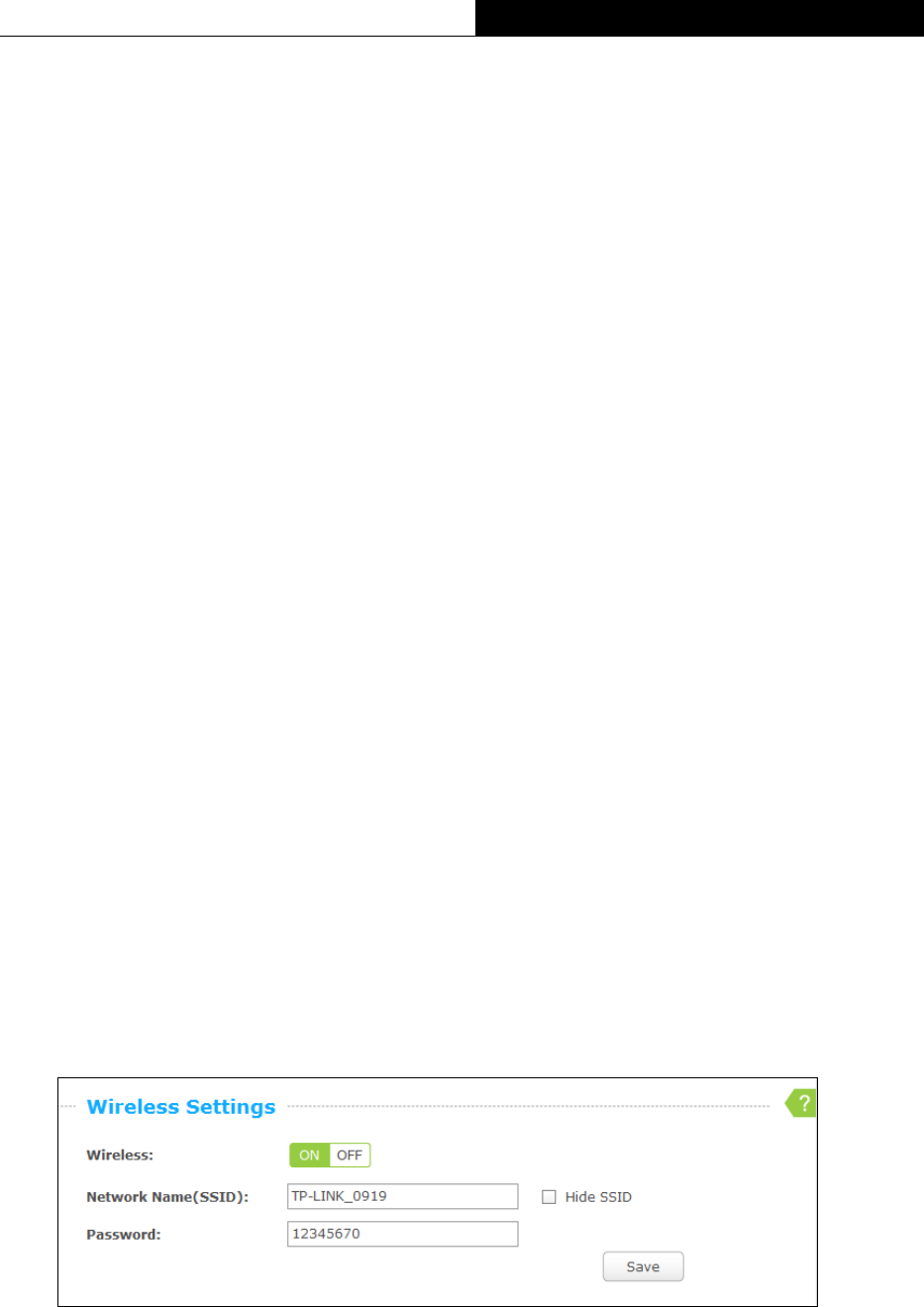
-22-
TL-WR841HP
300Mbps High Power Wireless N Router
User Name/Password - Enter the User Name and Password provided by your ISP. These
fields are case-sensitive.
Dynamic IP/ Static IP - Choose either as you are given by your ISP and enter the ISP’s IP
address or the domain name. If you choose static IP and enter the domain name, you
should also enter the DNS assigned by your ISP.
VPN Server IP/Domain Name - Enter the IP address or domain name of your VPN server.
Click the Connect button to connect immediately.
Click the Disconnect button to disconnect immediately.
Click the Save button to save your settings.
Note:
If you don't know how to choose the appropriate connection type, click the Detect button to
allow the router to automatically search your Internet connection for servers and protocols. The
connection type will be reported when an active Internet service is successfully detected by the
router. This report is for your reference only. To make sure the connection type your ISP
provides, please refer to the ISP. The various types of Internet connections that the router can
detect are as follows:
PPPoE - Connections which use PPPoE that requires a user name and password.
Dynamic IP - Connections which use dynamic IP address assignment.
Static IP - Connections which use static IP address assignment.
The router cannot detect PPTP and L2TP connections with your ISP. If your ISP uses one of
these protocols, then you must configure your connection manually.
3.3.3 Wireless
Choosing menu “Basic→Wireless”, you can configure the basic settings for the wireless
network.
Figure 3-8 Wireless Setting
Wireless - Click ON/OFF to enable or disable your wireless network.
Network Name (SSID) - Create a name (up to 32 characters) for your wireless network. If
the Hide SSID checkbox is selected, the SSID of your wireless network will be hidden from
the Wi-Fi network.
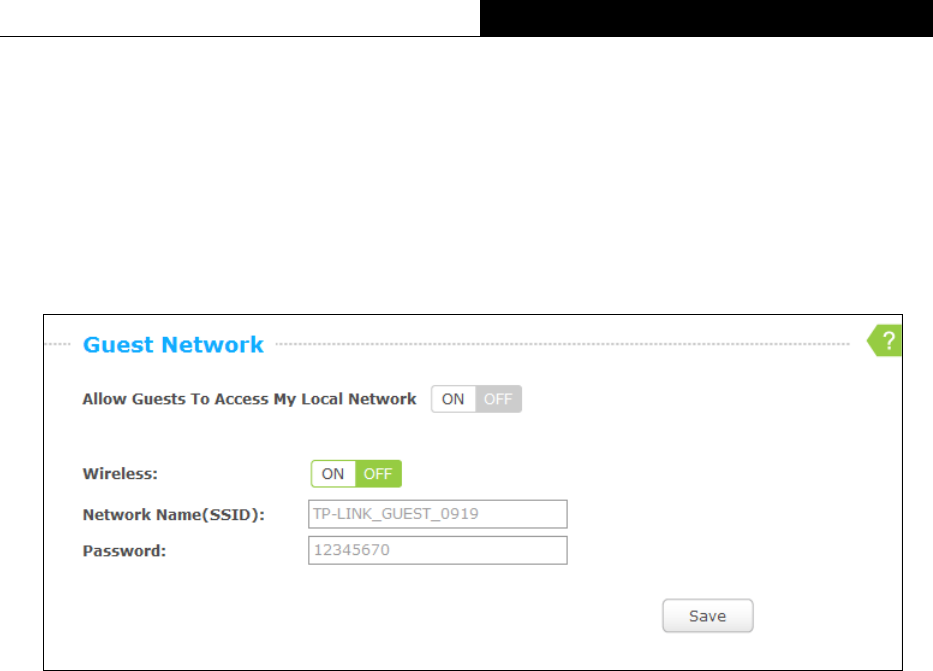
-23-
TL-WR841HP
300Mbps High Power Wireless N Router
Password - Create a password for your wireless network. The password must have a
minimum of 8 characters in length.
Click the Save button to save your settings.
3.3.4 Guest Network
Choosing menu “Basic→Guest Network”, you can configure the basic setting for guest
Network.
Figure 3-9 Guest Network
Allow Guests To Access My Local Network - Click ON/OFF to enable or disable this
feature. If enabled, guests can communicate with hosts.
Wireless - Click ON/OFF to enable or disable your Guest network. If enabled, the wireless
stations will be able to access the Router, otherwise, wireless stations will not be able to
access the Router.
Network Name(SSID) - Create a name (up to 32 characters) for your Guest network. The
same Name(SSID) must be assigned to all wireless devices in your Guest Network.
Password - Create a password for your wireless network. The password must have a
minimum of 8 characters in length.
Click the Save button to save your settings.
3.4 Advanced
Click “Advanced”, then you will see the main menus on the left of the Web Management Page.
On the right, there are the corresponding explanations and instructions.
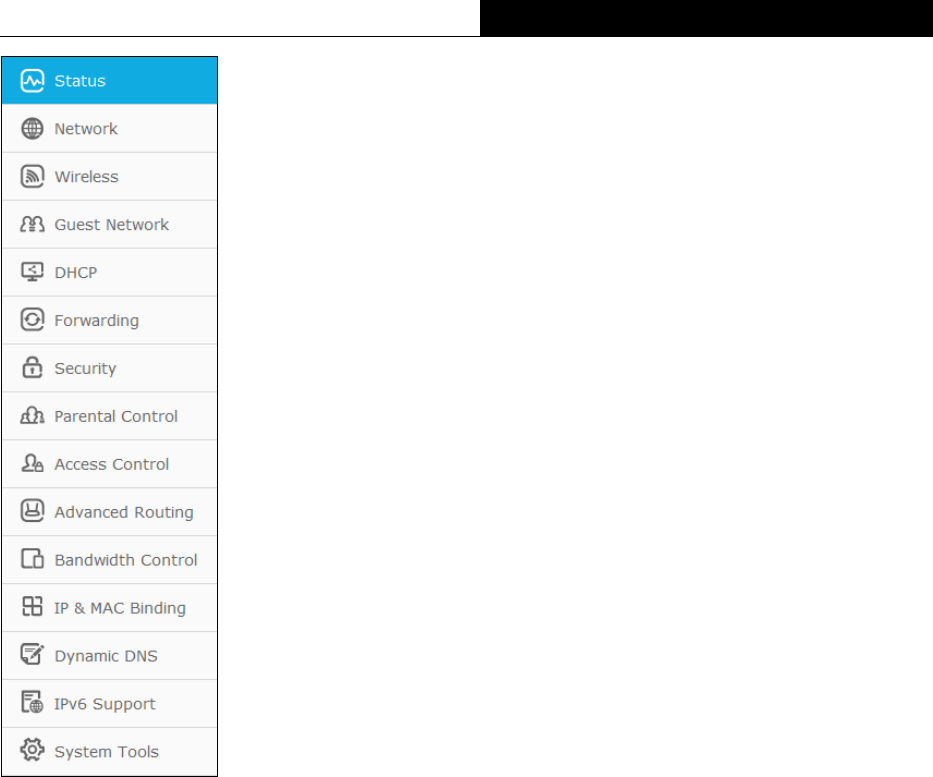
-24-
TL-WR841HP
300Mbps High Power Wireless N Router
The detailed explanations for each Web page’s key function are listed below.
3.4.1 Status
Go to “Advanced→Status”, you can see the current status information about the router.
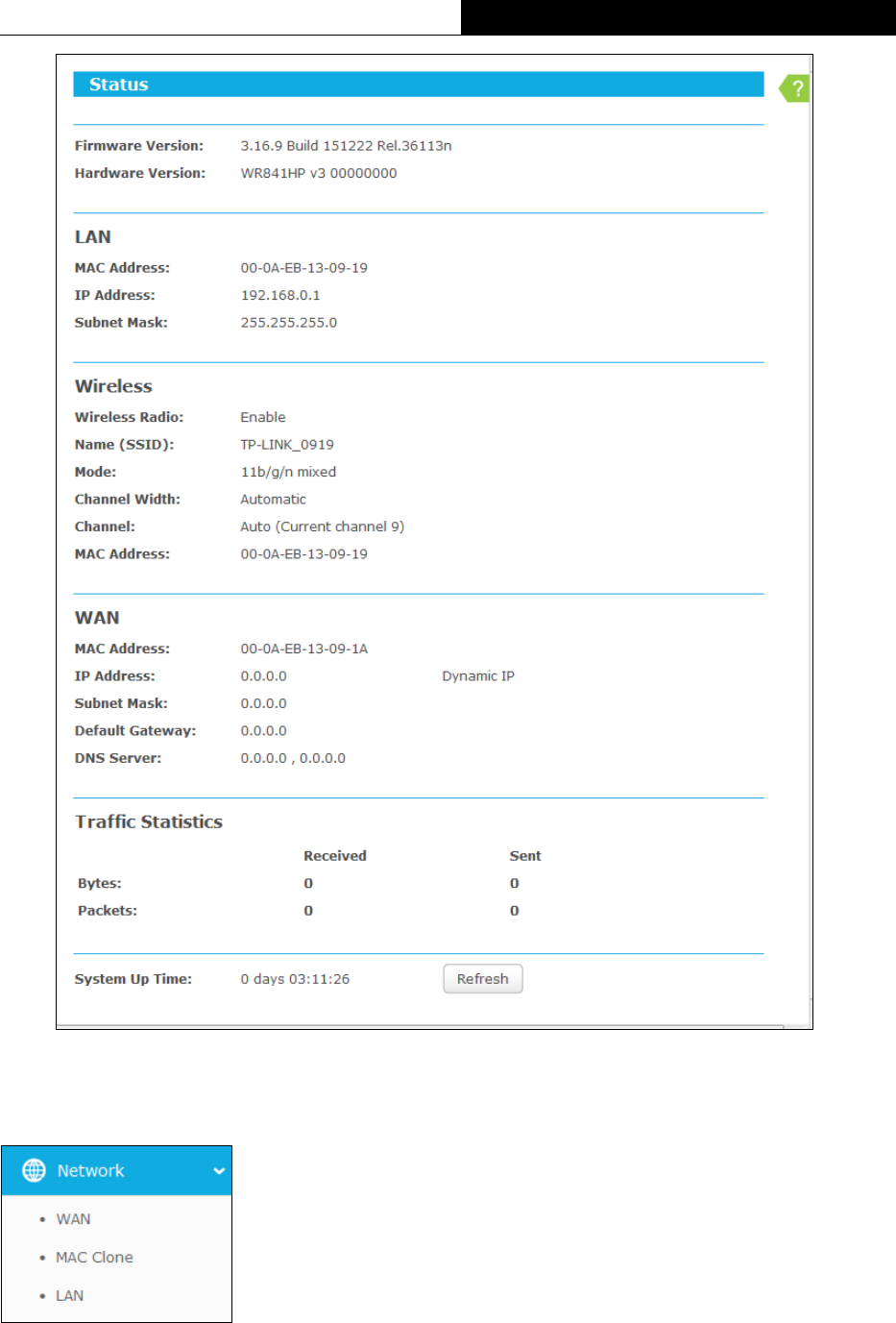
-25-
TL-WR841HP
300Mbps High Power Wireless N Router
Figure 3-10 Status
3.4.2 Network
There are three submenus under the Network menu: WAN, MAC Clone and LAN. Click any of
them, and you will be able to configure the corresponding function.
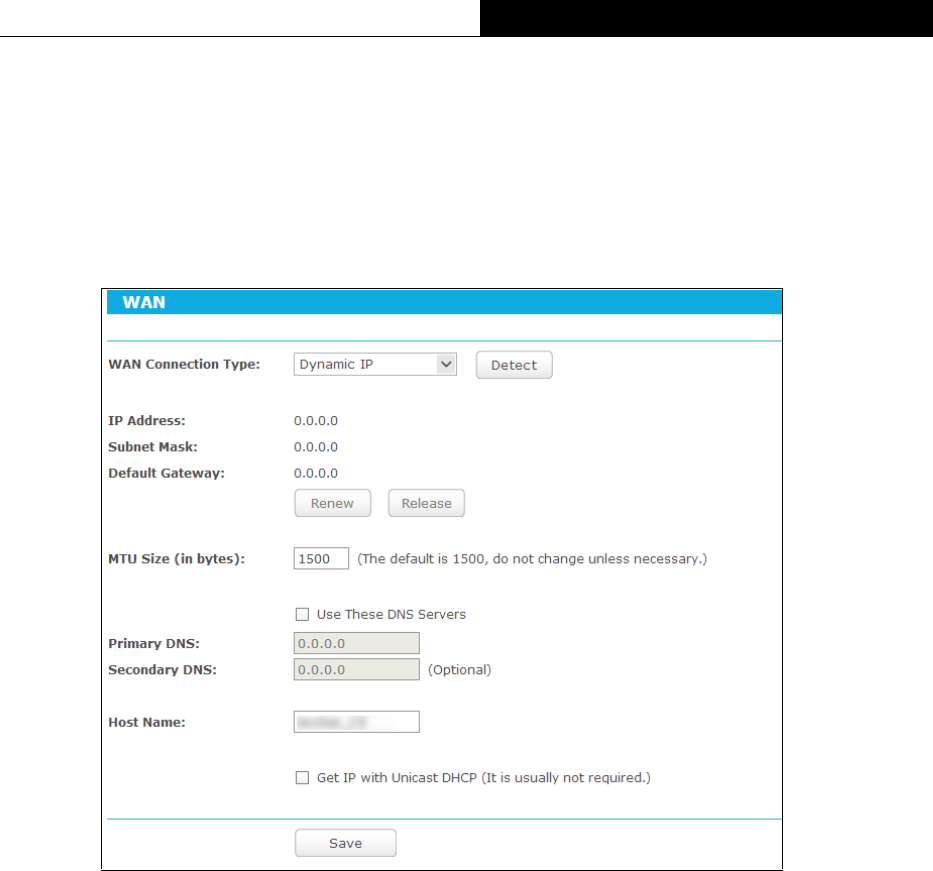
-26-
TL-WR841HP
300Mbps High Power Wireless N Router
3.4.2.1. WAN
Go to “Advanced→Network→WAN”, you can configure the IP parameters of the WAN on the
screen below.
1. If your ISP provides the DHCP service, please choose Dynamic IP type, and the router
will automatically get IP parameters from your ISP.
Figure 3-11 WAN – Dynamic IP
This page displays the WAN IP parameters assigned dynamically by your ISP, including IP
address, Subnet Mask, Default Gateway, etc. Click the Renew button to renew the IP
parameters from your ISP. Click the Release button to release the IP parameters.
MTU Size - The normal MTU (Maximum Transmission Unit) value for most Ethernet
networks is 1500 Bytes. It is not recommended that you change the default MTU Size
unless required by your ISP.
Use These DNS Servers - If your ISP gives you one or two DNS addresses, select Use
These DNS Servers and enter the primary and secondary addresses into the correct fields.
Otherwise, the DNS servers will be assigned dynamically from your ISP.
Note:
If you find error when you go to a website after entering the DNS addresses, it is likely that
your DNS servers are set up improperly. You should contact your ISP to get DNS server
addresses.
Host Name - This option specifies the Host Name of the router.
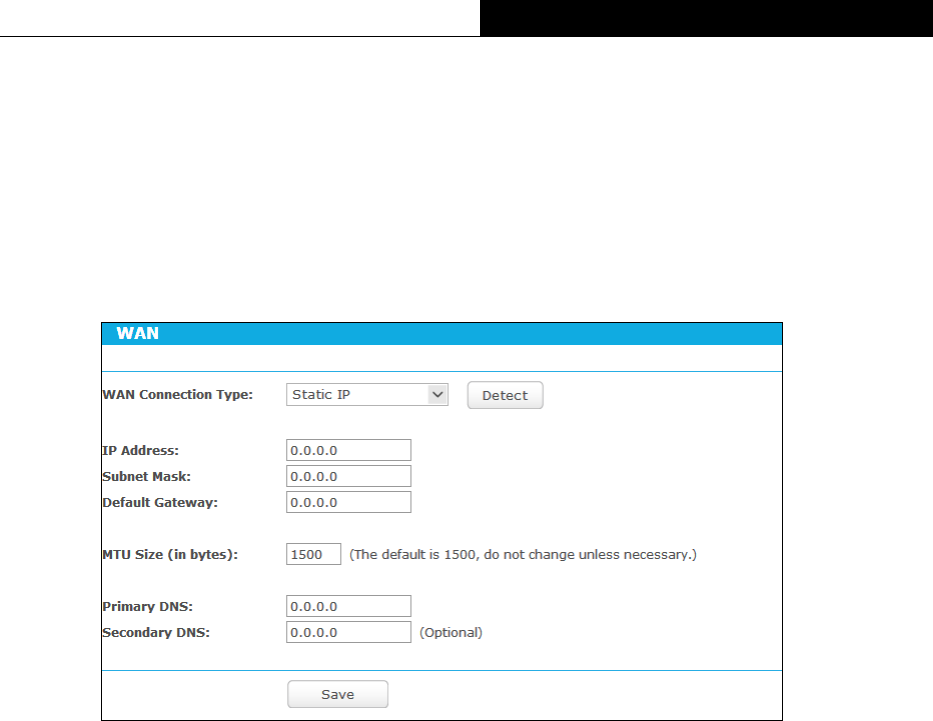
-27-
TL-WR841HP
300Mbps High Power Wireless N Router
Get IP with Unicast DHCP - A few ISPs' DHCP servers do not support the broadcast
applications. If you cannot get the IP Address normally, you can choose this option. (It is
rarely required.)
Click the Save button to save your settings.
2. If your ISP provides a static or fixed IP Address, Subnet Mask, Gateway and DNS setting,
select Static IP.
Figure 3-12 WAN - Static IP
IP Address - Enter the IP address in dotted-decimal notation provided by your ISP.
Subnet Mask - Enter the subnet Mask in dotted-decimal notation provided by your ISP,
usually is 255.255.255.0.
Default Gateway - Enter the gateway IP address in dotted-decimal notation provided by
your ISP.
MTU Size - The normal MTU (Maximum Transmission Unit) value for most Ethernet
networks is 1500 Bytes. It is not recommended that you change the default MTU Size
unless required by your ISP.
Primary/Secondary DNS - (Optional) Enter one or two DNS addresses in dotted-decimal
notation provided by your ISP.
Click the Save button to save your settings.
3. If your ISP provides a PPPoE connection, select PPPoE/Russia PPPoE option.
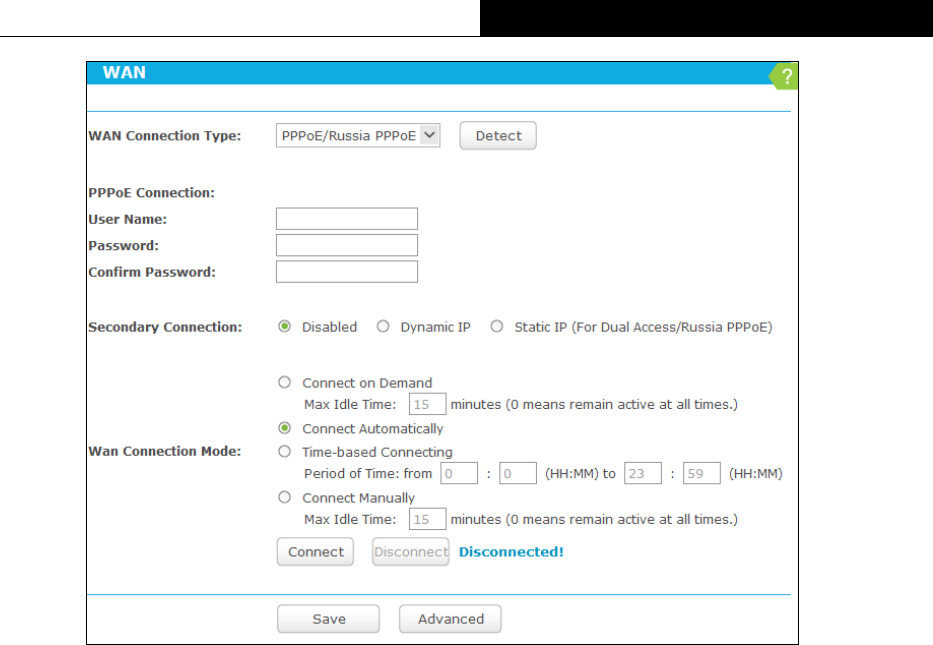
-28-
TL-WR841HP
300Mbps High Power Wireless N Router
Figure 3-13 WAN - PPPoE
User Name/Password - Enter the User Name and Password provided by your ISP. These
fields are case-sensitive.
Secondary Connection - It’s available only for PPPoE Connection. If your ISP provides an
extra Connection type such as Dynamic/Static IP to connect to a local area network, then
you can check the radio button of Dynamic/Static IP to activate this secondary connection.
Disabled - The Secondary Connection is disabled by default, so there is PPPoE
connection only. This is recommended.
Dynamic IP - You can check this radio button to use Dynamic IP as the secondary
connection to connect to the local area network provided by ISP.
Static IP - You can check this radio button to use Static IP as the secondary
connection to connect to the local area network provided by ISP.
Connect on Demand - In this mode, the Internet connection can be terminated
automatically after a specified inactivity period (Max Idle Time) and be re-established
when you attempt to access the Internet again. If you want your Internet connection keeps
active all the time, please enter “0” in the Max Idle Time field. Otherwise, enter the number
of minutes you want to have elapsed before your Internet access disconnects.
Connect Automatically - The connection can be re-established automatically when it was
down.
Time-based Connecting - The connection will only be established in the period from the
start time to the end time (both are in HH:MM format).
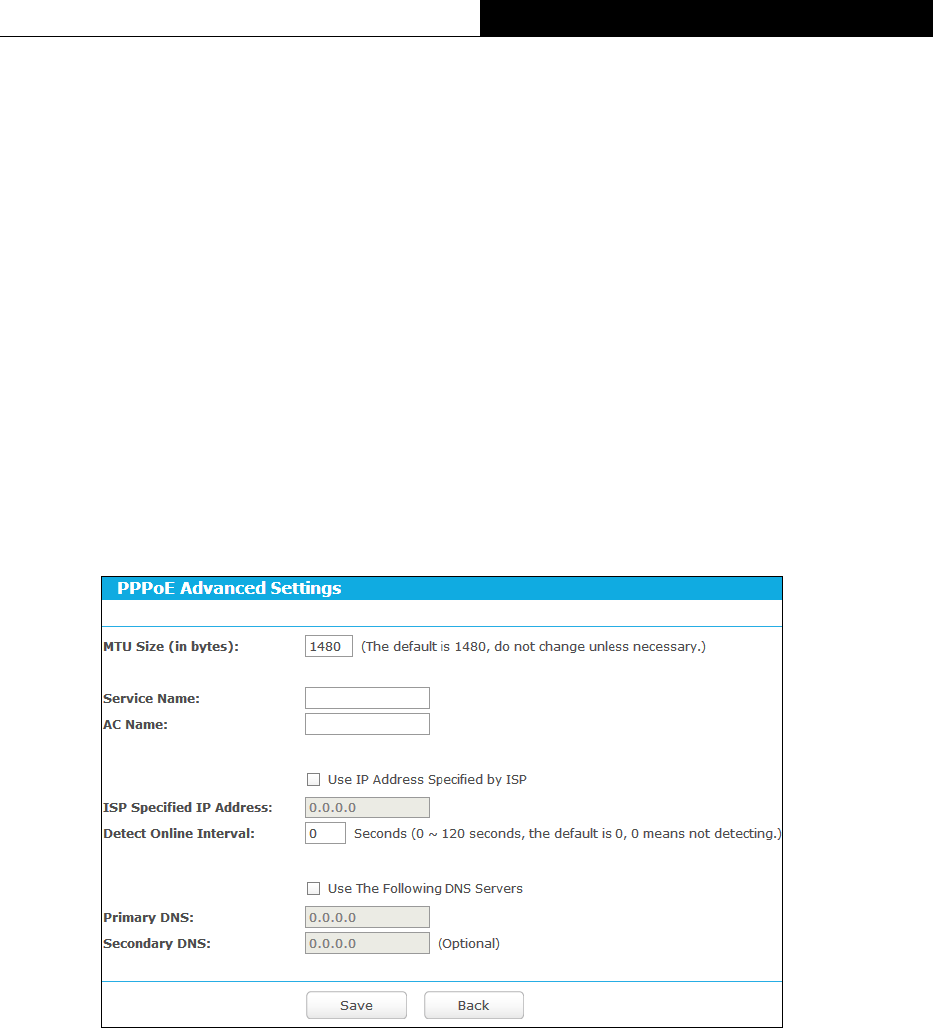
-29-
TL-WR841HP
300Mbps High Power Wireless N Router
Note:
Only when you have configured the system time on “Advanced→System Tools→Time
Settings” page, will the Time-based Connecting function can take effect.
Connect Manually - You can click the Connect/Disconnect button to connect/disconnect
immediately. This mode also supports the Max Idle Time function as Connect on Demand
mode. The Internet connection can be disconnected automatically after a specified
inactivity period and re-established when you attempt to access the Internet again.
Click the Connect button to connect immediately. Click the Disconnect button to
disconnect immediately.
Caution: Sometimes the connection cannot be terminated although you specify a time to Max
Idle Time because some applications are visiting the Internet continually in the background.
If you want to do some advanced configurations, please click the Advanced button, and the
page shown below will then appear.
Figure 3-14 PPPoE Advanced Settings
MTU Size - The default MTU size is “1480” bytes, which is usually fine. It is not
recommended that you change the default MTU Size unless required by your ISP.
Service Name/AC Name - The service name and AC (Access Concentrator) name should
not be configured unless you are sure it is necessary for your ISP. In most cases, leaving
these fields blank will work.
ISP Specified IP Address - If your ISP does not automatically assign IP addresses to the
router during login, please click “Use IP address specified by ISP” check box and enter
the IP address provided by your ISP in dotted-decimal notation.
Detect Online Interval - The router will detect Access Concentrator online at every interval.
The default value is “0”. You can input the value between “0” and “120”. The value “0”
means no detect.
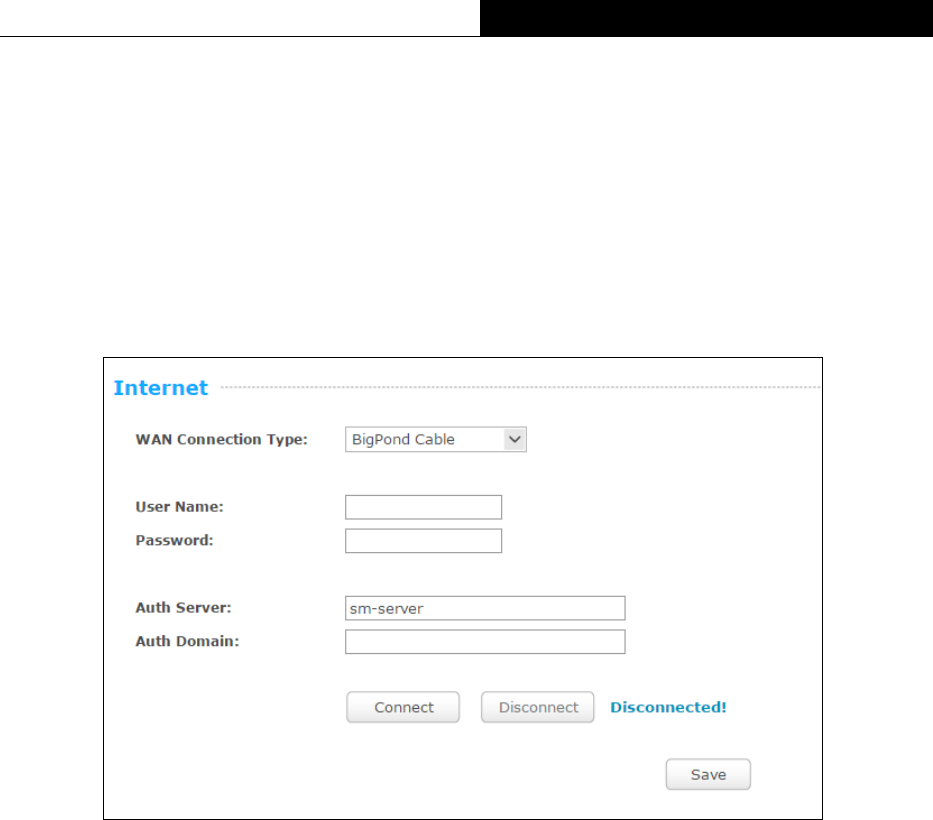
-30-
TL-WR841HP
300Mbps High Power Wireless N Router
Primary DNS/Secondary DNS - If your ISP does not automatically assign DNS addresses
to the router during login, please click “Use the following DNS servers” check box and
enter the IP address in dotted-decimal notation of your ISP’s primary DNS server. If a
secondary DNS server address is available, enter it as well.
Click the Save button to save your settings.
4. If your ISP provides Bigpond Cable connection, please select Bigpond Cable option. And
you should enter the following parameters.
User Name/Password - Enter the User Name and Password provided by your ISP.
These fields are case-sensitive.
Auth Server - Enter the authenticating server IP address or host name.
Auth Domain - Type in the domain suffix server name based on your location, e.g.
NSW / ACT - nsw.bigpond.net.au
VIC / TAS / WA / SA / NT - vic.bigpond.net.au
QLD - qld.bigpond.net.au
Click Connect to connect immediately.
Click Disconnect to disconnect immediately.
Click Save to save all your settings.
5. If your ISP provides L2TP connection, please select L2TP/Russia L2TP option.
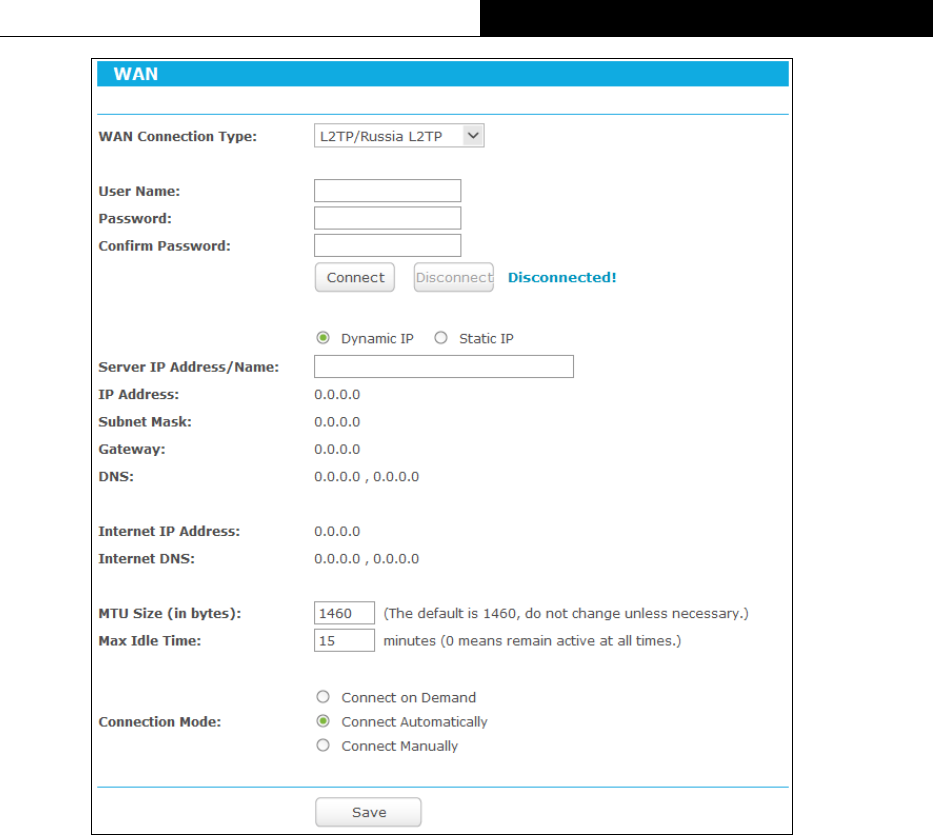
-31-
TL-WR841HP
300Mbps High Power Wireless N Router
Figure 3-15 WAN - L2TP/Russia L2TP
User Name/Password - Enter the User Name and Password provided by your ISP. These
fields are case-sensitive.
Dynamic IP/ Static IP - Select Static IP if IP address, subnet mask, gateway and DNS
server address have been provided by your ISP. Otherwise, please select Dynamic IP.
Server IP Address/Name - Enter server IP address or domain name provided by your ISP.
Connect on Demand - You can configure the router to disconnect from your Internet
connection after a specified period of inactivity (Max Idle Time). If your Internet connection
has been terminated due to inactivity, Connect on Demand enables the router to
automatically re-establish your connection as soon as you attempt to access the Internet
again. If you wish to activate Connect on Demand, check the radio button. If you want
your Internet connection to remain active at all times, enter 0 in the Max Idle Time field.
Otherwise, enter the number of minutes you want to have elapsed before your Internet
connection terminates.
Connect Automatically - Connect automatically after the router is disconnected. To use
this option, check the radio button.
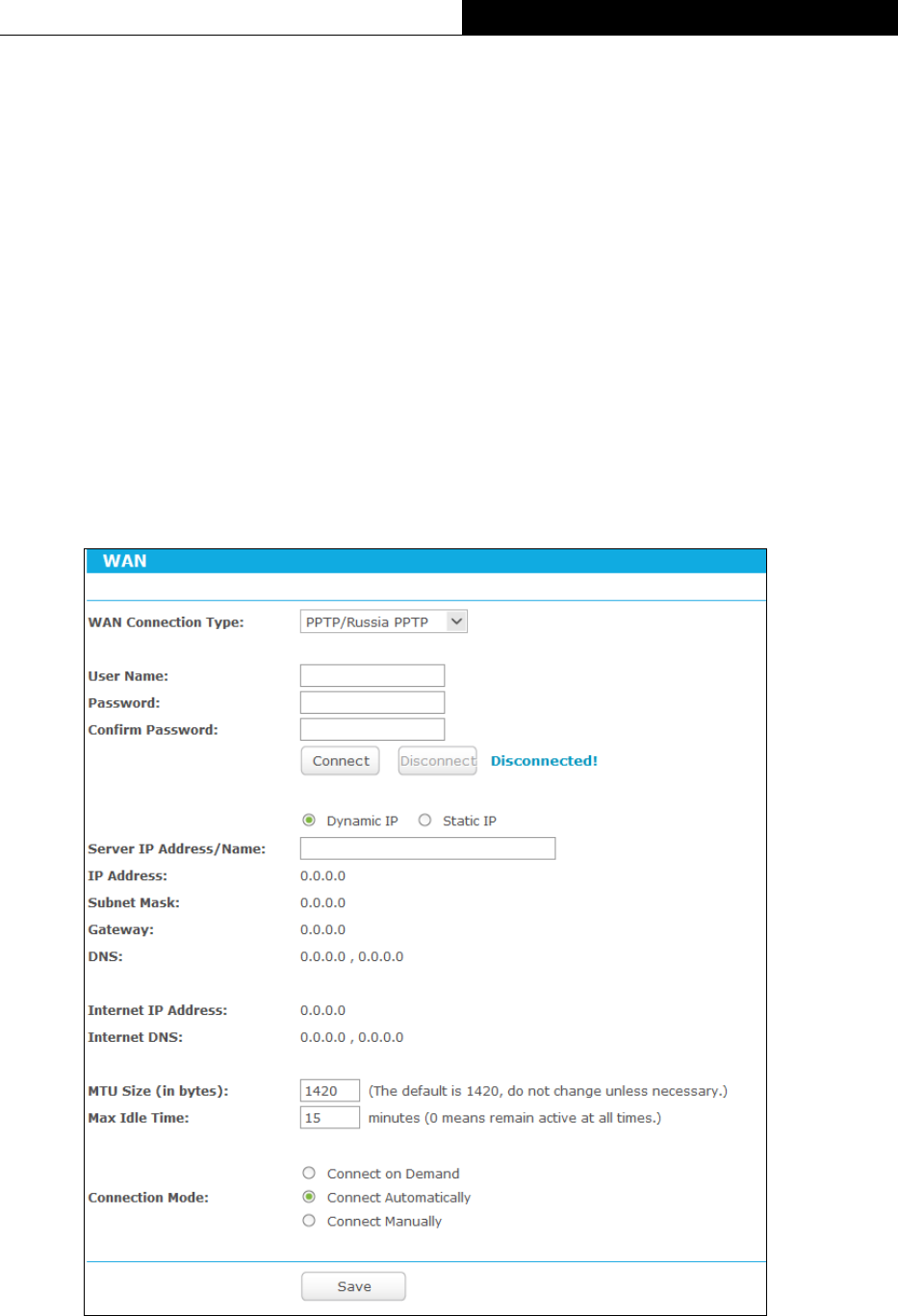
-32-
TL-WR841HP
300Mbps High Power Wireless N Router
Connect Manually - You can configure the router to make it connect or disconnect
manually. After a specified period of inactivity (Max Idle Time), the router will disconnect
from your Internet connection, and you will not be able to re-establish your connection
automatically as soon as you attempt to access the Internet again. To use this option,
check the radio button. If you want your Internet connection to remain active at all times,
enter "0" in the Max Idle Time field. Otherwise, enter the number of minutes that you wish
to have the Internet connecting last unless a new link is requested.
Caution: Sometimes the connection cannot be disconnected although you specify a time to
Max Idle Time, because some applications are visiting the Internet continually in the
background.
Click the Save button to save your settings.
6. If your ISP provides PPTP connection, please select PPTP/Russia PPTP option. And you
should enter the following parameters (Figure 3-16).
Figure 3-16 PPTP Settings
User Name/Password - Enter the User Name and Password provided by your ISP. These
fields are case-sensitive.

-33-
TL-WR841HP
300Mbps High Power Wireless N Router
Dynamic IP/ Static IP - Select Static IP if IP address, subnet mask, gateway and DNS
server address have been provided by your ISP. Otherwise, please select Dynamic IP.
Server IP Address/Name - Enter server IP address or domain name provided by your ISP.
Connect on Demand - You can configure the router to disconnect from your Internet
connection after a specified period of inactivity (Max Idle Time). If your Internet connection
has been terminated due to inactivity, Connect on Demand enables the router to
automatically re-establish your connection as soon as you attempt to access the Internet
again. If you wish to activate Connect on Demand, check the radio button. If you want
your Internet connection to remain active at all times, enter “0” in the Max Idle Time field.
Otherwise, enter the number of minutes you want to have elapsed before your Internet
connection terminates.
Connect Automatically - Connect automatically after the router is disconnected. To use
this option, check the radio button.
Connect Manually - You can configure the router to make it connect or disconnect
manually. After a specified period of inactivity (Max Idle Time), the router will disconnect
from your Internet connection, and you will not be able to re-establish your connection
automatically as soon as you attempt to access the Internet again. To use this option, click
the radio button. If you want your Internet connection to remain active at all times, enter "0"
in the Max Idle Time field. Otherwise, enter the number in minutes that you wish to have
the Internet connecting last unless a new link is requested.
Caution: Sometimes the connection cannot be disconnected although you specify a time to
Max Idle Time because some applications are visiting the Internet continually in the
background.
Click the Save button to save your settings.
Note:
If you don't know how to choose the appropriate connection type, click the Detect button to
allow the router to automatically search your Internet connection for servers and protocols. The
connection type will be reported when an active Internet service is successfully detected by the
router. This report is for your reference only. To make sure the connection type your ISP
provides, please refer to the ISP. The various types of Internet connections that the router can
detect are as follows:
PPPoE - Connections which use PPPoE that requires a user name and password.
Dynamic IP - Connections which use dynamic IP address assignment.
Static IP - Connections which use static IP address assignment.
The router cannot detect PPTP/L2TP connections with your ISP. If your ISP uses one of these
protocols, then you must configure your connection manually.

-34-
TL-WR841HP
300Mbps High Power Wireless N Router
3.4.2.2. MAC Clone
Go to “Advanced→Network→MAC Clone”, you can configure the MAC address of the WAN
on the screen below, Figure 3-17.
Figure 3-17 MAC Address Clone
Some ISPs require that you register the MAC Address of your adapter. Changes are rarely
needed here.
WAN MAC Address - This field displays the current MAC address of the Internet port. If
your ISP requires you to register the MAC address, please enter the correct MAC address
into this field in XX-XX-XX-XX-XX-XX format (X is any hexadecimal digit).
Your PC's MAC Address - This field displays the MAC address of the PC that is
managing the router. If the MAC address is required, you can click the Clone MAC
Address button and this MAC address will fill in the WAN MAC Address field.
Click Restore Factory MAC to restore the MAC address of Internet port to the factory default
value. Click the Save button to save your settings.
Note:
Only the PC on your LAN can use the MAC Address Clone function.
3.4.2.3. LAN
Go to “Advanced→Network→LAN”, you can configure the IP parameters of the LAN on the
screen as below.
Figure 3-18 LAN
MAC Address - The physical address of the router, as seen from the LAN. The value
can't be changed.
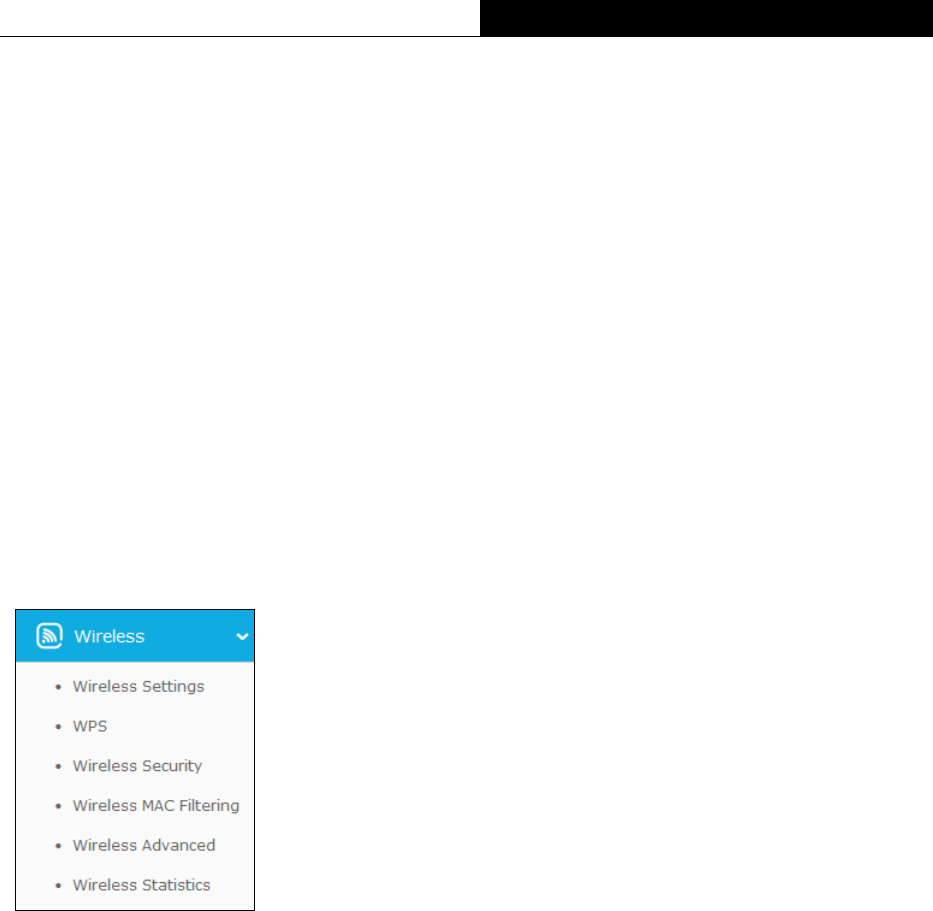
-35-
TL-WR841HP
300Mbps High Power Wireless N Router
IP Address - Enter the IP address of your router or reset it in dotted-decimal notation
(factory default: 192.168.0.1).
Subnet Mask - An address code that determines the size of the network. Normally use
255.255.255.0 as the subnet mask.
IGMP Proxy - If you want to watch TV through IGMP, please Enable it.
Click the Save button to save your settings.
Note:
1) If you change the IP Address of LAN, you must use the new IP Address to log in the router.
2) If the new LAN IP Address you set is not in the same subnet, the IP Address pool of the
DHCP server will change accordingly at the same time, while the Virtual Server and DMZ
Host will not take effect until they are re-configured.
3.4.3 Wireless
There are six submenus under the Wireless menu: Wireless Settings, WPS, Wireless
Security, Wireless MAC Filtering, Wireless Advanced and Wireless Statistics. Click any of
them, and you will be able to configure the corresponding functions.
3.4.3.1. Wireless Settings
Go to “Advanced→Wireless→Wireless Settings”, you can configure the basic settings for the
wireless network of 2.4GHz on this page.
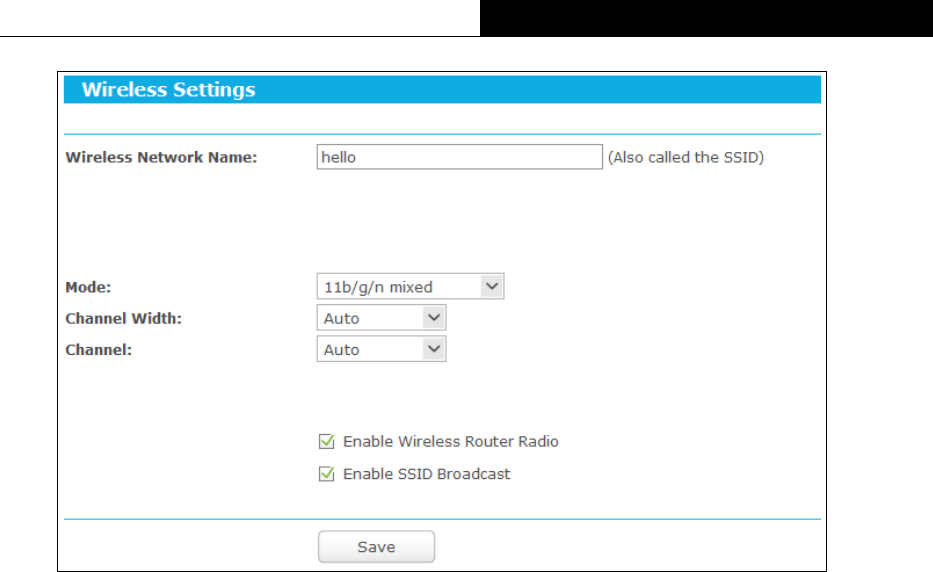
-36-
TL-WR841HP
300Mbps High Power Wireless N Router
Figure 3-19 Wireless Settings (2.4GHz)
Wireless Network Name - The wireless network name (SSID) that the router uses. You
can create a new one with up to 32 characters. The default SSID is set to be
TP-LINK_XXXX. This value is case-sensitive. For example, TEST is NOT the same as
test.
Mode - Select the desired mode.
11n only - Select if you are using only 802.11n wireless clients.
11gn mixed - Select if you are using both 802.11n and 802.11g wireless clients.
11bgn mixed - Select if you are using a mix of 802.11b, 11g, and 11n wireless clients.
It is strongly recommended that you set the Mode to 802.11bgn mixed, and all of
802.11b, 802.11g, and 802.11n wireless stations can connect to the router.
Channel Width - Select the channel width from the drop-down list, including Auto,
20MHz, 40MHz.
Channel - This field determines which operating frequency will be used. The default
channel is set to Auto, so the router will choose the best channel automatically. It is not
necessary to change the wireless channel unless you notice interference problems with
another nearby access point.
Enable Wireless Router Radio - The wireless radio of the Router can be enabled or
disabled to allow wireless stations access. If enabled, the wireless stations will be able to
access the Router. Otherwise, wireless stations will not be able to access the Router.
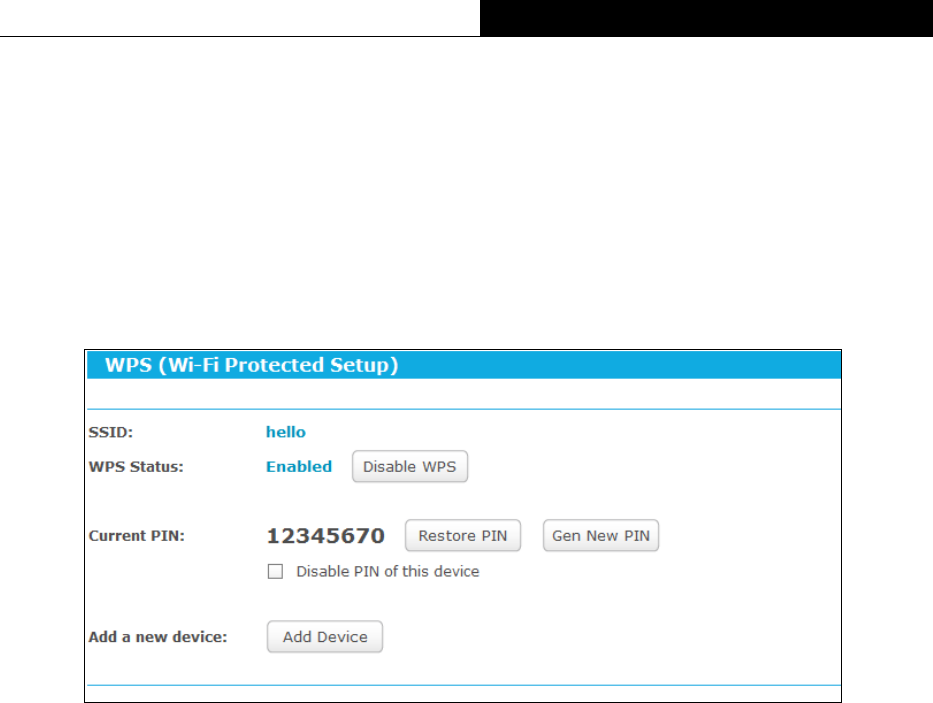
-37-
TL-WR841HP
300Mbps High Power Wireless N Router
Enable SSID Broadcast - When wireless clients survey the local area for wireless networks
to associate with, they will detect the SSID broadcast by the router. If you select the Enable
SSID Broadcast checkbox, the Wireless router will broadcast its name (SSID) on the air.
3.4.3.2. WPS
Go to “Advanced→Wireless→WPS”, you can see the page as shown below. This section will
guide you to add a new wireless device to an existing network quickly by WPS (Wi-Fi Protected
Setup) function.
Figure 3-20 WPS
WPS Status - Enable or disable the WPS function here.
Current PIN - Displays the current value of the router's PIN. The default PIN of the router
can be found in the label or User Guide.
Restore PIN - Restore the PIN of the router to its default value.
Gen New PIN - Click this button, and then you can get a new random value for the router's
PIN. You can ensure the network security by generating a new PIN.
Disable PIN of this device - WPS external registrar of entering this device's PIN can be
disabled or enabled manually. If this device receives multiple failed attempts to
authenticate an external registrar, this function will be disabled automatically.
Add device - You can add a new device to the existing network manually by clicking this
button.
If the wireless adapter supports Wi-Fi Protected Setup (WPS), you can establish a wireless
connection between wireless adapter and the router using either Push Button Configuration
(PBC) method or PIN method.
I. Use the Wi-Fi Protected Setup Button
Use this method if your client device has a WPS button.
Step 1: Press the WPS/Reset button on the back panel of the router. You can also keep the
default WPS status as Enabled and click the Add device button. Then choose “Press
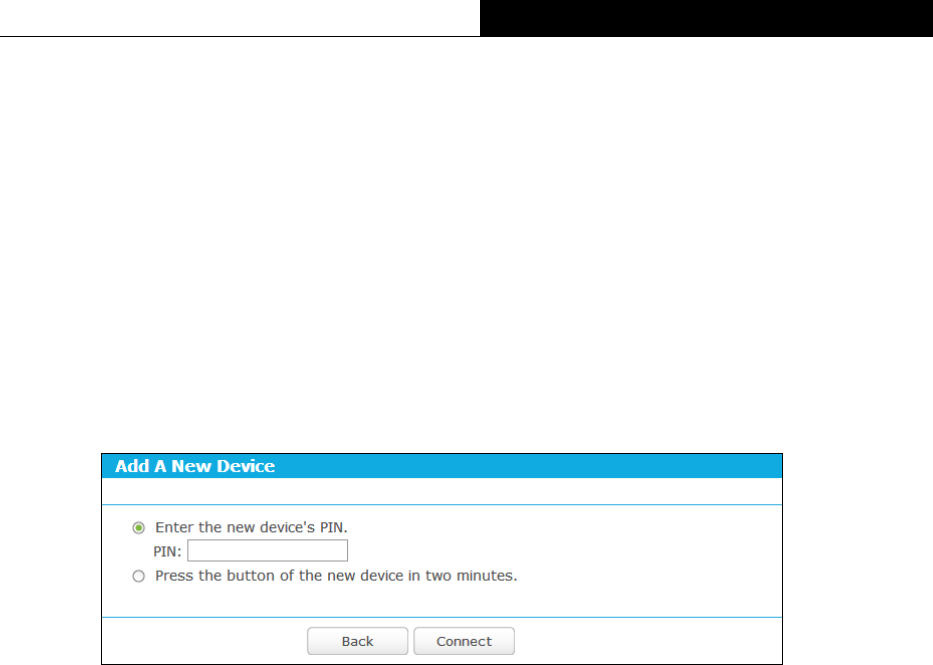
-38-
TL-WR841HP
300Mbps High Power Wireless N Router
the button of the new device in two minutes” and click Connect, shown in the WPS
page.
Step 2: Press and hold the WPS button of the client. The WPS LED flashes for two minutes
during the Wi-Fi Protected Setup process.
Step 3: When the WPS LED is on, the client has successfully connected to the router.
II. Enter the client device’s PIN on the router
Use this method if your client does not have the WPS button, but has a Wi-Fi Protected Setup
PIN number.
Step 1: Enable WPS. The default is enabled. Click the Add device button in the WPS page.
Figure 3-21 Add A New Device
Step 2: Enter the PIN number from the client in the field on the WPS screen above. Then click
Connect button.
Step 3: “Connect successfully” will appear on the screen, which means the client has
successfully connected to the router.
Note:
1) The WPS LED on the router will light blue for five minutes if the device has been successfully
added to the network.
2) The WPS function cannot be configured if the wireless function of the router is disabled.
Please make sure the wireless function is enabled before configuring the WPS.
III. Enter the router’s PIN on your client device
Use this method if your client device asks for the router’s PIN number.
Step 1: On the client device, enter the PIN number listed on the router’s Wi-Fi Protected
Setup screen, shown in the WPS page(It is also labeled on the bottom of the router).
Step 2: The Wi-Fi Protected Setup LED flashes for two minutes during the Wi-Fi Protected
Setup process.
Step 3: When the WPS LED is on, the client device has successfully connected to the router.
Note:
1) The WPS LED on the router will light green for five minutes if the device has been
successfully added to the network.
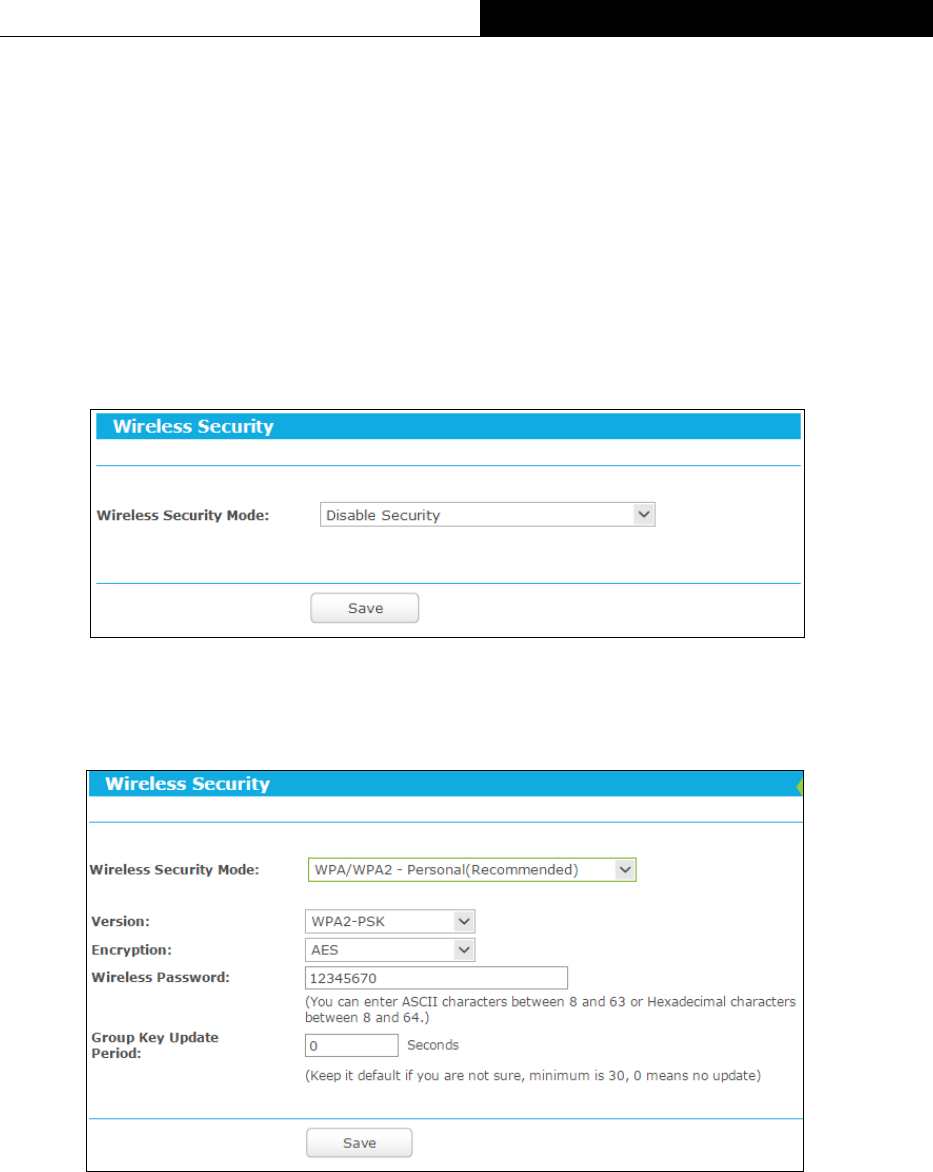
-39-
TL-WR841HP
300Mbps High Power Wireless N Router
2) The WPS function cannot be configured if the Wireless Function of the router is disabled.
Please make sure the Wireless Function is enabled before configuring the WPS.
3.4.3.3. Wireless Security
Go to “Advanced→Wireless→Wireless Security”, you can configure the security settings of
your wireless network. There are four wireless security modes supported by the router: Disable
Security, WPA/ WPA2-Personal, WPA/ WPA2-Enterprise, and WEP.
Disable Security - The wireless security function can be enabled or disabled. If disabled,
the wireless stations will be able to connect this device without encryption. It is strongly
recommended that you choose the other options to enable security.
Figure 3-22 Disable security
WPA/WPA2-Personal - It’s the WPA/WPA2 authentication type based on pre-shared
passphrase. The router is configured by this security type by default.
Figure 3-23 WPA/WPA2-Personal
Version - You can choose the version of the Automatic, WPA-PSK or WPA2-PSK
security from the drop-down list. The default setting is WPA2-PSK.
Encryption - You can select Automatic, TKIP or AES as Encryption. The default
setting is AES.
Note:
If you check the WPA/WPA2-Personal radio button and choose TKIP encryption, you
will find a notice in red as shown below.
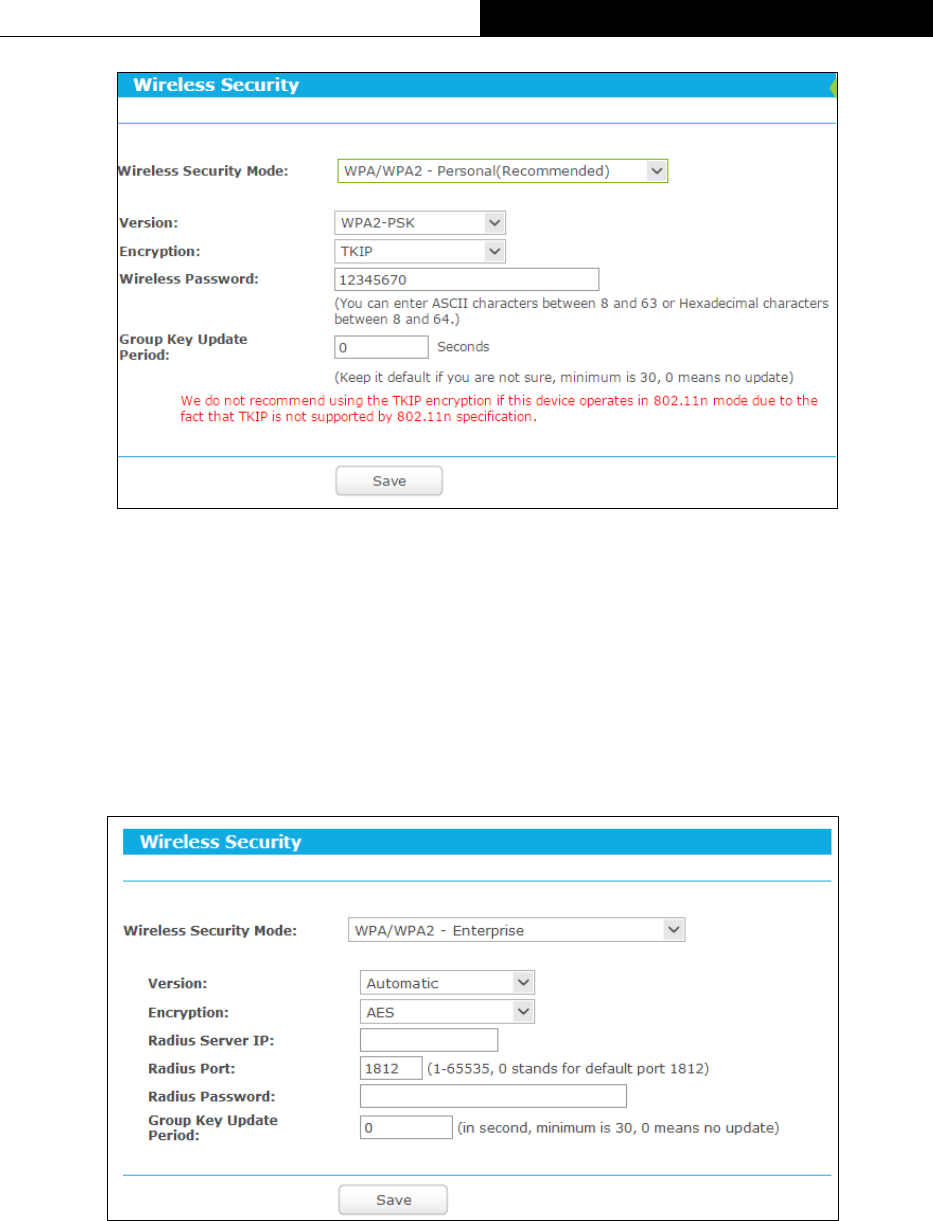
-40-
TL-WR841HP
300Mbps High Power Wireless N Router
Wireless Password - You can enter ASCII characters between 8 and 63 characters
or 8 to 64 Hexadecimal characters. The default password is the same with the default
PIN code, which is labeled on the router or can be found in Figure 3-20.
Group Key Update Period - Specify the group key update interval in seconds. The
value should be 30 or above. Enter 0 to disable the update.
WPA/WPA2- Enterprise - It’s based on Radius Server. If you choose WPA/WPA2 -
Enterprise, WPS function will be disabled.
Figure 3-24 WPA/WPA2 - Enterprise
Version - you can choose the version of the WPA security on the drop-down list. The
default setting is Automatic, which can select WPA (Wi-Fi Protected Access) or
WPA2 (WPA version 2) automatically based on the wireless station's capability and
request.
Encryption - You can select either Automatic, or TKIP or AES.
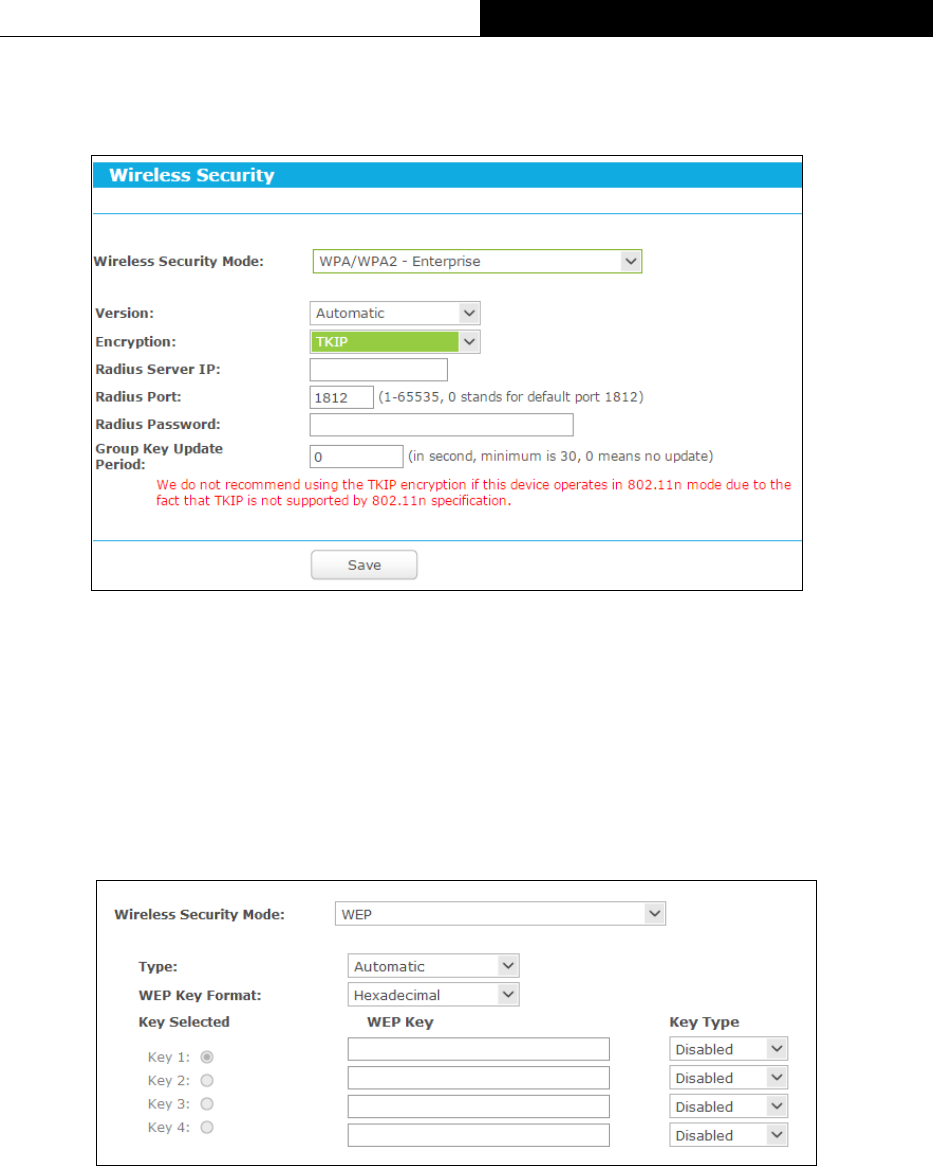
-41-
TL-WR841HP
300Mbps High Power Wireless N Router
Note:
If you check the WPA/WPA2-Enterprise radio button and choose TKIP encryption,
you will find a notice in red as shown below.
Radius Server IP - Enter the IP address of the Radius server.
Radius Port - Enter the port number of the Radius server.
Radius Password - Enter the password for the Radius server.
Group Key Update Period - Specify the group key update interval in seconds. The
value should be 30 or above. Enter 0 to disable the update.
WEP - It is based on the IEEE 802.11 standard.
Figure 3-25 WEP
Type - you can choose the type for the WEP security on the drop-down list. The
default setting is Automatic, which can select Shared Key or Open System
authentication type automatically based on the wireless station's capability and
request.
WEP Key Format - Hexadecimal and ASCII formats are provided here.
Hexadecimal format stands for any combination of hexadecimal digits (0-9, a-f, A-F)
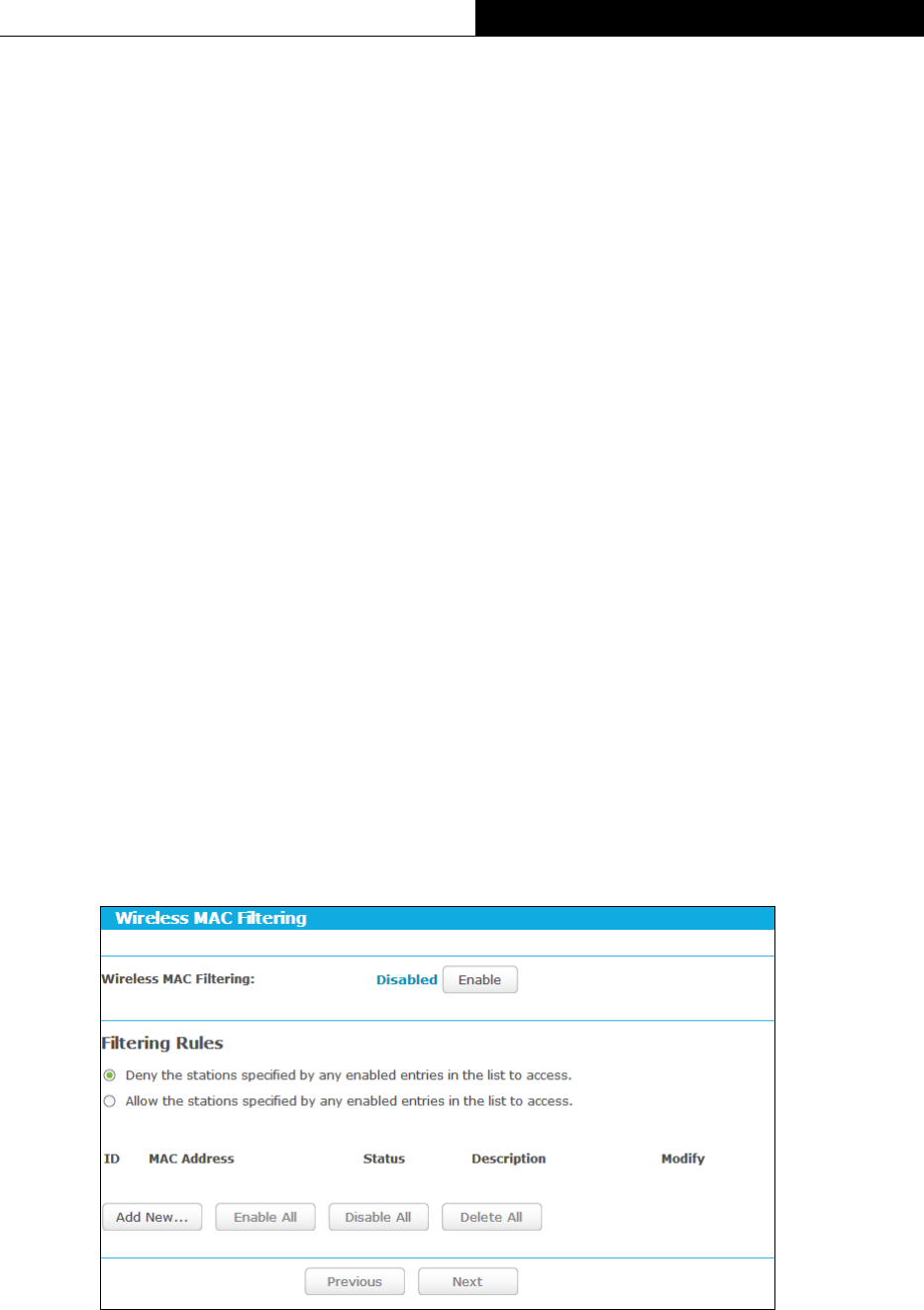
-42-
TL-WR841HP
300Mbps High Power Wireless N Router
in the specified length. ASCII format stands for any combination of keyboard
characters in the specified length.
WEP Key - Select which of the four keys will be used and enter the matching WEP key
that you create. Make sure these values are identical on all wireless stations in your
network.
Key Type - You can select the WEP key length for encryption. "Disabled" means this
WEP key entry is invalid.
64-bit - You can enter 10 hexadecimal digits (any combination of 0-9, a-f, A-F, zero
key is not promoted) or 5 ASCII characters.
128-bit - You can enter 26 hexadecimal digits (any combination of 0-9, a-f, A-F, zero
key is not promoted) or 13 ASCII characters.
152-bit - You can enter 32 hexadecimal digits (any combination of 0-9, a-f, A-F, and
null key is not permitted) or 16 ASCII characters.
Note:
If you do not set the key, the wireless security function is still disabled even if you have
selected Shared Key as Authentication Type.
Be sure to click the Save button to save your settings on this page.
3.4.3.4. Wireless MAC Filtering
Go to “Advanced→Wireless→Wireless MAC Filtering”, you can control the wireless access
by configuring the Wireless MAC Filtering function.
Figure 3-26 Wireless MAC Filtering
To filter wireless users by MAC Address, click Enable. The default setting is Disabled.
MAC Address - The wireless station's MAC address that you want to filter.
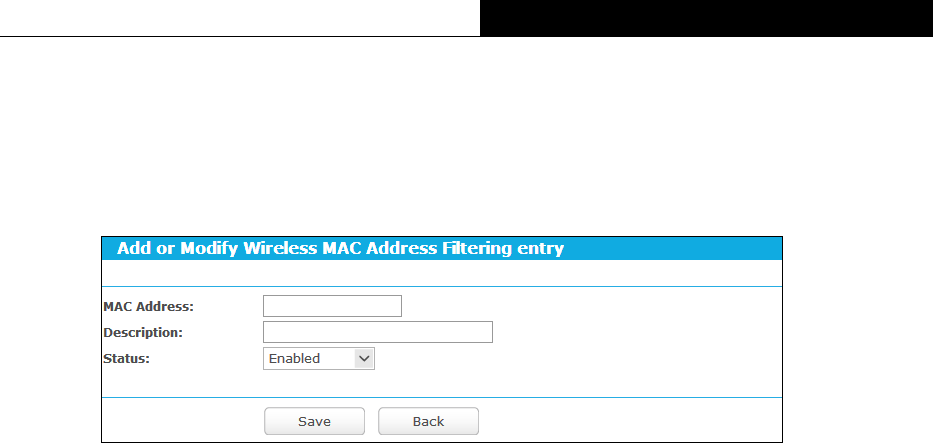
-43-
TL-WR841HP
300Mbps High Power Wireless N Router
Status - The status of this entry, either Enabled or Disabled.
Description - A simple description of the wireless station.
To Add a Wireless MAC Address filtering entry, click the Add New… button. The "Add or
Modify Wireless MAC Address Filtering entry" page will appear.
Figure 3-27 Add or Modify Wireless MAC Address Filtering entry
To add or modify a MAC Address Filtering entry, follow these instructions:
1. Enter the appropriate MAC Address into the MAC Address field. The format of the MAC
Address is XX-XX-XX-XX-XX-XX (X is any hexadecimal digit). For example:
00-0A-EB-B0-00-0B.
2. Give a simple description for the wireless station in the Description field. For example:
Wireless station A.
3. Select Enabled or Disabled for this entry on the Status drop-down list.
4. Click the Save button to save this entry.
To modify or delete an existing entry:
1. Click the Modify in the entry you want to modify. If you want to delete the entry, click the
Delete.
2. Modify the information.
3. Click the Save button.
Click the Enable All button to make all entries enabled
Click the Disable All button to make all entries disabled.
Click the Delete All button to delete all entries.
Click the Next button to go to the next page.
Click the Previous button to return to the previous page.
For example: If you desire that the wireless station A with MAC address 00-0A-EB-B0-00-0B and
the wireless station B with MAC address 00-0A-EB-00-07-5F are able to access the router, but all
the other wireless stations cannot access the router, you can configure the Wireless MAC
Address Filtering list by following these steps:
1. Click the Enable button to enable this function.
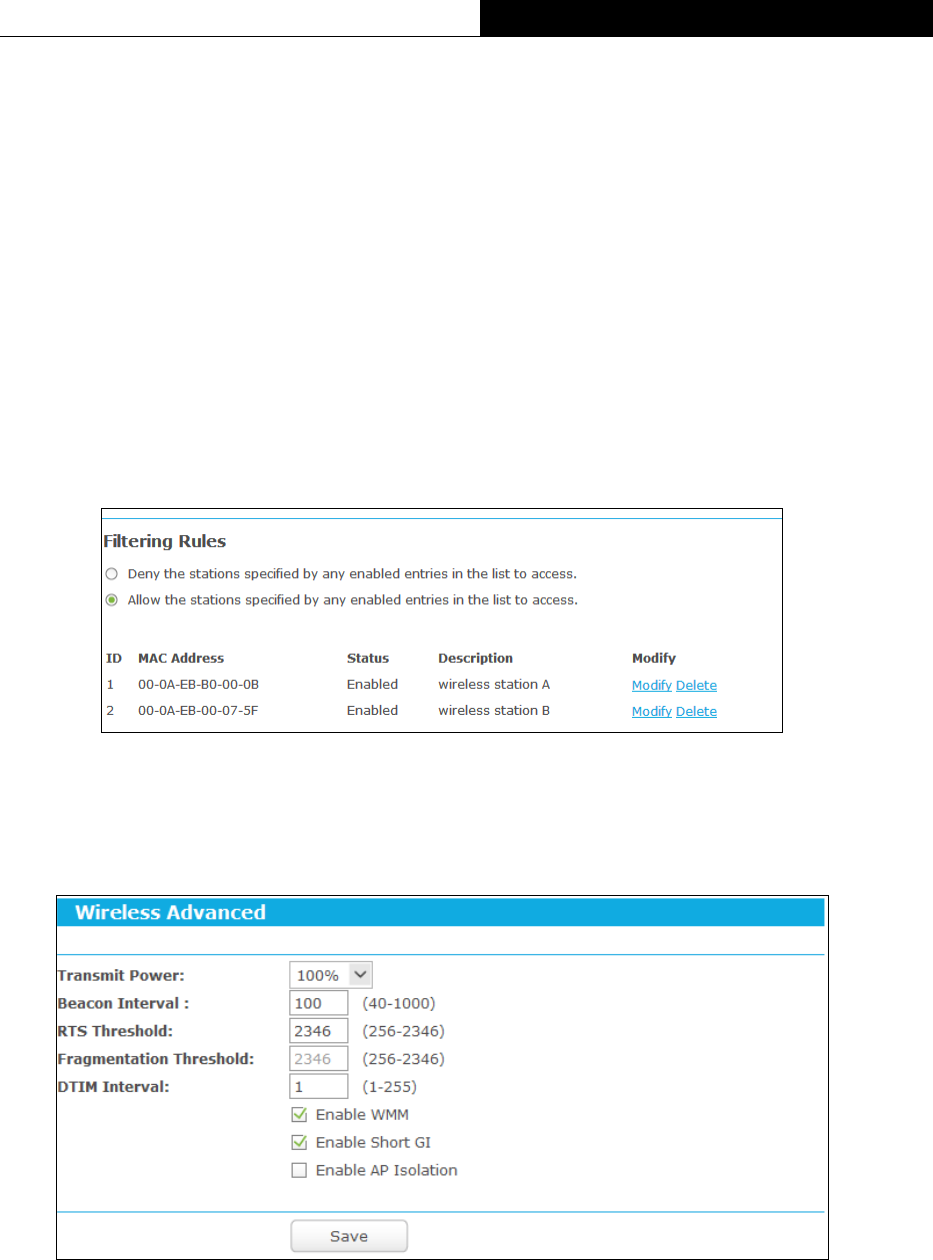
-44-
TL-WR841HP
300Mbps High Power Wireless N Router
2. Select the radio button “Allow the stations specified by any enabled entries in the list
to access” for Filtering Rules.
3. Delete all or disable all entries if there are any entries already.
4. Click the
Add New...
button.
1) Enter the MAC address 00-0A-EB-B0-00-0B/00-0A-EB-00-07-5F in the MAC Address
field.
2) Enter wireless station A/B in the Description field.
3) Select Enabled in the Status drop-down list.
4) Click the Save button.
The filtering rules that configured should be similar to the following list:
3.4.3.5. Wireless Advanced
Go to “Advanced→Wireless→Wireless Advanced”, you can configure the advanced settings
of your wireless network.
Figure 3-28 Wireless Advanced
Transmit Power - Here you can specify the transmit power of this device. You can select
100%, 75% or 50% which you would like.
Beacon Interval - Enter a value between 40-1000 milliseconds for Beacon Interval here.
The beacons are the packets sent by the router to synchronize a wireless network.
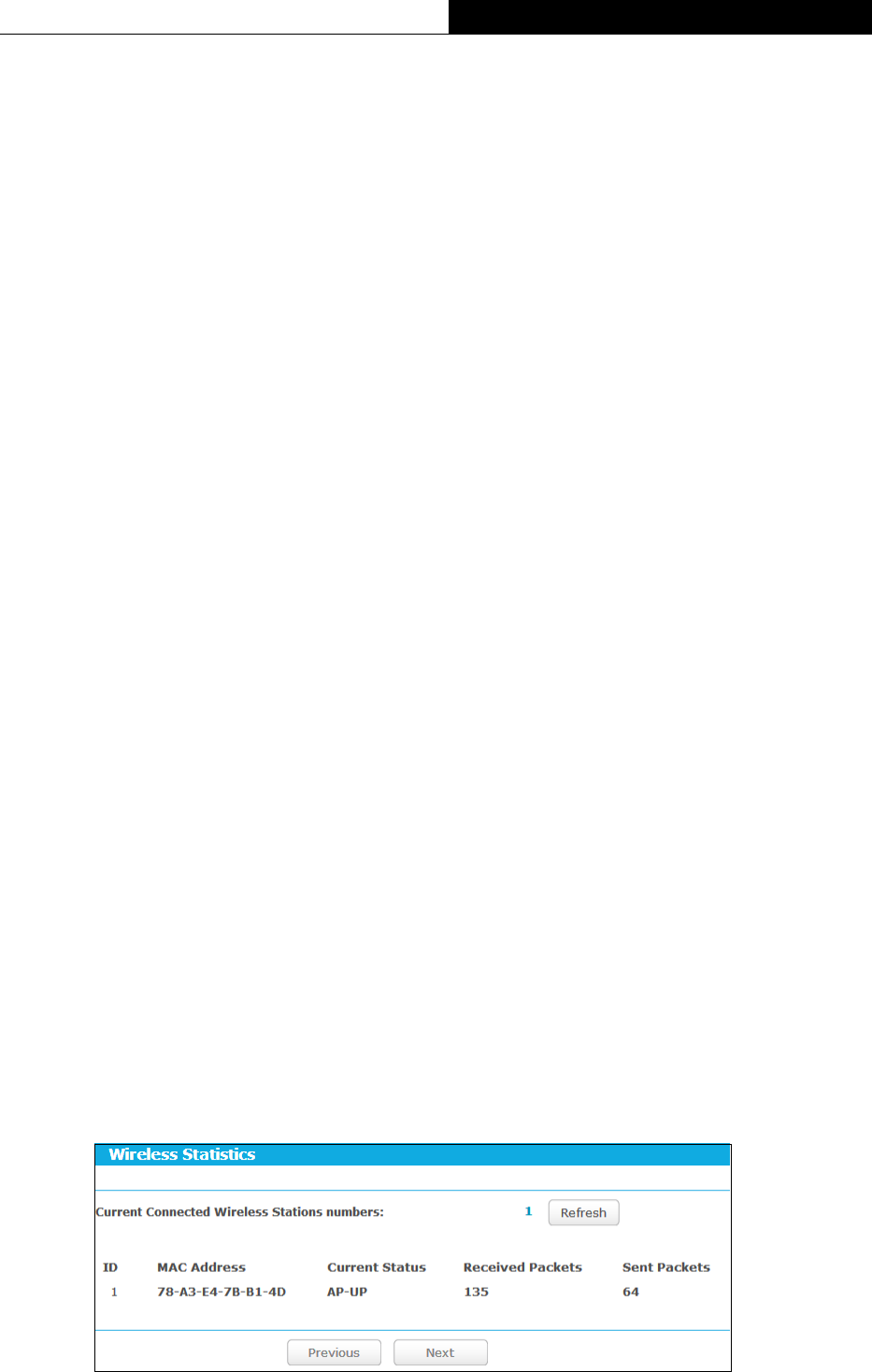
-45-
TL-WR841HP
300Mbps High Power Wireless N Router
Beacon Interval value determines the time interval of the beacons. The default value is
100.
RTS Threshold - Here you can specify the RTS (Request to Send) Threshold. If the
packet is larger than the specified RTS Threshold size, the router will send RTS frames to
a particular receiving station and negotiate the sending of a data frame. The default value
is 2346.
Fragmentation Threshold - This value is the maximum size determining whether
packets will be fragmented. Setting the Fragmentation Threshold too low may result in
poor network performance because of excessive packets. 2346 is the default setting and
is recommended.
DTIM Interval - This value determines the interval of the Delivery Traffic Indication
Message (DTIM). A DTIM field is a countdown field informing clients of the next window
for listening to broadcast and multicast messages. When the router has buffered
broadcast or multicast messages for associated clients, it sends the next DTIM with a
DTIM Interval value. You can specify the value between 1-255 Beacon Intervals. The
default value is 1, which indicates the DTIM Interval is the same as Beacon Interval.
Enable WMM - WMM function can guarantee the packets with high-priority messages
being transmitted preferentially. It is strongly recommended.
Enable Short GI - This function is recommended for it will increase the data capacity by
reducing the guard interval time.
Enabled AP Isolation - This function can isolate wireless stations on your network from
each other. Wireless devices will be able to communicate with the router but not with each
other. To use this function, check this box. AP Isolation is disabled by default.
Note:
If you are not familiar with the setting items in this page, it's strongly recommended to keep the
provided default values; otherwise it may result in lower wireless network performance.
3.4.4 Wireless Statistics
Go to “Advanced→Wireless 2.4GHz→Wireless Statistics”, you can see the MAC Address,
Current Status, Received Packets and Sent Packets for each connected wireless station.
Figure 3-29 Wireless Statistics
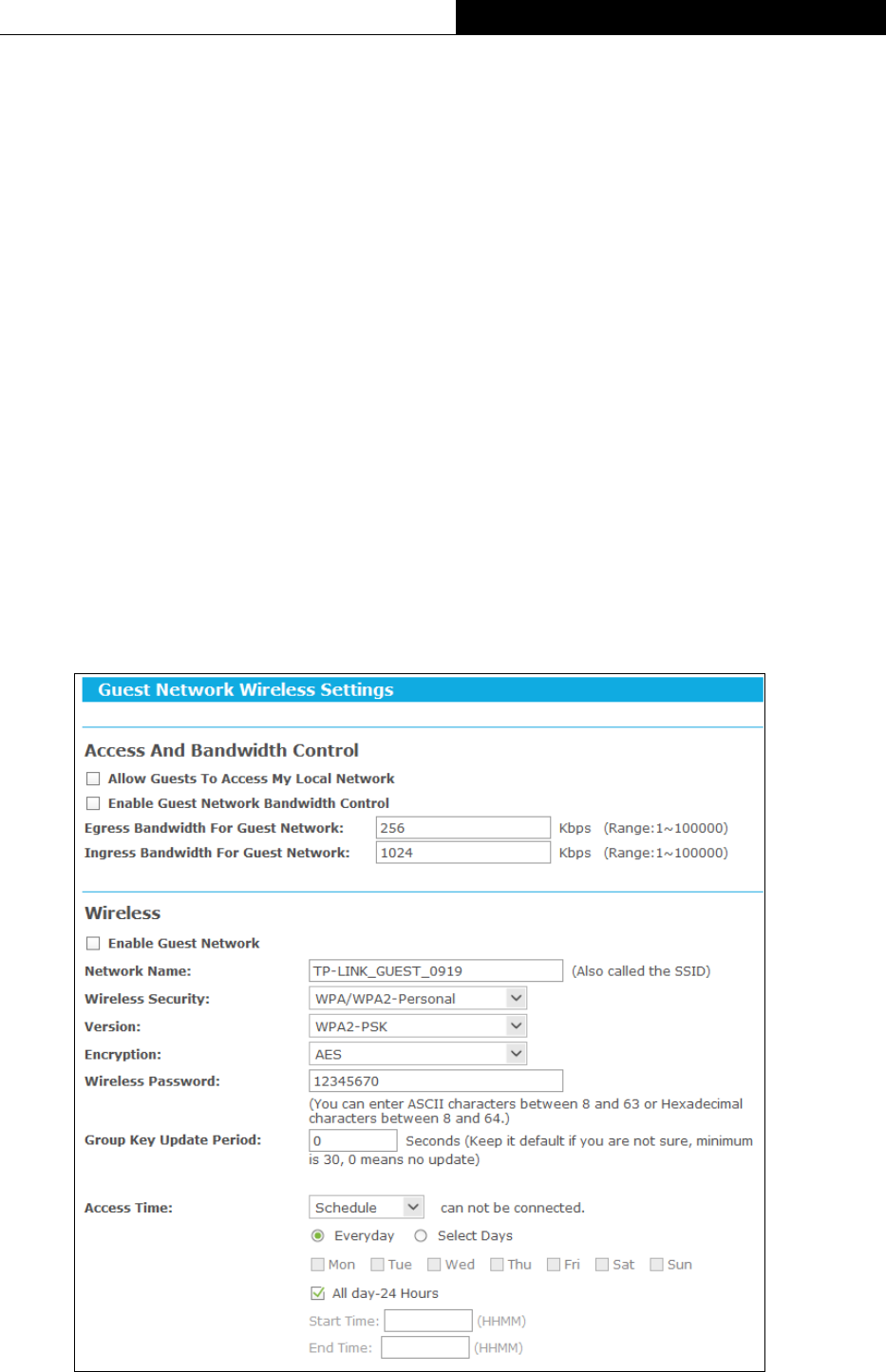
-46-
TL-WR841HP
300Mbps High Power Wireless N Router
MAC Address - The connected wireless station's MAC address
Current Status - The connected wireless station's running status, one of STA-AUTH/
STA-ASSOC/ STA-JOINED/ WPA/ WPA-PSK/ WPA2/ WPA2-PSK/ AP-UP/ AP-DOWN/
Disconnected
Received Packets - Packets received by the station
Sent Packets - Packets sent by the station
You cannot change any of the values on this page. To update this page and to show the
current connected wireless stations, click on the Refresh button.
If the numbers of connected wireless stations go beyond one page, click the Next button to go
to the next page and click the Previous button to return the previous page.
Note:
This page will be refreshed automatically every 5 seconds.
3.4.5 Guest Network
Go to “Advanced → Guest Network”, you can configure the Guest Network Wireless Settings
on the page as shown below.
Figure 3-30 Guest Network Wireless Settings
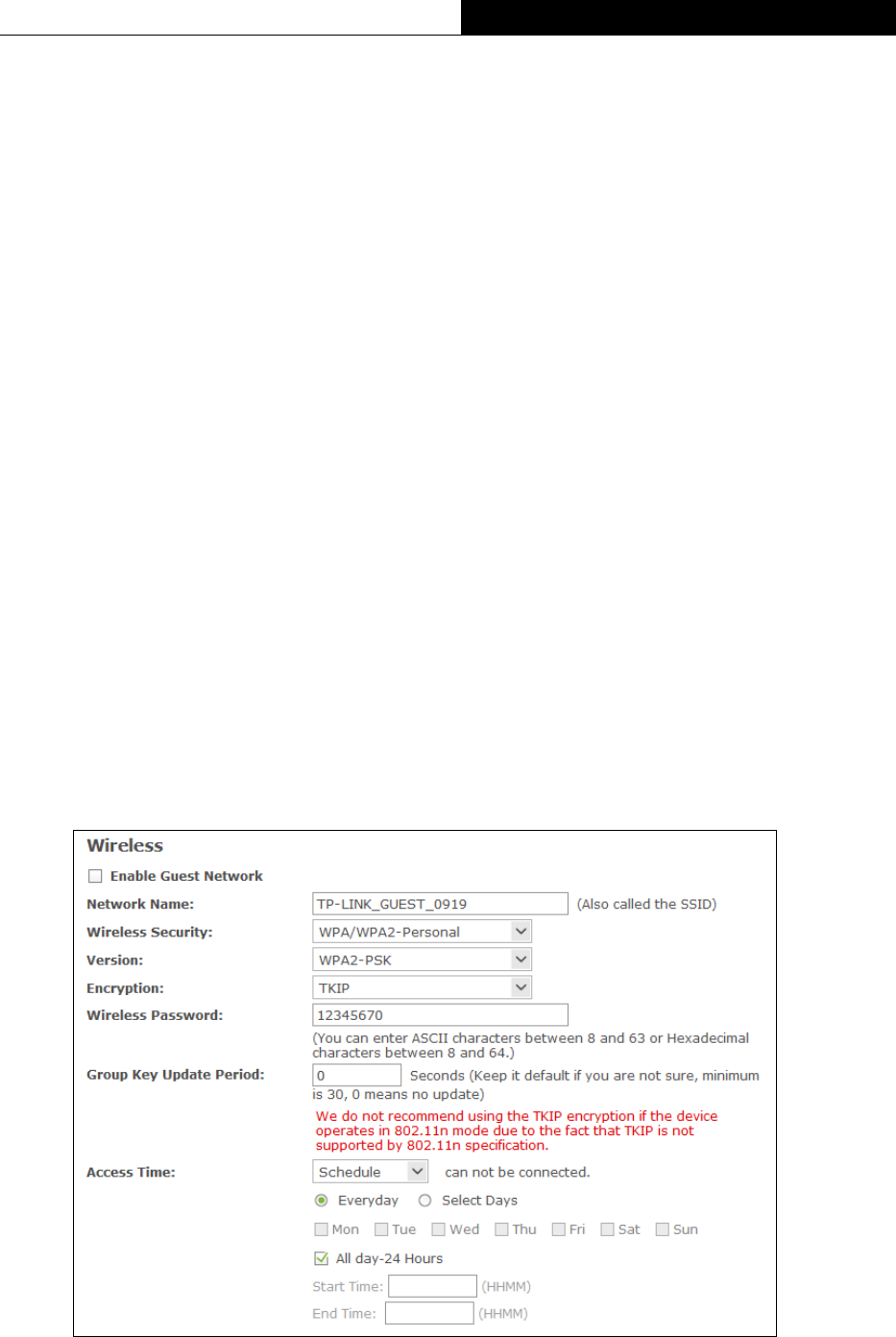
-47-
TL-WR841HP
300Mbps High Power Wireless N Router
Allow Guest To Access My Local Network - If enabled, guests can communicate with
hosts.
Enable Guest Network Bandwidth Control - If enabled, the Guest Network Bandwidth
Control rules will take effect.
Egress Bandwidth For Guest Network - The upload speed through the WAN port for
Guest Network.
Ingress Bandwidth For Guest Network - The download speed through the WAN port for
Guest Network.
Enable Guest Network – If enabled, the Guest Network function will take effect.
Network Name - Enter a value of up to 32 characters. The same Name (SSID) must be
assigned to all wireless devices in your Guest Network.
Wireless Security - You can choose the security type of Guest Network here.
Version - You can choose the version of the WPA/WPA2-Personal security on the
drop-down list. The default setting is WPA2-PSK.
Encryption - You can select Automatic (Recommended), TKIP or AES as Encryption.
The default setting is AES.
Note:
If you choose TKIP encryption, you will find a notice in red as shown below.
Wireless Password - You can enter ASCII characters between 8 and 63 characters or 8 to
64 Hexadecimal characters.
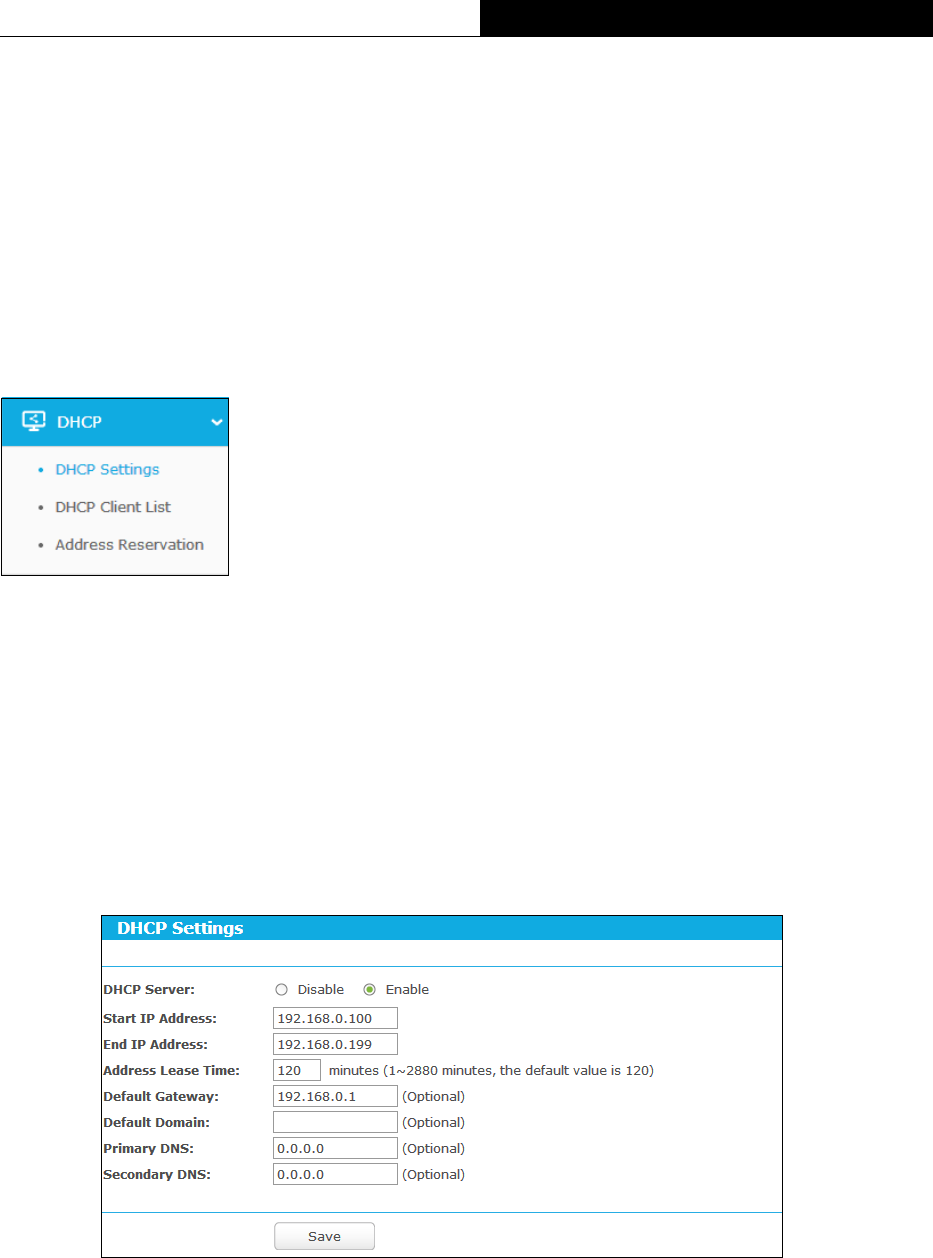
-48-
TL-WR841HP
300Mbps High Power Wireless N Router
Group Key Update Period - Specify the group key update interval in seconds. The value
should be 30 or above. Enter 0 to disable the update.
Access Time - During this time the wireless stations could accessing the AP.
Note:
The range of bandwidth for Guest Network is calculated according to the setting of Bandwidth
Control on the page “Bandwidth Control->Control Settings”.
3.4.6 DHCP
There are three submenus under the DHCP menu: DHCP Settings, DHCP Clients List and
Address Reservation. Click any of them, and you will be able to configure the corresponding
functions.
3.4.6.1. DHCP Settings
Go to “Advanced→DHCP→DHCP Settings”, you can configure the DHCP Server on the page
as shown below.The router is set up by default as a DHCP (Dynamic Host Configuration
Protocol) server, which provides the TCP/IP configuration for all the PC(s) that are connected to
the router on the LAN.
Figure 3-31 DHCP Settings
DHCP Server - Enable or Disable the DHCP server. If you disable the Server, you must
have another DHCP server within your network or else you must configure the computer
manually.
Start IP Address - Specify an IP address for the DHCP Server to start with when
assigning IP addresses. 192.168.0.100 is the default start address.
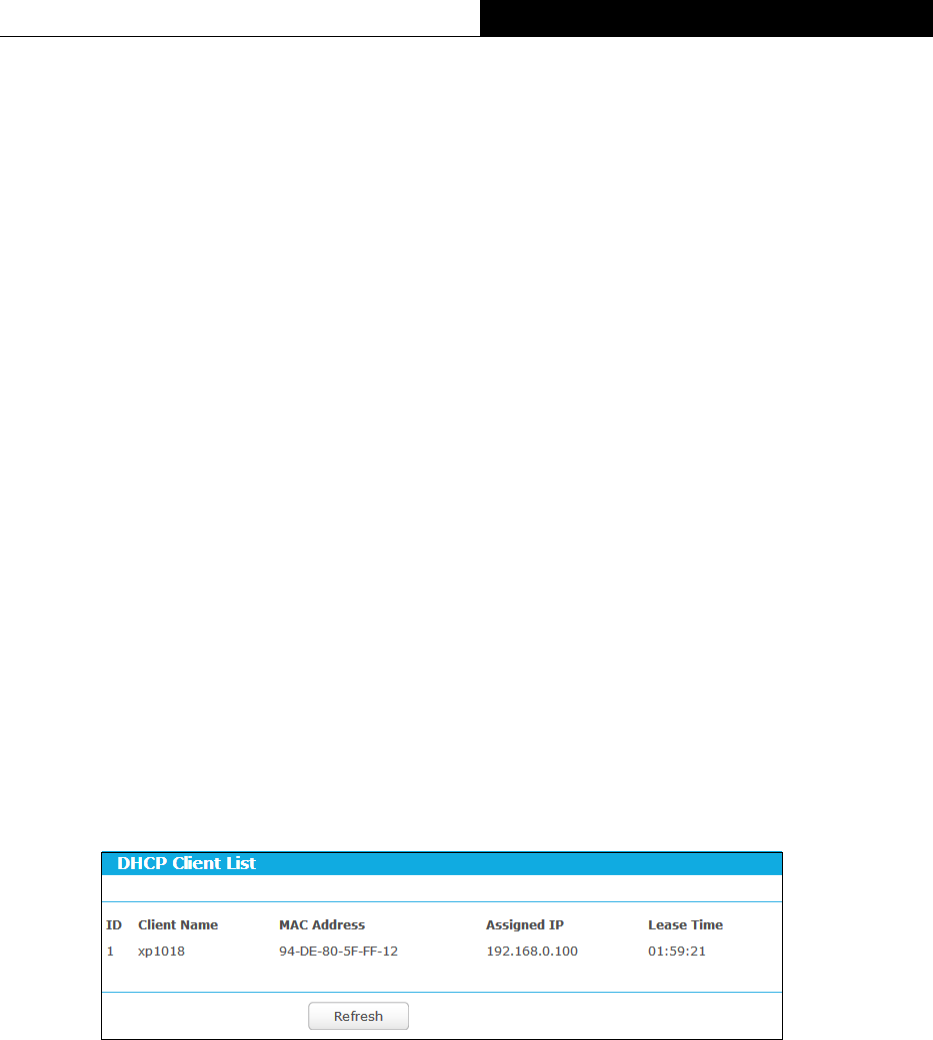
-49-
TL-WR841HP
300Mbps High Power Wireless N Router
End IP Address - Specify an IP address for the DHCP Server to end with when assigning
IP addresses. 192.168.0.199 is the default end address.
Address Lease Time - The Address Lease Time is the amount of time a network user
will be allowed connection to the router with their current dynamic IP Address. Enter the
amount of time in minutes and the user will be "leased" this dynamic IP Address. After the
time is up, the user will be automatically assigned a new dynamic IP address. The range
of the time is 1 ~ 2880 minutes. The default value is 120 minutes.
Default Gateway - (Optional.) It is suggested to input the IP address of the Ethernet port
of the router. The default value is 192.168.0.1.
Default Domain - (Optional) Input the domain name of your network.
Primary DNS - (Optional) Input the DNS IP address provided by your ISP or consult your ISP.
Secondary DNS - (Optional.) Input the IP address of another DNS server if your ISP
provides two DNS servers.
Note:
To use the DHCP server function of the router, you must configure all computers on the LAN as
"Obtain an IP Address automatically".
3.4.6.2. DHCP Clients List
Go to “Advanced→DHCP→DHCP Clients List”, you can view the information about the
clients connected to the router.
Figure 3-32 DHCP Clients List
Client Name - The name of the DHCP client
MAC Address - The MAC address of the DHCP client
Assigned IP - The IP address that the router has allocated to the DHCP client
Lease Time - The time of the DHCP client leased. After the dynamic IP address has
expired, a new dynamic IP address will be automatically assigned to the user.
You cannot change any of the values on this page. To update this page and to show the
current attached devices, click the Refresh button.
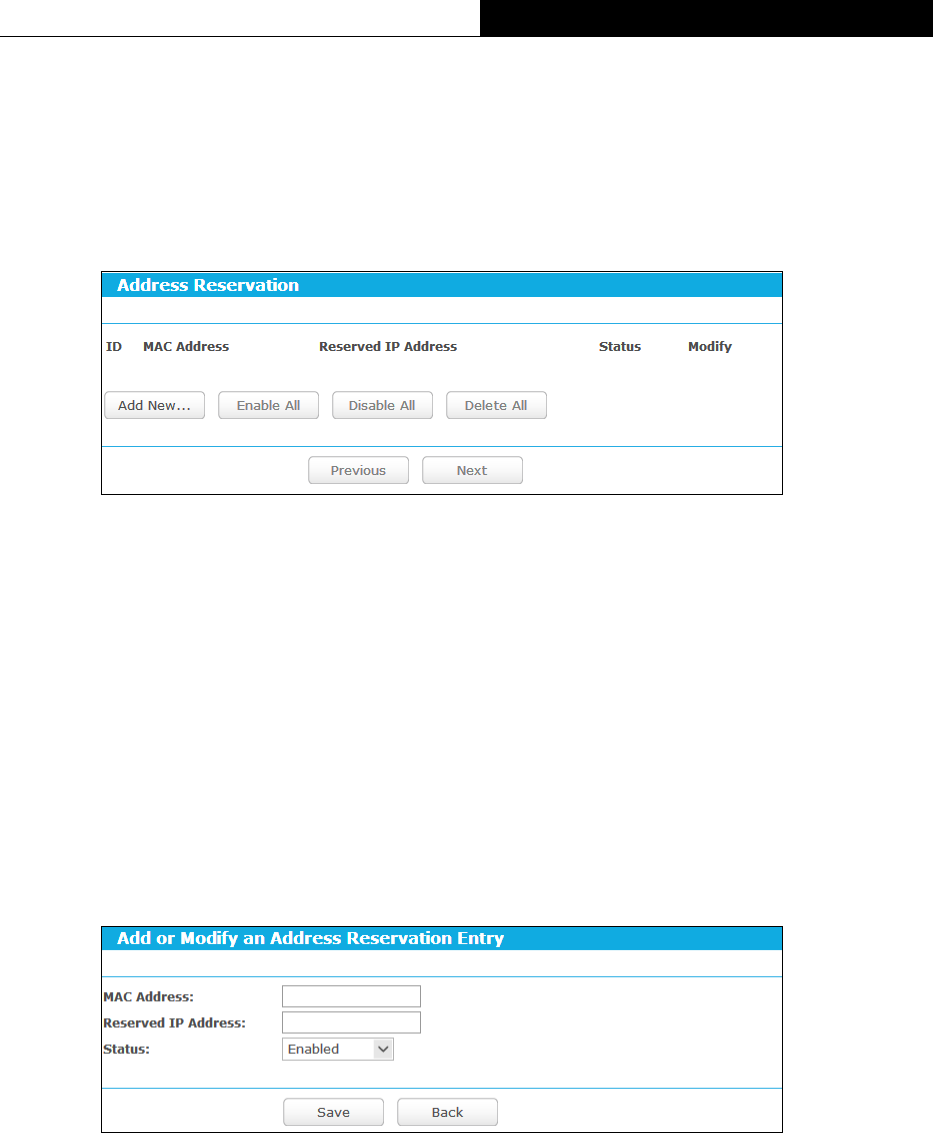
-50-
TL-WR841HP
300Mbps High Power Wireless N Router
3.4.6.3. Address Reservation
Go to “Advanced→DHCP→Address Reservation”, you can view and add a reserved address
for clients. When you specify a reserved IP address for a PC on the LAN, that PC will always
receive the same IP address each time when it accesses the DHCP server. Reserved IP
addresses should be assigned to the servers that require permanent IP settings.
Figure 3-33 Address Reservation
MAC Address - The MAC address of the PC for which you want to reserve an IP address.
Reserved IP Address - The IP address reserved for the PC by the router.
Status - The status of this entry, either Enabled or Disabled.
To Reserve an IP address:
1. Click the Add New… button.
2. Enter the MAC address (in XX-XX-XX-XX-XX-XX format.) and IP address (in
dotted-decimal notation) of the computer for which you want to reserve an IP address.
3. Click the Save button.
Figure 3-34 Add or Modify an Address Reservation Entry
To modify or delete an existing entry:
1. Click the Modify in the entry you want to modify. If you want to delete the entry, click the
Delete.
2. Modify the information.
3. Click the Save button.
Click the Enable/Disable All button to make all entries enabled/disabled
Click the Delete All button to delete all entries.
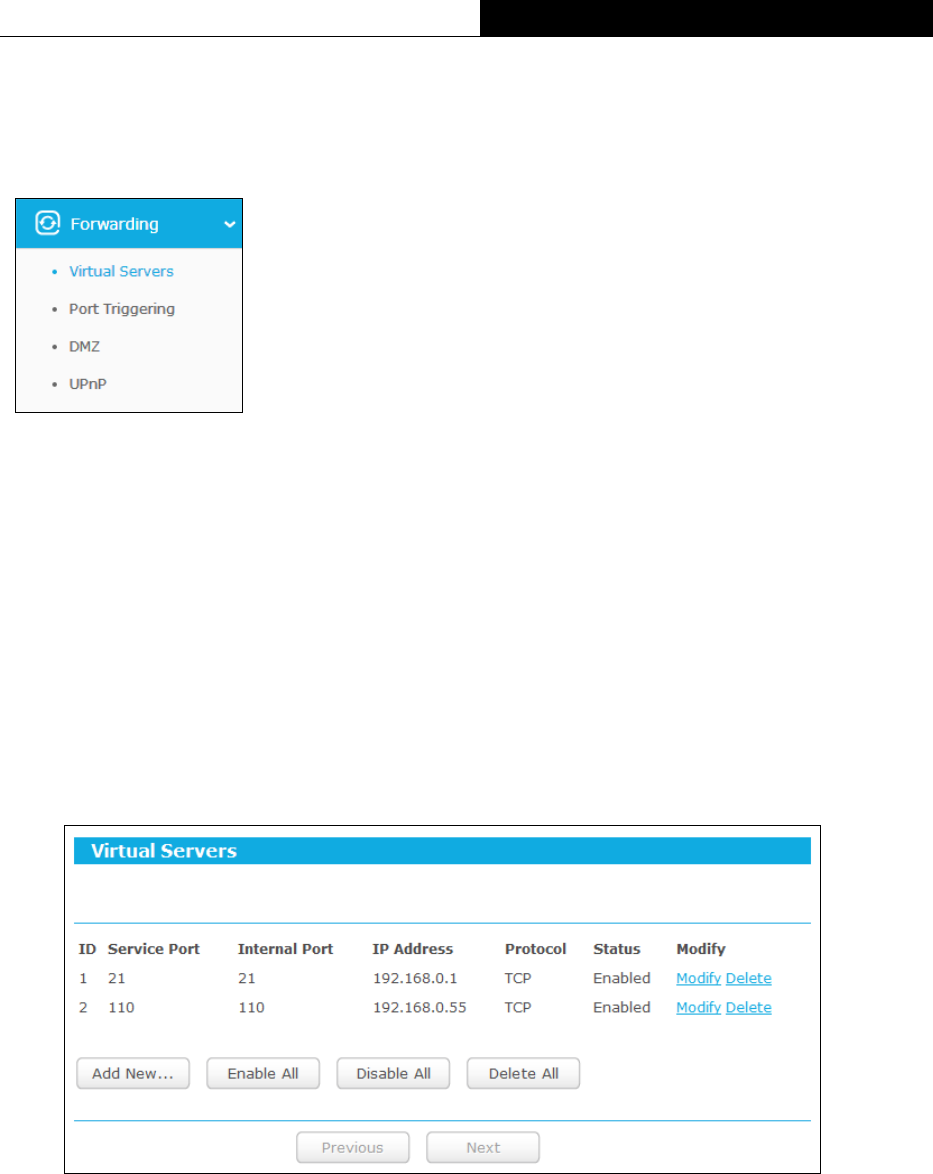
-51-
TL-WR841HP
300Mbps High Power Wireless N Router
Click the Next button to go to the next page and Click the Previous button to return the
previous page.
3.4.7 Forwarding
There are four submenus under the Forwarding menu: Virtual Servers, Port Triggering, DMZ
and UPnP. Click any of them, and you will be able to configure the corresponding function.
3.4.7.1. Virtual Servers
Go to “Advanced→Forwarding→Virtual Servers”, and then you can view and add virtual
servers. Virtual servers can be used for setting up public services on your LAN. A virtual server
is defined as a service port, and all requests from Internet to this service port will be redirected
to the computer specified by the server IP. Any PC that was used for a virtual server must have
a static or reserved IP address because its IP address may change when using the DHCP
function. If you want the Virtual Servers configuration take effect, please make sure the NAT is
enabled.
Figure 3-35 Virtual Servers
Service Port - The numbers of External Service Ports. You can enter a service port or a
range of service ports (the format is XXX – YYY; XXX is the Start port and YYY is the End
port).
Internal Port - The Internal Service Port number of the PC running the service application.
You can leave it blank if the Internal Port is the same as the Service Port, or enter a
specific port number when Service Port is a single one.
IP Address - The IP address of the PC running the service application.
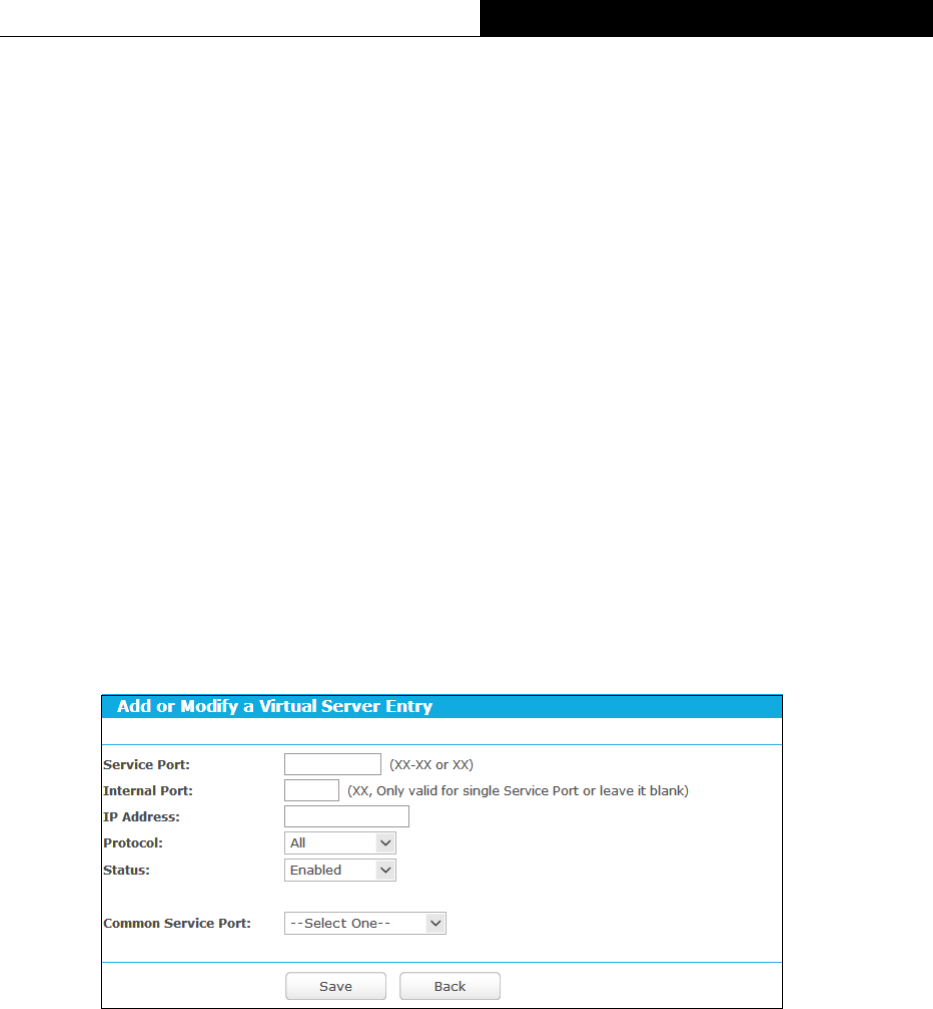
-52-
TL-WR841HP
300Mbps High Power Wireless N Router
Protocol - The protocol used for this application, either TCP, UDP, or All (all protocols
supported by the router).
Status - The status of this entry, "Enabled" means the virtual server entry is enabled.
Modify - To modify or delete an existing entry.
To setup a virtual server entry:
1. Click the Add New... button.
2. Select the service you want to use from the Common Service Port list. If the Common
Service Port menu does not list the service that you want to use, enter the number of the
service port or service port range in the Service Port field.
3. Enter the IP address of the computer running the service application in the IP Address
field.
4. Select the protocol used for this application in the Protocol drop-down list, either TCP,
UDP, or All.
5. Select the Enabled option in the Status drop-down list.
6. Click the Save button.
Figure 3-36 Add or Modify a Virtual Server Entry
Note:
It is possible that you have a computer or server that has more than one type of available service.
If so, select another service, and type the same IP address for that computer or server.
To modify or delete an existing entry:
1. Find the desired entry in the table.
2. Click Modify or Delete as desired on the Modify column.
Click the Enable All/ Disable All button to make all entries enabled/ disabled.
Click the Delete All button to delete all entries.
Click the Next button to go to the next page and click the Previous button to return to the
previous page.
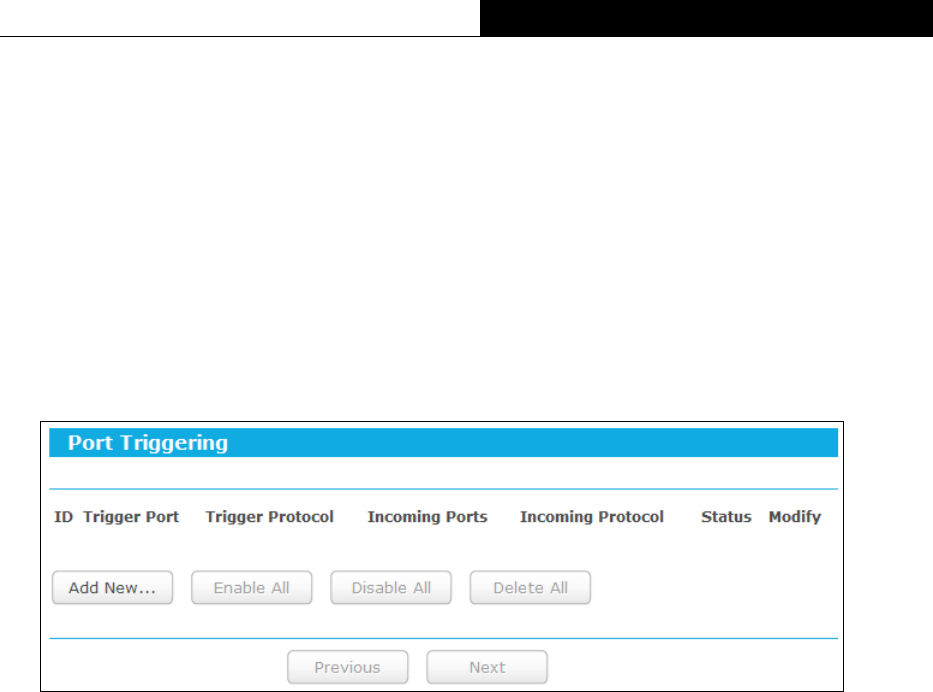
-53-
TL-WR841HP
300Mbps High Power Wireless N Router
Note:
If you set the service port of the virtual server as 80, you must set the Web management port on
Advanced→Security→Remote Management page to be any other value except 80 such as
8080. Otherwise there will be a conflict to disable the virtual server.
3.4.7.2. Port Triggering
Go to “Advanced→Forwarding→Port Triggering”, you can view and add port triggering in
this page. Some applications require multiple connections, like Internet games, video
conferencing, Internet telephoning and so on. Port Triggering is used for some of these
applications that cannot work with a pure NAT router.
Figure 3-37 Port Triggering
To add a new rule, follow the steps below.
1. Click the Add New… button, the next screen will pop-up as shown in Figure 3-38.
2. Select a common application from the Common Applications drop-down list, then the
Trigger Port field and the Incoming Ports field will be automatically filled. If the Common
Applications do not have the application you need, enter the Trigger Port and the
Incoming Ports manually.
3. Select the protocol used for Trigger Port from the Trigger Protocol drop-down list, TCP,
UDP, or All.
4. Select the protocol used for Incoming Ports from the Incoming Protocol drop-down list,
TCP or UDP, or All.
5. Select Enabled in Status field.
6. Click the Save button to save the new rule.
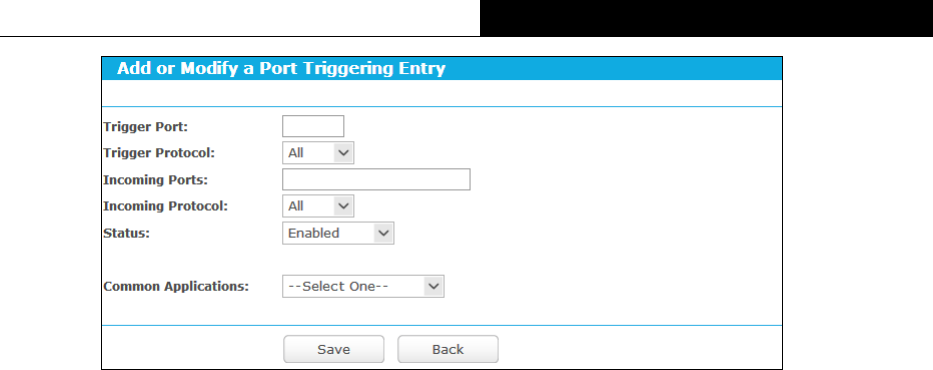
-54-
TL-WR841HP
300Mbps High Power Wireless N Router
Figure 3-38 Add or Modify a Triggering Entry
Trigger Port - The port for outgoing traffic. An outgoing connection using this port will
trigger this rule.
Trigger Protocol - The protocol used for Trigger Ports, either TCP, UDP, or All (all
protocols supported by the router).
Incoming Ports - The port or port range used by the remote system when it responds to
the outgoing request. A response using one of these ports will be forwarded to the PC
which triggered this rule. You can input at most 5 groups of ports (or port sections). Every
group of ports must be separated with ",", for example, 2000-2038, 2046, 2050-2051,
2085, 3010-3030.
Incoming Protocol - The protocol used for Incoming Port, either TCP, UDP, or ALL (all
protocols supported by the router).
Status - The status of this entry, Enabled means the Port Triggering entry is enabled.
Modify - To modify or delete an existing entry.
Common Applications - Some popular applications already listed in the drop-down list of
Incoming Protocol.
To modify or delete an existing entry:
1. Find the desired entry in the table.
2. Click Modify or Delete as desired on the Modify column.
Click the Enable All button to make all entries enabled.
Click the Disable All button to make all entries disabled.
Click the Delete All button to delete all entries
Once the router is configured, the operation is as follows:
1. A local host makes an outgoing connection to an external host using a destination port
number defined in the Trigger Port field.
2. The router records this connection, opens the incoming port or ports associated with this
entry in the Port Triggering table, and associates them with the local host.
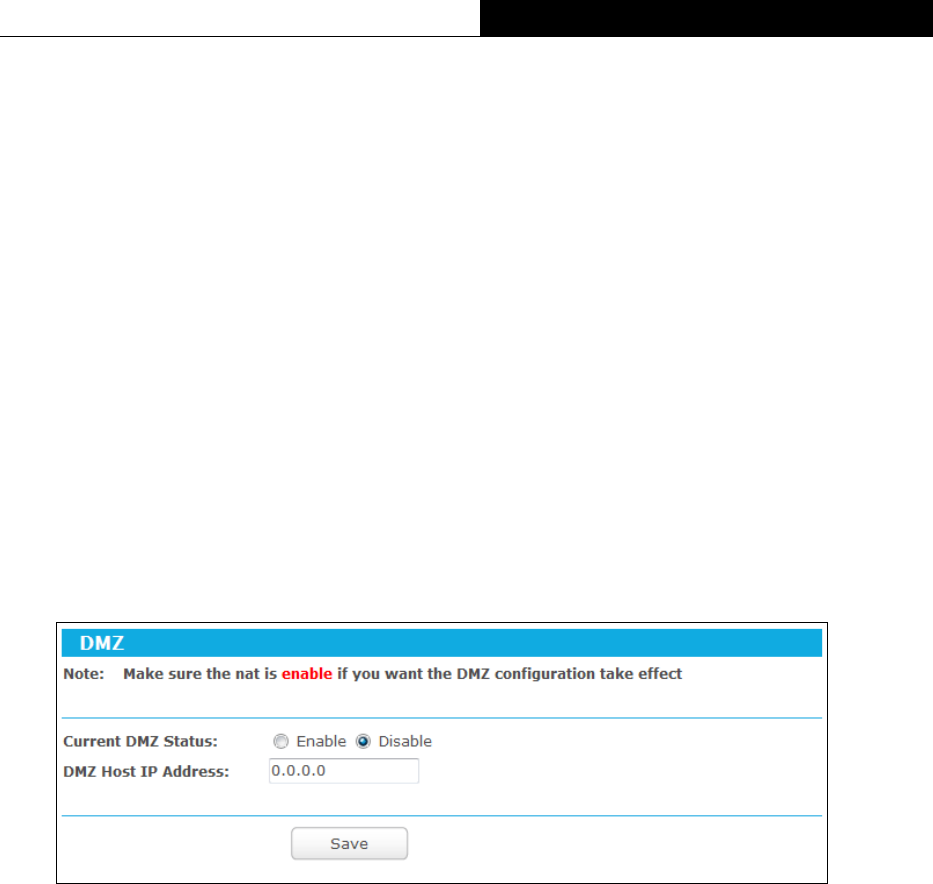
-55-
TL-WR841HP
300Mbps High Power Wireless N Router
3. When necessary, the external host will be able to connect to the local host using one of
the ports defined in the Incoming Ports field.
Note:
1. When the trigger connection is released, the corresponding opened ports will be closed.
2. Each rule can only be used by one host on the LAN at a time. The trigger connection of
other hosts on the LAN will be refused.
3. Incoming Ports ranges cannot overlap each other.
3.4.7.3. DMZ
Go to “Advanced→Forwarding→DMZ”, and then you can view and configure DMZ host in this
page. The DMZ host feature allows one local host to be exposed to the Internet for a
special-purpose service such as Internet gaming or videoconferencing. The router forwards
packets of all services to the DMZ host. Any PC whose port is being forwarded must have its
DHCP client function disabled and should have a new static IP Address assigned to it because
its IP Address may be changed when using the DHCP function.
Figure 3-39 DMZ
To assign a computer or server to be a DMZ server:
1. Select the Enable radio button.
2. Enter the IP address of a local PC that is set to be DMZ host in the DMZ Host IP Address
field.
3. Click the Save button.
3.4.7.4. UPnP
Go to “Advanced→Forwarding→UPnP”, and then you can view the information about UPnP
in the screen shown in Figure 3-40. The Universal Plug and Play (UPnP) feature allows the
devices, such as Internet computers, to access the local host resources or devices as needed.
UPnP devices can be automatically discovered by the UPnP service application on the LAN.
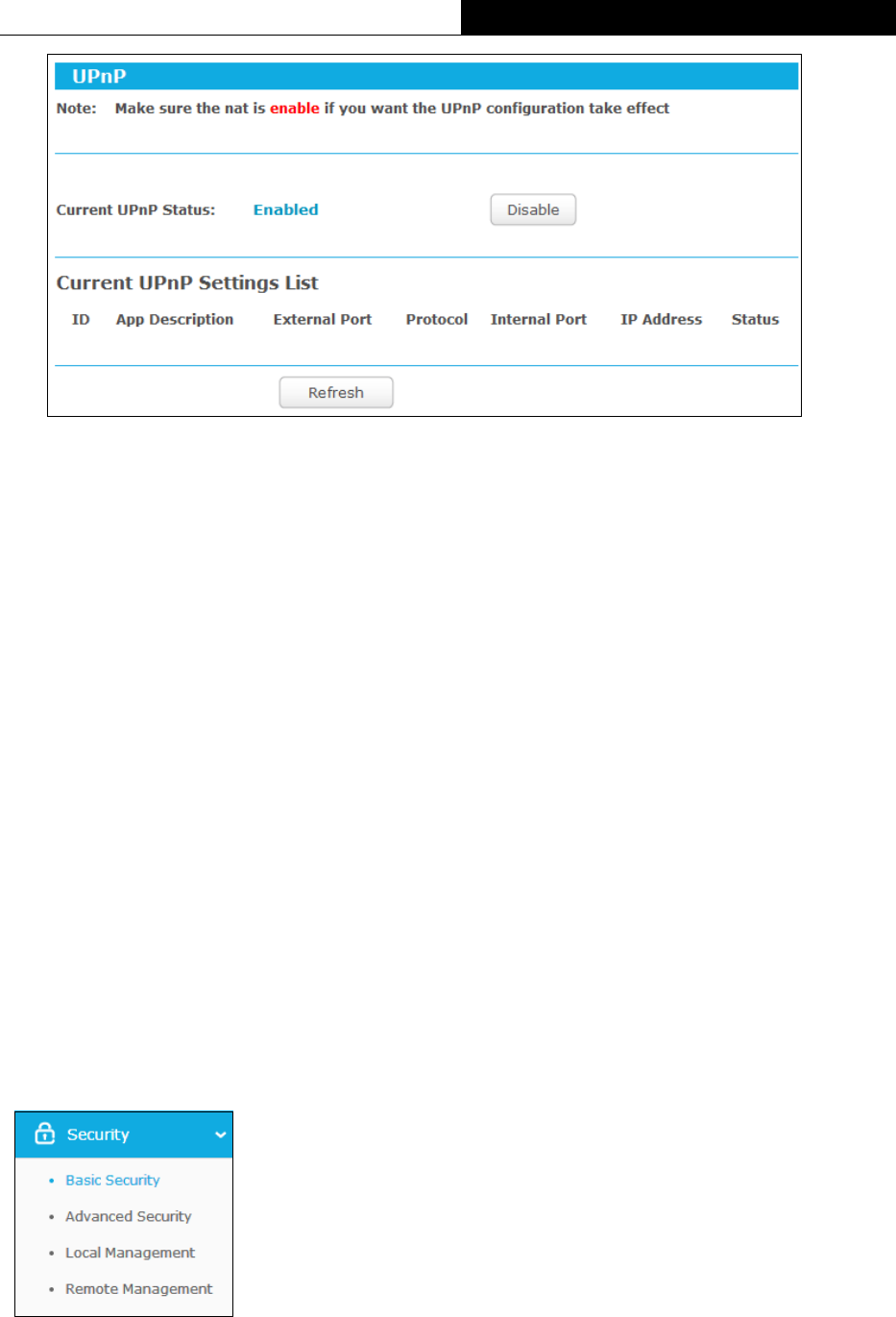
-56-
TL-WR841HP
300Mbps High Power Wireless N Router
Figure 3-40 UPnP Setting
Current UPnP Status - UPnP can be enabled or disabled by clicking the Enable or
Disable button. This feature is enabled by default.
Current UPnP Settings List - This table displays the current UPnP information.
App Description - The description about the application which initiates the UPnP
request.
External Port - The port which the router opened for the application.
Protocol - The type of protocol which is opened.
Internal Port - The port which the router opened for local host.
IP Address - The IP address of the local host which initiates the UPnP request.
Status - Either Enabled or Disabled. "Enabled" means that the port is still active;
otherwise, the port is inactive.
Click the Enable button to enable UPnP.
Click the Disable button to disable UPnP.
Click the Refresh button to update the Current UPnP Settings List.
3.4.8 Security
There are four submenus under the Security menu: Basic Security, Advanced Security,
Local Management and Remote Management. Click any of them, and you will be able to
configure the corresponding functions.
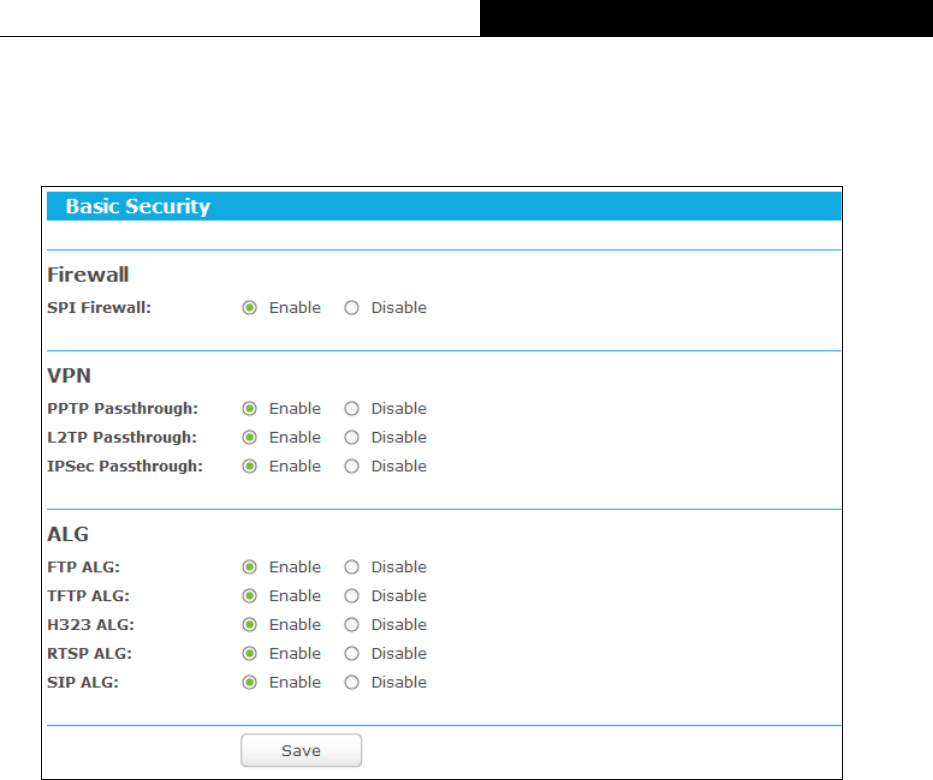
-57-
TL-WR841HP
300Mbps High Power Wireless N Router
3.4.8.1. Basic Security
Go to “Advanced→Security→Basic Security”, and then you can configure the basic security
in this page.
Figure 3-41 Basic Security
Firewall - A firewall protects your network from the outside world. Here you can enable or
disable the router’s firewall.
SPI Firewall - SPI (Stateful Packet Inspection, also known as dynamic packet filtering)
helps to prevent cyber attacks by tracking more state per session. It validates that the
traffic passing through the session conforms to the protocol. SPI Firewall is enabled
by factory default. If you want all the computers on the LAN exposed to the outside
world, you can disable it.
VPN - VPN Passthrough must be enabled if you want to allow VPN tunnels using VPN
protocols to pass through the router.
PPTP Passthrough - Point-to-Point Tunneling Protocol (PPTP) allows the
Point-to-Point Protocol (PPP) to be tunneled through an IP network. To allow PPTP
tunnels to pass through the router, click Enable.
L2TP Passthrough - Layer Two Tunneling Protocol (L2TP) is the method used to
enable Point-to-Point sessions via the Internet on the Layer Two level. To allow L2TP
tunnels to pass through the router, click Enable.
IPSec Passthrough - Internet Protocol security (IPSec) is a suite of protocols for
ensuring private, secure communications over Internet Protocol (IP) networks,

-58-
TL-WR841HP
300Mbps High Power Wireless N Router
through the use of cryptographic security services. To allow IPSec tunnels to pass
through the router, click Enable.
ALG - It is recommended to enable Application Layer Gateway (ALG) because ALG allows
customized Network Address Translation (NAT) traversal filters to be plugged into the
gateway to support address and port translation for certain application layer "control/data"
protocols such as FTP, TFTP, H323 etc.
FTP ALG - To allow FTP clients and servers to transfer data across NAT, click
Enable.
TFTP ALG - To allow TFTP clients and servers to transfer data across NAT, click
Enable.
H323 ALG - To allow Microsoft NetMeeting clients to communicate across NAT, click
Enable.
RTSP ALG - To allow some media player clients to communicate with some
streaming media servers across NAT, click Enable.
SIP ALG - To allow some multimedia clients to communicate across NAT, click
Enable.
Click the Save button to save your settings.
3.4.8.2. Advanced Security
Go to “Advanced→Security→Advanced Security”, and then you can protect the router from
being attacked by TCP-SYN Flood, UDP Flood and ICMP-Flood in this page.
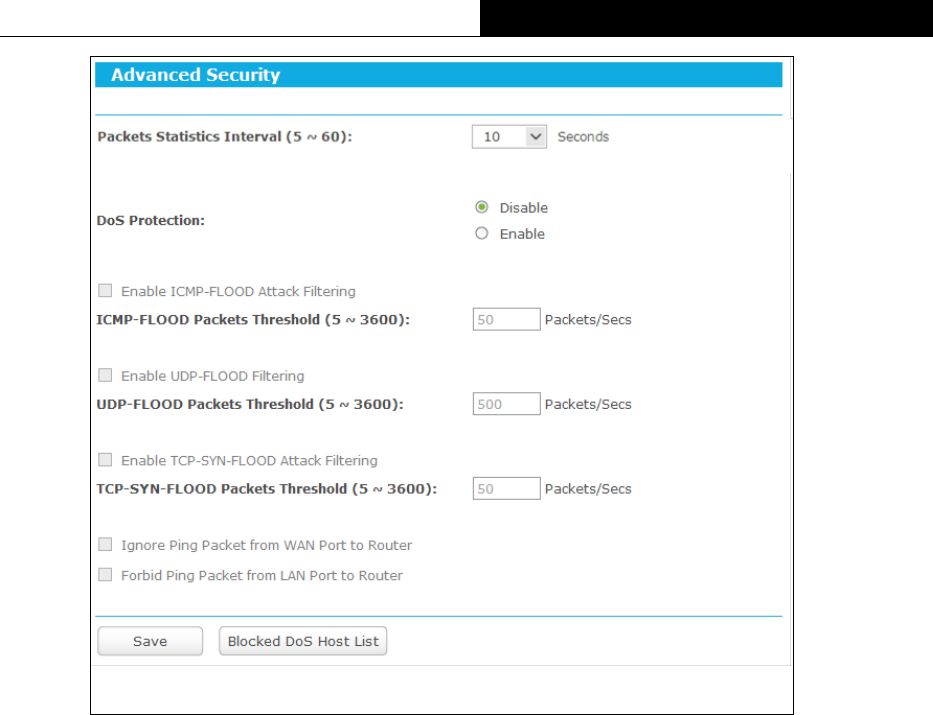
-59-
TL-WR841HP
300Mbps High Power Wireless N Router
Figure 3-42 Advanced Security
Packets Statistics Interval (5~60) - The default value is 10. Select a value between 5
and 60 seconds from the drop-down list. The Packets Statistics Interval value indicates
the time section of the packets statistics. The result of the statistics is used for analysis by
SYN Flood, UDP Flood and ICMP-Flood.
DoS Protection - Denial of Service protection. Check the Enable or Disable button to
enable or disable the DoS protection function. Only when it is enabled, will the flood filters
be enabled.
Note:
Dos Protection will take effect only when the Traffic Statistics in “Advanced→System
Tools→Statistics” is enabled.
Enable ICMP-FLOOD Attack Filtering - Enable or Disable the ICMP-FLOOD Attack
Filtering.
ICMP-FLOOD Packets Threshold (5~3600) - The default value is 50. Enter a value
between 5 ~ 3600. When the current ICMP-FLOOD Packets number is beyond the set
value, the router will startup the blocking function immediately.
Enable UDP-FLOOD Filtering - Enable or Disable the UDP-FLOOD Filtering.
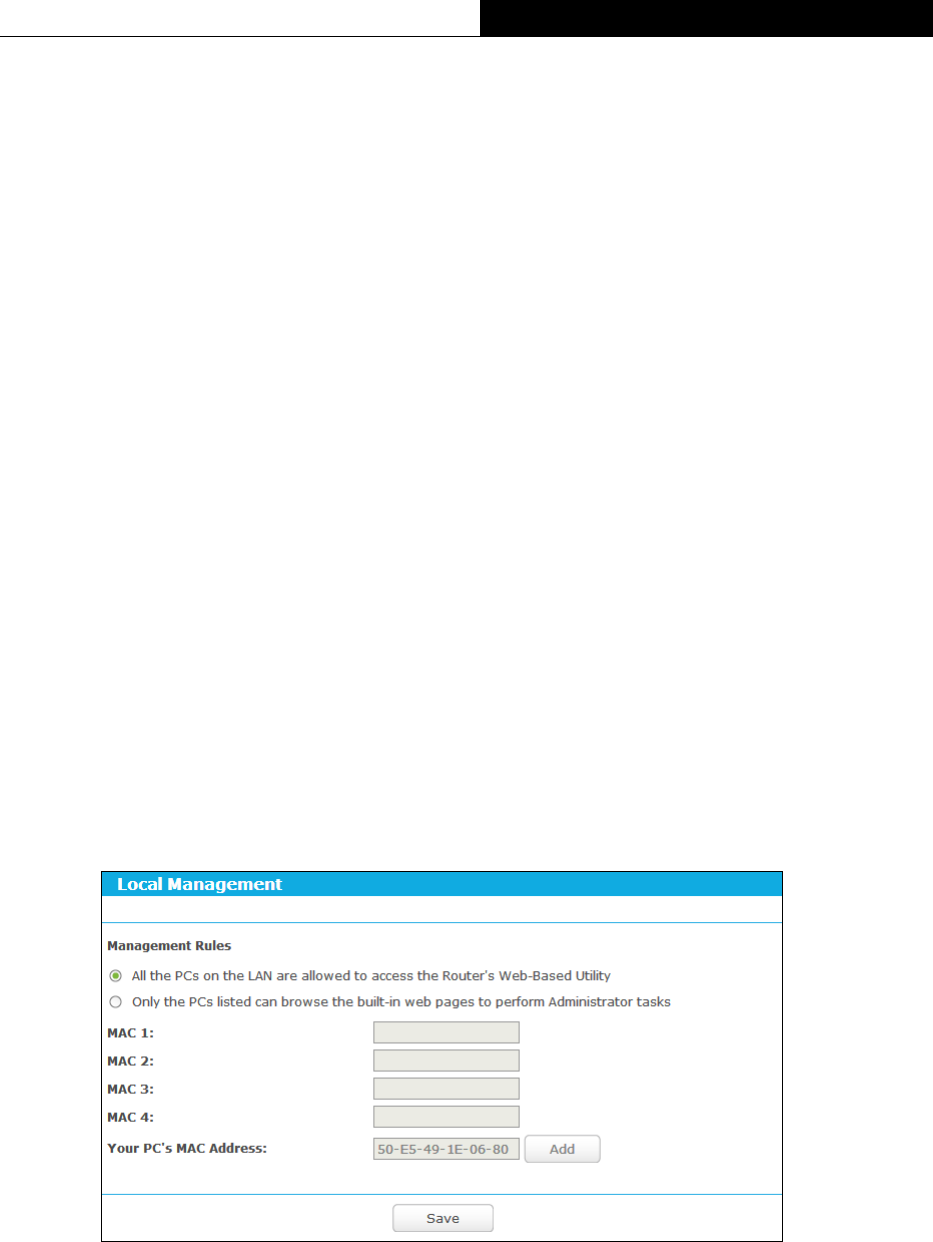
-60-
TL-WR841HP
300Mbps High Power Wireless N Router
UDP-FLOOD Packets Threshold (5~3600) - The default value is 500. Enter a value
between 5 ~ 3600. When the current UPD-FLOOD Packets number is beyond the set value,
the router will startup the blocking function immediately.
Enable TCP-SYN-FLOOD Attack Filtering - Enable or Disable the TCP-SYN-FLOOD
Attack Filtering.
TCP-SYN-FLOOD Packets Threshold (5~3600) - The default value is 50. Enter a value
between 5 ~ 3600. When the current TCP-SYN-FLOOD Packets numbers is beyond the
set value, the router will startup the blocking function immediately.
Ignore Ping Packet From WAN Port - Enable or Disable Ignore Ping Packet From WAN
Port. The default setting is disabled. If enabled, the ping packet from the Internet cannot
access the router.
Forbid Ping Packet From LAN Port - Enable or Disable Forbid Ping Packet From LAN
Port. The default setting is disabled. If enabled, the ping packet from LAN cannot access
the router. This function can be used to defend against some viruses.
Click the Save button to save the settings.
Click the Blocked DoS Host List button to display the DoS host table by blocking.
3.4.8.3. Local Management
Go to “Advanced →Security →Local Management”, and then you can configure the
management rule in the screen as shown below. The management feature allows you to deny
computers in LAN from accessing the router.
Figure 3-43 Local Management
By default, the radio button “All the PCs on the LAN are allowed to access the router's
Web-Based Utility” is checked. If you want to allow PCs with specific MAC Addresses to
access the Setup page of the router's Web-Based Utility locally from inside the network, check
the radio button “Only the PCs listed can browse the built-in web pages to perform
Administrator tasks”, and then enter each MAC Address in a separate field. The format for the
MAC Address is XX-XX-XX-XX-XX-XX (X is any hexadecimal digit). Only the PCs with MAC
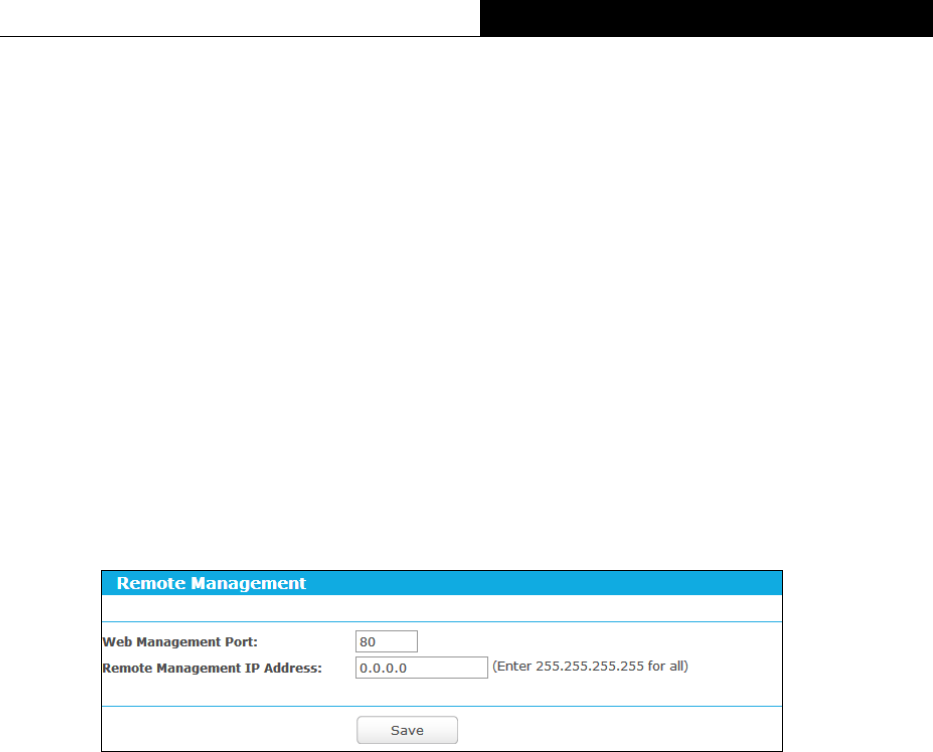
-61-
TL-WR841HP
300Mbps High Power Wireless N Router
address listed can use the password to browse the built-in web pages to perform Administrator
tasks while all the others will be blocked.
After click the Add button, your PC's MAC Address will be placed in the list above.
Click the Save button to save your settings.
Note:
If your PC is blocked but you want to access the router again, use a pin to press and hold the
WPS/Reset button (hole) on the back panel for about 5 seconds to reset the router’s factory
defaults on the router’s Web-Based Utility.
3.4.8.4. Remote Management
Go to “Advanced→Security→Remote Management”, and then you can configure the Remote
Management function in this page. This feature allows you to manage your router from a remote
location via the Internet.
Figure 3-44 Remote Management
Web Management Port - Web browser access normally uses the standard HTTP service
port 80. This router's default remote management web port number is 80. For greater
security, you can change the remote management web port to a custom port by entering
that number in the box provided. Choose a number between 1 and 65534 but do not use
the number of any common service port.
Remote Management IP Address - This is the current address you will use when
accessing your router from the Internet. This function is disabled when the IP address is set
to the default value of 0.0.0.0. To enable this function change 0.0.0.0 to a valid IP address.
If set to 255.255.255.255, then all the hosts can access the router from internet.
Note:
1. To access the router, you should type your router's WAN IP address into your browser's
address (in IE) or Location (in Navigator) box, followed by a colon and the custom port
number. For example, if your router's WAN address is 202.96.12.8, and the port number
used is 8080, please enter http://202.96.12.8:8080 in your browser. Later, you may be asked
for the router's password. After successfully entering the username and password, you will
be able to access the router's web-based utility.
2. Be sure to change the router's default password to a very secure password.
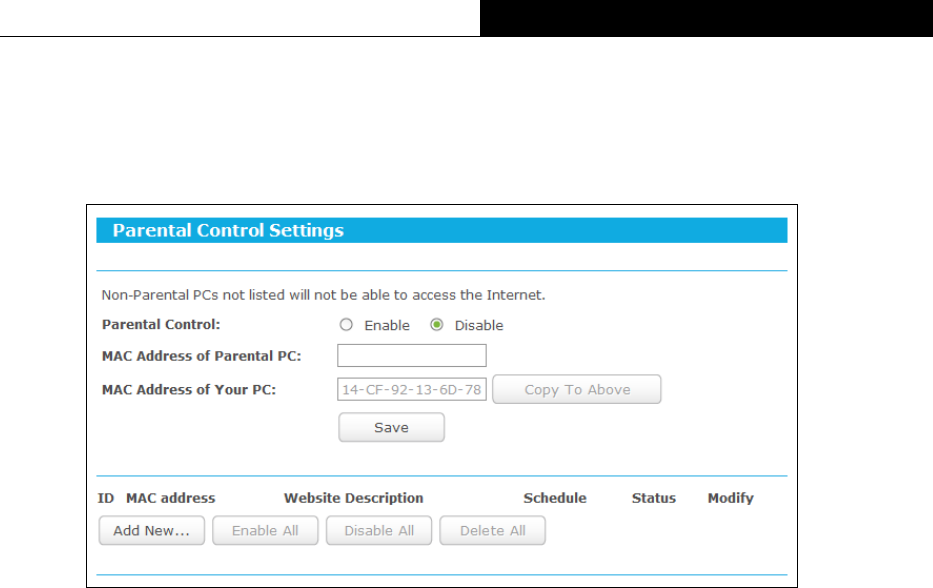
-62-
TL-WR841HP
300Mbps High Power Wireless N Router
3.4.9 Parental Control
Go to “Advanced→Parental Control”, and then you can configure the Parental Control in this
page. The Parental Control function can be used to control the internet activities of the child,
limit the child to access certain websites and restrict the time of surfing.
Figure 3-45 Parental Control Settings
Parental Control - Check Enable if you want this function to take effect; otherwise, check
Disable.
MAC Address of Parental PC - In this field, enter the MAC address of the controlling PC,
or you can make use of the Copy To Above button below.
MAC Address of Your PC - This field displays the MAC address of the PC that is
managing this router. If the MAC Address of your adapter is registered, you can click the
Copy To Above button to fill this address to the MAC Address of Parental PC field above.
Website Description - Description of the allowed website for the PC controlled.
Schedule - The time period allowed for the PC controlled to access the Internet. For
detailed information, please go to “Advanced→Access Control→Schedule”.
Status - Check to enable the corresponding entry.
Modify - Here you can edit or delete an existing entry.
To add a new entry, please follow the steps below.
1. Click the Add New… button and the next screen will pop-up as shown in Figure 3-46.
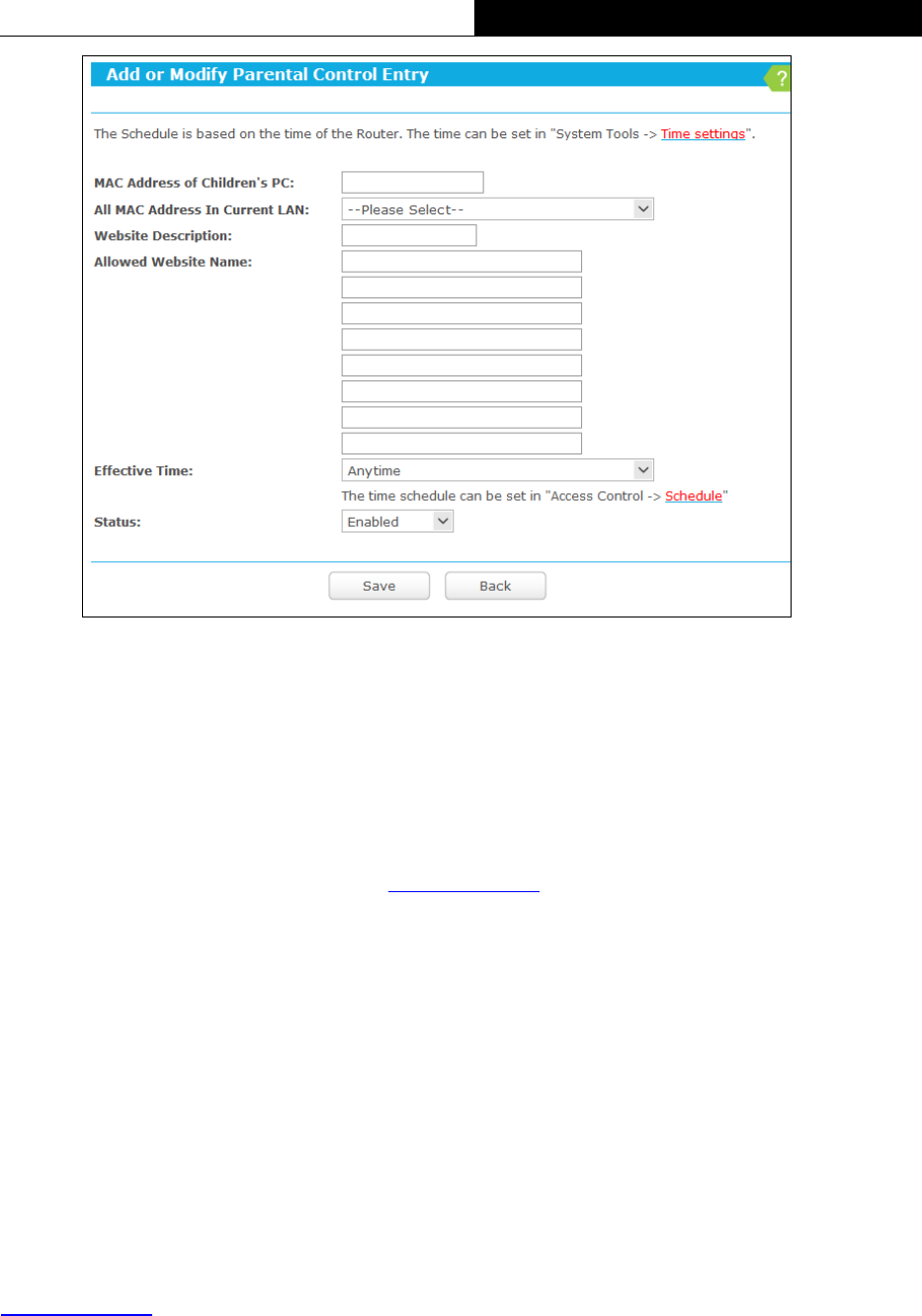
-63-
TL-WR841HP
300Mbps High Power Wireless N Router
Figure 3-46 Add or Modify Parental Controlss Entry
2. Enter the MAC address of the PC (e.g. 00-11-22-33-44-AA) you’d like to control in the MAC
Address of Children’s PC field, or you can choose the MAC address from the All
Address in Current LAN drop-down list.
3. Give a description (e.g. Allow tp-link) for the website allowed to be accessed in the
Website Description field.
4. Enter the allowed website name, e.g. www.tp-link.com.
5. Select the schedule (e.g. Schedule_1) you want from the Effective Time drop-down list. If
there are not suitable schedules for you, please go to “Access Control→Schedule” page
to create the schedule you need.
6. In the Status field, you can select Enabled or Disabled to enable or disable your entry.
7. Click the Save button.
Click the Enable All button to enable all the rules in the list.
Click the Disable All button to disable all the rules in the list.
Click the Delete All button to delete all the entries in the table.
For example: If you desire that the child PC with MAC address 00-11-22-33-44-AA can access
www.tp-link.com on Saturday only, while the parent PC with MAC address 00-11-22-33-44-BB
is without any restriction, you should follow the settings below.
1. Click “Parental Controlss” menu on the left to enter the Parental Controlss Settings page.
Check Enable and enter the MAC address 00-11-22-33-44-BB in the MAC Address of
Parental PC field.
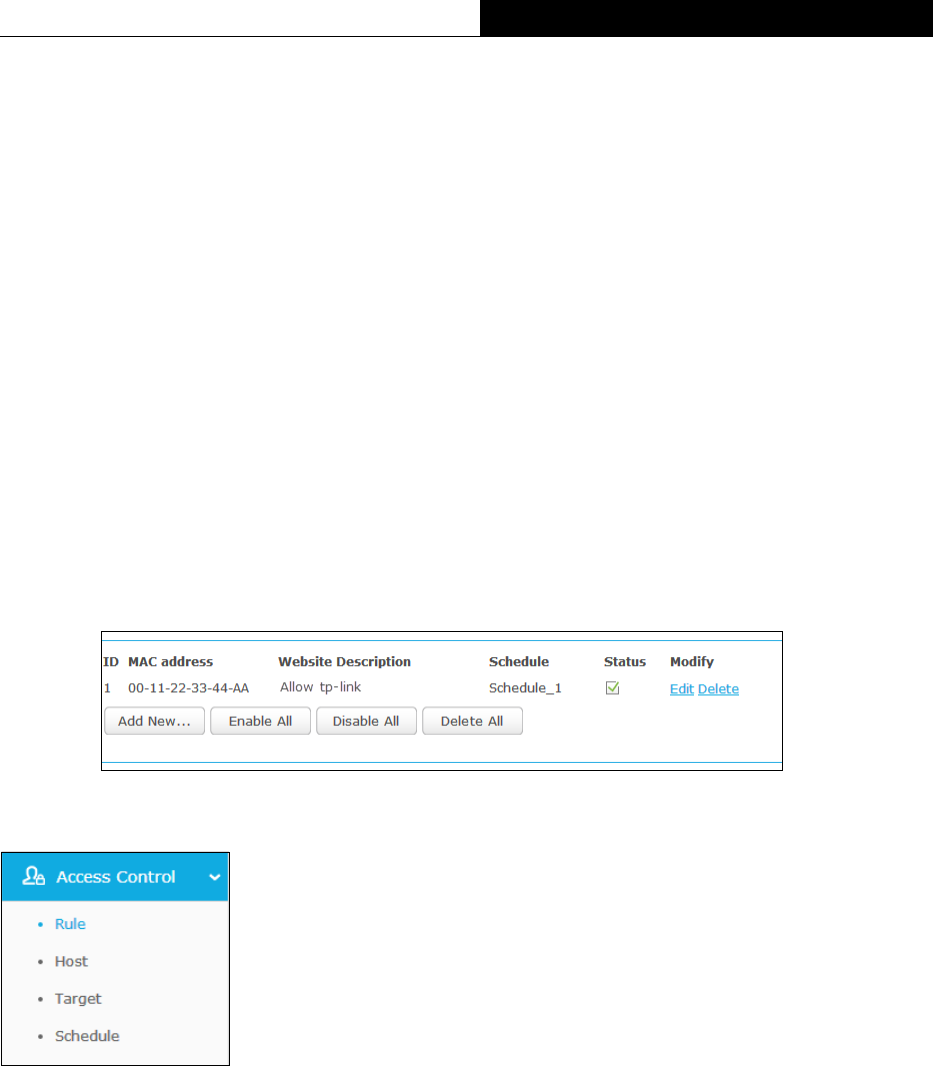
-64-
TL-WR841HP
300Mbps High Power Wireless N Router
2. Click “Advanced→Access Control→Schedule” on the left to enter the Schedule Settings
page. Click Add New... button to create a new schedule with Schedule Description is
Schedule_1, Day is Sat and Time is all day-24 hours.
3. Click “Parental Controls” menu on the left to go back to the Add or Modify Parental
Controls Entry page:
1. Click Add New... button.
2. Enter 00-11-22-33-44-AA in the MAC Address of Child PC field.
3. Enter “Allow tp-link” in the Website Description field.
4. Enter “www.tp-link.com” in the Allowed Website Name field.
5. Select “Schedule_1” you create just now from the Effective Time drop-down list.
6. In Status field, select Enable.
4. Click Save to complete the settings.
Then you will go back to the Parental Control page and see the following list.
3.4.10 Access Control
There are four submenus under the Access Control menu: Rule, Host, Target and Schedule.
Click any of them, and you will be able to configure the corresponding function.
3.4.10.1. Rule
Go to “Advanced→Access Control→Rule”, and then you can view and set Access Control
rules in this page.
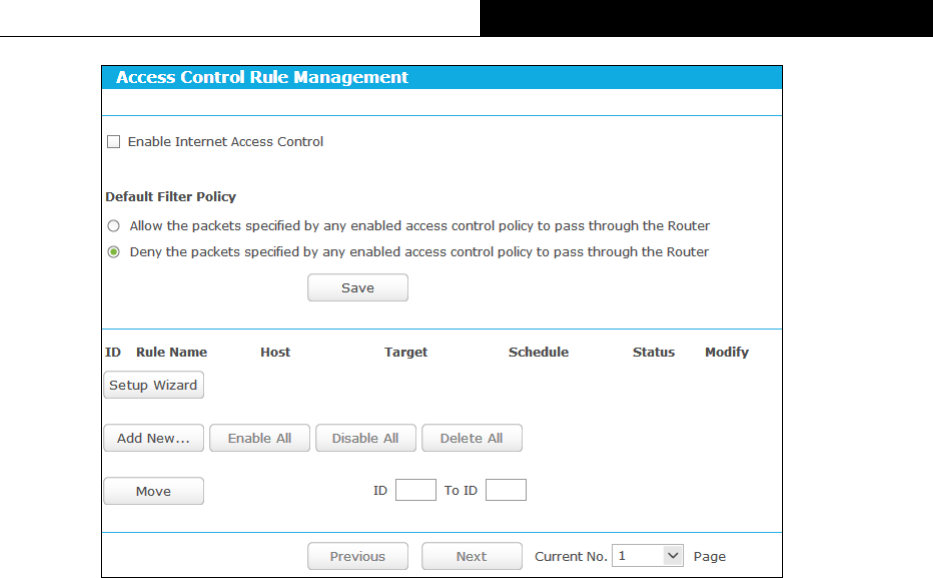
-65-
TL-WR841HP
300Mbps High Power Wireless N Router
Figure 3-47 Access Control Rule Management
Enable Internet Access Control - Select the checkbox to enable the Internet Access
Control function, so the Default Filter Policy can take effect.
Rule Name - Displays the name of the rule and this name is unique.
Host - Displays the host selected in the corresponding rule.
Target - Displays the target selected in the corresponding rule.
Schedule - Displays the schedule selected in the corresponding rule.
Status - Displays the status of the rule, enabled or not. Select the corresponding checkbox
to enable the entry.
Modify - Here you can edit or delete an existing rule.
Setup Wizard - Click the Setup Wizard button to create a new rule entry.
Add New... - Click the Add New... button to add a new rule entry.
Enable All - Click the Enable All button to enable all the rules in the list.
Disable All - Click the Disable All button to disable all the rules in the list.
Delete All - Click the Delete All button to delete all the entries in the table.
Move - You can change the entry’s order as desired. Enter in the first box the ID number of
the entry you want to move and in the second box another ID number, and then click the
Move button to change the entries’ order.
Click the Next button to go to the next page.
Click the Previous button to return to the previous page.
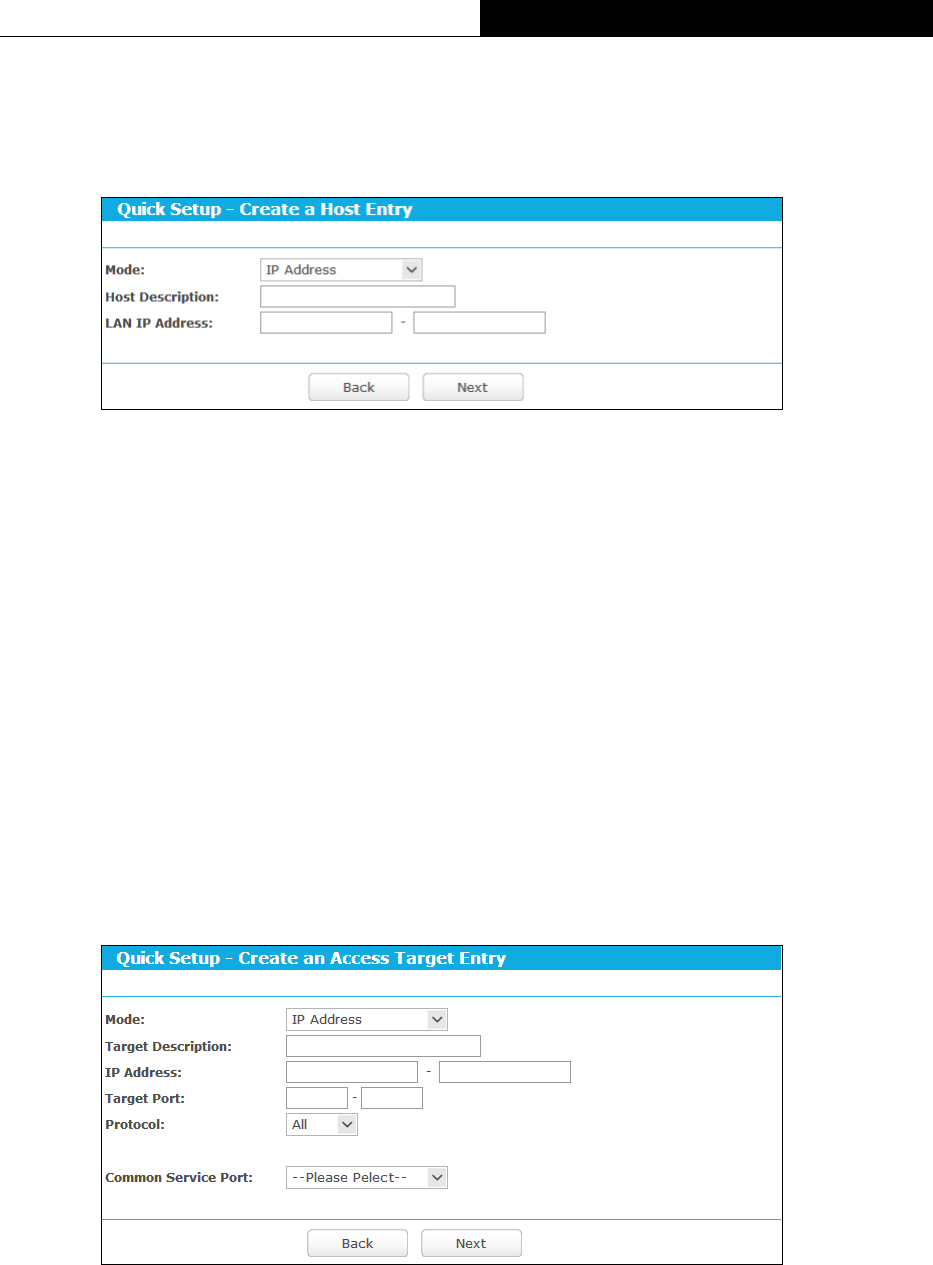
-66-
TL-WR841HP
300Mbps High Power Wireless N Router
There are two methods to add a new rule.
Method One:
1. Click Setup Wizard button and the next screen will appear as shown in Figure 3-48.
Figure 3-48 Quick Setup – Create a Host Entry
Host Description - In this field, create a unique description for the host (e.g. Host_1).
Mode - Here are two options, IP Address and MAC Address. You can select either of
them from the drop-down list.
If the IP Address is selected, you can see the following item:
LAN IP Address - Enter the IP address or address range of the host in dotted-decimal
format (e.g. 192.168.0.23).
If the MAC Address is selected, you can see the following item:
MAC Address - Enter the MAC address of the host in XX-XX-XX-XX-XX-XX format
(e.g. 00-11-22-33-44-AA).
2. Click Next when finishing creating the host entry. The next screen will appear as shown in
Figure 3-49.
Figure 3-49 Quick Setup – Create an Access Target Entry
Target Description - In this field, create a description for the target. Note that this
description should be unique (e.g. Target_1).
Mode - Here are two options, IP Address and Domain Name. You can choose either of
them from the drop-down list.
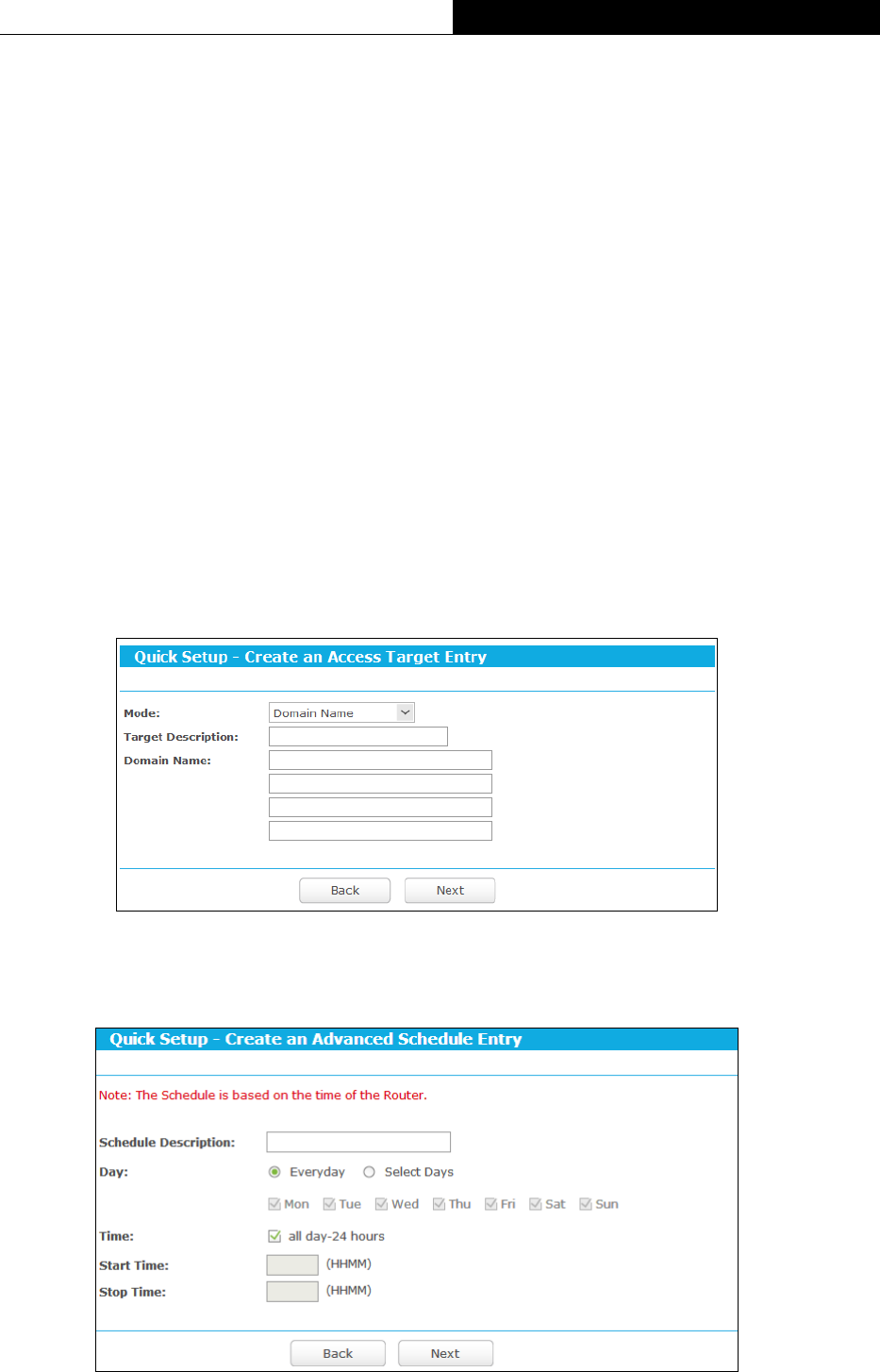
-67-
TL-WR841HP
300Mbps High Power Wireless N Router
If the IP Address is selected, you will see the following items:
IP Address - Enter the IP address (or address range) of the target (targets) in
dotted-decimal format (e.g. 192.168.0.33).
Target Port - Specify the port or port range for the target. For some common service
ports, you can make use of the Common Service Port item below.
Protocol - Here are four options, All, TCP, UDP, and ICMP. Select one of them from
the drop-down list for the target.
Common Service Port - Lists some common service ports. Select one from the
drop-down list and the corresponding port number will be filled in the Target Port field
automatically. For example, if you select "FTP", "21" will be filled in the Target Port
automatically.
If the Domain Name is selected, you will see the following items:
Domain Name - Here you can enter 4 domain names, either the full name or the
keywords (for example, tp-link). Any domain name with keywords in it
(www.tp-link.com, www.tp-link.cn) will be blocked or allowed.
Figure 3-50 Quick Setup - Create an Access Target Entry
3. Click Next when finishing creating the access target entry.
Figure 3-51 Quick Setup – Create an Advanced Schedule Entry
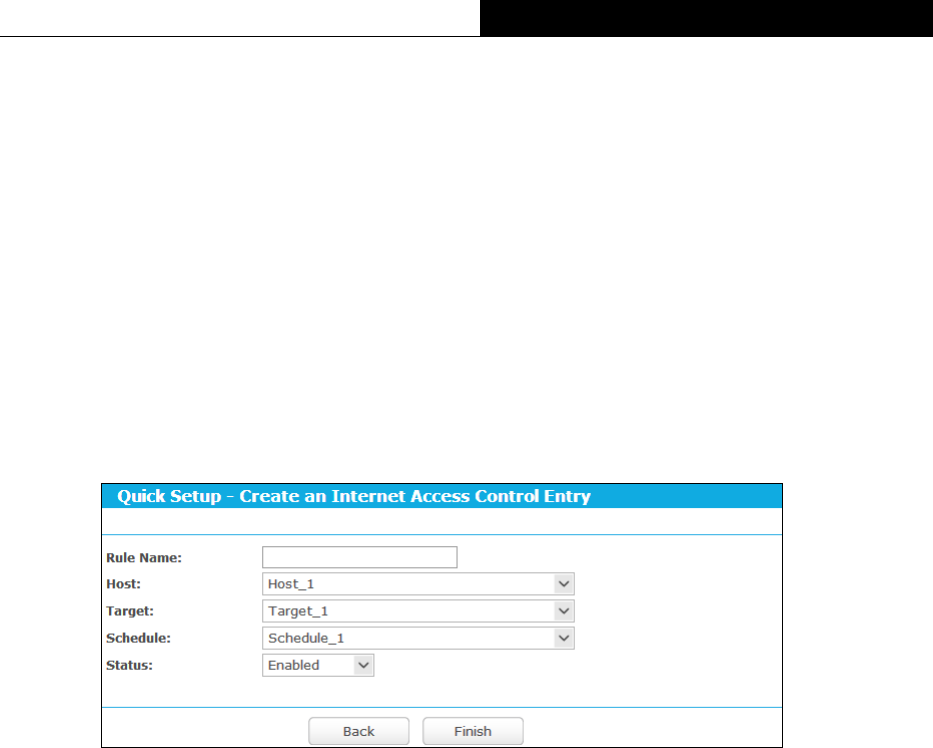
-68-
TL-WR841HP
300Mbps High Power Wireless N Router
Schedule Description - In this field, create a description for the schedule. Note that
this description should be unique (e.g. Schedule_1).
Day - Choose Select Days and select the certain day (days), or choose Everyday.
Time - Select "all day-24 hours" checkbox, or deselect the checkbox and specify the
Start Time and Stop Time manually.
Start Time - Enter the start time in HHMM format (HHMM are 4 numbers). For
example 0800 is 8:00.
Stop Time - Enter the stop time in HHMM format (HHMM are 4 numbers). For
example 2000 is 20:00.
4. Click Next when finishing creating the advanced schedule entry.
Figure 3-52 Quick Setup – Create an Internet Access Control Entry
Rule Name - In this field, create a name for the rule. Note that this name should be
unique (e.g. Rule_1).
Host - In this field, select a host from the drop-down list for the rule. The default value
is the Host Description you set just now.
Target - In this filed, select a target from the drop-down list for the rule.
Schedule - In this field, select a schedule from the drop-down list for the rule.
Status - In this field, there are two options, Enabled or Disabled. Select Enabled so
that the rule will take effect. Select Disabled so that the rule won't take effect.
5. Click Finish to complete adding a new rule.
Method Two:
1. Click the Add New… button and the next screen will pop up as shown in Figure 3-48.
2. Give a name (e.g. Rule_1) for the rule in the Rule Name field.
3. Select a host from the Host drop-down list or choose “Click Here To Add New Host List”.
4. Select a target from the Target drop-sown list or choose “Click Here To Add New Target
List”.
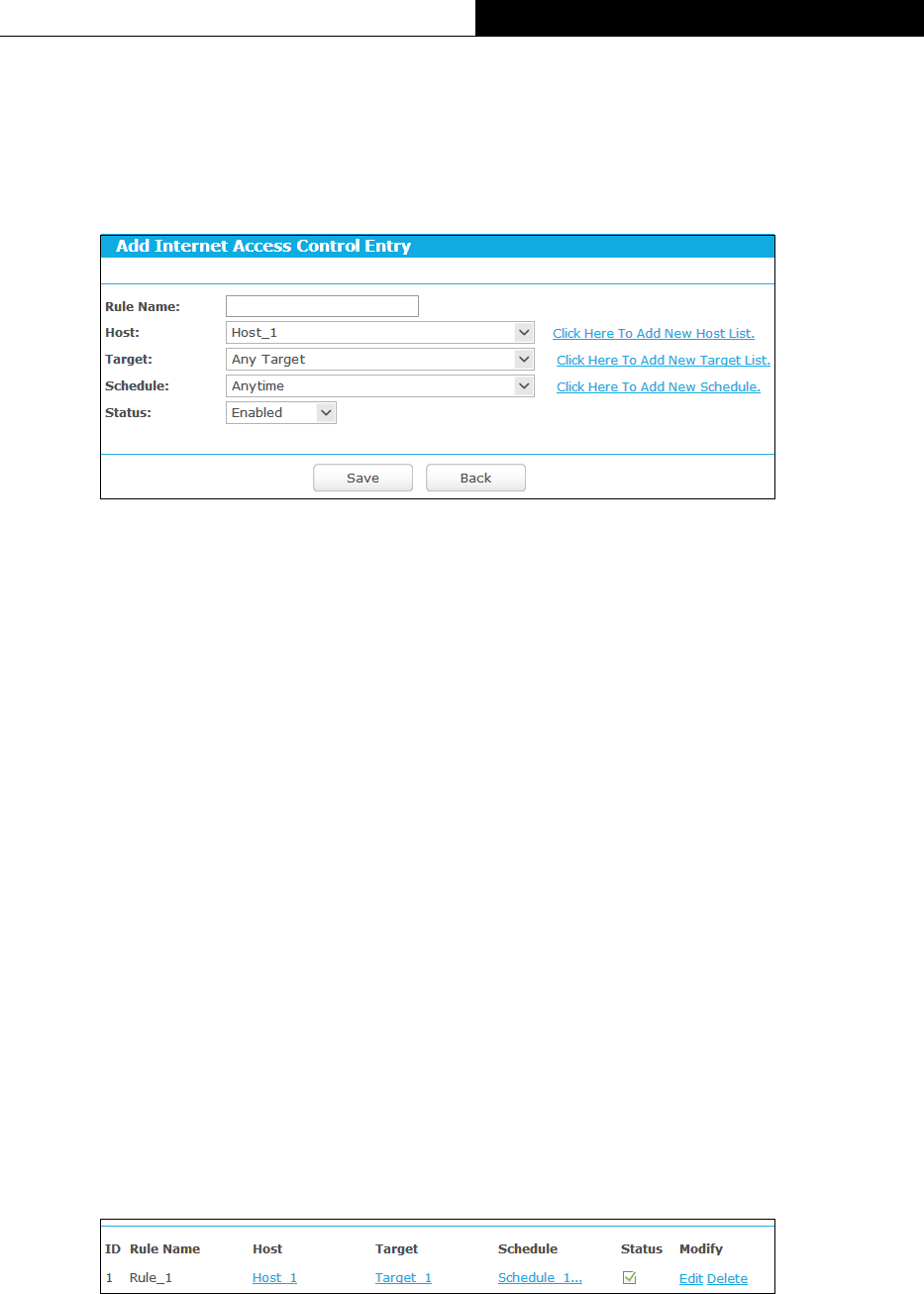
-69-
TL-WR841HP
300Mbps High Power Wireless N Router
5. Select a schedule from the Schedule drop-down list or choose “Click Here To Add New
Schedule”.
6. In the Status field, select Enabled or Disabled to enable or disable your entry.
7. Click the Save button.
Figure 3-53 Add Internet Access Control Entry
For example: If you desire to allow the host with MAC address 00-11-22-33-44-AA to access
www.tp-link.com only from 18:00 to 20:00 on Saturday and Sunday, and forbid other hosts in
the LAN to access the Internet, you should follow the settings below:
1. Click the menu Access Control on the left. Select Enable Internet Access Control and
choose "Allow the packets specified by any enabled access control policy to pass
through the router".
2. Click Setup Wizard button.
3. Add a new host with the Host Description is Host_1 and MAC Address is
00-11-22-33-44-AA, and click Next.
4. Add a new target with the Target Description is Target_1 and Domain Name is
www.tp-link.com, and click Next.
5. Add a new schedule with the Schedule Description is Schedule_1, Day is Sat and Sun,
Start Time is 1800 and Stop Time is 2000, and click Next.
6. Add a new rule with the Rule Description is Rule_1, Host is Host_1, Target is Target_1,
Schedule is Schedule_1, Status is Enabled, and click Finish.
Then you will go back to the Access Control Rule Management page and see the following list.
3.4.10.2. Host
Go to “Advanced→Access Control→Host”, and then you can view and set a Host list in the
screen as shown in Figure 3-54. The host list is necessary for the Access Control Rule.
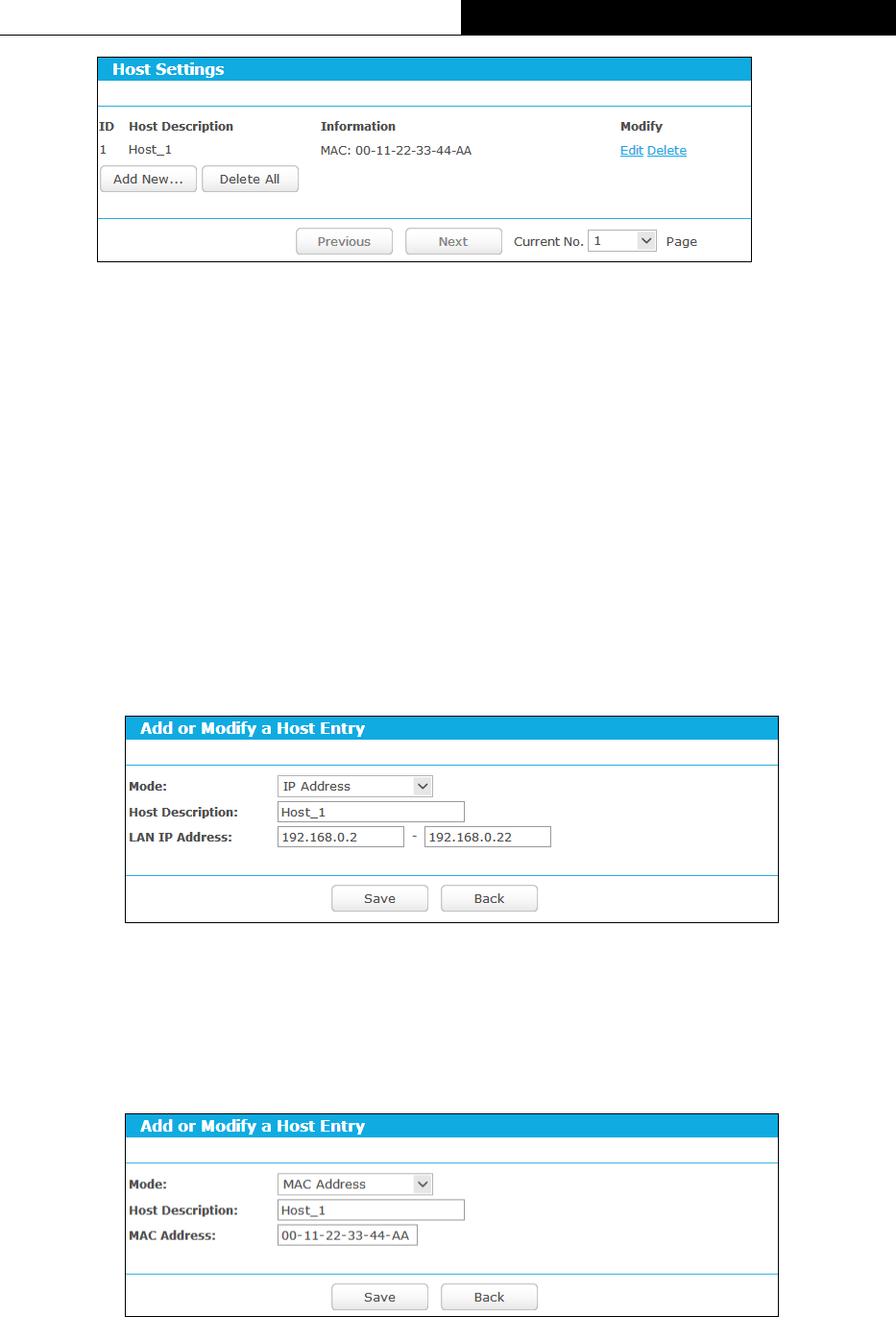
-70-
TL-WR841HP
300Mbps High Power Wireless N Router
Figure 3-54 Host Settings
Host Description - Displays the description of the host and this description is unique.
Information - Displays the information about the host. It can be IP or MAC.
Modify - To modify or delete an existing entry.
To add a new entry, please follow the steps below.
1. Click the Add New… button.
2. In the Mode field, select IP Address or MAC Address.
If you select IP Address, the screen is shown as Figure 3-55.
1) In Host Description field, create a unique description for the host, e.g. Host_1.
2) In LAN IP Address field, enter the IP address.
Figure 3-55 Add or Modify a Host Entry
If you select MAC Address, the screen is shown as Figure 3-56.
1) In Host Description field, create a unique description for the host, e.g. Host_1.
2) In MAC Address field, enter the MAC address.
Figure 3-56 Add or Modify a Host Entry
3. Click the Save button to complete the settings.
Click the Delete All button to delete all the entries in the table.
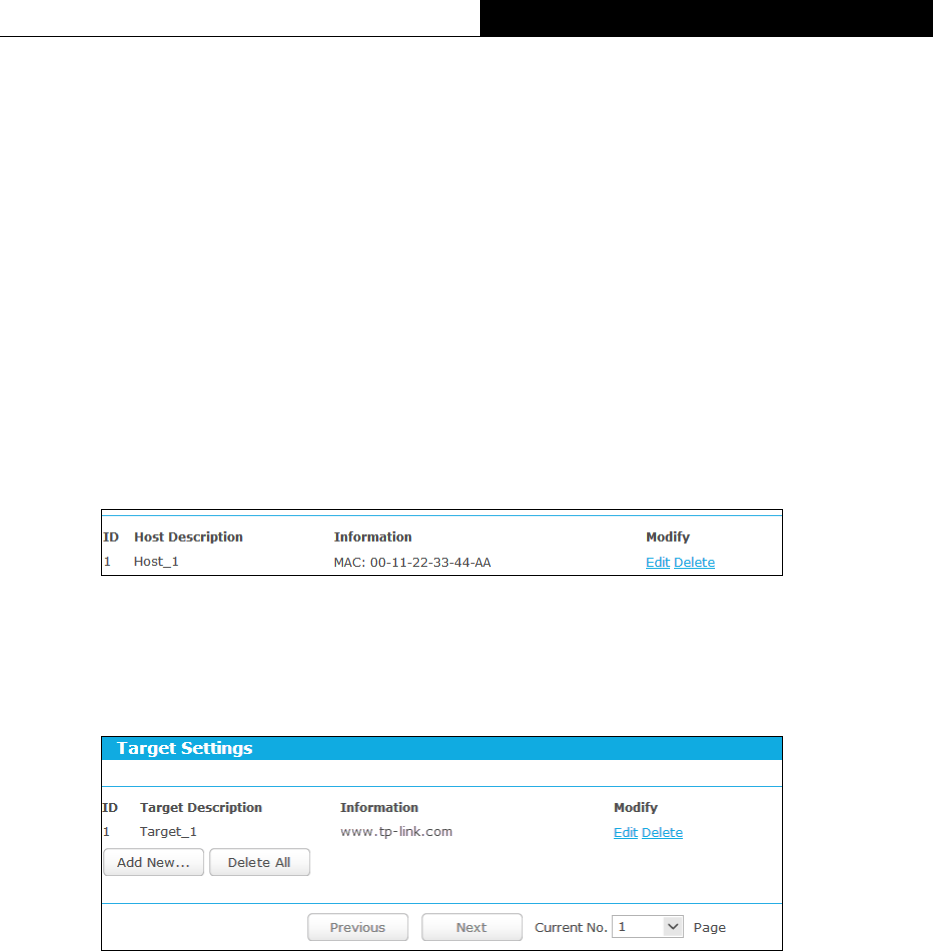
-71-
TL-WR841HP
300Mbps High Power Wireless N Router
Click the Next button to go to the next page, or click the Previous button to return to the
previous page.
For example: If you desire to restrict the internet activities of host with MAC address
00-11-22-33-44-AA, you should first follow the settings below:
1. Click Add New... button in Figure 3-54 to enter the Add or Modify a Host Entry page.
2. In Mode field, select MAC Address from the drop-down list.
3. In Host Description field, create a unique description for the host (e.g. Host_1).
4. In MAC Address field, enter 00-11-22-33-44-AA.
5. Click Save to complete the settings.
Then you will go back to the Host Settings page and see the following list.
3.4.10.3. Target
Go to “Advanced→Access Control→Target”, and then you can view and set a Target list in
the screen as shown in Figure 3-57. The target list is necessary for the Access Control Rule.
Figure 3-57 Target Settings
Target Description - Displays the description about the target and this description is
unique.
Information - The target can be IP address, port, or domain name.
Modify - To modify or delete an existing entry.
To add a new entry, please follow the steps below.
1. Click the Add New… button.
2. In Mode field, select IP Address or Domain Name.
3. If you select IP Address, the screen is shown as Figure 3-58.
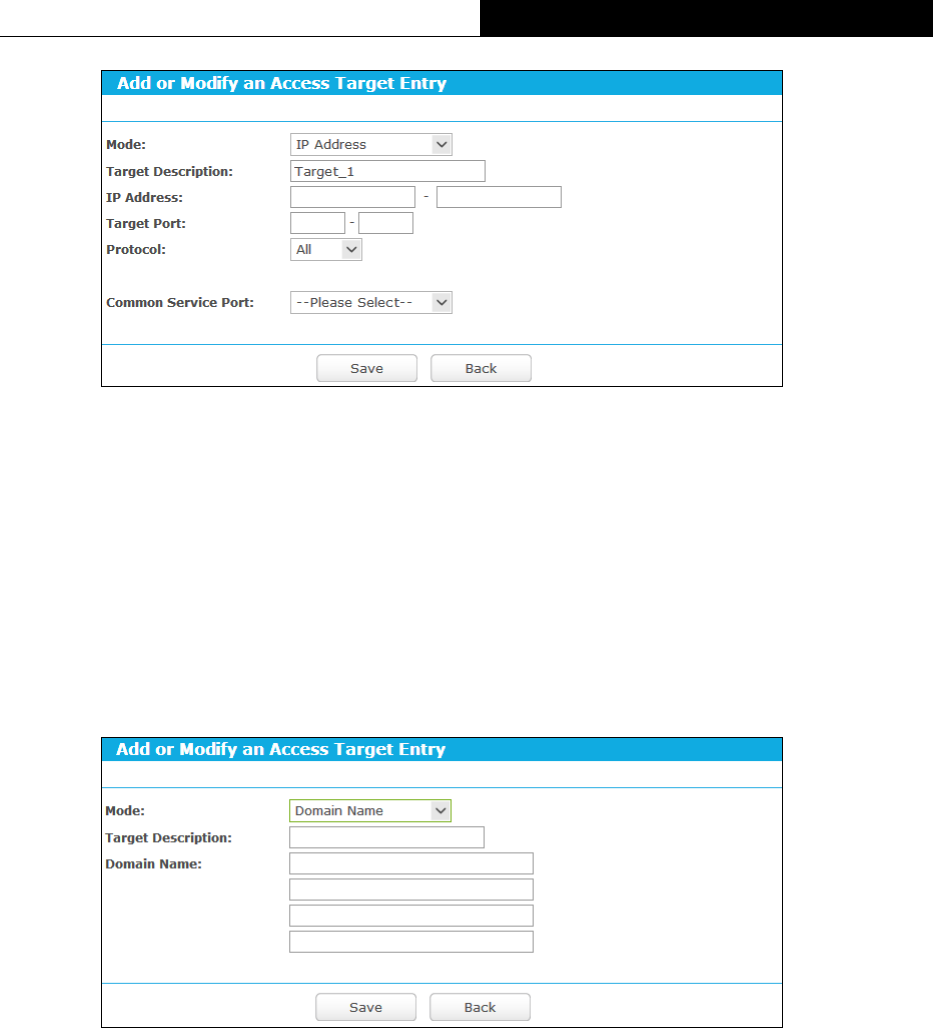
-72-
TL-WR841HP
300Mbps High Power Wireless N Router
Figure 3-58 Add or Modify an Access Target Entry
1) In Target Description field, create a unique description for the target, e.g. Target_1.
2) In IP Address field, enter the IP address of the target.
3) Select a common service from Common Service Port drop-down list, so that the
Target Port will be automatically filled. If the Common Service Port drop-down list
doesn’t have the service you want, specify the Target Port manually.
4) In Protocol field, select TCP, UDP, ICMP or All from the drop-down list.
4. If you select Domain Name, the screen is shown as Figure 3-59.
Figure 3-59 Add or Modify an Access Target Entry
1) In Target Description field, create a unique description for the target, e.g. Target_1.
2) In Domain Name field, enter the domain name, either the full name or the keywords
(e.g. tp-link) in the blank. Any domain name with keywords in it (www.tp-link.com,
www.tp-link.cn) will be blocked or allowed. You can enter 4 domain names.
5. Click the Save button.
Click the Delete All button to delete all the entries in the table.
Click the Next button to go to the next page, or click the Previous button to return to the
previous page.
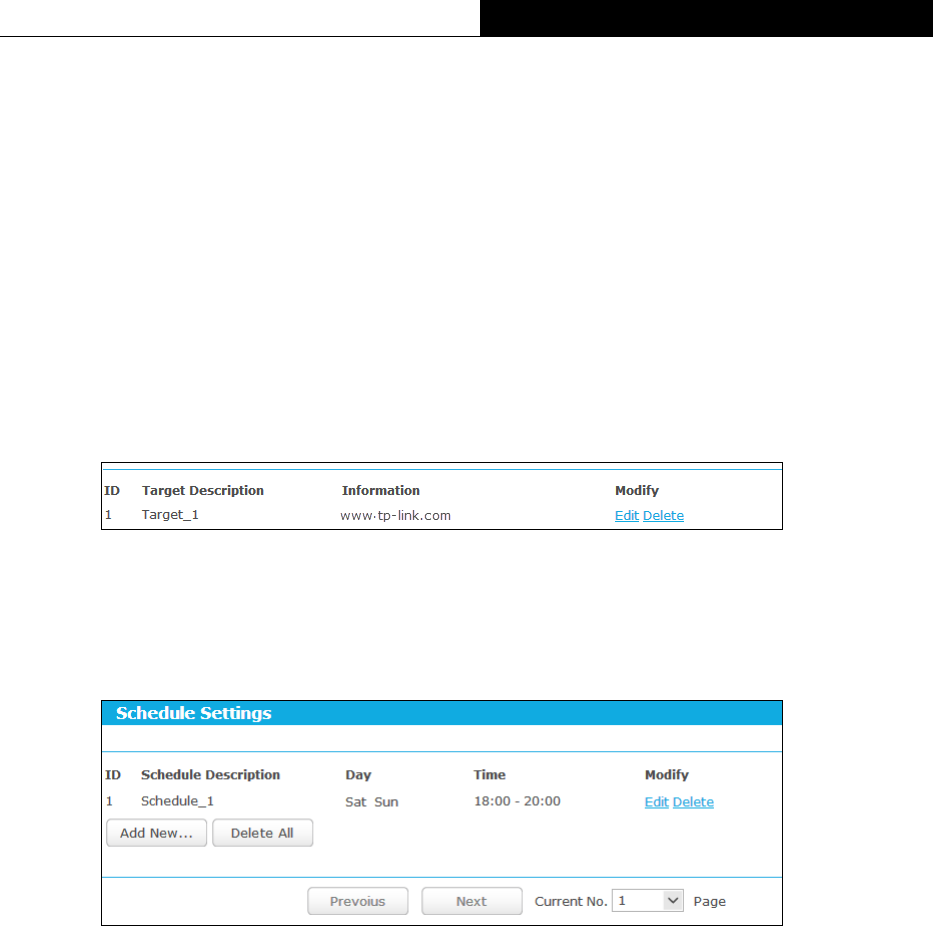
-73-
TL-WR841HP
300Mbps High Power Wireless N Router
For example: If you desire to restrict the internet activities of host with MAC address
00-11-22-33-44-AA in the LAN to access www.tp-link.com only, you should first follow the
settings below:
1. Click Add New… button in Figure 3-57.
2. In Mode field, select Domain Name from the drop-down list.
3. In Target Description field, create a unique description for the target, e.g. Target_1.
4. In Domain Name field, enter www.tp-link.com.
5. Click Save to complete the settings.
Then you will go back to the Target Settings page and see the following list.
3.4.10.4. Schedule
Go to “Advanced→Access Control→Schedule”, and then you can view and set a schedule in
this page. The schedule is necessary for the Access Control Rule.
Figure 3-60 Schedule Settings
Schedule Description - Displays the description of the schedule and this description is
unique.
Day - Displays the day(s) in a week.
Time - Displays the time period in a day.
Modify - Here you can edit or delete an existing schedule.
To add a new schedule, follow the steps below:
1. Click Add New... button shown in Figure 3-60 and the next screen will pop-up as shown in
Figure 3-61.
2. In Schedule Description field, create a unique description for the schedule, e.g.
Schedule_1.
3. In Day field, select the day or days you need.
4. In Time field, you can select all day-24 hours or you may enter the Start Time and Stop
Time in the corresponding field.
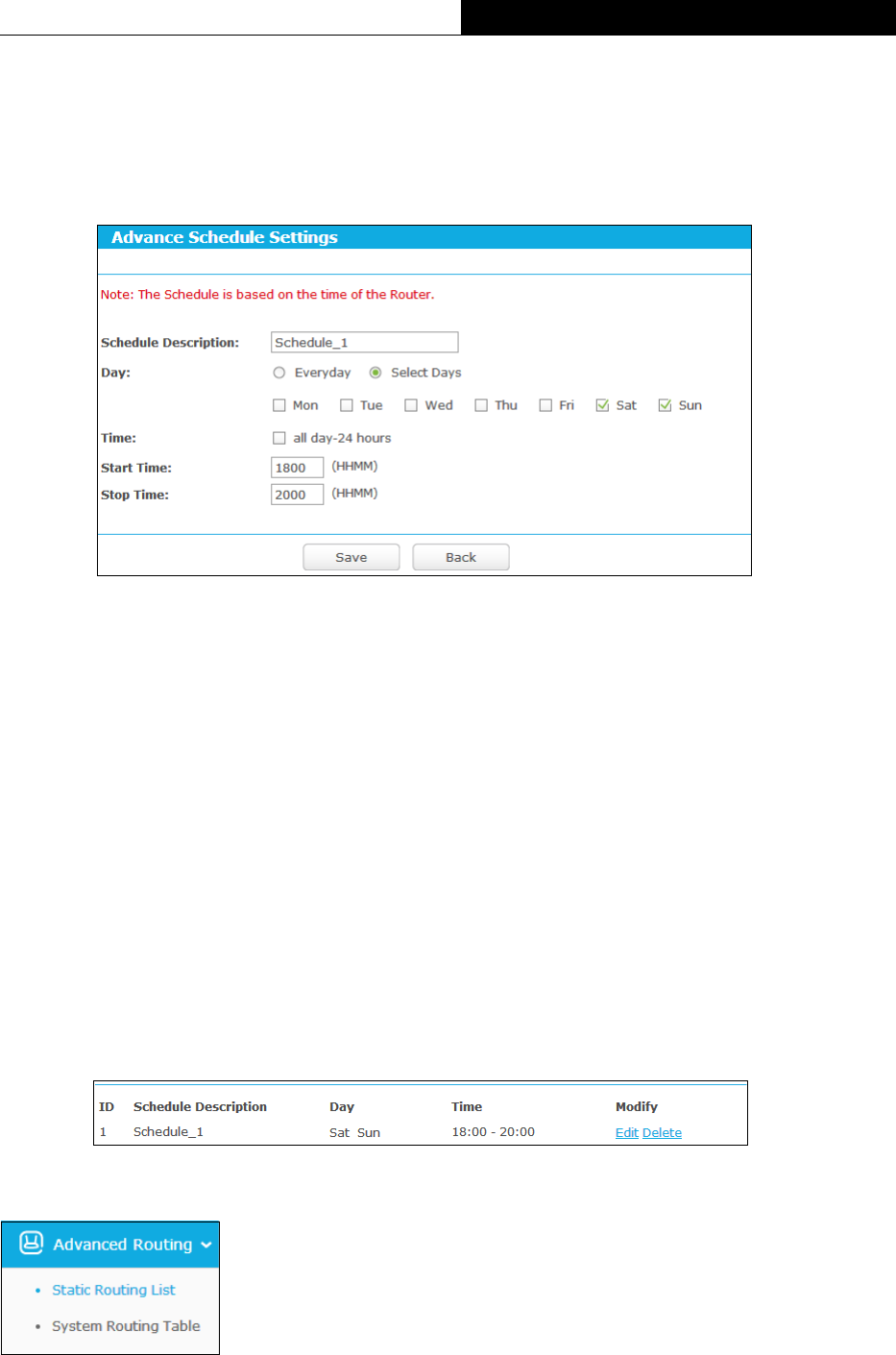
-74-
TL-WR841HP
300Mbps High Power Wireless N Router
5. Click Save to complete the settings.
Click the Delete All button to delete all the entries in the table.
Click the Next button to go to the next page, or click the Previous button to return to the
previous page.
Figure 3-61 Advanced Schedule Settings
For example: If you desire to restrict the internet activities of host with MAC address
00-11-22-33-44-AA to access www.tp-link.com only from 18:00 to 20:00 on Saturday and
Sunday, you should first follow the settings below:
1. Click Add New... button shown in Figure 3-60 to enter the Advanced Schedule Settings
page.
2. In Schedule Description field, create a unique description for the schedule, e.g.
Schedule_1.
3. In Day field, check the Select Days radio button and then select Sat and Sun.
4. In Time field, enter 1800 in Start Time field and 2000 in Stop Time field.
5. Click Save to complete the settings.
Then you will go back to the Schedule Settings page and see the following list.
3.4.11 Advanced Routing
There are two submenus under the Advanced Routing menu: Static Routing List and System
Routing Table. Click any of them, and you will be able to configure the corresponding function.
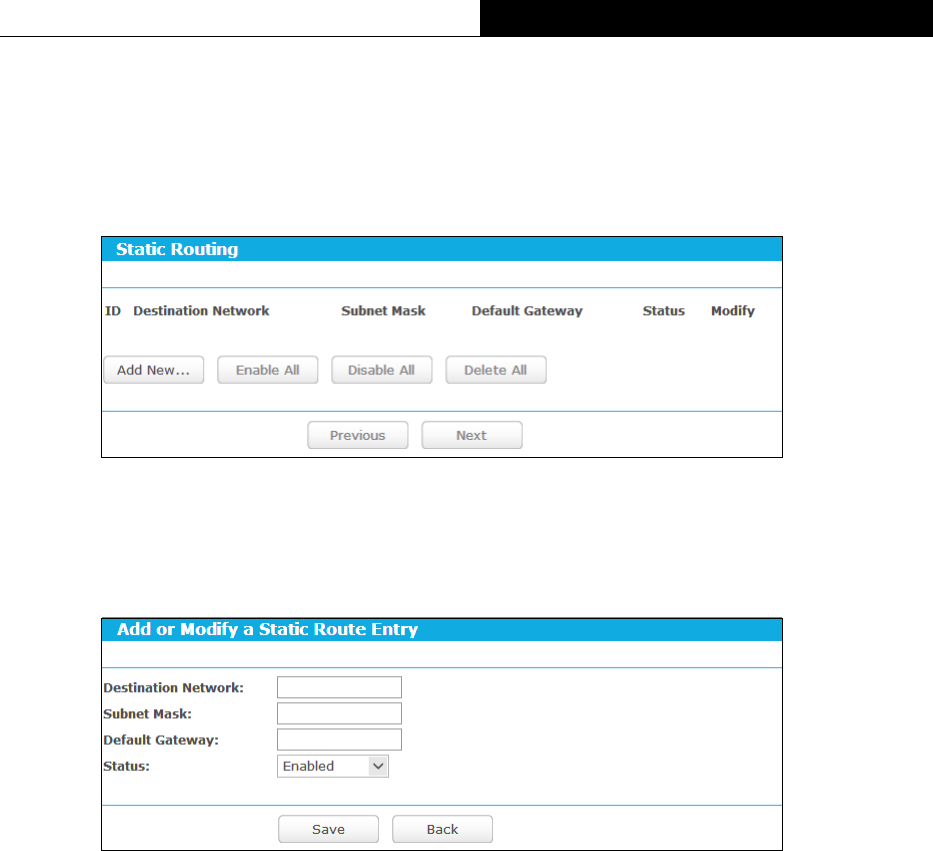
-75-
TL-WR841HP
300Mbps High Power Wireless N Router
3.4.11.1. Static Routing List
Go to “Advanced→Advanced Routing→Static Routing List”, and then you can configure the
static route in this page. A static route is a pre-determined path that network information must
travel to reach a specific host or network.
Figure 3-62 Static Routing
To add static routing entries:
1. Click Add New…, you will see the following screen.
Figure 3-63 Add or Modify a Static Route Entry
2. Enter the following data:
Destination Network - The Destination Network is the address of the network or host
that you want to assign to a static route.
Subnet Mask - The Subnet Mask determines which portion of an IP Address is the
network portion, and which portion is the host portion.
Default Gateway - This is the IP Address of the gateway device that allows for contact
between the router and the network or host.
3. Select Enabled or Disabled for this entry on the Status drop-down list.
4. Click the Save button to make the entry take effect.
Other configurations for the entries:
Click the Delete button to delete the entry.
Click the Enable All button to enable all the entries.
Click the Disable All button to disable all the entries.
Click the Delete All button to delete all the entries.
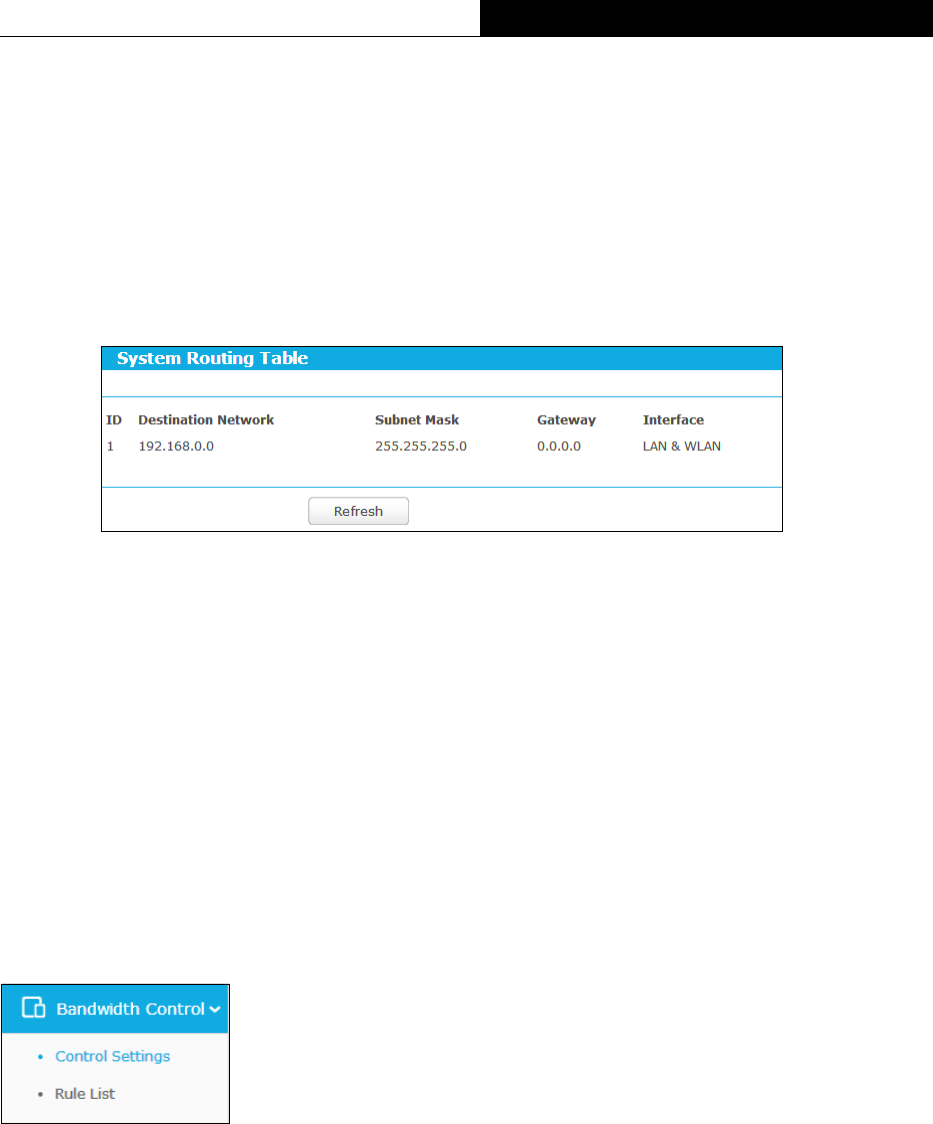
-76-
TL-WR841HP
300Mbps High Power Wireless N Router
Click the Previous button to view the information in the previous screen, click the Next button
to view the information in the next screen.
3.4.11.2. System Routing Table
Go to “Advanced→Advanced Routing→System Routing Table”, and then you can view the
System Routing Table in this page. System routing table views all of the valid route entries in
use. The Destination IP address, Subnet Mask, Gateway, and Interface will be displayed for
each entry.
Figure 3-64 System Routing Table
Destination Network - The Destination Network is the address of the network or host to
which the static route is assigned.
Subnet Mask - The Subnet Mask determines which portion of an IP address is the network
portion, and which portion is the host portion.
Gateway - This is the IP address of the gateway device that allows for contact between the
router and the network or host.
Interface - This interface tells you either the Destination IP Address is on the LAN &
WLAN (internal wired and wireless networks), or on the WAN (Internet).
3.4.12 Bandwidth Control
There are two submenus under the Bandwidth Control menu: Control Settings and Rules List.
Click any of them, and you will be able to configure the corresponding function. The detailed
explanations for each submenu are provided below.
Note:
Bandwidth Control will become invalid if NAT Boost is enabled. If you want to enable Bandwidth
Control, please go to “Advanced→NAT Boost” to disable NAT Boost first.
3.4.12.1. Control Settings
Go to “Advanced→Bandwidth Control→Control Settings”, and then you can configure the
Egress Bandwidth and Ingress Bandwidth in the next screen. For optimal control of the
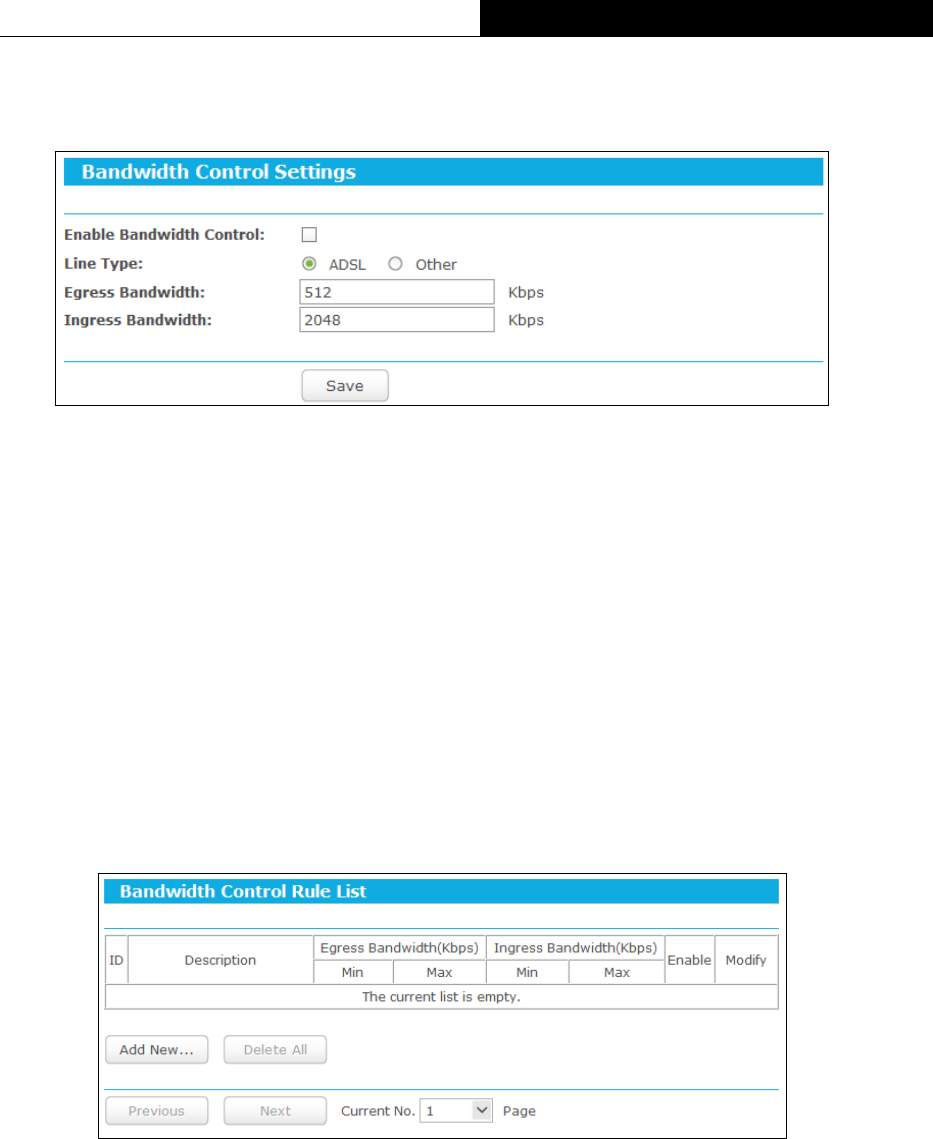
-77-
TL-WR841HP
300Mbps High Power Wireless N Router
bandwidth, please select the right Line Type and ask your ISP for the total bandwidth of the
egress and ingress.
Figure 3-65 Bandwidth Control Settings
Enable Bandwidth Control - Select this checkbox so that the Bandwidth Control settings
can take effect.
Line Type - Select the right type for you network connection. If you don’t know how to
choose, please ask your ISP for the information.
Egress Bandwidth - The upload speed through the Internet port.
Ingress Bandwidth - The download speed through the Internet port.
3.4.12.2. Rule List
Go to “Advanced→Bandwidth Control→Rule List”, and then you can view and configure the
Bandwidth Control rules in the screen below.
Figure 3-66 Bandwidth Control Rules List
Description - This is the information about the rules such as address range.
Egress bandwidth - This field displays the max and mix upload bandwidth through the
Internet port, the default is 0.
Ingress bandwidth - This field displays the max and mix download bandwidth through the
Internet port, the default is 0.
Enable - This displays the status of the rule.
Modify - Click Modify to edit the rule. Click Delete to delete the rule.
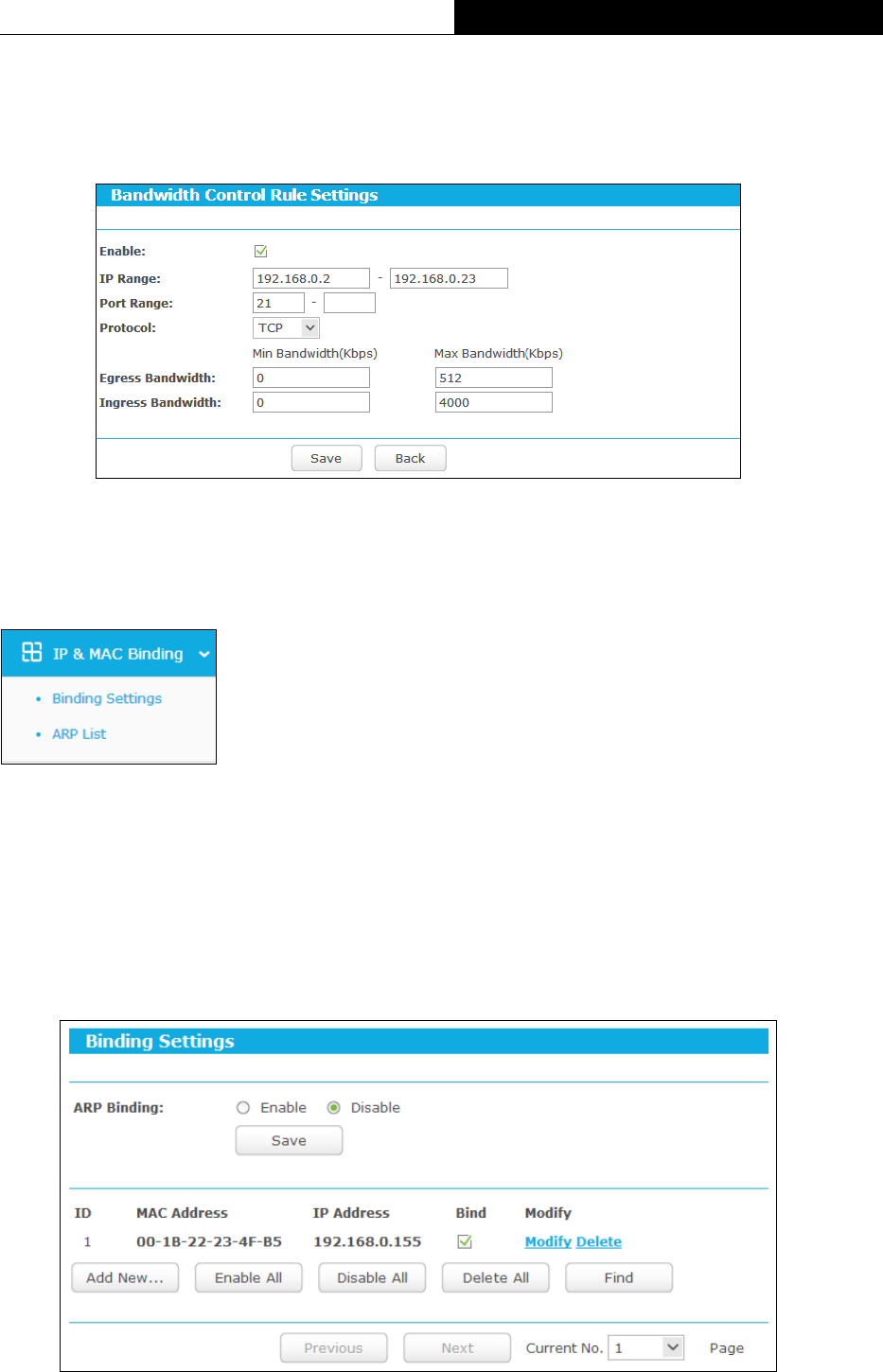
-78-
TL-WR841HP
300Mbps High Power Wireless N Router
To add/modify a Bandwidth Control rule, follow the steps below.
1. Click Add New… shown in Figure 3-66, you will see a new screen shown in Figure 3-67.
2. Enter the information like the screen shown below.
Figure 3-67 Bandwidth Control Rule Settings
3. Click the Save button.
3.4.13 IP & MAC Binding
There are two submenus under the IP &MAC Binding menu: Binding Settings and ARP List.
Click any of them, and you will be able to scan or configure the corresponding function. The
detailed explanations for each submenu are provided below.
3.4.13.1. Binding Settings
Go to “Advanced→Bandwidth Control→Binding Setting”, you can configure the IP & MAC
binding rules in this page.
Figure 3-68 Binding Setting
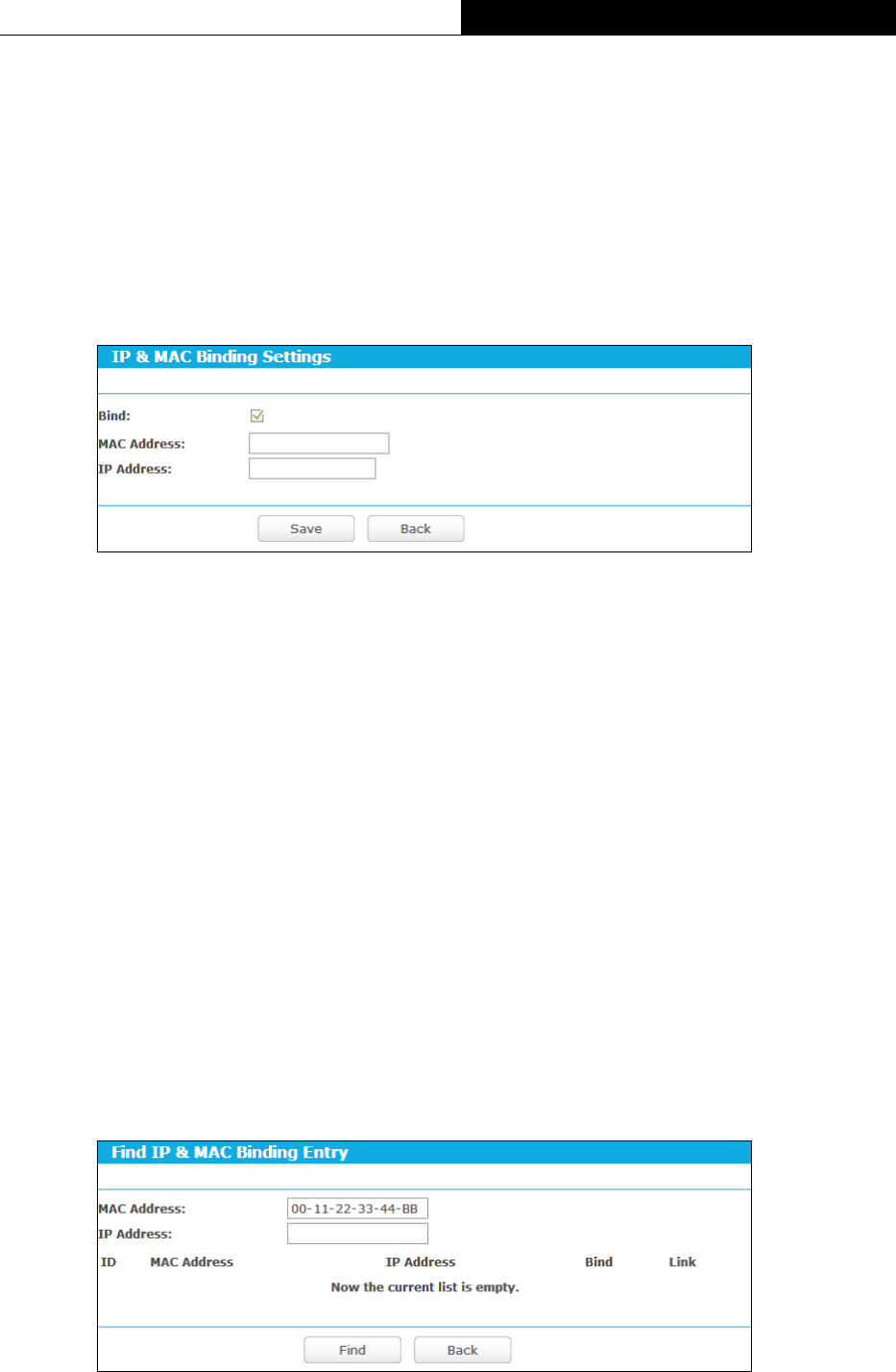
-79-
TL-WR841HP
300Mbps High Power Wireless N Router
MAC Address - The MAC address of the controlled computer in the LAN.
IP Address - The assigned IP address of the controlled computer in the LAN.
Bind - Check this option to enable ARP binding for a specific device.
Modify - To modify or delete an existing entry.
When you want to add or modify an IP & MAC Binding entry, you can click the Add New…
button or Modify button, and then you will go to the next page. This page is used for adding or
modifying an IP & MAC Binding entry.
Figure 3-69 IP & MAC Binding Setting (Add & Modify)
To add IP & MAC Binding entries, follow the steps below.
1. Click the Add New... button as shown in Figure 3-68.
2. Enter the MAC Address and IP Address.
3. Select the Bind checkbox.
4. Click the Save button to save it.
To modify or delete an existing entry, follow the steps below.
1. Find the desired entry in the table.
2. Click Modify or Delete as desired on the Modify column.
To find an existing entry, follow the steps below.
1. Click the Find button in Figure 3-68.
2. Enter the MAC Address or IP Address.
3. Click the Find button.
Figure 3-70 Find IP & MAC Binding Entry

-80-
TL-WR841HP
300Mbps High Power Wireless N Router
Click the Enable All button to make all entries enabled.
Click the Delete All button to delete all entries.
3.4.14 ARP List
Go to “Advanced→Bandwidth Control→ARP List”, you can see the ARP List, showing all the
existing IP & MAC Binding entries as shown below. To manage the computer, you could
observe the computers in the LAN by checking the relationship of MAC address and IP address
on the ARP list, and you could also configure the items on the ARP list.
Figure 3-71 ARP List
1. MAC Address - The MAC address of the controlled computer in the LAN.
2. IP Address - The assigned IP address of the controlled computer in the LAN.
3. Status - Indicates whether or not the MAC and IP addresses are bound.
4. Configure - Load or delete an item.
Load - Load the item to the IP & MAC Binding list.
Delete - Delete the item.
Click the Bind All button to bind all the current items, available after enable.
Click the Load All button to load all items to the IP & MAC Binding list.
Click the Refresh button to refresh all items.
Note:
An item could not be loaded to the IP & MAC Binding list if the IP address of the item has been
loaded before. Error warning will prompt as well. Likewise, "Load All" only loads the items without
interference to the IP & MAC Binding list.
3.4.15 Dynamic DNS
Go to “Dynamic DNS”, and you can configure the Dynamic DNS function.
The router offers the DDNS (Dynamic Domain Name System) feature, which allows the hosting
of a website, FTP server, or e-mail server with a fixed domain name (named by yourself) and a
dynamic IP address, and then your friends can connect to your server by entering your domain
name no matter what your IP address is. Before using this feature, you need to sign up for
DDNS service providers such as www.comexe.cn, dyn.com/dns, or www.no-ip.com. The
Dynamic DNS client service provider will give you a password or key.
3.4.15.1. Comexe DDNS
If the dynamic DNS Service Provider you select is www.comexe.cn.
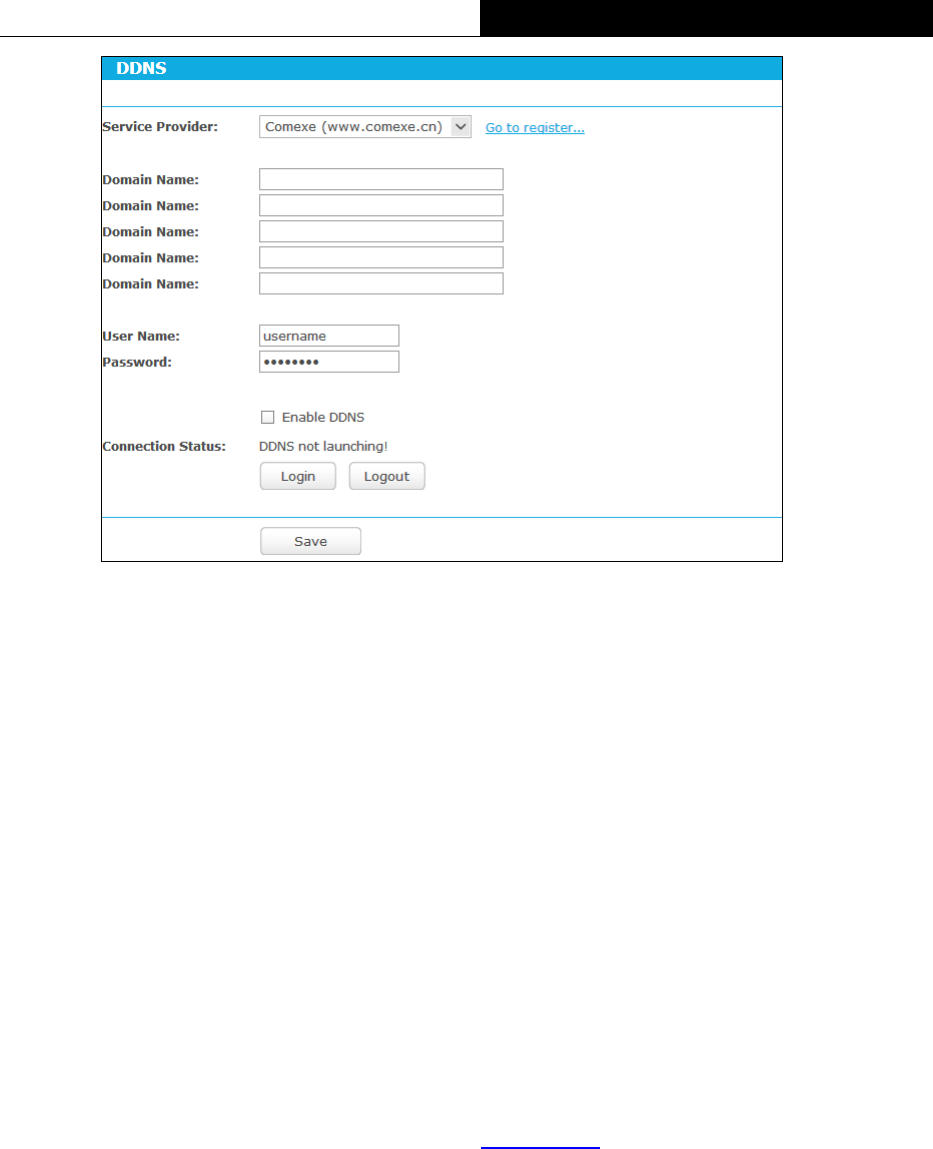
-81-
TL-WR841HP
300Mbps High Power Wireless N Router
Figure 3-72 Comexe.cn DDNS Settings
To set up for DDNS, follow these instructions:
1. Enter the Domain Name your dynamic DNS service provider gave.
2. Enter the User Name for your DDNS account.
3. Enter the Password for your DDNS account.
4. Click the Login button to login the DDNS service.
Connection Status -The status of the DDNS service connection is displayed here.
Click Logout to log out of the DDNS service.
Note:
If you want to login again with another account after a successful login, please click the
Logout button, then input your new username and password and click the Login button.
3.4.15.2. Dyn DDNS
If the dynamic DNS Service Provider you select is dyn.com/dns.
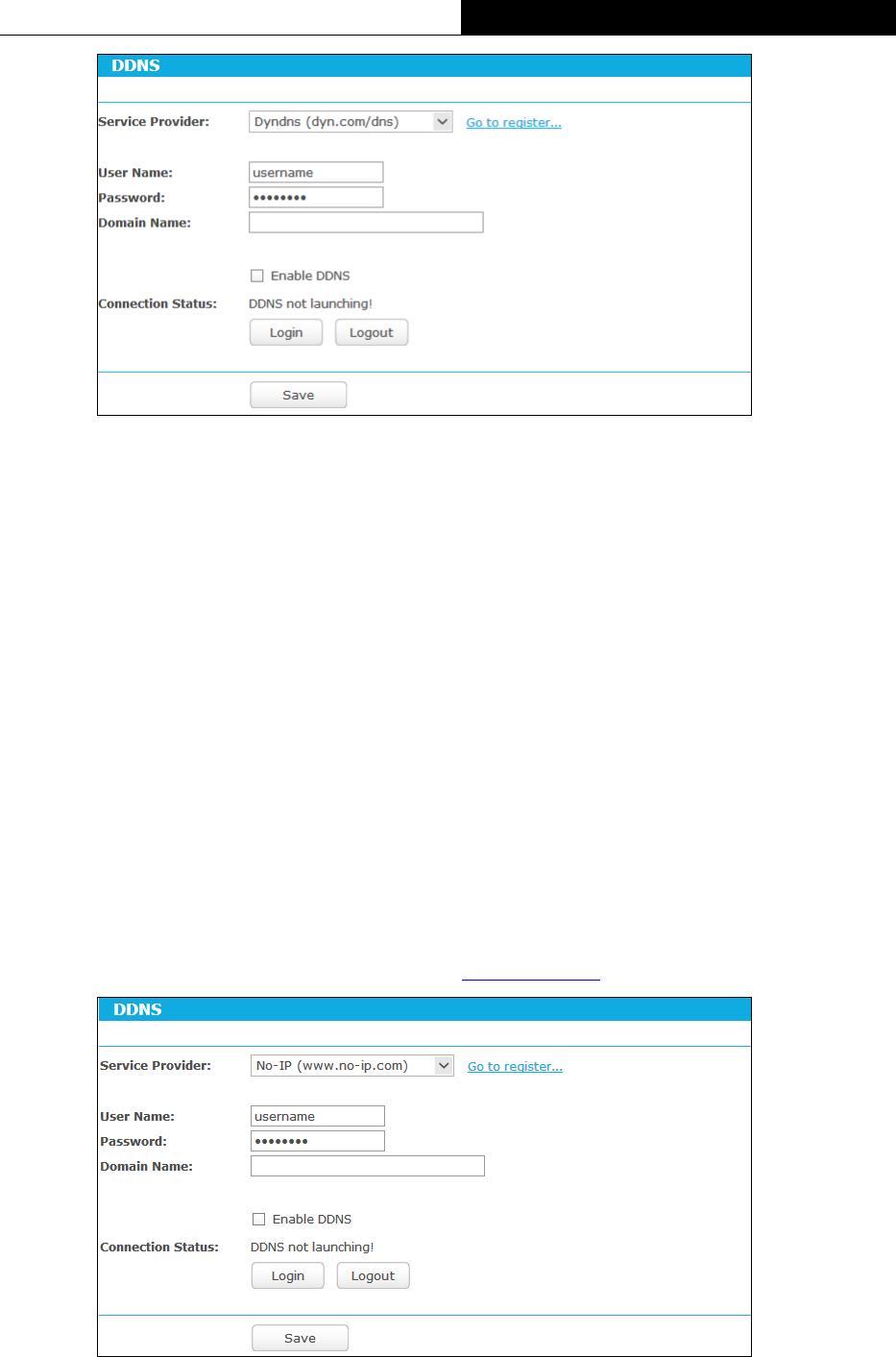
-82-
TL-WR841HP
300Mbps High Power Wireless N Router
Figure 3-73 Dyndns.org DDNS Settings
To set up for DDNS, follow these instructions:
1. Enter the User Name for your DDNS account.
2. Enter the Password for your DDNS account.
3. Enter the Domain Name you received from dynamic DNS service provider.
4. Click the Login button to login to the DDNS service.
Connection Status -The status of the DDNS service connection is displayed here.
Click Logout to logout of the DDNS service.
Note:
If you want to login again with another account after a successful login, please click the
Logout button, then input your new username and password and click the Login button.
3.4.16 No-IP DDNS
If the dynamic DNS Service Provider you select is www.no-ip.com.
Figure 3-74 No-ip.com DDNS Settings
To set up for DDNS, follow these instructions:
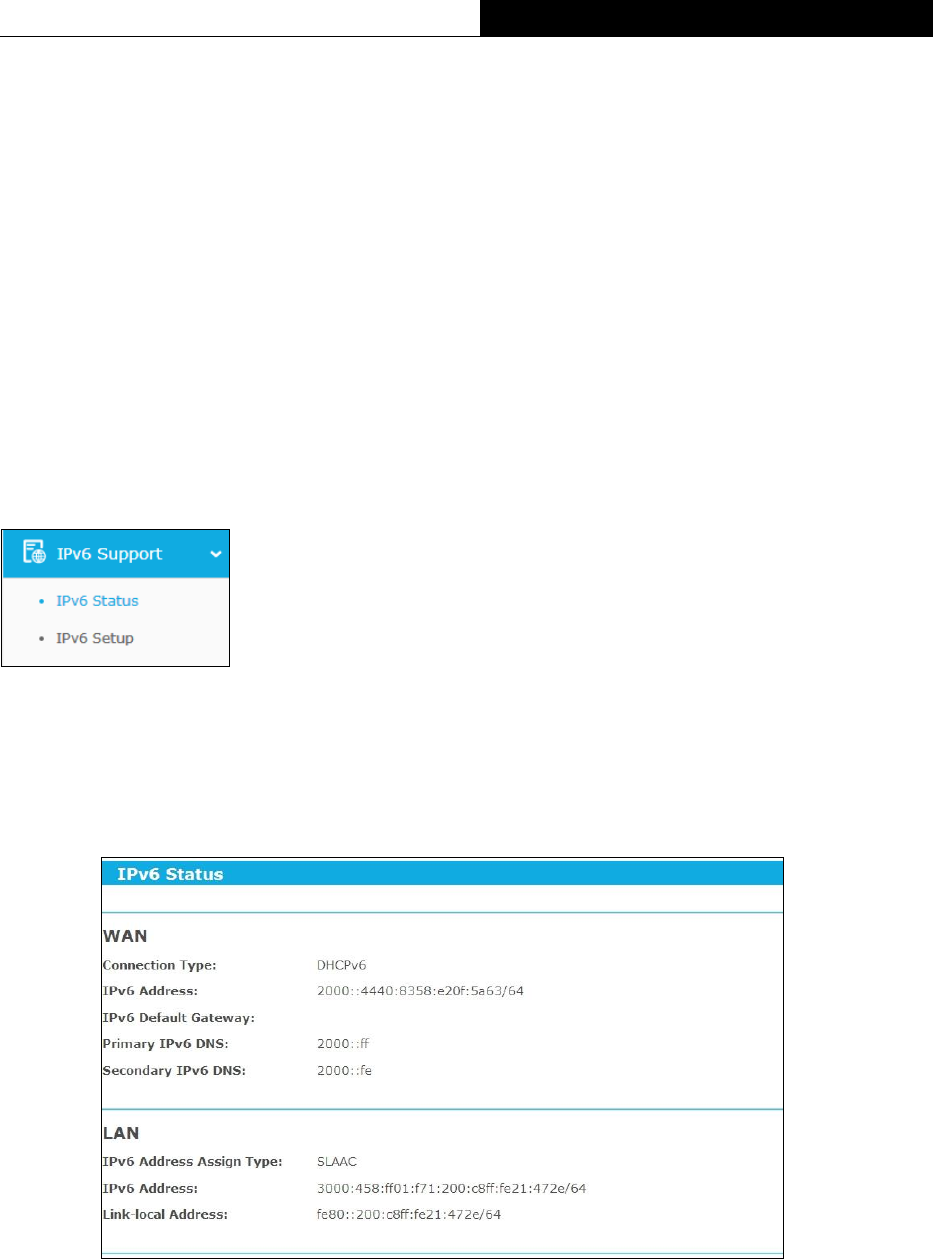
-83-
TL-WR841HP
300Mbps High Power Wireless N Router
1. Enter the User Name for your DDNS account.
2. Enter the Password for your DDNS account.
3. Enter the Domain Name you received from dynamic DNS service provider.
4. Click the Login button to login to the DDNS service.
Connection Status - The status of the DDNS service connection is displayed here.
Click Logout to log out the DDNS service.
Note:
If you want to login again with another account after a successful login, please click the
Logout button, then input your new username and password and click the Login button.
3.4.17 IPv6 Support
There are two submenus under the IPv6 Support menu: IPv6 Status and IPv6 Setup. Click
either of them, and you will be able to scan or configure the corresponding function. The
detailed explanations for each submenu are provided below.
3.4.17.1. IPv6 Status
Figure 3-75 IPv6 Status
The IPv6 Status page displays the router's current IPv6 status and configuration. All
information is read-only.
WAN
Connection Type - The IPv6 connection way for WAN
IPv6 Address - The WAN IPv6 address
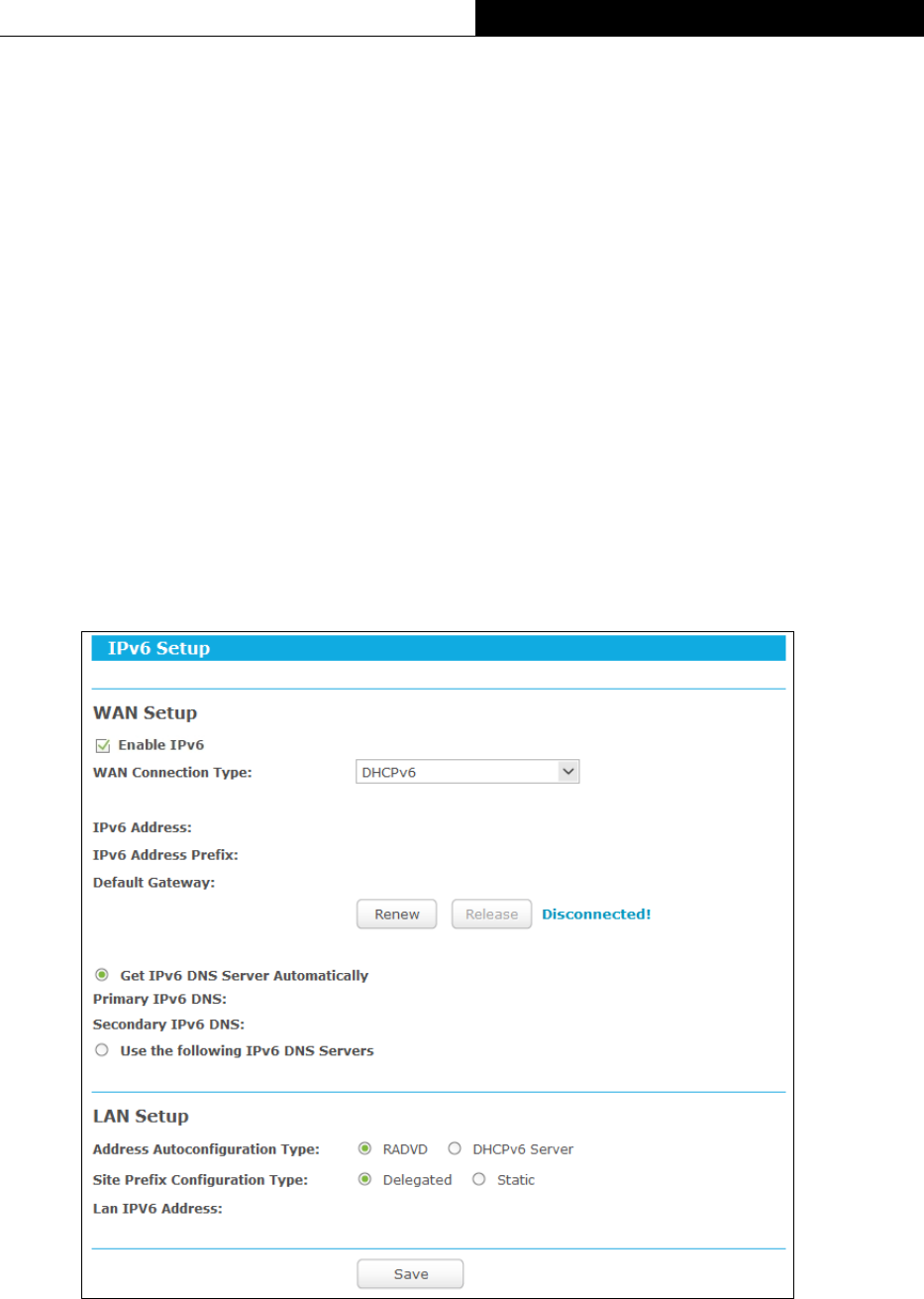
-84-
TL-WR841HP
300Mbps High Power Wireless N Router
IPv6 Default Gateway - The router's default gateway
Primary IPv6 DNS - The primary IPv6 DNS address
Secondary IPv6 DNS - The secondary IPv6 DNS address
LAN
IPv6 Address Assign Type - There are two types of assignation for IPv6 address:
SLAAC (Stateless address auto-configuration) and DHCPv6 (Dynamic Host
Configuration Protocol for IPv6) Server.
1) SLAAC
IPv6 Address Prefix -The Prefix of IPv6 Address
2) DHCPv6 Server
Release Time - the length of time a network user will be allowed to keep
connecting to the router with the current DHCPv6 Address. Enter the amount of
time (in seconds) that the DHCPv6 address will be leased. The time range is
1~691200 seconds. The default value is 86400 seconds.
IPv6 Address - Displays the LAN IPv6 Address.
3.4.17.2. IPv6 Setup
Figure 3-76 Enable/Disable IPv6
Enable IPv6 - Tick the checkbox to enable the IPv6 function. It’s enabled by default.
WAN Connection Type - Choose the correct WAN connection type based on your ISP
network topology.
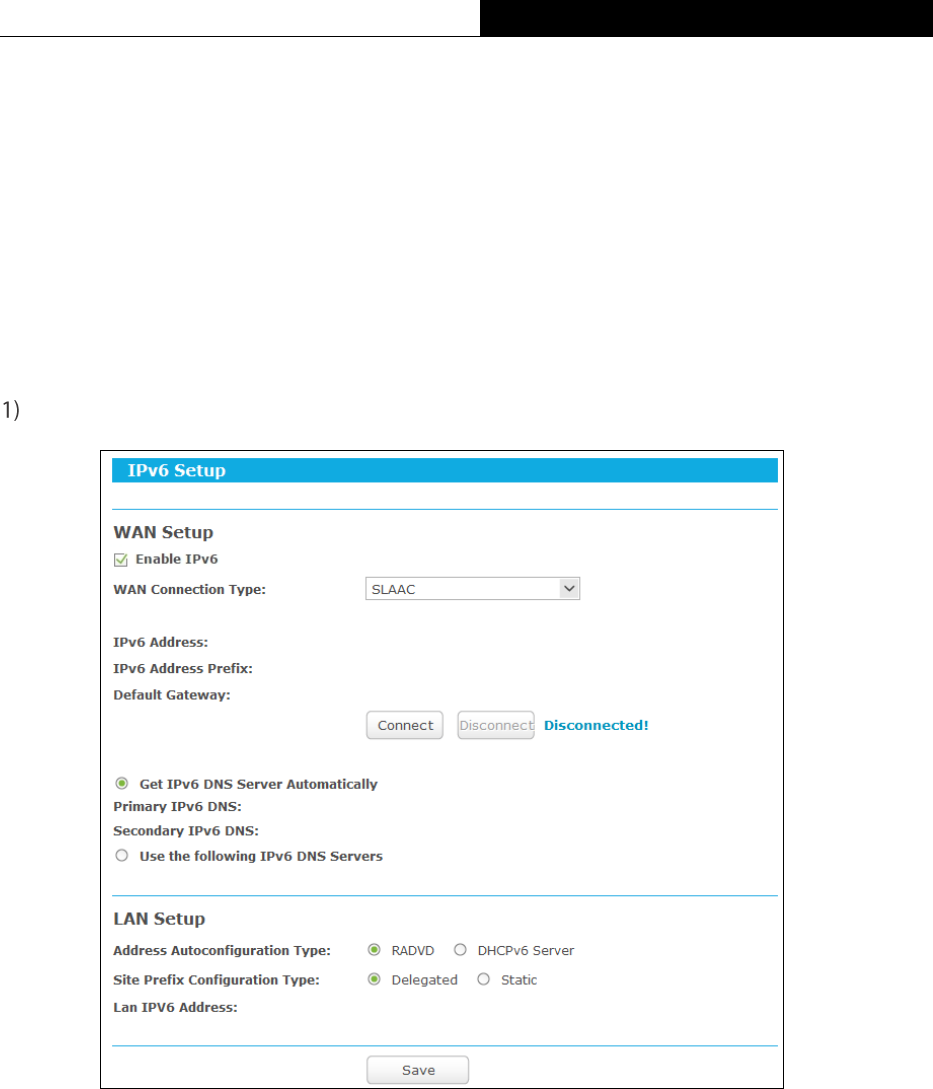
-85-
TL-WR841HP
300Mbps High Power Wireless N Router
SLAAC - Connections which use Radvd IPv6 address assignment.
DHCPv6 - Connections which use dynamic IPv6 address assignment.
Static IPv6 - Connections which use static IPv6 address assignment.
PPPoEv6 - Connections which use PPPoEV6 that requires a user name and
password.
Tunnel 6to4 - Connections which use 6to4 address assignment.
Different types of WAN connection require you to do different settings. Below are the detailed
explanations for the respective type.
SLAAC
Figure 3-77 SLAAC
IPv6 Address - Display the IPv6 address in colon-hexadecimal notation provided by your
ISP.
IPv6 Address Prefix - Display the IPv6 Prefix Length in dotted-decimal notation provided
by your ISP.
Default Gateway - Display the default gateway in colon-hexadecimal notation provided by
your ISP.
If your ISP gives you one or two DNS IPv6 addresses, select Use the following IPv6 DNS
Servers and enter the Primary IPv6 DNS and Secondary IPv6 DNS into the correct fields.

-86-
TL-WR841HP
300Mbps High Power Wireless N Router
Otherwise, the DNS servers will be assigned from ISP dynamically.
Primary IPv6 DNS - Enter the DNS IPv6 address in colon-hexadecimal notation provided
by your ISP.
Secondary IPv6 DNS - Enter another DNS IPv6 address in colon-hexadecimal notation
provided by your ISP.
Note:
If you get Address not found error when you access a Web site, it is likely that your DNS servers
are set up improperly. You should contact your ISP to get DNS server addresses.
Address Autoconfiguration Type - RADVD (Router Advertisement Daemon) and
DHCPv6 (Dynamic Host Configuration Protocol for IPv6) Server.
Site Prefix Configuration Type - The type of IPv6 address prefix.
Delegated - Get the IPv6 address prefix from the ISP automaticlly, and the device will
delegate it to the LAN.
Static - Configure the Site Prefix and Site Prefix Length manually. Please contact your
ISP to get more infomation before you configure them.
LAN IPv6 Address - Display the LAN IPv6 address created by the device.
Click the Save button to save your settings.
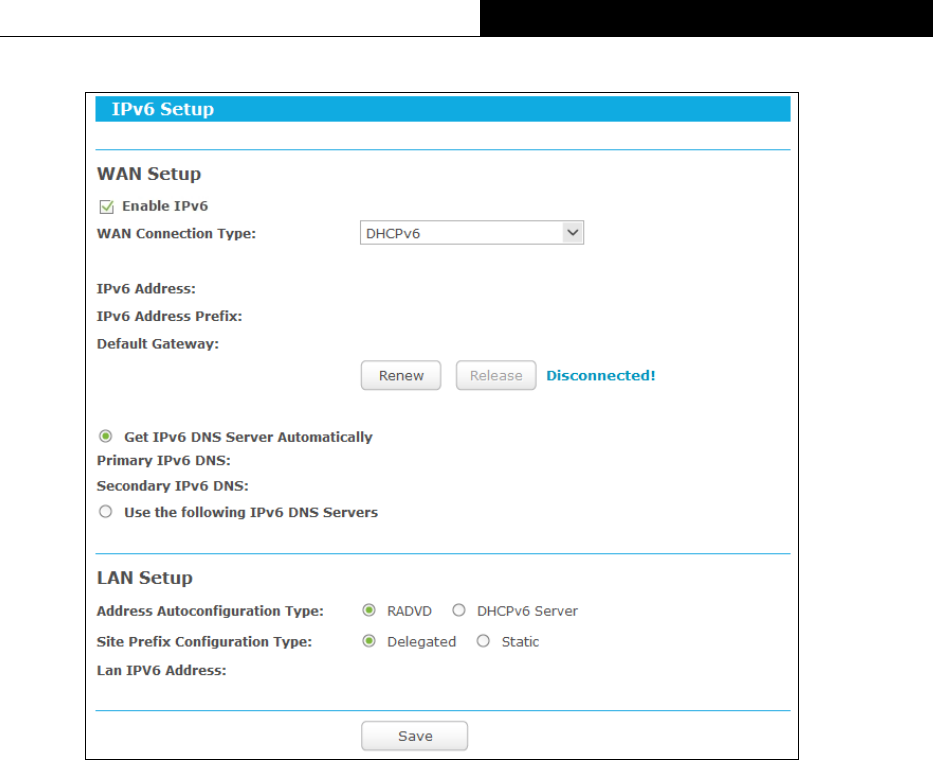
-87-
TL-WR841HP
300Mbps High Power Wireless N Router
1) DHCPv6
Figure 3-78 DHCPv6
IPv6 Address - Display the IPv6 address in colon-hexadecimal notation provided by your
ISP.
IPv6 Address Prefix - Display the IPv6 Prefix Length in dotted-decimal notation provided
by your ISP.
Default Gateway - Display the default gateway in colon-hexadecimal notation provided by
your ISP.
Click the Renew button to renew the IPv6 parameters from your ISP.
Click the Release button to release the IPv6 parameters from your ISP.
If your ISP gives you one or two DNS IPv6 addresses, select Use the following IPv6 DNS
Servers and enter the Primary IPv6 DNS and Secondary IPv6 DNS into the correct fields.
Otherwise, the DNS servers will be assigned from ISP dynamically.
Primary IPv6 DNS - Enter the DNS IPv6 address in dotted-decimal notation provided by your
ISP.
Secondary IPv6 DNS - Enter another DNS IPv6 address in dotted-decimal notation
provided by your ISP.
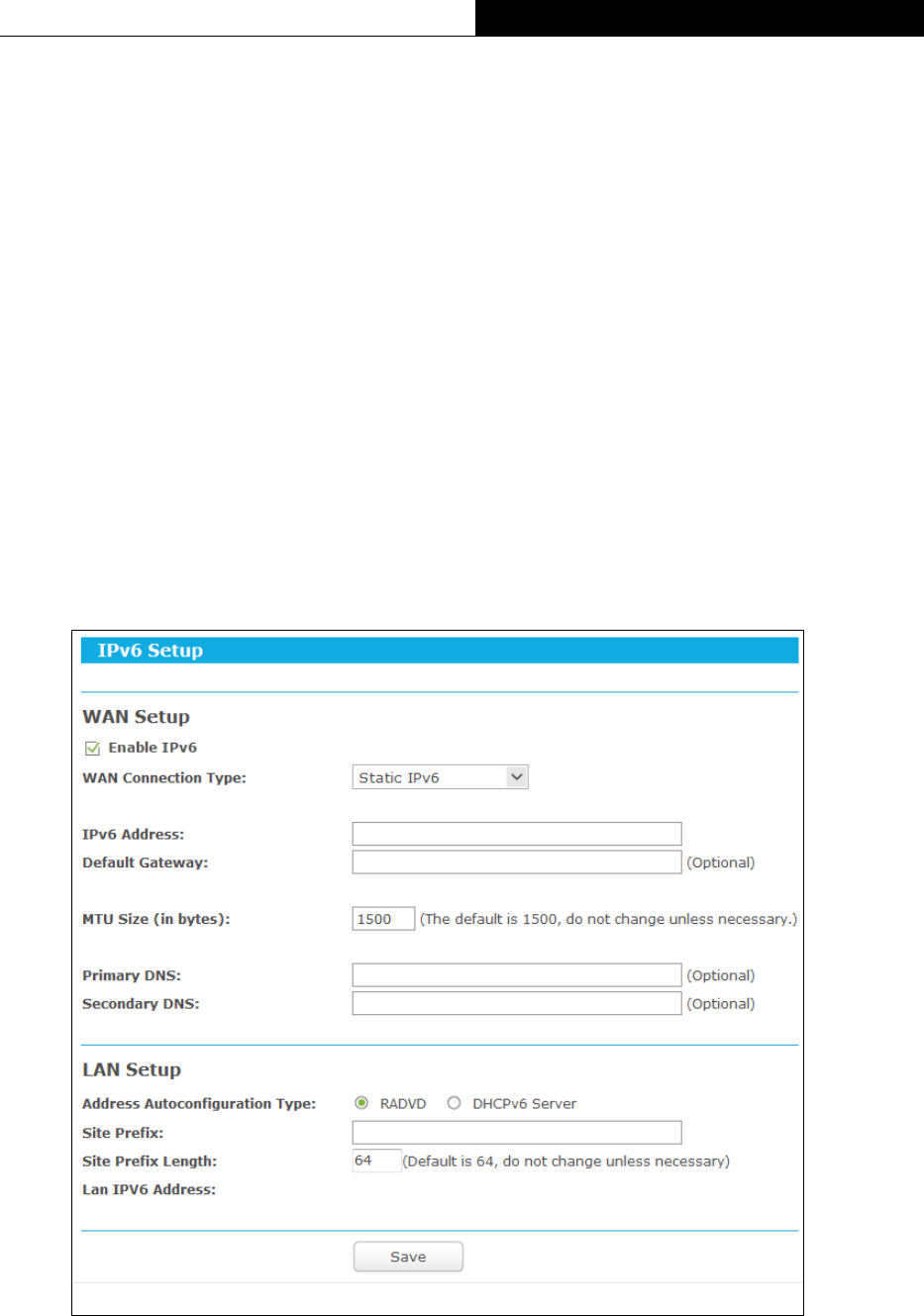
-88-
TL-WR841HP
300Mbps High Power Wireless N Router
Note:
If you get Address not found error when you access a Web site, it is likely that your DNS servers
are set up improperly. You should contact your ISP to get DNS server addresses.
Address Autoconfiguration Type - RADVD (Router Advertisement Daemon) and
DHCPv6 (Dynamic Host Configuration Protocol for IPv6) Server.
Site Prefix Configuration Type - The type of IPv6 address prefix.
Delegated - Get the IPv6 address prefix from the ISP automaticlly, and the device will
delegate it to the LAN.
Static - Configure the Site Prefix and Site Prefix Length manually. Please contact your
ISP to get more infomation before you configure them.
LAN IPv6 Address - Display the LAN IPv6 address created by the device.
Click the Save button to save your settings.
2) Static IPv6
Figure 3-79 Static IPv6
IPv6 Address - Enter the IPv6 address in dotted-decimal notation provided by your ISP.
Default Gateway - Enter the default gateway in dotted-decimal notation provided by your
ISP.
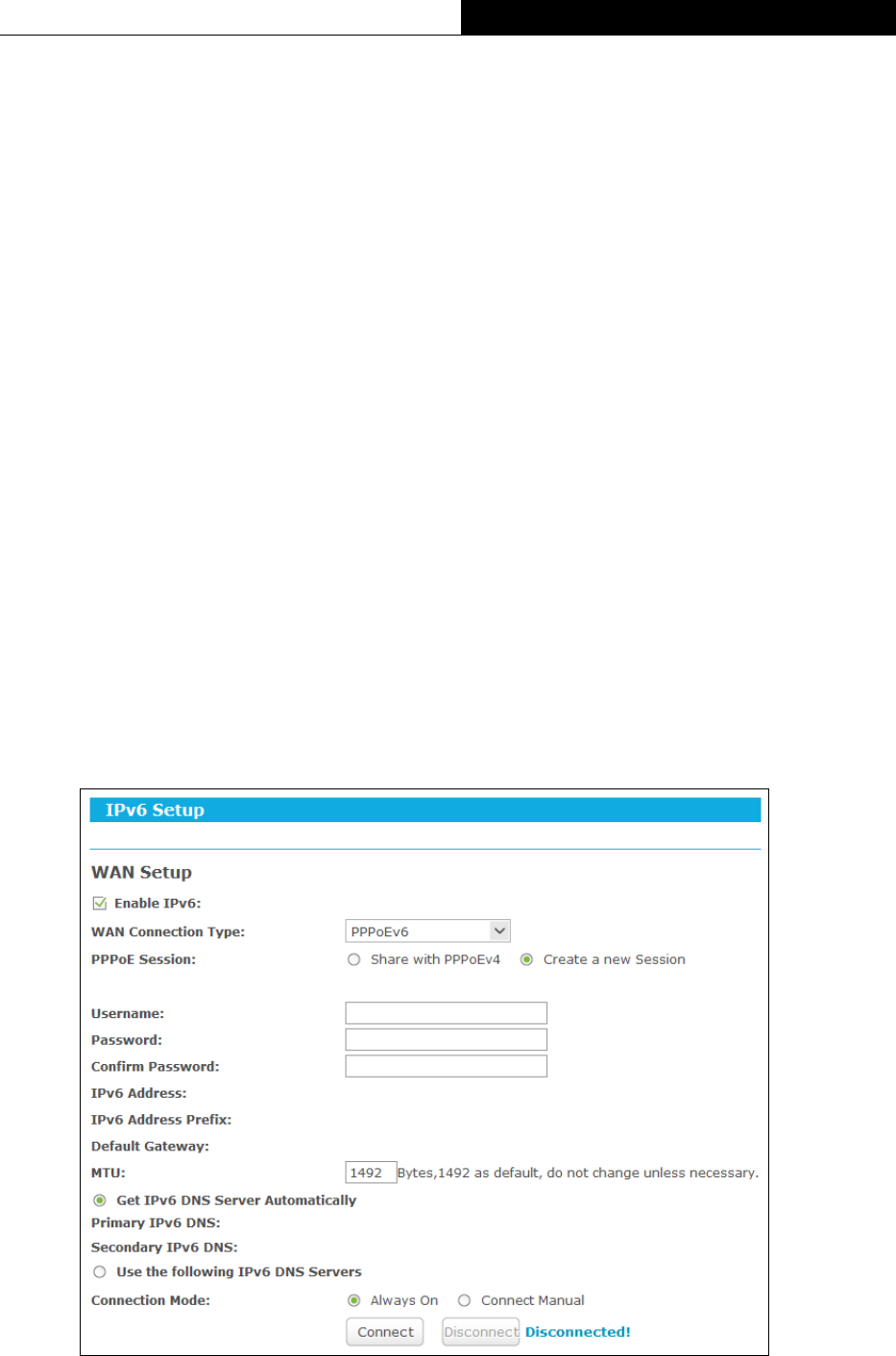
-89-
TL-WR841HP
300Mbps High Power Wireless N Router
MTU Size - The normal MTU (Maximum Transmission Unit) value for most Ethernet
networks is 1500 Bytes. For some ISPs, you may need to modify the MTU. But this is rarely
required, and should not be done unless you are sure it is necessary for your ISP
connection.
Primary DNS - Enter the DNS IPv6 address in dotted-decimal notation provided by your
ISP.
Secondary DNS - Enter another DNS IPv6 address in dotted-decimal notation provided by
your ISP.
Note:
If you get Address not found error when you access a Web site, it is likely that your DNS servers
are set up improperly. You should contact your ISP to get DNS server addresses.
Address Autoconfiguration Type – RADVD (Router Advertisement Daemon) and
DHCPv6 (Dynamic Host Configuration Protocol for IPv6) Server.
Site Prefix/ Site Prefix Length: - Configure the Site Prefix and Site Prefix Length. Please
contact your ISP before configuration.
LAN IPv6 Address - Display the LAN IPv6 address created by the device.
Click the Save button to save your settings.
3) PPPoEv6
Figure 3-80 PPPoEv6
PPPoE Session - The PPP session type for IPv6 connection. There are two types:
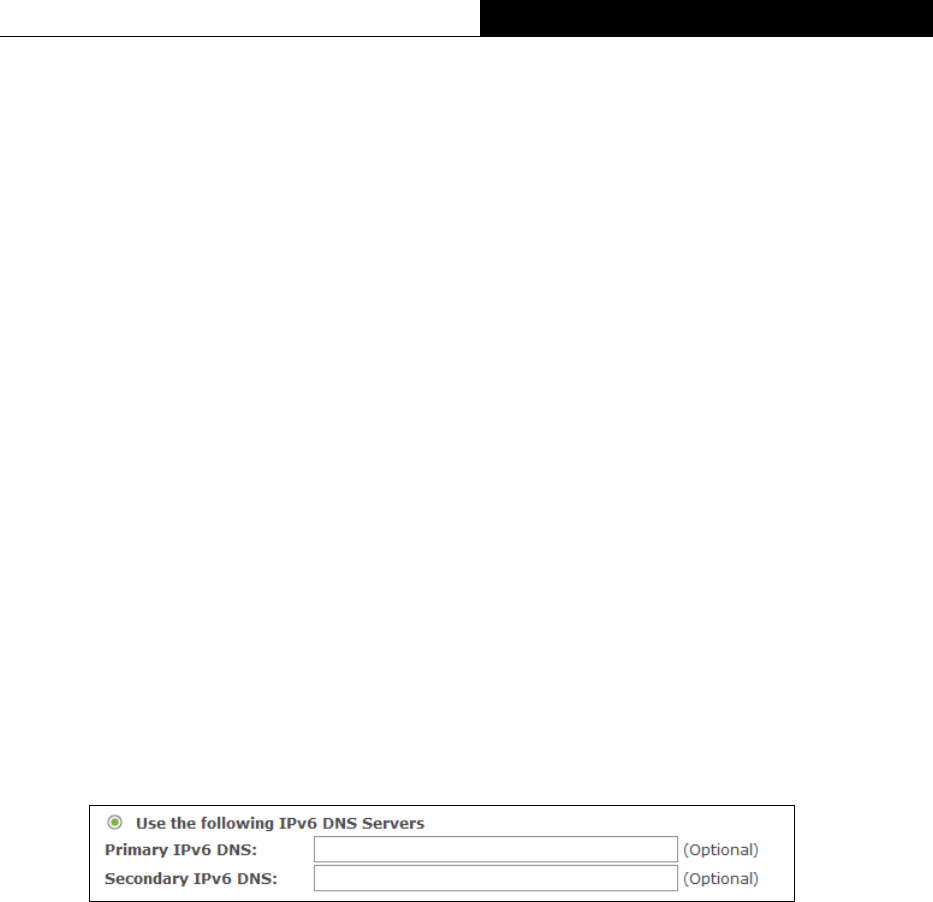
-90-
TL-WR841HP
300Mbps High Power Wireless N Router
Share with PPPoEv4 - The PPPoEv6 and PPPoEv4 use the same PPP session.
Create a new Session - The PPPoEv6 and PPPoEv4 use different PPP sessions. It is
default to select this option.
User Name/Password - Enter the User Name and Password provided by your ISP. These
fields are case-sensitive.
IPv6 Address - Display the IPv6 address in colon-hexadecimal notation provided by your
ISP.
IPv6 Address Prefix - Display the IPv6 Prefix Length in dotted-decimal notation provided
by your ISP.
Default Gateway - Display the default gateway in colon-hexadecimal notation provided by
your ISP.
MTU - The normal MTU (Maximum Transmission Unit) value for most Ethernet networks is
1492 Bytes. For some ISPs, you may need to modify the MTU. But this is rarely required,
and should not be done unless you are sure it is necessary for your ISP connection.
If your ISP gives you one or two DNS IPv6 addresses, select Use the following IPv6 DNS
Servers and enter the Primary IPv6 DNS and Secondary IPv6 DNS into the correct fields.
Otherwise, the DNS servers will be assigned from ISP dynamically.
Primary IPv6 DNS - Enter the DNS IPv6 address in colon-hexadecimal notation provided
by your ISP.
Secondary IPv6 DNS - Enter another DNS IPv6 address in colon-hexadecimal notation
provided by your ISP.
Note:
If you get Address not found error when you access a Web site, it is likely that your DNS
servers are set up improperly. You should contact your ISP to get DNS server addresses.
Connection Mode - The way to connect the ISP.
Always On - Connect automatically.
Connect Manual - Connect by the user manually.
Click the Connect button to connect immediately.
Click the Disconnect button to disconnect immediately.
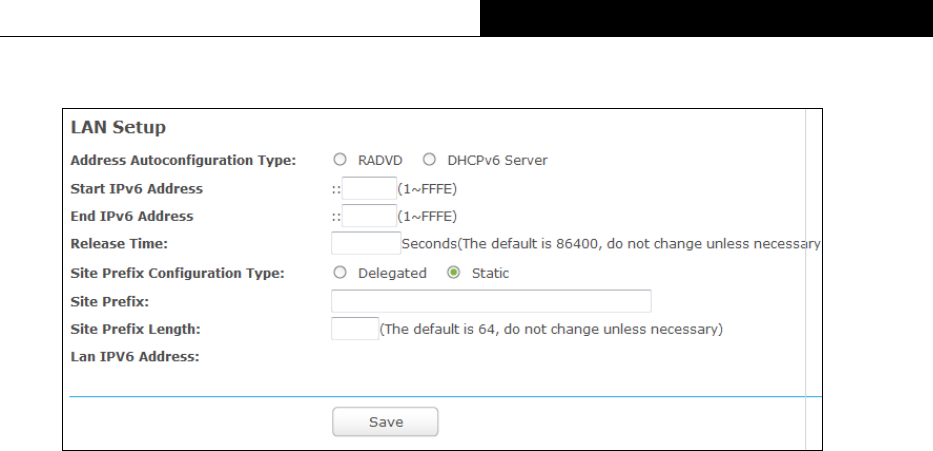
-91-
TL-WR841HP
300Mbps High Power Wireless N Router
LAN Setup
Figure 3-81 LAN Setup
Address Autoconfiguration Type – RADVD (Router Advertisement Daemon) and
DHCPv6 (Dynamic Host Configuration Protocol for IPv6) Server.
Start IPv6 Address - The start address of the DHCPv6 pool for LAN DHCPv6 Server.
End IPv6 Address - The end address of the DHCPv6 pool for LAN DHCPv6 Server.
Release Time - The Release Time is the length of time a network user will be allowed to
keep connecting to the Router with the current DHCPv6 Address. Enter the amount of time,
in seconds, that the DHCPv6 address will be "leased". The time range is 1~691200
seconds. The default value is 86400 seconds.
Site Prefix Configuration Type - The type of IPv6 address prefix.
Delegated - Get the IPv6 address prefix from the ISP automatically, and the device will
delegate it to the LAN.
Static - Configure the Site Prefix and Site Prefix Length manually. Please contact your
ISP to get more information before you configure them.
Site Prefix/ Site Prefix Length: - Configure the Site Prefix and Site Prefix Length. Please
contact your ISP before configuration.
LAN IPv6 Address - Display the LAN IPv6 address created by the device.
Click the Save button to save your settings.
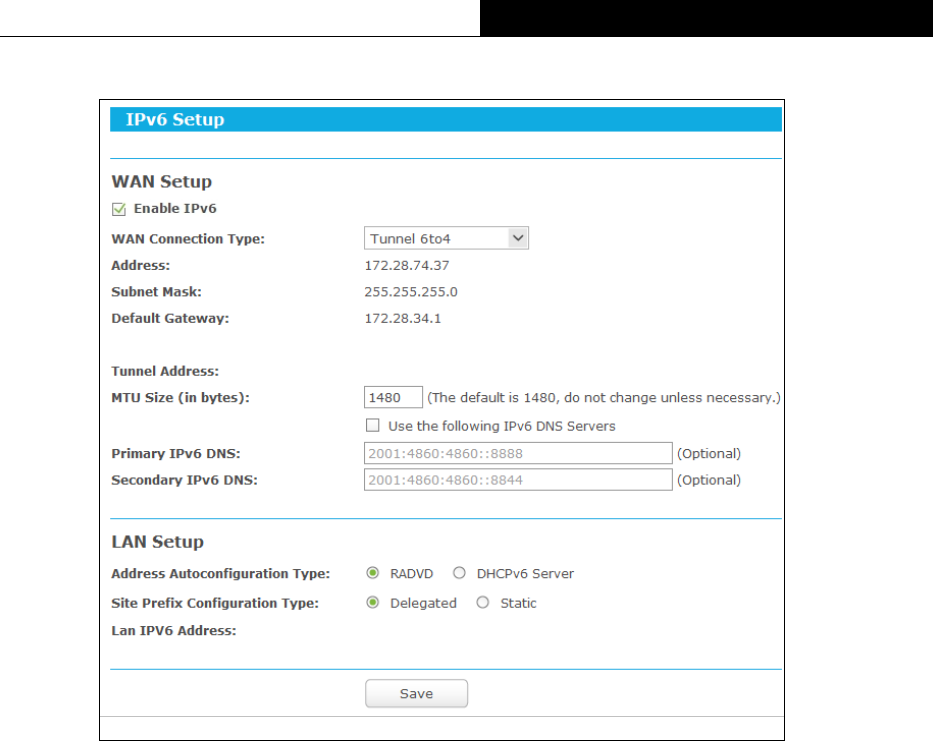
-92-
TL-WR841HP
300Mbps High Power Wireless N Router
4) Tunnel 6to4
Figure 3-82 Tunnel 6to4
Address/Subnet Mask/Default Gateway - the IPv4 address/ subnet mask/ default
gateway assigned, in dotted-decimal notation.
Tunnel Address - The 6to4 tunnel address created by the device to access to the IPv6
network.
MTU Size - The normal MTU (Maximum Transmission Unit) value for most Ethernet
networks is 1480 Bytes. For some ISPs, you may need to modify the MTU. But this is rarely
required, and should not be done unless you are sure it is necessary for your ISP
connection.
If your ISP gives you one or two DNS IPv6 addresses, select Use the following IPv6 DNS
Servers and enter the Primary IPv6 DNS and Secondary IPv6 DNS into the correct fields.
Otherwise, the DNS servers will be assigned from ISP dynamically.
Primary IPv6 DNS - Enter the DNS IPv6 address in dotted-decimal notation provided by
your ISP.
Secondary IPv6 DNS - Enter another DNS IPv6 address in dotted-decimal notation
provided by your ISP.
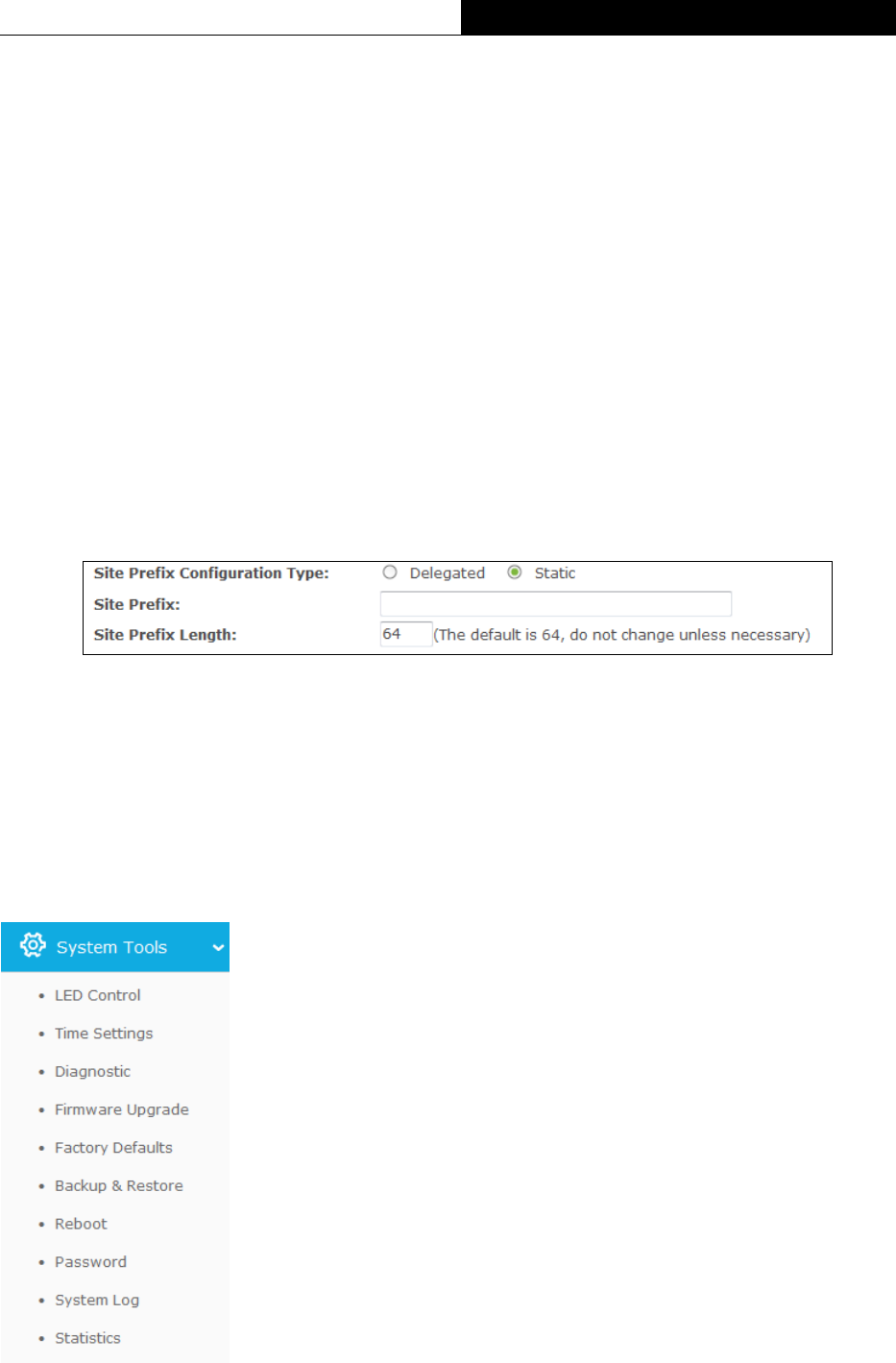
-93-
TL-WR841HP
300Mbps High Power Wireless N Router
Note:
If you get Address not found error when you access a Web site, it is likely that your DNS servers
are set up improperly. You should contact your ISP to get DNS server addresses.
LAN Setup
Address Autoconfiguration Type – RADVD (Router Advertisement Daemon) and
DHCPv6 (Dynamic Host Configuration Protocol for IPv6) Server.
Site Prefix Configuration Type - The type of IPv6 address prefix.
Delegated - Get the IPv6 address prefix from the ISP automatically, and the device will
delegate it to the LAN.
Static - Configure the Site Prefix and Site Prefix Length manually. Please contact your
ISP to get more information before you configure them.
Site Prefix/ Site Prefix Length: - Configure the Site Prefix and Site Prefix Length.
Please contact your ISP before configuration.
LAN IPv6 Address - Display the LAN IPv6 address created by the device.
Click the Save button to save your settings.
3.4.18 System Tools
Go to “System Tools”, and you can see these submenus under the main menu: LED Control,
Time Settings, Diagnostic, Firmware Upgrade, Factory Defaults, Backup & Restore,
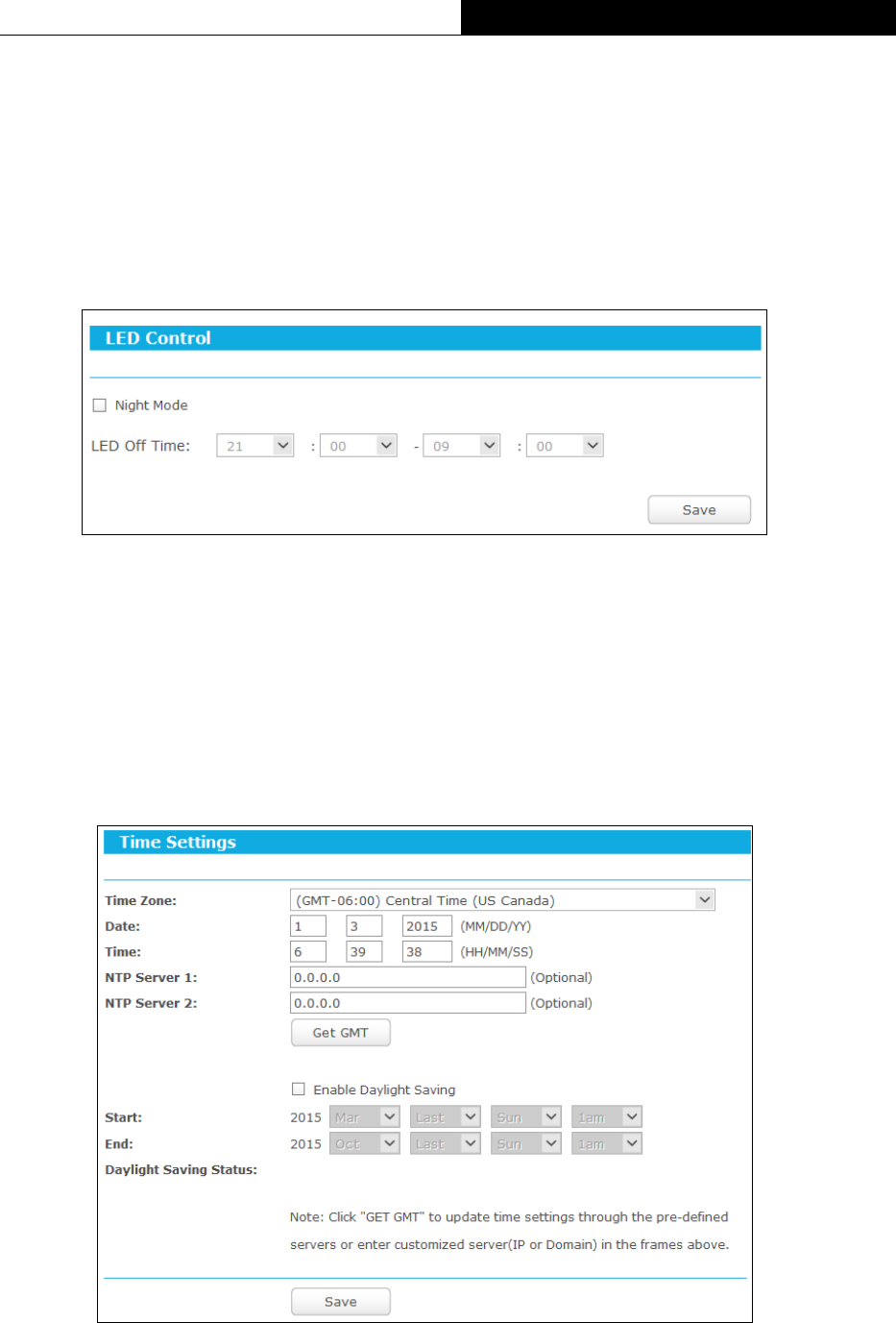
-94-
TL-WR841HP
300Mbps High Power Wireless N Router
Reboot, Password, System Log and Statistics. Click any of them, and you will be able to
configure the corresponding functions. The detailed explanations for each submenu are
provided below.
3.4.18.1. LED Control
Go to “Advanced→System Tools→LED Control”, and then you can turn On or Off the LEDs
on your router according to a specific time schedule.
Figure 3-83 LED Control
Night Mode - Indicates whether the Night Mode is On (enabled) or Off (disabled).
LED Off Time - Select the time schedule to turn off LEDs.
3.4.18.2. Time Settings
Go to “Advanced→System Tools→Time Settings”, and then you can configure the time on
the following screen.
Figure 3-84 Time settings
Time Zone - Select your local time zone from this pull down list.

-95-
TL-WR841HP
300Mbps High Power Wireless N Router
Date - Enter your local date in MM/DD/YY into the right blanks.
Time - Enter your local time in HH/MM/SS into the right blanks.
NTP Server I / NTP Server II - Enter the address or domain of the NTP Server I or NTP
Server II, and then the router will get the time from the NTP Server preferentially. In
addition, the router built-in some common NTP Servers, so it can get time automatically
once it connects the Internet.
Enable Daylight Saving - Check the box to enable the Daylight Saving function.
Start - The time to start the Daylight Saving. Select the month in the first field, the week in
the second field, the day in the third field and the time in the last field.
End - The time to end the Daylight Saving. Select the month in the first field, the week in
the second field, the day in the third field and the time in the last field.
Daylight Saving Status - Displays the status whether the Daylight Saving is in use.
To set time manually:
1. Select your local time zone.
2. Enter the Date in Month/Day/Year format.
3. Enter the Time in Hour/Minute/Second format.
4. Click Save.
To set time automatically:
1. Select your local time zone.
2. Enter the address or domain of the NTP Server I or NTP Server II.
3. Click the Get GMT button to get system time from Internet if you have connected to the
Internet.
To set Daylight Saving:
1. Check the box to enable Daylight Saving.
2. Select the start time from the drop-down lists in the Start field.
3. Select the end time from the drop-down lists in the End field.
4. Click the Save button to save the settings.
Figure 3-85 Time settings
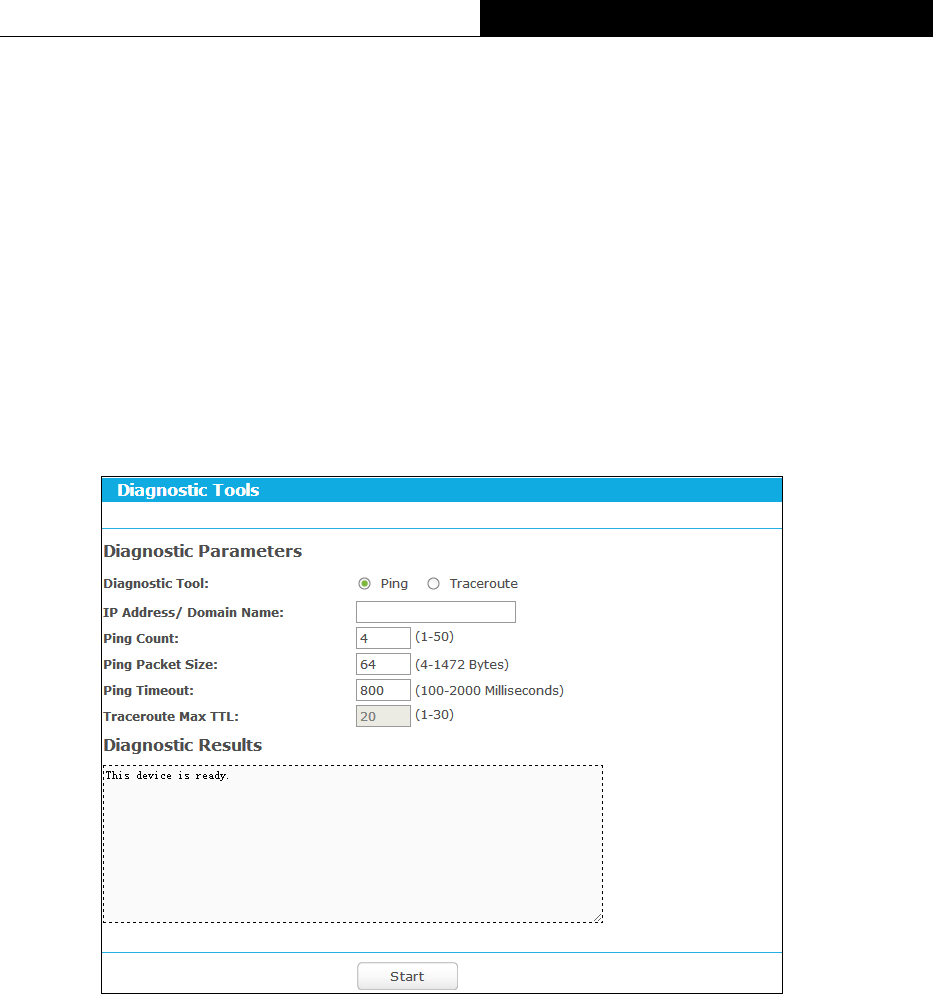
-96-
TL-WR841HP
300Mbps High Power Wireless N Router
Note:
1) This setting will be used for some time-based functions such as firewall. You must specify
your time zone once you login to the router successfully; otherwise, these functions will not
take effect.
2) The time will be lost if the router is turned off.
3) The router will automatically obtain GMT from the Internet if it is configured accordingly.
4) The Daylight Saving will take effect one minute after the configurations are completed.
3.4.19 Diagnostic
Go to “Advanced →System Tools→Diagnostic”, and then you can transact Ping or
Traceroute function to check connectivity of your network in the following screen.
Figure 3-86 Diagnostic Tools
Diagnostic Tool - Check the radio button to select one diagnostic too.
Ping - This diagnostic tool troubleshoots connectivity, reachability, and name
resolution to a given host or gateway.
Traceroute - This diagnostic tool tests the performance of a connection.
Note:
You can use ping/traceroute to test both numeric IP address or domain name. If
pinging/tracerouting the IP address is successful, but pinging/tracerouting the domain
name is not, you might have a name resolution problem. In this case, ensure that the
domain name you are specifying can be resolved by using Domain Name System (DNS)
queries.
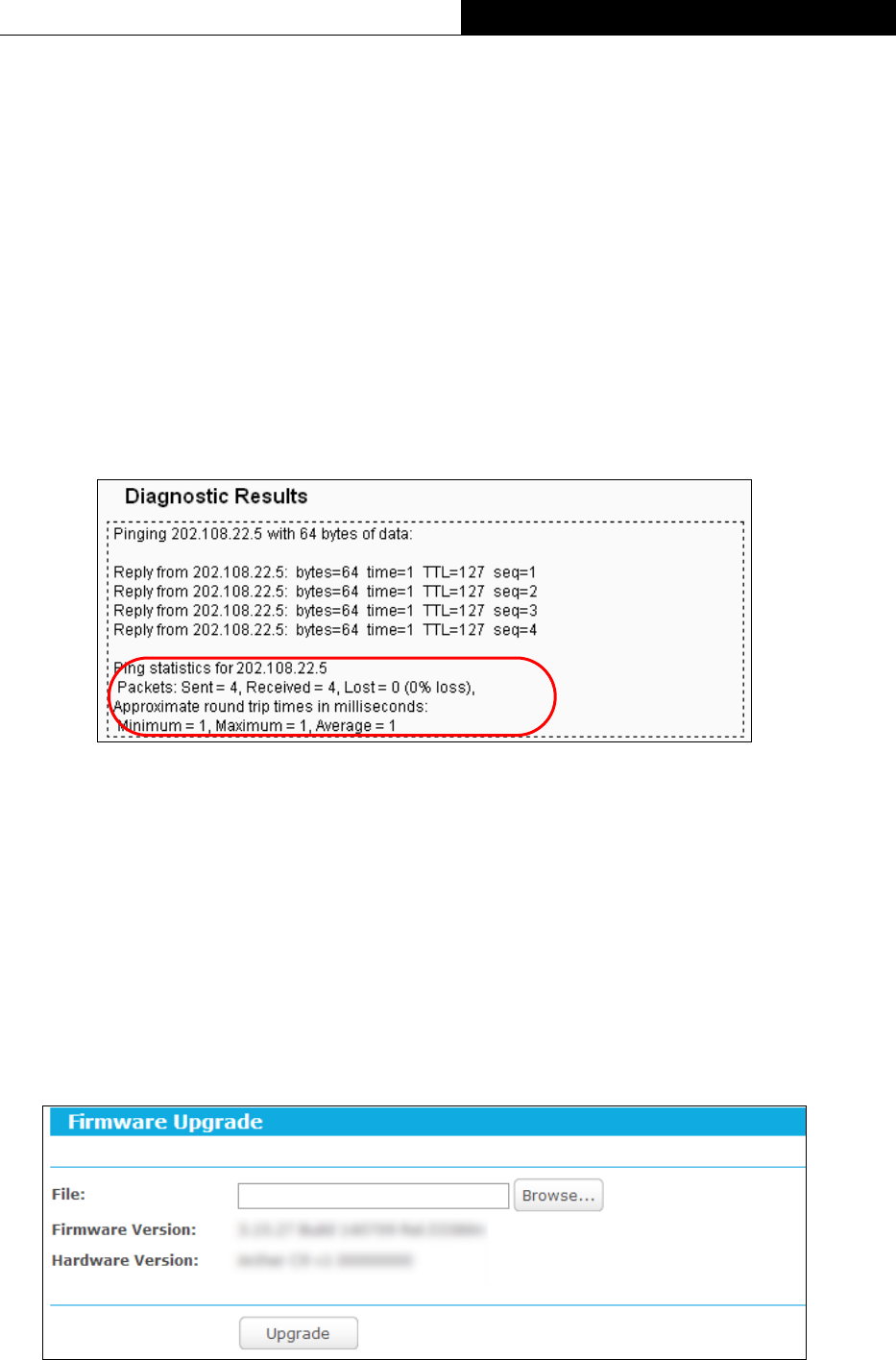
-97-
TL-WR841HP
300Mbps High Power Wireless N Router
IP Address/Domain Name - Enter the IP Address or Domain Name of the PC whose
connection you wish to diagnose.
Pings Count - Specifies the number of Echo Request messages sent. The default is 4.
Ping Packet Size - Specifies the number of data bytes to be sent. The default is 64.
Ping Timeout - Time to wait for a response, in milliseconds. The default is 800.
Traceroute Max TTL - Set the maximum number of hops (max TTL to be reached) in the
path to search for the target (destination). The default is 20.
Click Start to check the connectivity of the Internet.
The Diagnostic Results page displays the result of diagnosis.
If the result is similar to the following screen, the connectivity of the Internet is fine.
Figure 3-87 Diagnostic Results
Note:
1. Only one user can use the diagnostic tools at one time.
2. "Ping Count", "Ping Packet Size" and "Ping Timeout" are Ping Parameters, and
"Traceroute Max TTL" is Traceroute Parameter.
3.4.20 Firmware Upgrade
Go to “Advanced→System Tools→Firmware Upgrade”, and then you can update the latest
version of firmware for the router on the following screen.
Figure 3-88 Firmware Upgrade
Firmware Version - Displays the current firmware version.

-98-
TL-WR841HP
300Mbps High Power Wireless N Router
Hardware Version - Displays the current hardware version. The hardware version of the
upgrade file must accord with the router’s current hardware version.
To upgrade the router's firmware, follow these instructions below:
1. Download a most recent firmware upgrade file from our website (www.tp-link.com).
2. Enter or select the path name where you save the downloaded file on the computer into the
File blank.
3. Click the Upgrade button.
4. The router will reboot while the upgrading has been finished.
Note:
1) New firmware versions are posted at www.tp-link.com and can be downloaded for free. There
is no need to upgrade the firmware unless the new firmware has a new feature you want to
use. However, when experiencing problems caused by the router rather than the
configuration, you can try to upgrade the firmware.
2) When you upgrade the router's firmware, you may lose its current configurations, so before
upgrading the firmware please write down some of your customized settings to avoid losing
important settings.
3) Do not turn off the router or press the Reset button while the firmware is being upgraded.
Loss of power during the upgrade could damage the router.
4) The firmware version must correspond to the hardware.
5) The upgrade process takes a few moments and the router restarts automatically when the
upgrade is complete.
3.4.20.1. Factory Defaults
Go to “Advanced→System Tools→Factory Defaults”, and then and you can restore the
configurations of the router to factory defaults on the following screen
Figure 3-89 Restore Factory Default
Click the Restore button to reset all configuration settings to their default values.
The default User Name: admin
The default Password: admin
The default Subnet Mask: 255.255.255.0
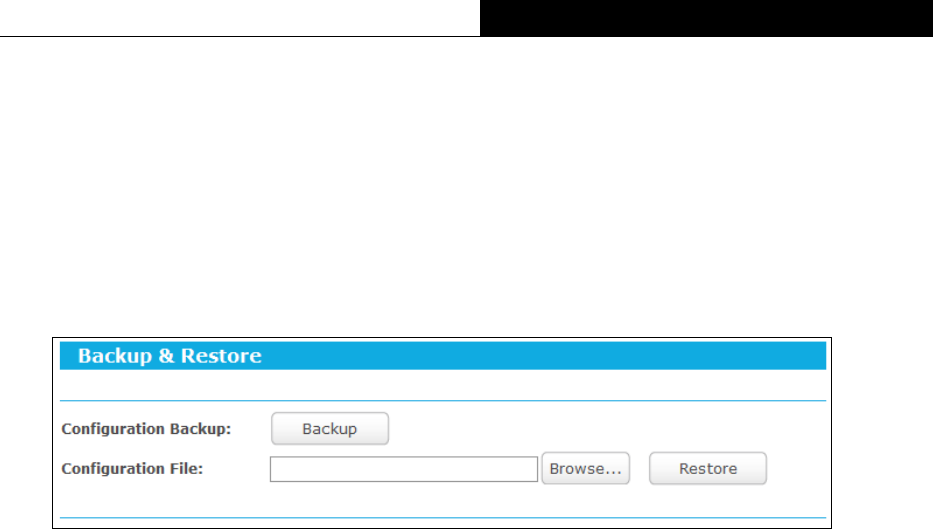
-99-
TL-WR841HP
300Mbps High Power Wireless N Router
Note:
All changed settings will be lost when defaults are restored.
3.4.20.2. Backup & Restore
Go to “Advanced→System Tools→Backup & Restore”, and then you can save the current
configuration of the router as a backup file and restore the configuration via a backup file as
shown in Figure 3-90.
Figure 3-90 Backup & Restore Configuration
Click the Backup button to save all configuration settings as a backup file in your local
computer.
To upgrade the router's configuration, follow these instructions.
Click the Browse button to find the configuration file which you want to restore.
Click the Restore button to update the configuration with the file whose path is the
one you have input or selected in the blank.
Note:
The current configuration will be covered with the uploading configuration file. Wrong process will
lead the device unmanaged. The restoring process lasts for 20 seconds and the router will restart
automatically then. Keep the power of the router on during the process, in case of any damage.
3.4.20.3. Reboot
Go to “Advanced→System Tools→Reboot”, and then you can reboot the router by clicking
the Reboot button or setting the auto reboot time.
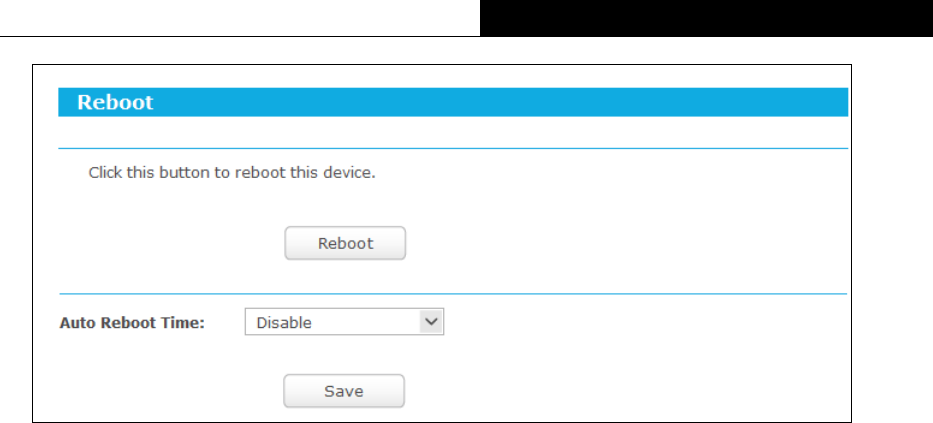
-100-
TL-WR841HP
300Mbps High Power Wireless N Router
Figure 3-91 Reboot the router
Click the Reboot button to reboot this device.Some settings of the router will take effect
only after rebooting, which include
Change the LAN IP Address (system will reboot automatically).
Change the DHCP Settings.
Change the Wireless configurations.
Change the Web Management Port.
Upgrade the firmware of the router (system will reboot automatically).
Restore the router's settings to factory defaults (system will reboot automatically).
Update the configuration with the file (system will reboot automatically.
Auto Reboot Time - Here you can also reboot the router in a specific time by setting the
Auto Reboot Time. There are two options: Disable and Schedule.
Disable: If you don’t want to use this function, please choose Disable
Schedule: If you want to reboot your router at a specific time, please select Schedule.
Day: Choose Everyday, or choose Select Days and select the certain day (days) to
reboot the router.
Time: Specify the time in HHMM format for auto reboot.
Some settings of this device will take effect only after rebooting, which include:
Change the LAN IP Address (system will reboot automatically).
Change the DHCP Settings.
Upgrade the firmware of this device (system will reboot automatically).
Restore this device's settings to the factory defaults (system will reboot automatically).
Update the configuration with the file (system will reboot automatically).
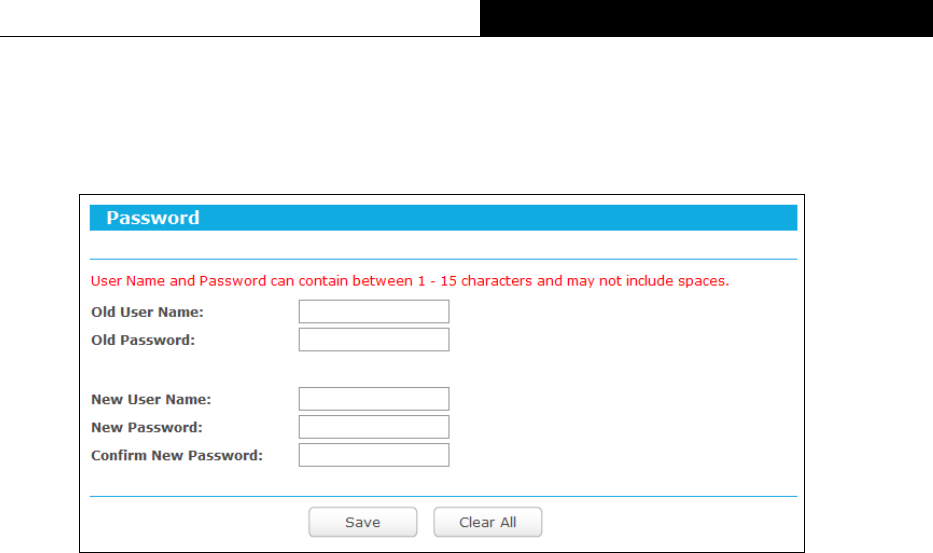
-101-
TL-WR841HP
300Mbps High Power Wireless N Router
3.4.20.4. Password
Go to “Advanced→System Tools→Password”, and then you can change the factory default
user name and password of the router in the next screen as shown in Figure 3-92.
Figure 3-92 Password
It is strongly recommended that you should change the factory default user name and password
of the router, because all users who try to access the router's Web-based utility or Quick Setup
will be prompted for the router's default user name and password.
Note:
The new user name and password must not exceed 15 characters in length and not include any
spaces. Enter the new Password twice to confirm it.
Click the Save button when finished.
Click the Clear All button to clear all.
3.4.20.5. System Log
Go to “Advanced→System Tools→System Log”, and then you can view the logs of the
router.
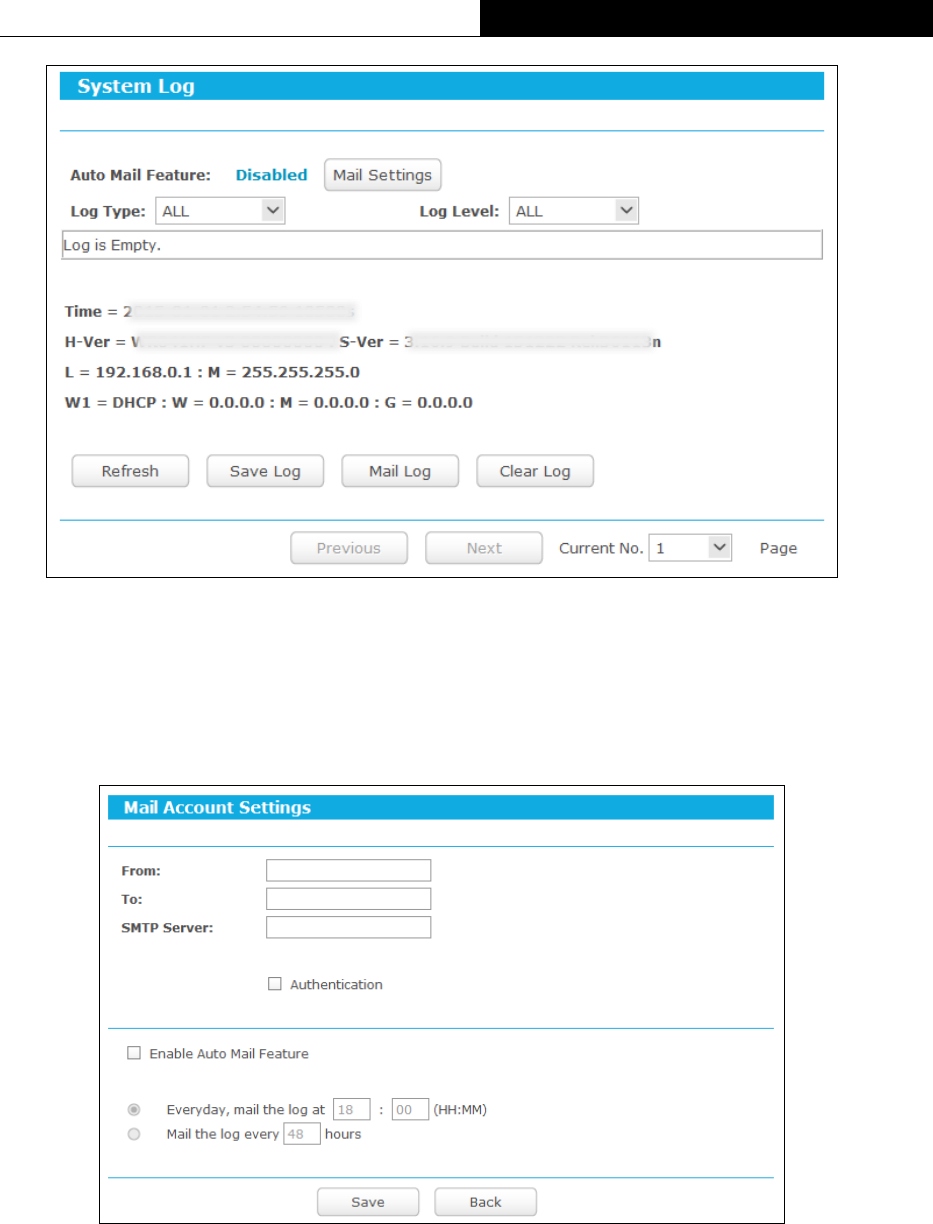
-102-
TL-WR841HP
300Mbps High Power Wireless N Router
Figure 3-93 System Log
Auto Mail Feature - Indicates whether auto mail feature is enabled or not.
Mail Settings - Set the receiving and sending mailbox address, server address, validation
information as well as the timetable for Auto Mail Feature, as shown in Figure 3-94.
Figure 3-94 Mail Account Settings
From - Your mail box address. The router would connect it to send logs.
To - Recipient’s address. The destination mailbox where the logs would be received.
SMTP Server - Your smtp server. It corresponds with the mailbox filled in the From
field. You can log on the relevant website for help if you are not clear with the address.

-103-
TL-WR841HP
300Mbps High Power Wireless N Router
Authentication - Most SMTP Server requires Authentication. It is required by most
mailboxes that need User Name and Password to log in.
Note:
Only when you select Authentication, do you have to enter the User Name and Password
in the following fields.
User Name - Your mail account name filled in the From field. The part behind @ is
included.
Password - Your mail account password.
Confirm The Password - Enter the password again to confirm.
Enable Auto Mail Feature - Select it to mail logs automatically. You could mail the
current logs either at a specified time every day or by intervals, but only one could be
the current effective rule. Enter the desired time or intervals in the corresponding field
as shown in Figure 3-94.
Click Save to keep your settings.
Click Back to return to the previous page.
Log Type - By selecting the log type, only logs of this type will be shown.
Log Level - By selecting the log level, only logs of this level will be shown.
Refresh - Refresh the page to show the latest log list.
Save Log - Click to save all the logs in a txt file.
Mail Log - Click to send an email of current logs manually according to the address and
validation information set in Mail Settings.
Clear Log - All the logs will be deleted from the router permanently, not just from the page.
Click the Next button to go to the next page, or click the Previous button to return to the
previous page.
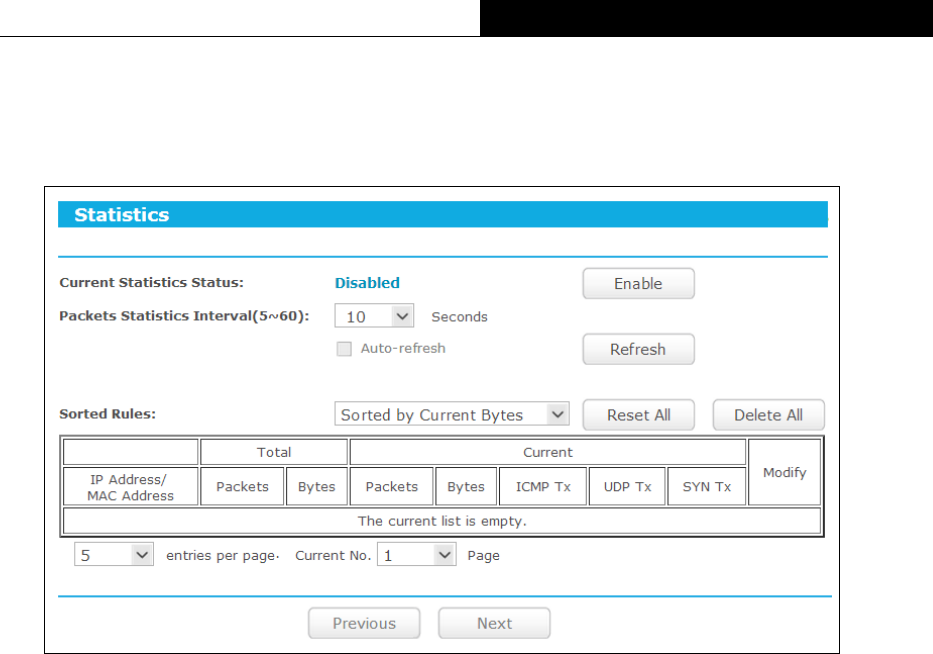
-104-
TL-WR841HP
300Mbps High Power Wireless N Router
3.4.20.6. Statistics
Go to “Advanced→System Tools→Statistics”, and then you can view the statistics of the
router, including total traffic and current traffic of the last Packets Statistic Interval.
Figure 3-95 Statistics
Current Statistics Status - Enable or Disable. The default value is disabled. To enable it,
click the Enable button. If it is disabled, the function of DoS protection in Security settings
will be disabled.
Packets Statistics Interval (5-60) - The default value is 10. Select a value between 5 and
60 seconds in the drop-down list. The Packets Statistic interval indicates the time section of
the packets statistic.
Sorted Rules - Choose how the displayed statistics are sorted.
Select the Auto-refresh checkbox to refresh automatically.
Click the Refresh button to refresh immediately.
Click Reset All to reset the values of all the entries to zero.
Click Delete All to delete all entries in the table.

-105-
TL-WR841HP
300Mbps High Power Wireless N Router
Statistics Table:
IP/MAC Address
The IP and MAC address are displayed with related statistics.
Total
Packets
The total number of packets received and transmitted by the router.
Bytes
The total number of bytes received and transmitted by the router.
Current
Packets
The total number of packets received and transmitted in the last Packets
Statistic interval seconds.
Bytes
The total number of bytes received and transmitted in the last Packets
Statistic interval seconds.
ICMP Tx
The number of the ICMP packets transmitted to WAN per second at the
specified Packets Statistics interval. It is shown like “current transmitting rate
/ Max transmitting rate”.
UDP Tx
The number of UDP packets transmitted to the WAN per second at the
specified Packets Statistics interval. It is shown like “current transmitting rate
/ Max transmitting rate”.
TCP
SYN Tx
The number of TCP SYN packets transmitted to the WAN per second at the
specified Packets Statistics interval. It is shown like “current transmitting rate
/ Max transmitting rate”.
Modify
Reset
Reset the value of the entry to zero.
Delete
Delete the existing entry in the table.
There would be 5 entries on each page. Click Previous to return to the previous page and Next
to the next page.
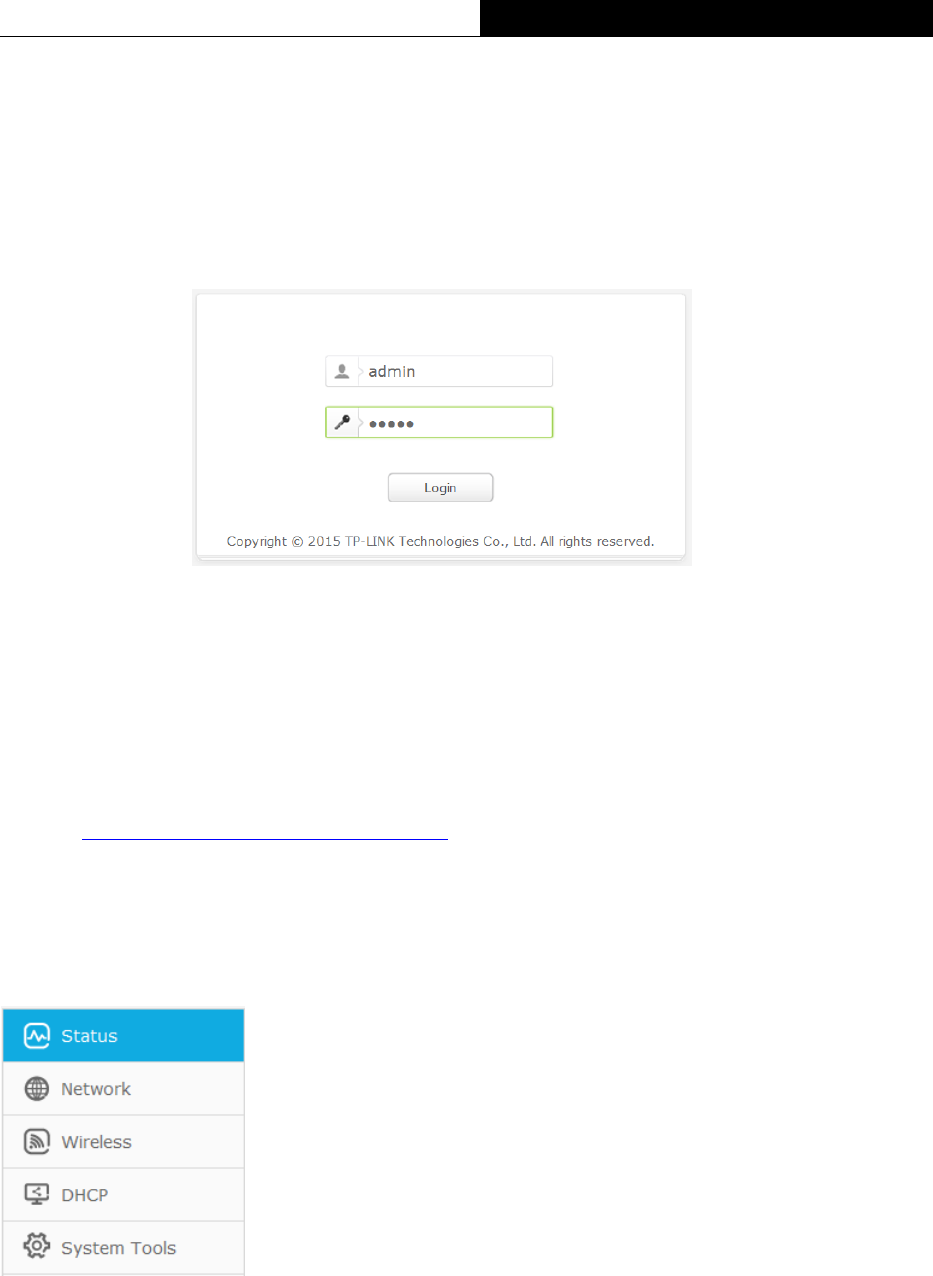
-106-
TL-WR841HP
300Mbps High Power Wireless N Router
Chapter 4. Range Extender Mode
4.1 Login and switch the working mode
Enter http://tplinkwifi.net in the address bar of a web browser. Use admin for both username
and password, and then click Login.
Figure 4-1 Login
After your successful login, you can either click the Mode button on the top-right corner of the
Web management page or press the RE button on the top panel of the router to switch the
working mode of the router to Range Extender.
4.2 Quick Setup
Refer to Range Extender->Option one configure
4.3 Setting
Click “Setting”, then you will see the main menus on the left of the Web Management Page. On
the right, there are the corresponding explanations and instructions.
The detailed explanations for each Web page’s key function are listed below.
4.3.1 Status
Go to “Setting→Status”, you can see the current status information about the router.
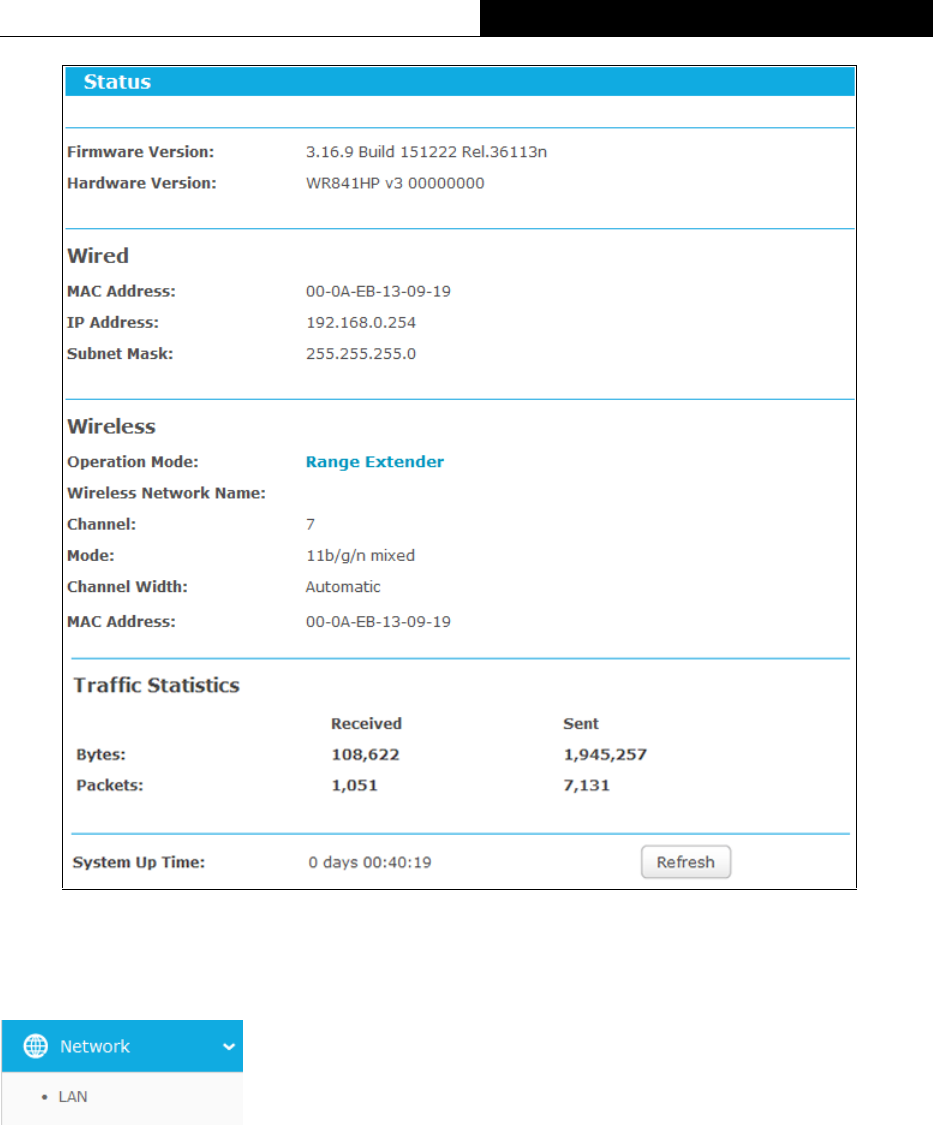
-107-
TL-WR841HP
300Mbps High Power Wireless N Router
Figure 4-2 status
4.3.2 Network
There is one submenu under the Network menu: LAN. Click it, and you will be able to configure
the corresponding function.
4.3.2.1. LAN
Go to “Setting→Network→LAN”, and then you can configure the IP parameters of LAN on this
page.
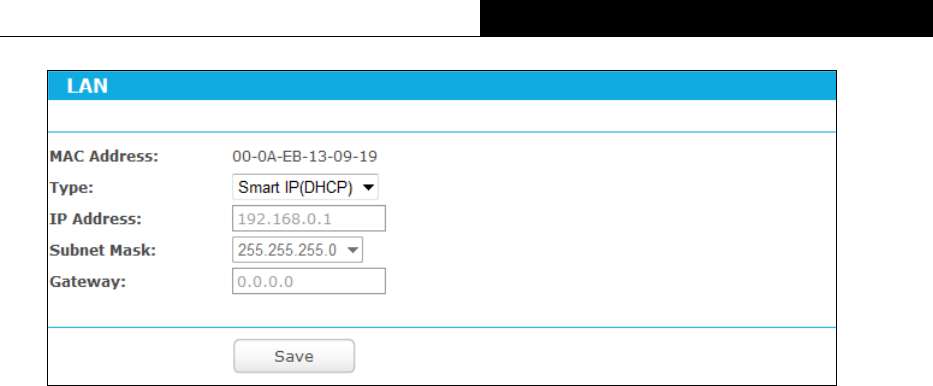
-108-
TL-WR841HP
300Mbps High Power Wireless N Router
Figure 4-3 LAN
MAC Address - The physical address of the LAN ports, as seen from the LAN. The value
can NOT be changed.
Type - Choosing Smart IP to get IP address from DHCP server, or choosing static IP to
configure IP address manually.
IP Address – If you have chosen the type of Static IP. You can set a new IP address of your
system here in dotted-decimal notation (factory default - 192.168.0.1).
Subnet Mask - An address code that determines the size of the network. Normally
255.255.255.0 is used as the subnet mask.
Gateway - The gateway should be in the same subnet as your IP address.
Click the Save button to save your settings.
Note:
If you change the IP address, you must use the new IP address to login the system.
If you select the type of Smart IP, the DHCP server in this device will not startup.
If the new IP address you set is not in the same subnet, the IP Address pool in the DHCP
server will not take effect, until they are re-configured.
This device will reboot automatically after you click the Save button.
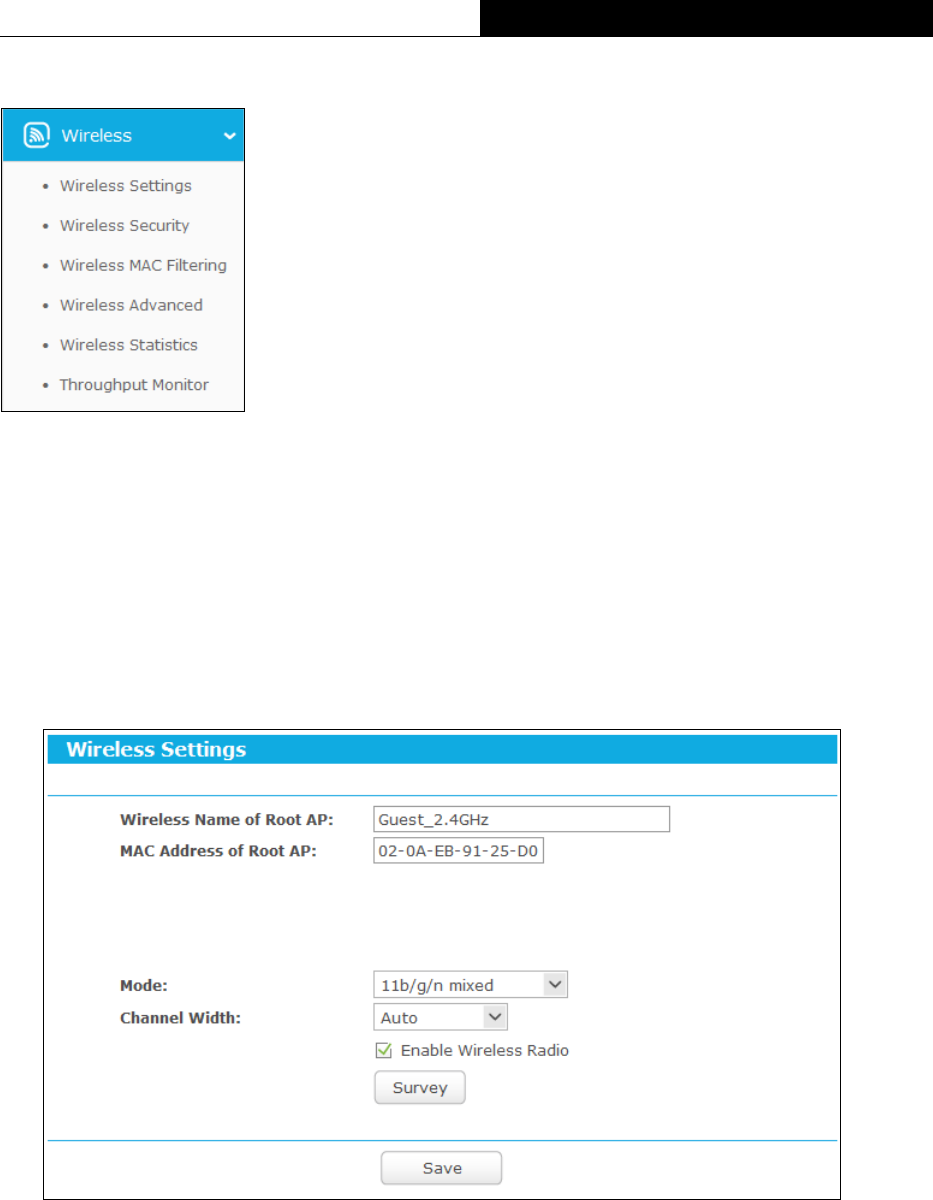
-109-
TL-WR841HP
300Mbps High Power Wireless N Router
4.3.3 Wireless
There are six submenus under the Wireless menu: Wireless Settings, Wireless Security,
Wireless Mac Filtering, Wireless Advanced, Wireless Statistics and Throughput Monitor.
Click any of them, and you will be able to configure the corresponding function. The detailed
explanations for each submenu are provided below.
4.3.3.1. Wireless Settings
Go to “Setting→Wireless→Wireless Settings”, and then you can configure the basic settings
of wireless network.
Figure 4-4 Wireless settings
Wireless Name of Remote AP - The SSID of the AP your device is going to connect to as
a client. You can also click the Survey button to search the AP to join, and then this field
will be filled automatically.
MAC Address of Remote AP - The MAC address of the AP your device is going to
connect to as a client. You can also click the Survey button to search the AP to join, and
then this field will be filled automatically.
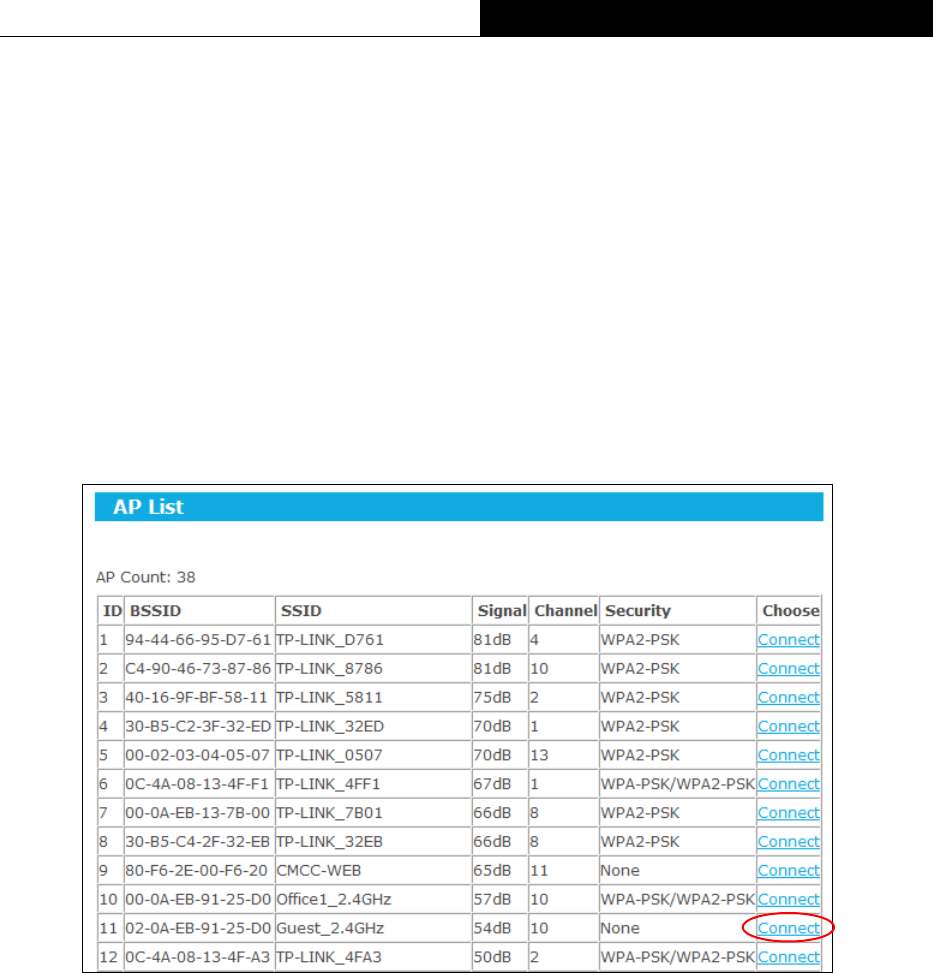
-110-
TL-WR841HP
300Mbps High Power Wireless N Router
Mode -This field determines the wireless mode which the AP works on.
Channel Width - The bandwidth of the wireless channel.
Enable Wireless Radio - The wireless radio of the AP can be enabled or disabled to allow
or deny wireless stations to access. If enabled, the wireless stations will be able to access
the AP, otherwise, wireless stations will not be able to access the AP.
Survey - Click this button, you can search the AP which runs in the environment.
Click Survey button on the Wireless page, and then AP List page will appear as shown below.
Find the SSID of the AP you want to access, and click Connect in the corresponding row. For
example, the eleventh item is selected. The target network’s SSID will be automatically filled into
the corresponding box which is shown as the last figure.
Figure 4-5 AP List
Be sure to click the Save button to save your settings on this page.
Note:
1. The operating distance or range of your wireless connection varies significantly based on
the physical placement of the Router. For best results, place your Router.
Near the center of the area in which your wireless stations will operate.
In an elevated location such as a high shelf.
Away from the potential sources of interference, such as PCs, microwaves, and
cordless phones.
Away from large metal surfaces.
2. Failure to follow these guidelines can result in significant performance degradation or
inability to wirelessly connect to the Router.
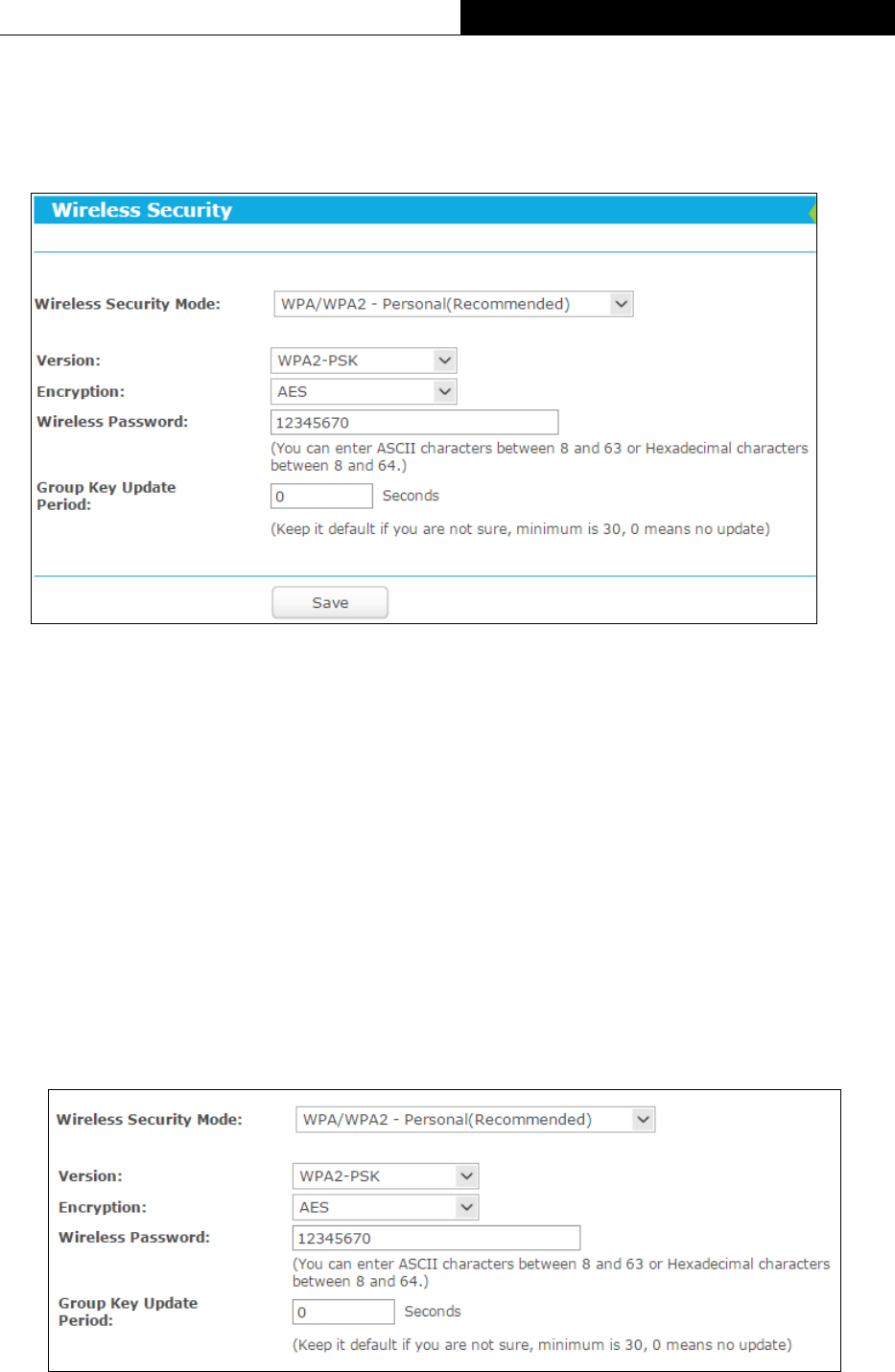
-111-
TL-WR841HP
300Mbps High Power Wireless N Router
4.3.3.2. Wireless Security
Go to “Setting→Wireless→Wireless security”, and then you can configure the security
settings of wireless network.
Figure 4-6 Wireless Security
There are three wireless security modes supported by the Router: WPA/WPA2-Personal and
WEP (Wired Equivalent Privacy). Each security option has its own settings as described
follows:
Disable Security
The wireless security function can be enabled or disabled. If disabled, the wireless stations will
be able to connect this device without encryption. It is recommended strongly that you choose
one of other options to enable security.
WPA/WPA2 - Personal
It’s the WPA/WPA2 authentication type based on pre-shared passphrase.
Figure 4-7 WPA/WPA2 - Personal
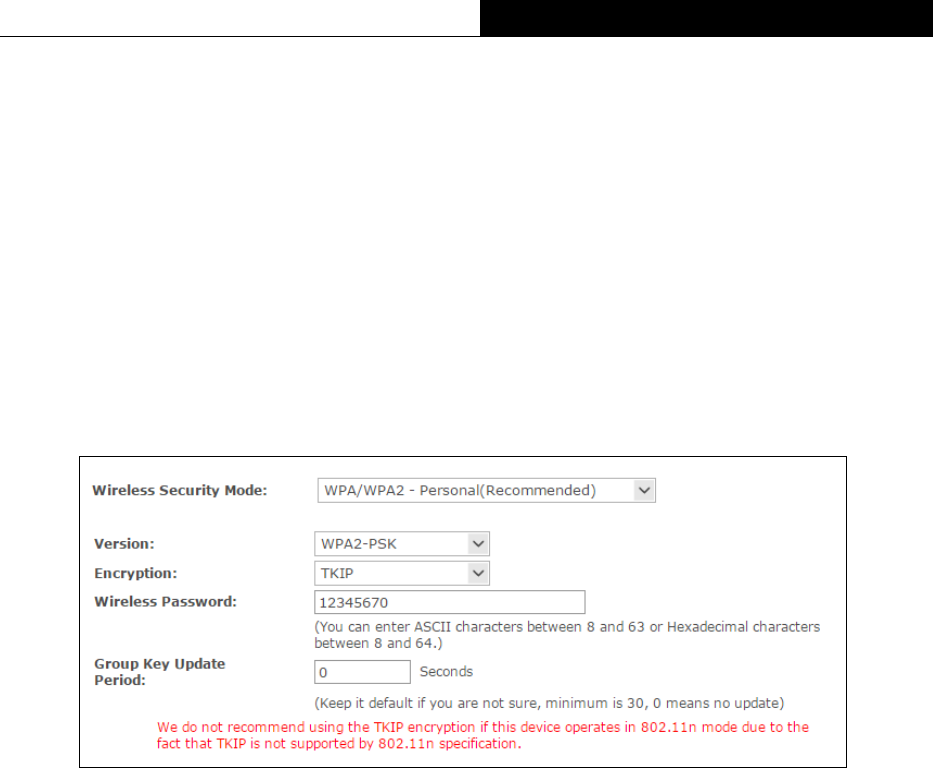
-112-
TL-WR841HP
300Mbps High Power Wireless N Router
Version - you can choose the version of the WPA-PSK security on the drop-down list. The
default setting is Automatic, which can select WPA-PSK (Pre-shared key of WPA) or
WPA2-PSK (Pre-shared key of WPA) automatically based on the wireless station's
capability and request.
Encryption - When WPA-PSK or WPA is set as the Authentication Type, you can select
either Automatic, or TKIP or AES as Encryption.
Note:
If you check the WPA/WPA2-Personal radio button and choose TKIP encryption, you will
find a notice in red as shown below.
Wireless Password - You can enter ASCII or Hexadecimal characters. For Hexadecimal,
the length should be between 8 and 64 characters; for ASCII, the length should be between
8 and 63 characters.
Group Key Update Period - Specify the group key update interval in seconds. The value
can be either 0 or at least 30. Enter 0 to disable the update.
Click the Save button to save your settings on this page
WEP
WEP is based on the IEEE 802.11 standard.
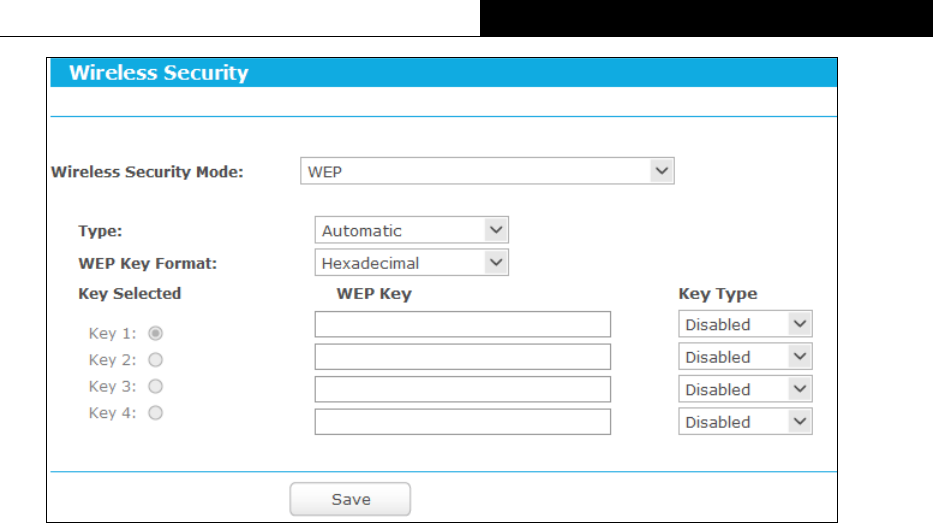
-113-
TL-WR841HP
300Mbps High Power Wireless N Router
Figure 4-8 WEP
Type - you can choose the type for the WEP security on the pull-down list. The default
setting is Automatic, which can select Shared Key or Open System authentication type
automatically based on the wireless station's capability and request.
WEP Key Format - Hexadecimal and ASCII formats are provided here. Hexadecimal
format stands for any combination of hexadecimal digits (0-9, a-f, A-F) in the specified
length. ASCII format stands for any combination of keyboard characters in the specified
length.
WEP Key (Password) - Select which of the four keys will be used and enter the matching
WEP key that you create. Make sure these values are identical on all wireless stations in
your network.
Key Type - You can select the WEP key length (64-bit, or 128-bit, or 152-bit.) for
encryption. "Disabled" means this WEP key entry is invalid.
64-bit - You can enter 10 hexadecimal digits (any combination of 0-9, a-f, A-F, zero key is
not promoted) or 5 ASCII characters.
128-bit - You can enter 26 hexadecimal digits (any combination of 0-9, a-f, A-F, zero key is
not promoted) or 13 ASCII characters.
152-bit - You can enter 32 hexadecimal digits (any combination of 0-9, a-f, A-F, zero key is
not promoted) or 16 ASCII characters.
Note:
If you do not set the key, the wireless security function is still disabled even if you have selected
Shared Key as Authentication Type.
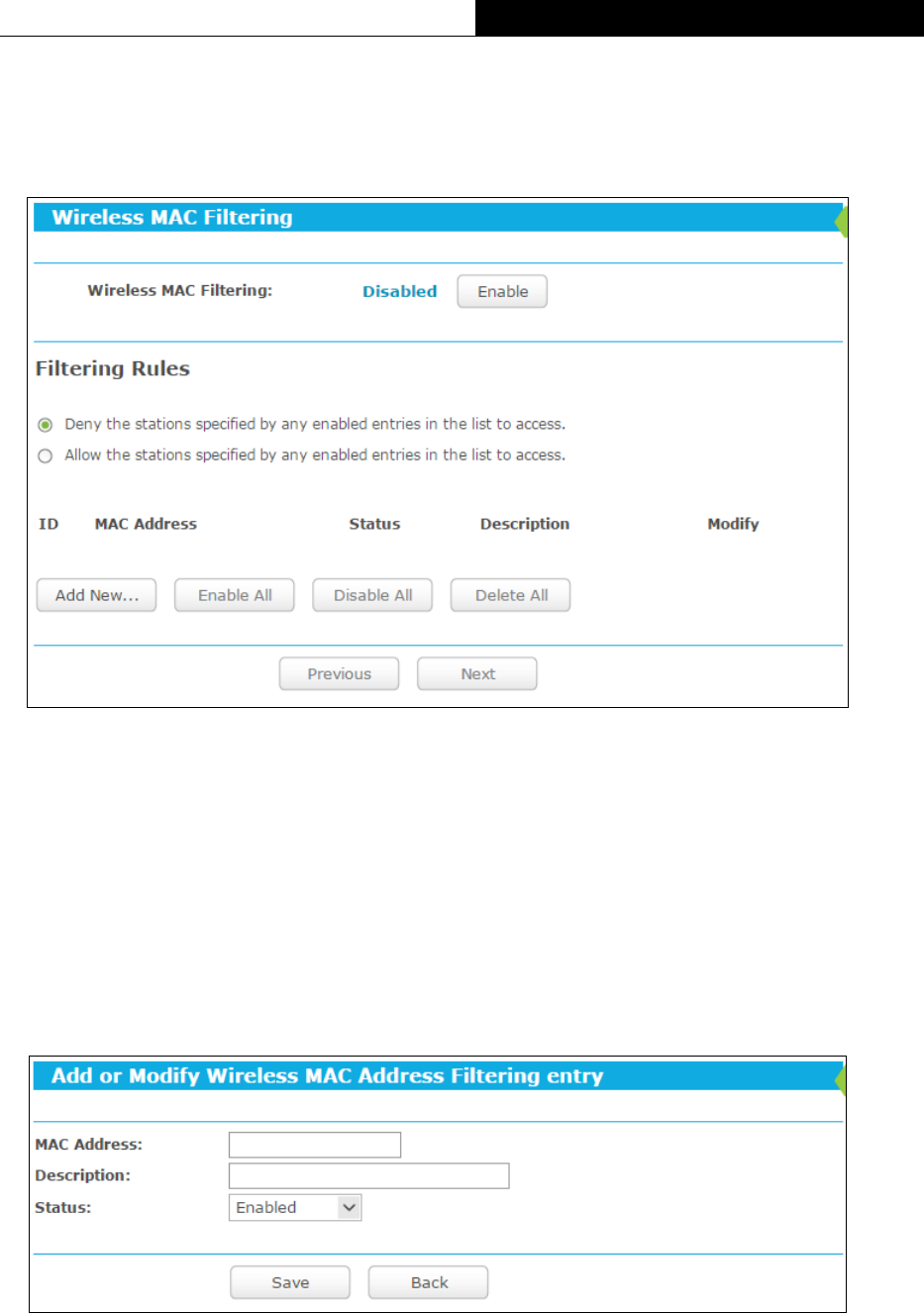
-114-
TL-WR841HP
300Mbps High Power Wireless N Router
4.3.3.3. Wireless MAC Filtering
Go to “Setting→Wireless→Wireless MAC Filtering”, and then you can control the wireless
access by configuring the Wireless MAC Filtering function.
Figure 4-9 Wireless MAC Filtering
To filter wireless users by MAC Address, click Enable. The default setting is Disabled.
MAC Address - The wireless station's MAC address that you want to access.
Status - The status of this entry, either Enabled or Disabled.
Description - A simple description of the wireless station.
To Add a Wireless MAC Address filtering entry, click the Add New… button. The "Add or
Modify Wireless MAC Address Filtering entry" page will appear.
Figure 4-10 Add and modify Wireless MAC Address Filtering entry
To add or modify a MAC Address Filtering entry, follow these instructions:
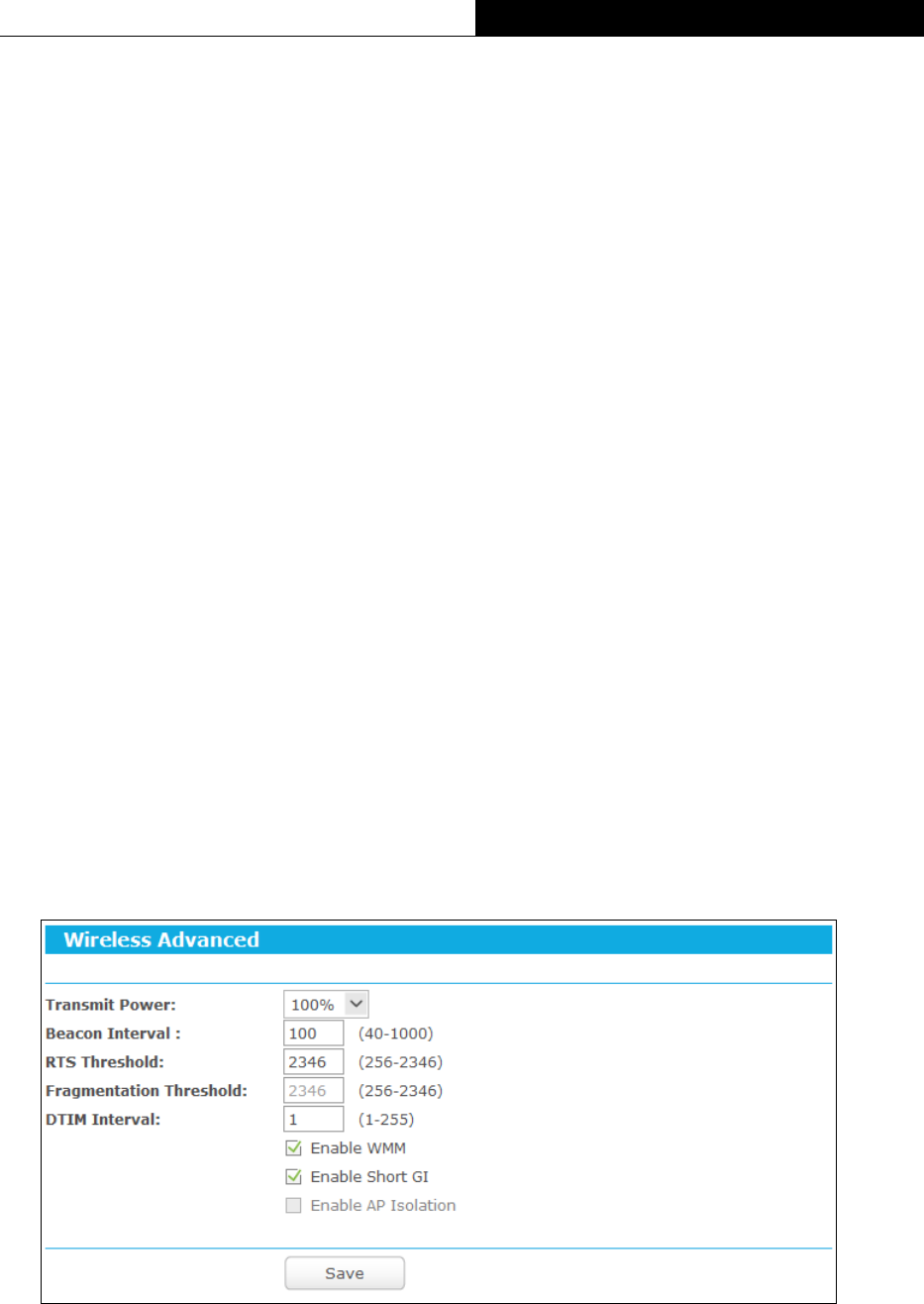
-115-
TL-WR841HP
300Mbps High Power Wireless N Router
1. Enter the appropriate MAC Address into the MAC Address field. The format of the MAC
Address is XX-XX-XX-XX-XX-XX (X is any hexadecimal digit). For example:
00-0A-EB-B0-00-0B.
2. Give a simple description for the wireless station in the Description field. For example:
Wireless station A.
3. Select Enabled or Disabled for this entry on the Status pull-down list.
4. Click the Save button to save this entry.
To modify or delete an existing entry:
1. Click the Modify in the entry you want to modify. If you want to delete the entry, click the
Delete.
2. Modify the information.
3. Click the Save button.
Click the Enable All button to make all entries enabled.
Click the Disable All button to make all entries disabled.
Click the Delete All button to delete all entries.
Click the Next button to go to the next page.
Click the Previous button to return to the previous page.
4.3.3.4. Wireless Advanced
Go to “Setting→Wireless→Wireless Advanced”, and then you can configure the advanced
settings of your wireless network.
Figure 4-11 Wireless Advanced
Transmit Power - Here you can specify the transmit power of Router. You can select
100%, 75% or 50% which you would like. 100% is the default setting and is
recommended.

-116-
TL-WR841HP
300Mbps High Power Wireless N Router
Beacon Interval - Enter a value between 40-1000 milliseconds for Beacon Interval here.
The beacons are the packets sent by the Router to synchronize a wireless network.
Beacon Interval value determines the time interval of the beacons. The default value is
100.
RTS Threshold - Here you can specify the RTS (Request to Send) Threshold. If the
packet is larger than the specified RTS Threshold size, the Router will send RTS frames
to a particular receiving station and negotiate the sending of a data frame. The default
value is 2346.
Fragmentation Threshold - This value is the maximum size determining whether
packets will be fragmented. Setting the Fragmentation Threshold too low may result in
poor network performance because of excessive packets. 2346 is the default setting and
is recommended.
DTIM Interval - This value determines the interval of the Delivery Traffic Indication
Message (DTIM). A DTIM field is a countdown field informing clients of the next window
for listening to broadcast and multicast messages. When the Router has buffered
broadcast or multicast messages for associated clients, it sends the next DTIM with a
DTIM Interval value. You can specify the value between 1-255 Beacon Intervals. The
default value is 1, which indicates the DTIM Interval is the same as Beacon Interval.
Enable WMM - WMM function can guarantee the packets with high-priority messages
being transmitted preferentially. It is strongly recommended enabled.
Enable Short GI - This function is recommended for it will increase the data capacity by
reducing the guard interval time.
Enable AP Isolation - This function isolate all connected wireless stations so that
wireless stations cannot access each other through WLAN. This function will be disabled if
WDS/Bridge is enabled.
Note:
If you are not familiar with the setting items in this page, it's strongly recommended to keep the
provided default values; otherwise it may result in lower wireless network performance.
4.3.3.5. Wireless Statistics
Go to “Setting→Wireless→Wireless Statistics”, and then you can see the MAC Address,
Current Status, Received Packets and Sent Packets for each connected wireless station.
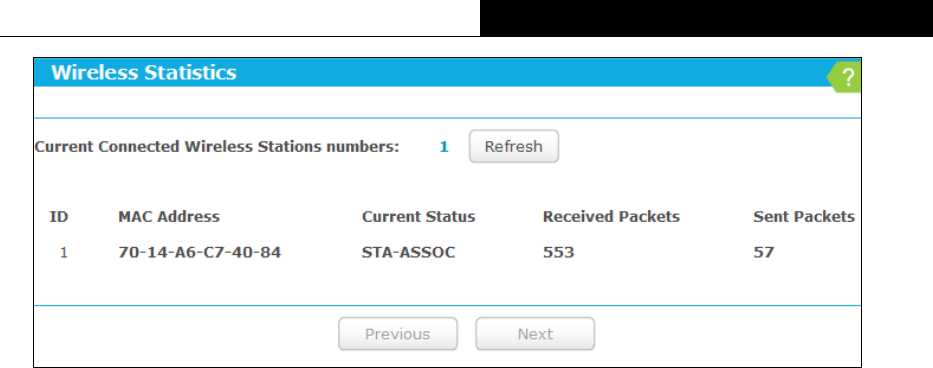
-117-
TL-WR841HP
300Mbps High Power Wireless N Router
Figure 4-12 Wireless Statistics
MAC Address - The connected wireless station's MAC address.
Current Status - The connected wireless station's running status, one of STA-AUTH /
STA-ASSOC / STA-JOINED / WPA / WPA-PSK / WPA2 / WPA2-PSK / AP-UP / AP-DOWN /
Disconnected.
Received Packets - Packets received by the station.
Sent Packets - Packets sent by the station.
Configure - The button is used for loading the item to the Wireless MAC Filtering list.
You cannot change any of the values on this page. To update this page and to show the
current connected wireless stations, click on the Refresh button.
If the numbers of connected wireless stations go beyond one page, click the Next button to go
to the next page and click the Previous button to return the previous page.
Note:
This page will be refreshed automatically every 5 seconds.
4.3.3.6. Throughput Monitor
Go to “Setting→Wireless→Throughput Monitor”, and then you can see watch wireless
throughput information.
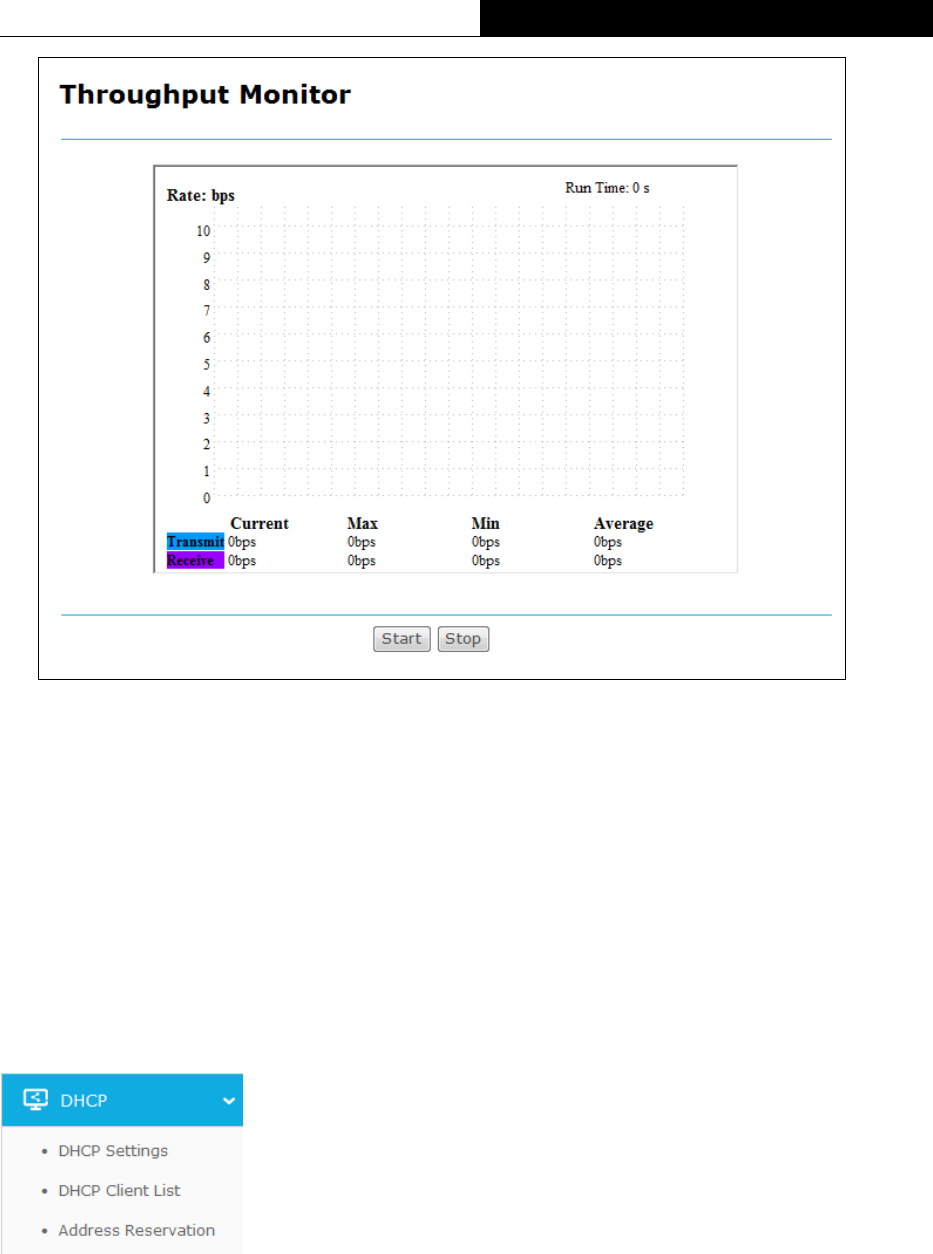
-118-
TL-WR841HP
300Mbps High Power Wireless N Router
Figure 4-13 Wireless Statistics
Rate - The Throughput unit.
Run Time – The time this function is running.
Transmit – Wireless transmit rate information.
Receive – Wireless receive rate information.
Click the Start button to start wireless throughput monitor.
Click the Stop button to start wireless throughput monitor.
4.3.4 DHCP
There are three submenus under the DHCP menu: DHCP Settings, DHCP Client List and
Address Reservation. Click any of them, and you will be able to configure the corresponding
function.
4.3.4.1. DHCP Settings
Go to “Setting→DHCP→DHCP Settings”, and then you can configure the DHCP Server on the
page as shown below. The Router is set up by default as a DHCP (Dynamic Host Configuration
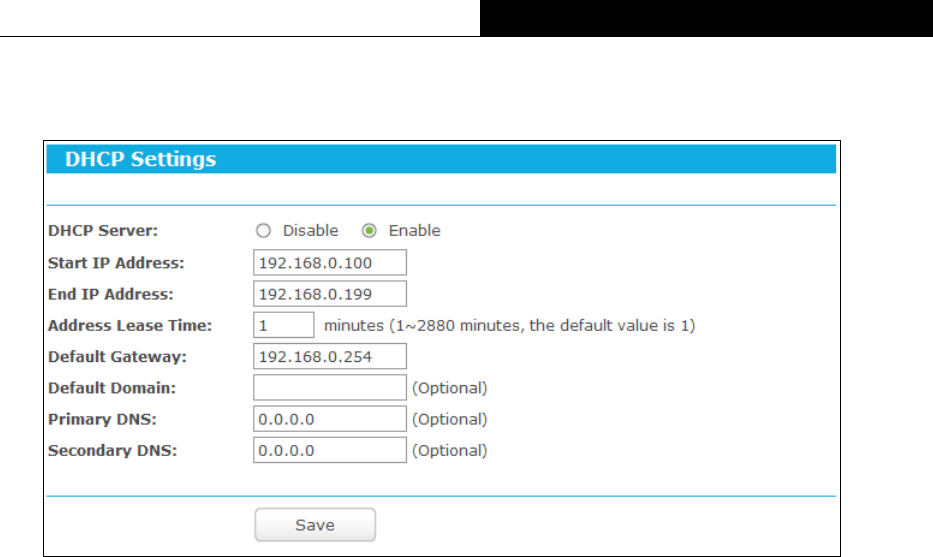
-119-
TL-WR841HP
300Mbps High Power Wireless N Router
Protocol) server, which provides the TCP/IP configuration for all the PC(s) that are connected to
the Router in the LAN.
Figure 4-14 DHCP Settings
DHCP Server - Enable or Disable the DHCP server. If you disable the Server, you must
have another DHCP server within your network or else you must configure the computer
manually.
Start IP Address - Specify an IP address for the DHCP Server to start with when
assigning IP addresses. 192.168.0.100 is the default start address.
End IP Address - Specify an IP address for the DHCP Server to end with when assigning
IP addresses. 192.168.0.199 is the default end address.
Address Lease Time - The Address Lease Time is the amount of time a network user
will be allowed connection to the Router with their current dynamic IP Address. Enter the
amount of time in minutes and the user will be "leased" this dynamic IP Address. After the
time is up, the user will be automatically assigned a new dynamic IP address. The range
of the time is 1 ~ 2880 minutes. The default value is 120 minutes.
Default Gateway (Optional) - It is suggested to input the IP address of the LAN port of the
Router. The default value is 192.168.0.254.
Default Domain (Optional) - Input the domain name of your network.
Primary DNS - (Optional) Input the DNS IP address provided by your ISP or consult your
ISP.
Secondary DNS (Optional) - Input the IP address of another DNS server if your ISP
provides two DNS servers.
Note:
1. To use the DHCP server function of the Router, you must configure all computers on the LAN
as "Obtain an IP Address automatically".
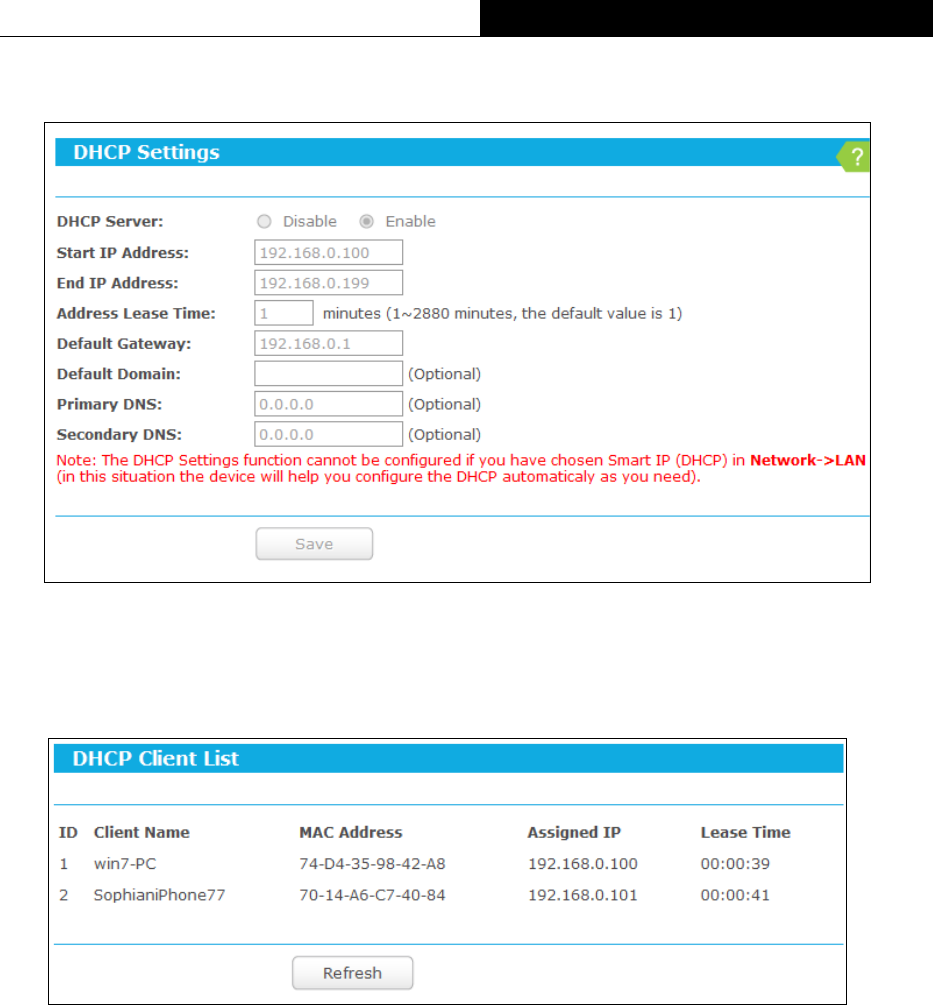
-120-
TL-WR841HP
300Mbps High Power Wireless N Router
2. When you choose the Smart IP (DHCP) mode in Network → LAN, the DHCP Server
function will be disabled. You will see the page as below.
4.3.4.2. DHCP Client List
Go to “Setting→DHCP→DHCP Client List”, and then you can view the information about the
clients attached to the Router.
Figure 4-15 DHCP Client List
Client Name - The name of the DHCP client.
MAC Address - The MAC address of the DHCP client.
Assigned IP - The IP address that the Router has allocated to the DHCP client.
Lease Time - The time of the DHCP client leased. After the dynamic IP address has
expired, a new dynamic IP address will be automatically assigned to the user.
You cannot change any of the values on this page. To update this page and to show the
current attached devices, click the Refresh button.
4.3.4.3. Address Reservation
Go to “Setting→DHCP→Address Reservation”, and then you can view and add a reserved
address for clients. When you specify a reserved IP address for a PC on the LAN, that PC will
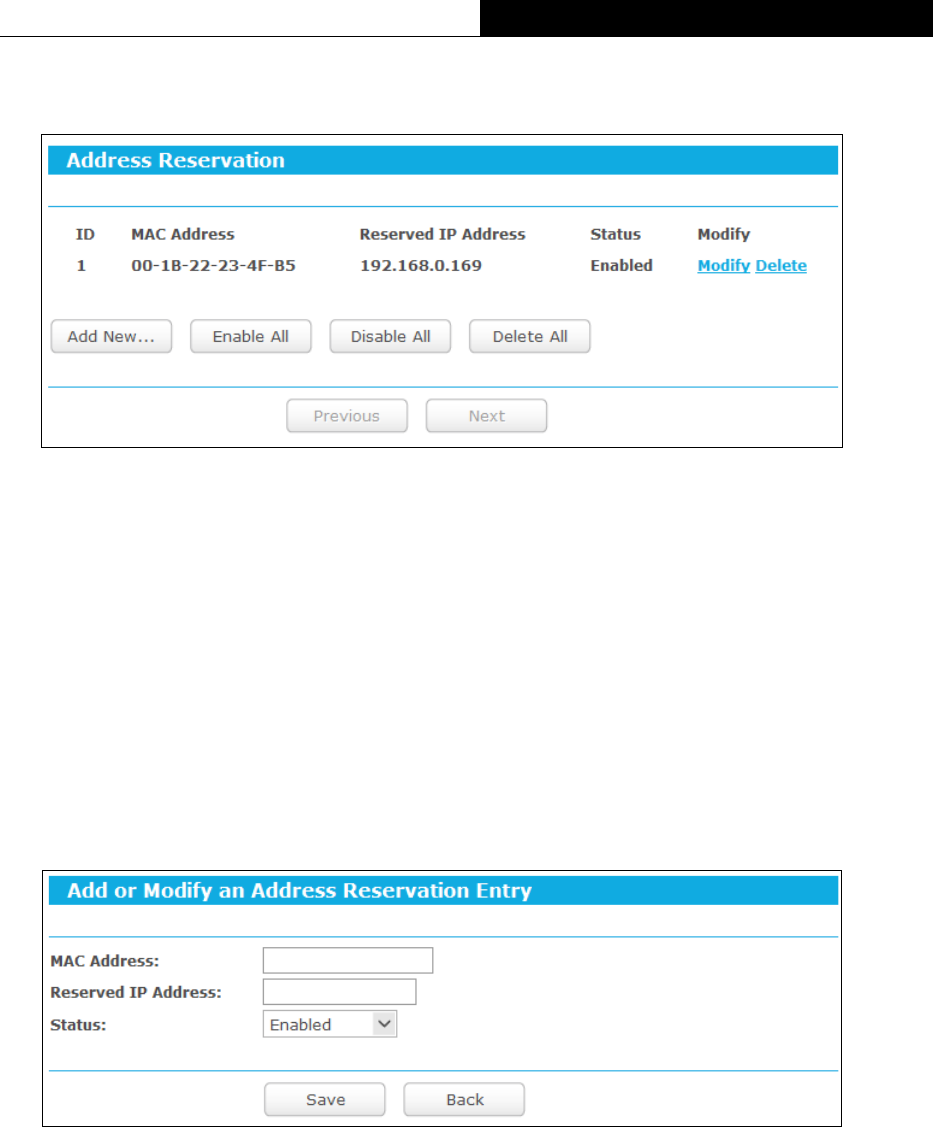
-121-
TL-WR841HP
300Mbps High Power Wireless N Router
always receive the same IP address each time when it accesses the DHCP server. Reserved IP
addresses should be assigned to the servers that require permanent IP settings.
Figure 4-16 Address Reservation
MAC Address - The MAC address of the PC for which you want to reserve an IP address.
Reserved IP Address - The IP address reserved for the PC by the Router.
Status - The status of this entry either Enabled or Disabled.
Modify - To modify or delete an existing entry.
To Reserve an IP address:
1. Click the Add New… button. Then Figure 6-24 will pop-up.
2. Enter the MAC address (in XX-XX-XX-XX-XX-XX format) and IP address (in
dotted-decimal notation) of the computer for which you want to reserve an IP address.
3. Click the Save button.
Figure 4-17 Add or Modify an Address Reservation Entry
To modify or delete an existing entry:
1. Click the Modify in the entry you want to modify. If you want to delete the entry, click the
Delete.
2. Modify the information.
3. Click the Save button.
Click the Enable/Disable All button to make all entries enabled/disabled.
Click the Delete All button to delete all entries.
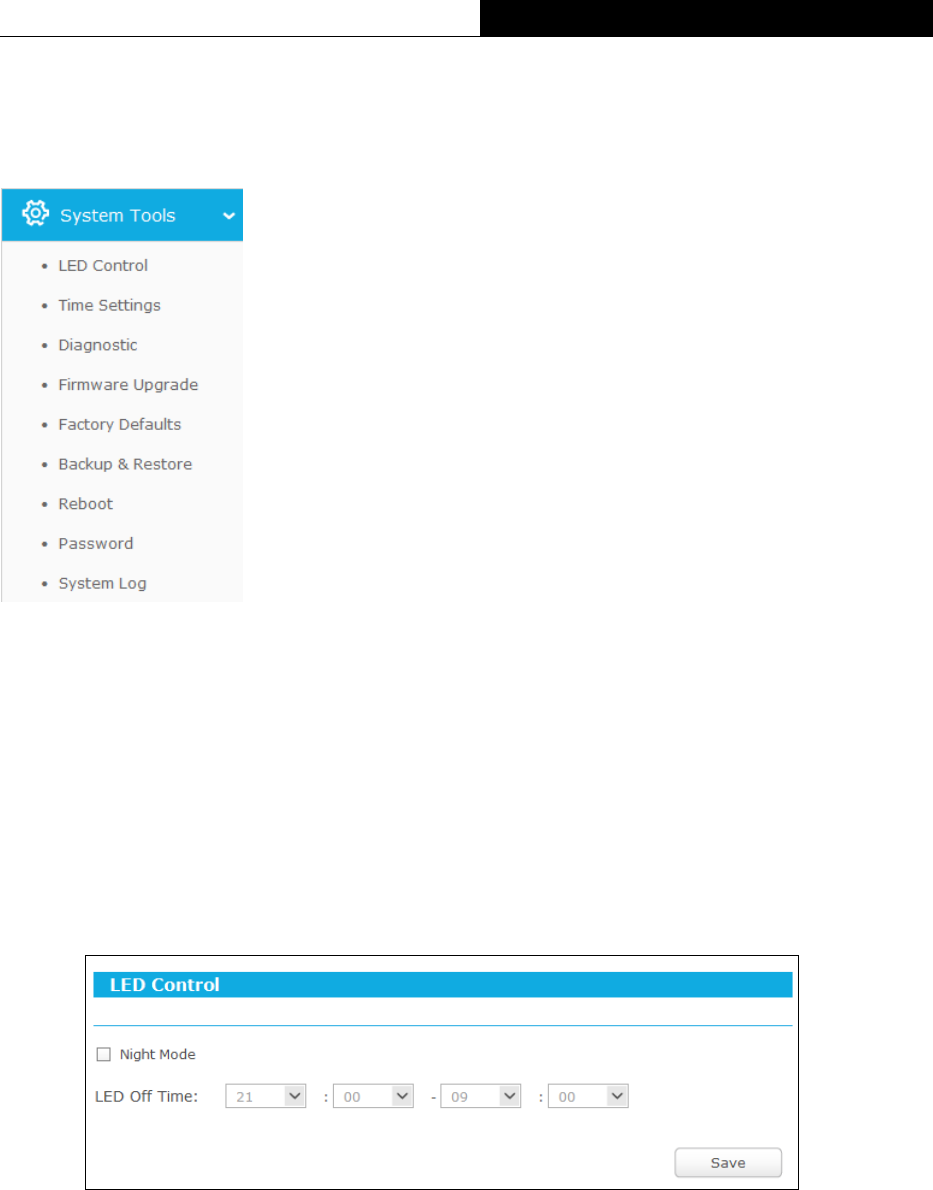
-122-
TL-WR841HP
300Mbps High Power Wireless N Router
Click the Next button to go to the next page and Click the Previous button to return the
previous page.
4.3.5 System Tools
Go to “System Tools”, and then you can see the submenus under the main menu: LED
Control, Time settings, Diagnostic, Firmware Upgrade, Factory Defaults, Backup &
Restore, Reboot, Password and System Log. Click any of them, and you will be able to
configure the corresponding function. The detailed explanations for each submenu are provided
below.
4.3.5.1. LED Control
Go to “Setting→System Tools→LED Control”, and then you can turn On or Off the LEDs on
your router according to a specific time schedule.
Figure 4-18 LED Control
Night Mode - Indicates whether the Night Mode is On (enabled) or Off (disabled).
LED Off Time - Select the time schedule to turn off LEDs.
4.3.5.2. Time Settings
Go to “Setting→System Tools→Time Settings”, and then you can configure the time.
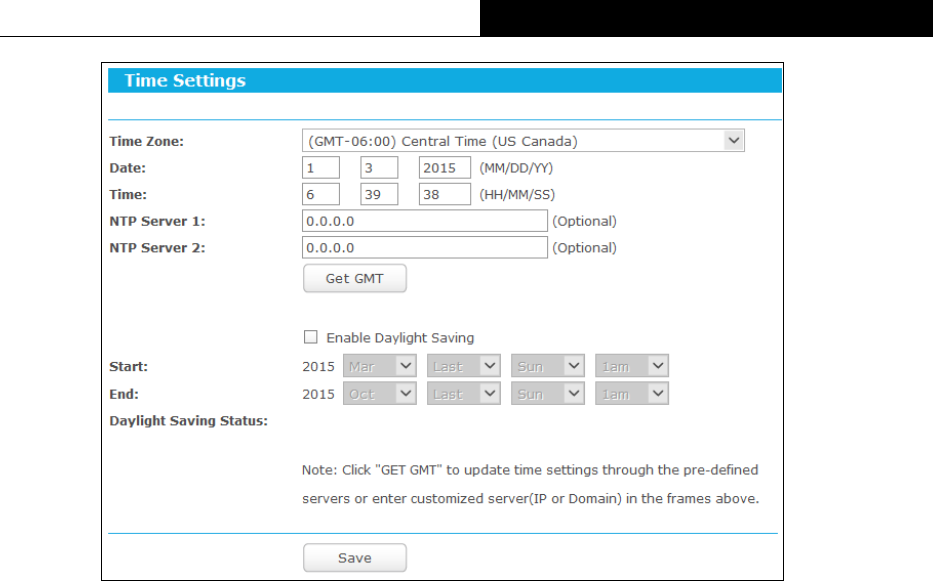
-123-
TL-WR841HP
300Mbps High Power Wireless N Router
Figure 4-19 Time settings
Time Zone - Select your local time zone from this pull down list.
Date - Enter your local date in MM/DD/YY into the right blanks.
Time - Enter your local time in HH/MM/SS into the right blanks.
NTP Server I / NTP Server II - Enter the address or domain of the NTP Server I or NTP
Server II, and then the router will get the time from the NTP Server preferentially. In
addition, the router built-in some common NTP Servers, so it can get time automatically
once it connects the Internet.
Enable Daylight Saving - Check the box to enable the Daylight Saving function.
Start - The time to start the Daylight Saving. Select the month in the first field, the week in
the second field, the day in the third field and the time in the last field.
End - The time to end the Daylight Saving. Select the month in the first field, the week in
the second field, the day in the third field and the time in the last field.
Daylight Saving Status - Displays the status whether the Daylight Saving is in use.
To set time manually:
1. Select your local time zone.
2. Enter the Date in Month/Day/Year format.
3. Enter the Time in Hour/Minute/Second format.
4. Click Save.
To set time automatically:
1. Select your local time zone.
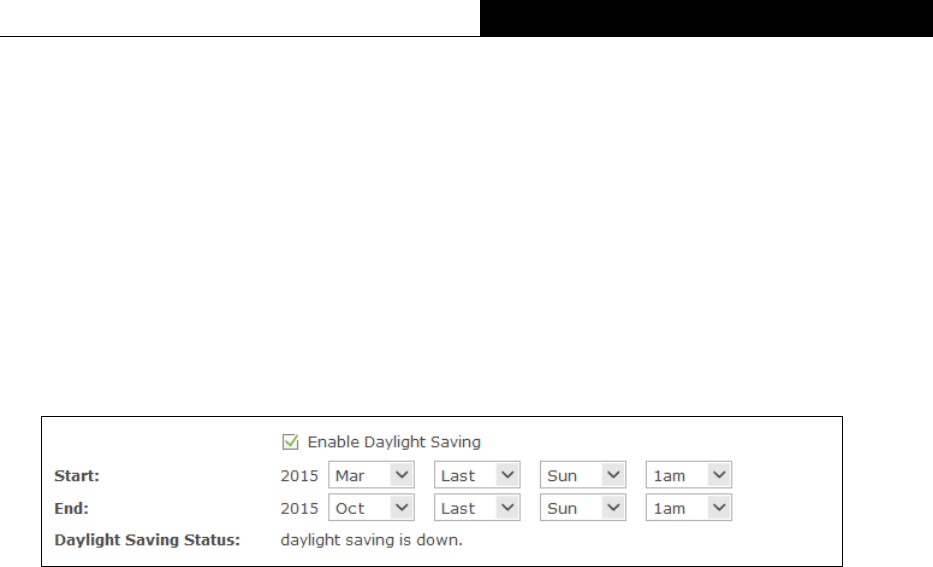
-124-
TL-WR841HP
300Mbps High Power Wireless N Router
2. Enter the address or domain of the NTP Server I or NTP Server II.
3. Click the Get GMT button to get system time from Internet if you have connected to the
Internet.
To set Daylight Saving:
1. Check the box to enable Daylight Saving.
2. Select the start time from the drop-down lists in the Start field.
3. Select the end time from the drop-down lists in the End field.
4. Click the Save button to save the settings.
Figure 4-20 Time settings
Note:
1) This setting will be used for some time-based functions such as firewall. You must specify
your time zone once you login to the router successfully; otherwise, these functions will not
take effect.
2) The time will be lost if the router is turned off.
3) The router will automatically obtain GMT from the Internet if it is configured accordingly.
4) The Daylight Saving will take effect one minute after the configurations are completed.
4.3.5.3. Diagnostic
Go to “Setting→System Tools→Diagnostic”, and then you can transact Ping or Traceroute
function to check connectivity of your network in the following screen.
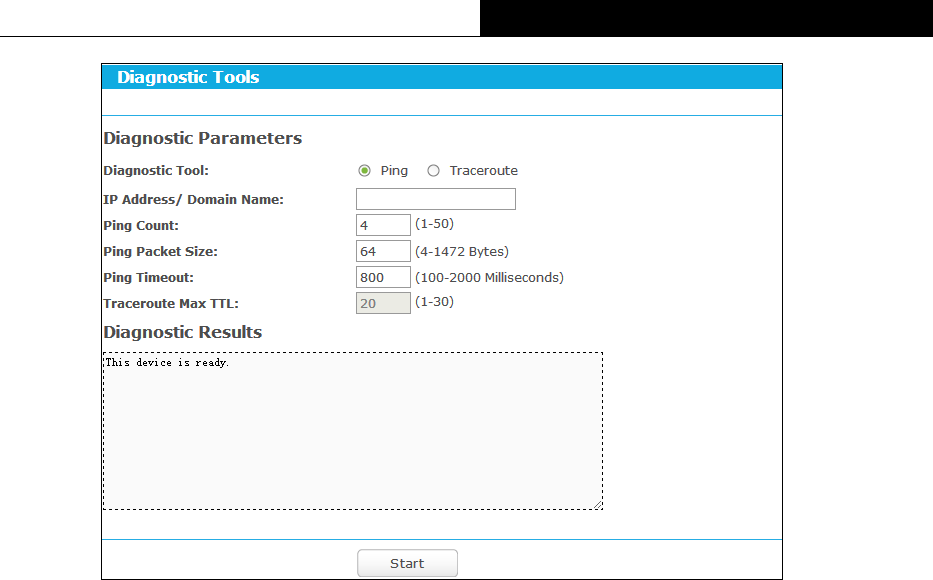
-125-
TL-WR841HP
300Mbps High Power Wireless N Router
Figure 4-21 Diagnostic Tools
Diagnostic Tool - Check the radio button to select one diagnostic too.
Ping - This diagnostic tool troubleshoots connectivity, reachability, and name
resolution to a given host or gateway.
Traceroute - This diagnostic tool tests the performance of a connection.
Note:
You can use ping/traceroute to test both numeric IP address or domain name. If
pinging/tracerouting the IP address is successful, but pinging/tracerouting the domain
name is not, you might have a name resolution problem. In this case, ensure that the
domain name you are specifying can be resolved by using Domain Name System (DNS)
queries.
IP Address/Domain Name - Enter the IP Address or Domain Name of the PC whose
connection you wish to diagnose.
Pings Count - Specifies the number of Echo Request messages sent. The default is 4.
Ping Packet Size - Specifies the number of data bytes to be sent. The default is 64.
Ping Timeout - Time to wait for a response, in milliseconds. The default is 800.
Traceroute Max TTL - Set the maximum number of hops (max TTL to be reached) in the
path to search for the target (destination). The default is 20.
Click Start to check the connectivity of the Internet.
The Diagnostic Results page displays the result of diagnosis.
If the result is similar to the following screen, the connectivity of the Internet is fine.
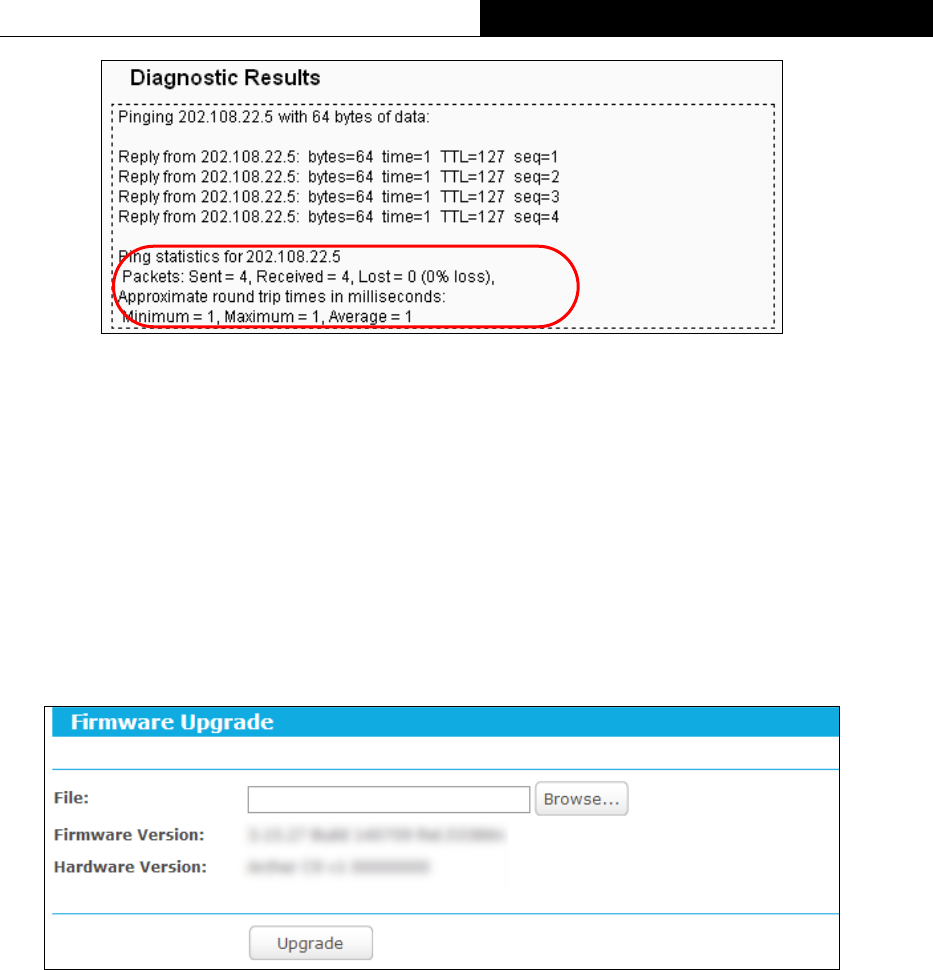
-126-
TL-WR841HP
300Mbps High Power Wireless N Router
Figure 4-22 Diagnostic Results
Note:
1. Only one user can use the diagnostic tools at one time.
2. "Ping Count", "Ping Packet Size" and "Ping Timeout" are Ping Parameters, and
"Traceroute Max TTL" is Traceroute Parameter.
4.3.5.4. Firmware Upgrade
Go to “Setting→System Tools→Firmware Upgrade”, and then you can update the latest
version of firmware for the router.
Figure 4-23 Firmware Upgrade
Firmware Version - Displays the current firmware version.
Hardware Version - Displays the current hardware version. The hardware version of the
upgrade file must accord with the router’s current hardware version.
To upgrade the router's firmware, follow these instructions below:
1. Download a most recent firmware upgrade file from our website (www.tp-link.com).
2. Enter or select the path name where you save the downloaded file on the computer into the
File blank.
3. Click the Upgrade button.
4. The router will reboot while the upgrading has been finished.
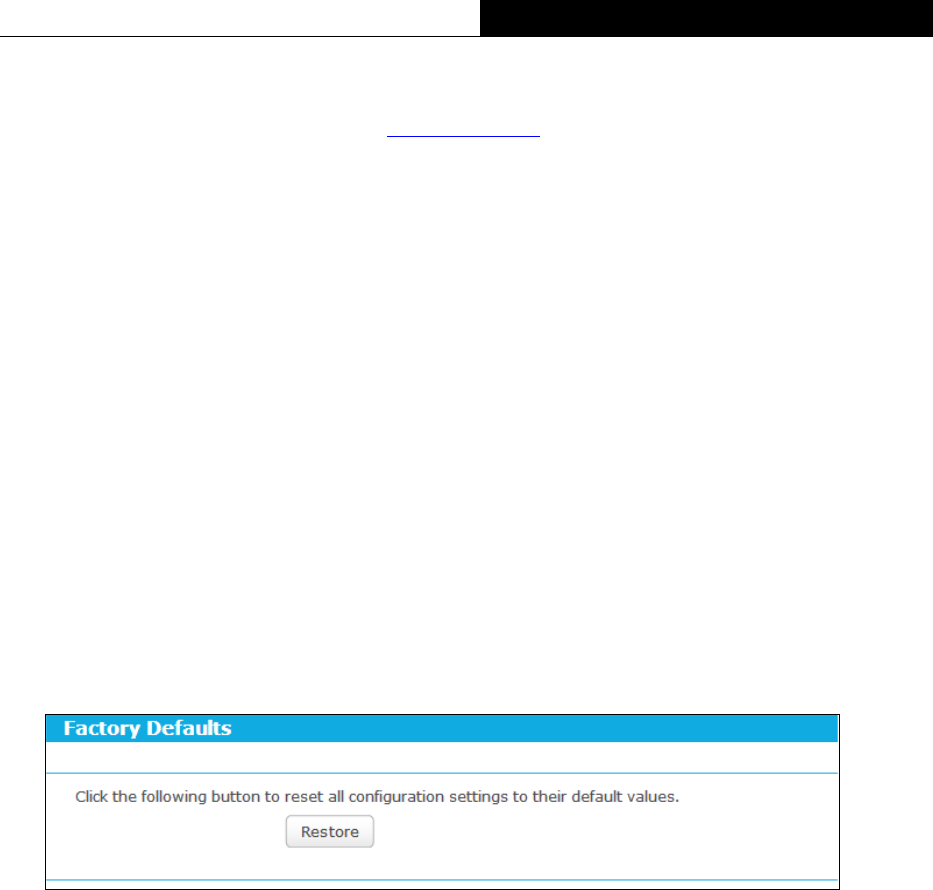
-127-
TL-WR841HP
300Mbps High Power Wireless N Router
Note:
1) New firmware versions are posted at www.tp-link.com and can be downloaded for free. There
is no need to upgrade the firmware unless the new firmware has a new feature you want to
use. However, when experiencing problems caused by the router rather than the
configuration, you can try to upgrade the firmware.
2) When you upgrade the router's firmware, you may lose its current configurations, so before
upgrading the firmware please write down some of your customized settings to avoid losing
important settings.
3) Do not turn off the router or press the Reset button while the firmware is being upgraded.
Loss of power during the upgrade could damage the router.
4) The firmware version must correspond to the hardware.
5) The upgrade process takes a few moments and the router restarts automatically when the
upgrade is complete.
4.3.5.5. Factory Defaults
Go to “Setting→System Tools→Factory Defaults”, and then and you can restore the
configurations of the router to factory defaults.
Figure 4-24 Restore Factory Default
Click the Restore button to reset all configuration settings to their default values.
The default User Name: admin
The default Password: admin
The default Subnet Mask: 255.255.255.0
Note:
All changed settings will be lost when defaults are restored.
4.3.5.6. Backup & Restore
Go to “Setting→System Tools→Backup & Restore”, and then you can save the current
configuration of the router as a backup file and restore the configuration via a backup file.
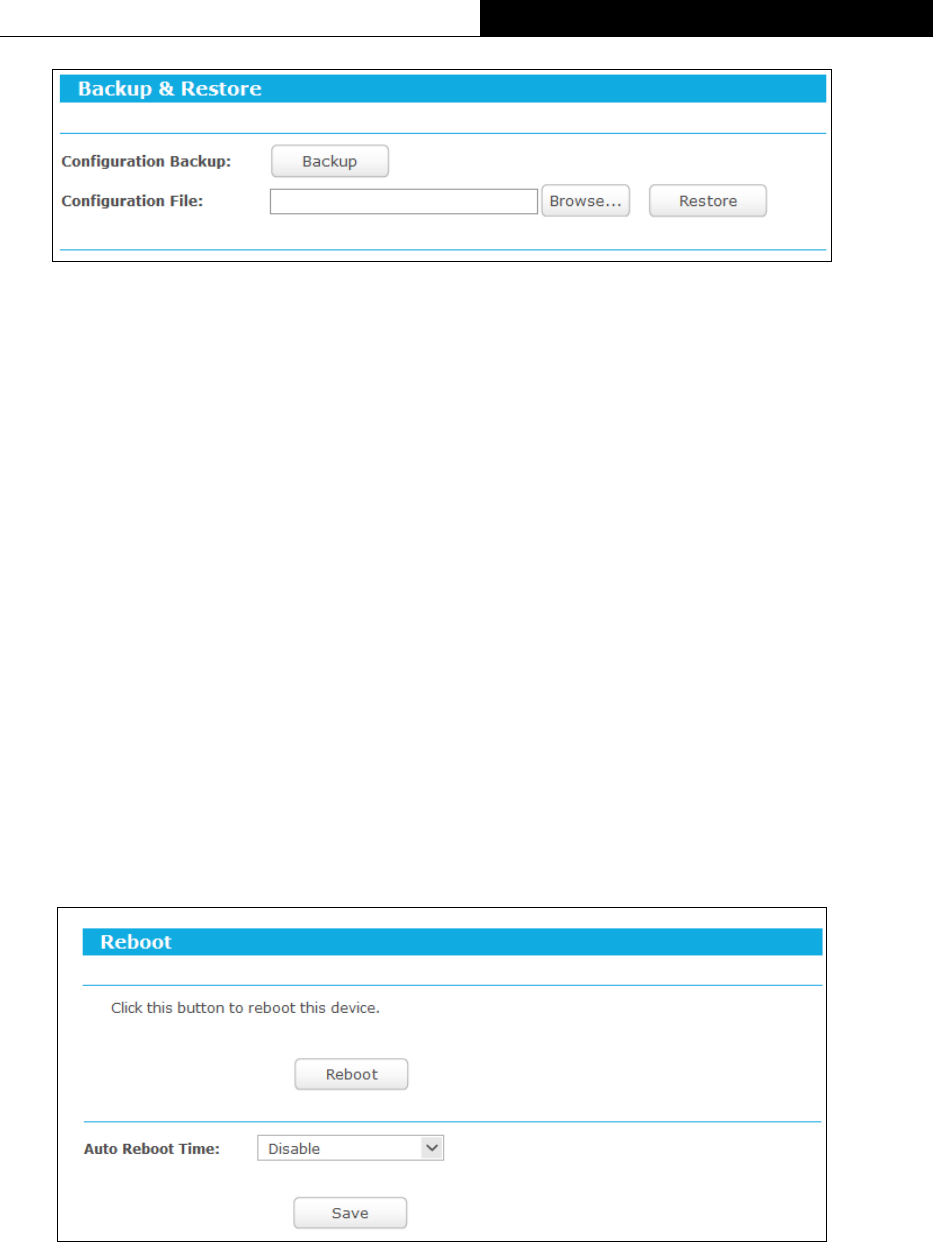
-128-
TL-WR841HP
300Mbps High Power Wireless N Router
Figure 4-25 Backup & Restore Configuration
Click the Backup button to save all configuration settings as a backup file in your local
computer.
To upgrade the router's configuration, follow these instructions.
Click the Browse button to find the configuration file which you want to restore.
Click the Restore button to update the configuration with the file whose path is the
one you have input or selected in the blank.
Note:
The current configuration will be covered with the uploading configuration file. Wrong process will
lead the device unmanaged. The restoring process lasts for 20 seconds and the router will restart
automatically then. Keep the power of the router on during the process, in case of any damage.
4.3.5.7. Reboot
Go to “Setting→System Tools→Reboot”, and then you can reboot the router by clicking the
Reboot button or setting the auto reboot time.
Figure 4-26 Reboot the router
Click the Reboot button to reboot this device.Some settings of the router will take effect
only after rebooting, which include
Change the LAN IP Address (system will reboot automatically).
Change the DHCP Settings.
Change the Wireless configurations.
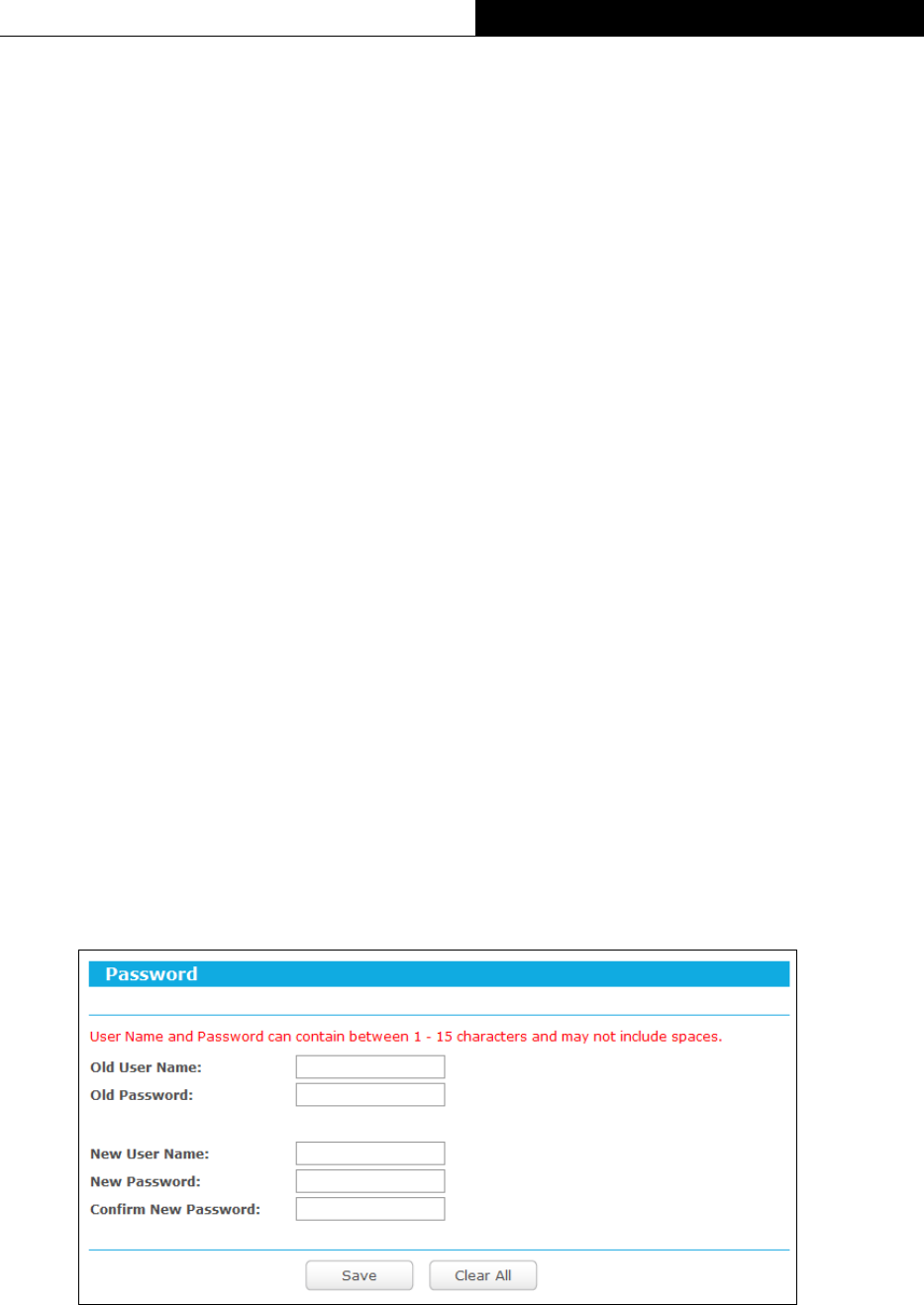
-129-
TL-WR841HP
300Mbps High Power Wireless N Router
Change the Web Management Port.
Upgrade the firmware of the router (system will reboot automatically).
Restore the router's settings to factory defaults (system will reboot automatically).
Update the configuration with the file (system will reboot automatically.
Auto Reboot Time - Here you can also reboot the router in a specific time by setting the
Auto Reboot Time. There are two options: Disable and Schedule.
Disable: If you don’t want to use this function, please choose Disable
Schedule: If you want to reboot your router at a specific time, please select Schedule.
Day: Choose Everyday, or choose Select Days and select the certain day (days) to
reboot the router.
Time: Specify the time in HHMM format for auto reboot.
Some settings of this device will take effect only after rebooting, which include:
Change the LAN IP Address (system will reboot automatically).
Change the DHCP Settings.
Upgrade the firmware of this device (system will reboot automatically).
Restore this device's settings to the factory defaults (system will reboot automatically).
Update the configuration with the file (system will reboot automatically).
4.3.5.8. Password
Go to “Setting→System Tools→Password”, and then you can change the factory default user
name and password of the router.
Figure 4-27 Password
It is strongly recommended that you should change the factory default user name and password
of the router, because all users who try to access the router's Web-based utility or Quick Setup
will be prompted for the router's default user name and password.
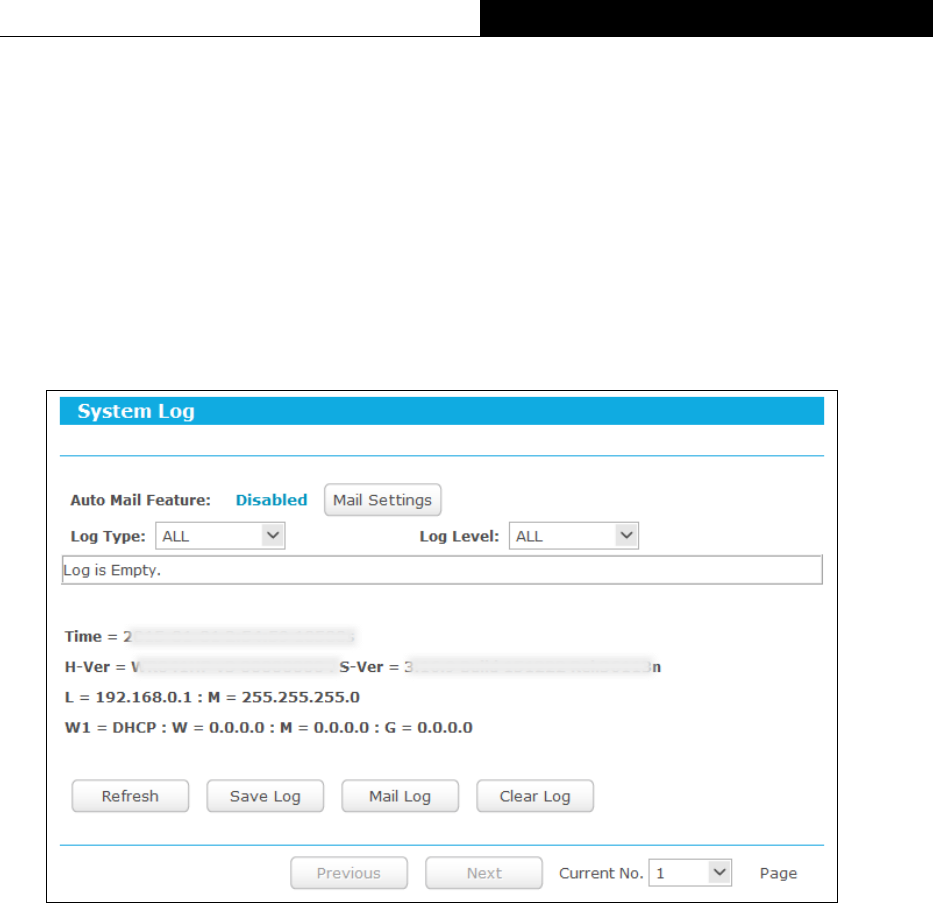
-130-
TL-WR841HP
300Mbps High Power Wireless N Router
Note:
The new user name and password must not exceed 15 characters in length and not include any
spaces. Enter the new Password twice to confirm it.
Click the Save button when finished.
Click the Clear All button to clear all.
4.3.5.9. System Log
Go to “Setting→System Tools→System Log”, and then you can view the logs of the router.
Figure 4-28 System Log
Auto Mail Feature - Indicates whether auto mail feature is enabled or not.
Mail Settings - Set the receiving and sending mailbox address, server address, validation
information as well as the timetable for Auto Mail Feature.
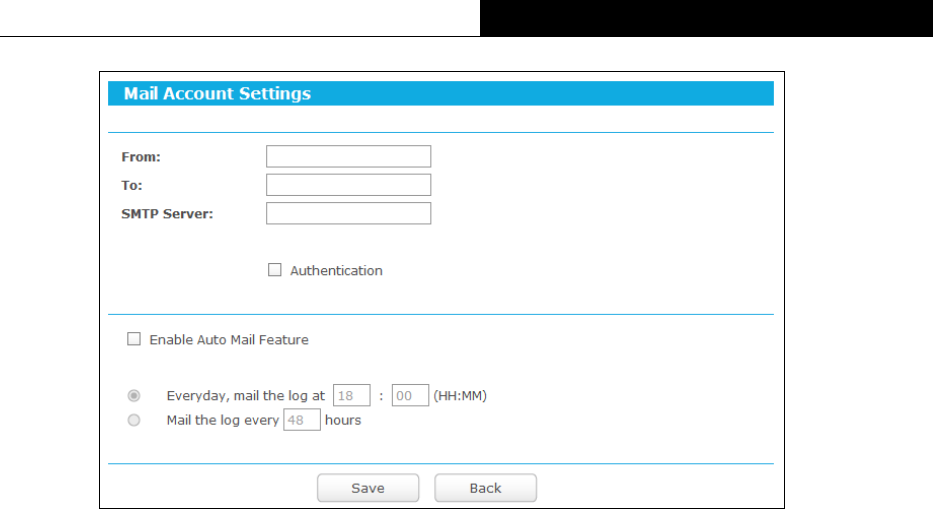
-131-
TL-WR841HP
300Mbps High Power Wireless N Router
Figure 4-29 Mail Account Settings
From - Your mail box address. The router would connect it to send logs.
To - Recipient’s address. The destination mailbox where the logs would be received.
SMTP Server - Your smtp server. It corresponds with the mailbox filled in the From
field. You can log on the relevant website for help if you are not clear with the address.
Authentication - Most SMTP Server requires Authentication. It is required by most
mailboxes that need User Name and Password to log in.
Note:
Only when you select Authentication, do you have to enter the User Name and Password
in the following fields.
User Name - Your mail account name filled in the From field. The part behind @ is
included.
Password - Your mail account password.
Confirm The Password - Enter the password again to confirm.
Enable Auto Mail Feature - Select it to mail logs automatically. You could mail the
current logs either at a specified time every day or by intervals, but only one could be
the current effective rule. Enter the desired time or intervals in the corresponding field
in the last figure.
Click Save to keep your settings.
Click Back to return to the previous page.
Log Type - By selecting the log type, only logs of this type will be shown.
Log Level - By selecting the log level, only logs of this level will be shown.
Refresh - Refresh the page to show the latest log list.

-132-
TL-WR841HP
300Mbps High Power Wireless N Router
Save Log - Click to save all the logs in a txt file.
Mail Log - Click to send an email of current logs manually according to the address and
validation information set in Mail Settings.
Clear Log - All the logs will be deleted from the router permanently, not just from the page.
Click the Next button to go to the next page, or click the Previous button to return to the
previous page.
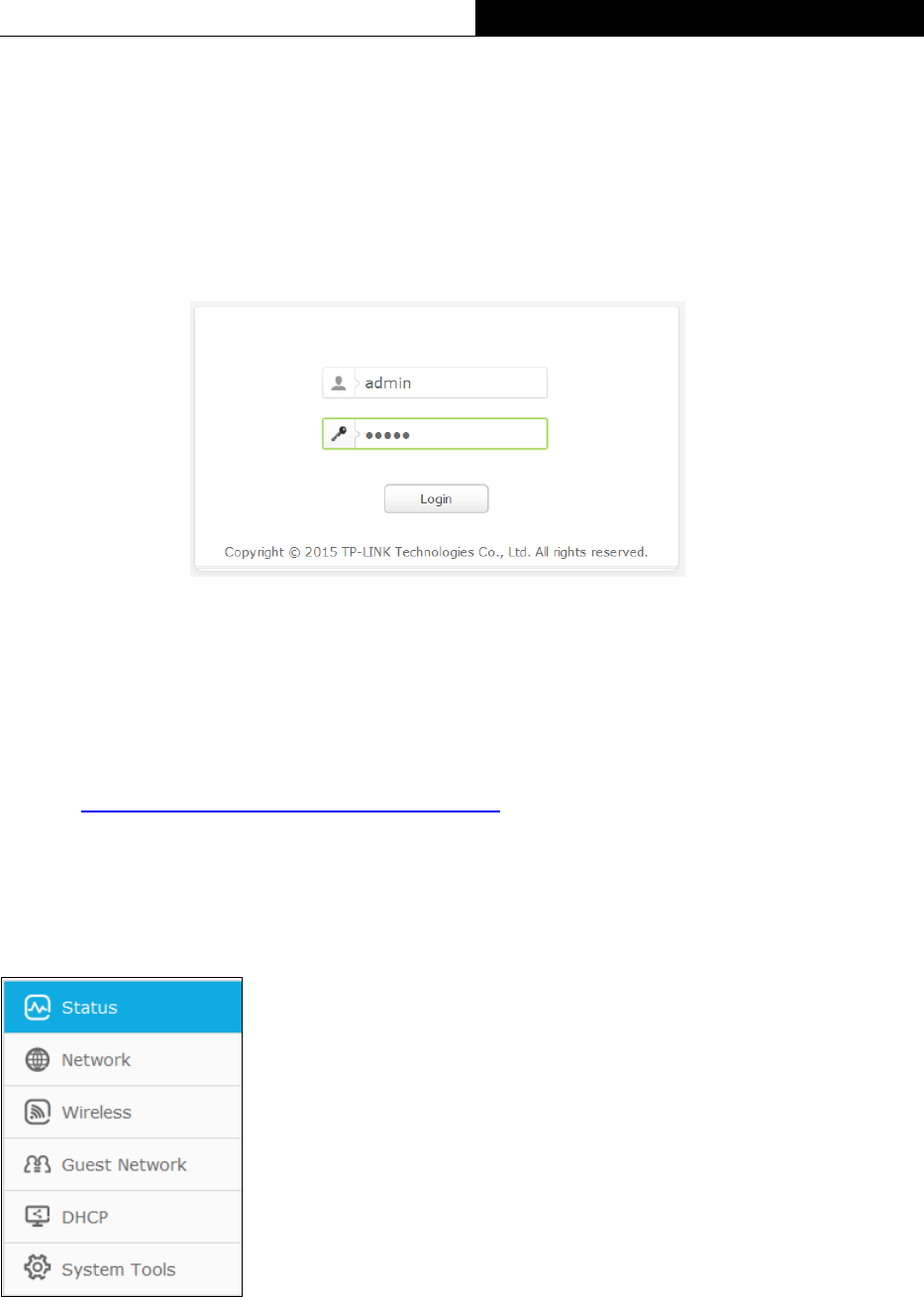
-133-
TL-WR841HP
300Mbps High Power Wireless N Router
Chapter 5. Access Point Mode
5.1 Login and switch the working mode
Enter http://tplinkwifi.net in the address bar of a web browser. Use admin for both username
and password, and then click Login.
Figure 5-1 Login
After your successful login, click the Mode button on the top-right corner of the Web
management page to switch the working mode of the router to Access Point.
5.2 Quick Setup
Refer to Access Point Mode -> Login and Quick Setup
5.3 Setting
Click “Setting”, then you will see the main menus on the left of the Web Management Page. On
the right, there are the corresponding explanations and instructions.
The detailed explanations for each Web page’s key function are listed below.
5.3.1 Status
Go to “Setting→Status”, you can see the current status information about the router.
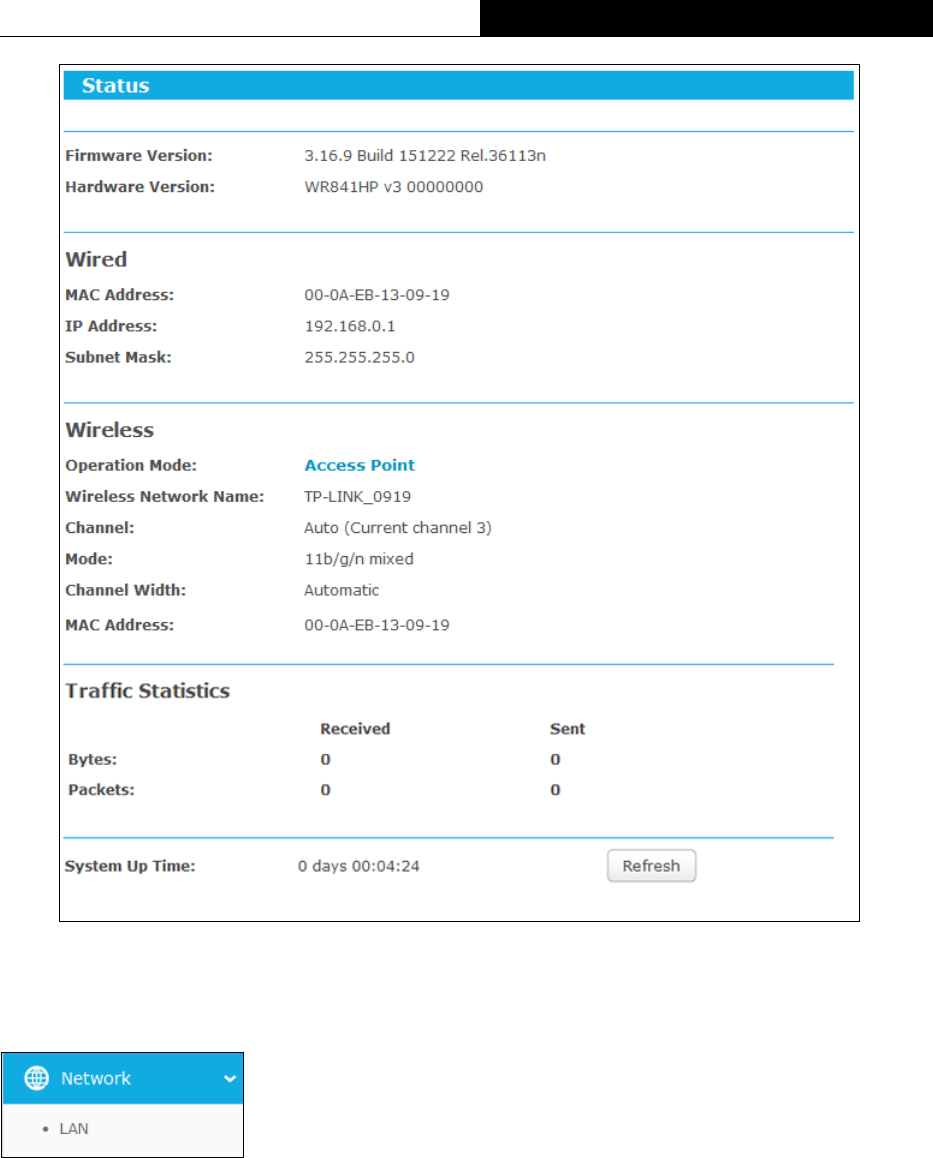
-134-
TL-WR841HP
300Mbps High Power Wireless N Router
Figure 5-2 status
5.3.2 Network
There is one submenu under the Network menu: LAN. Click it, and you will be able to configure
the corresponding function.
5.3.2.1. LAN
Go to “Setting→Network→LAN”, and then you can configure the IP parameters of LAN on this
page.
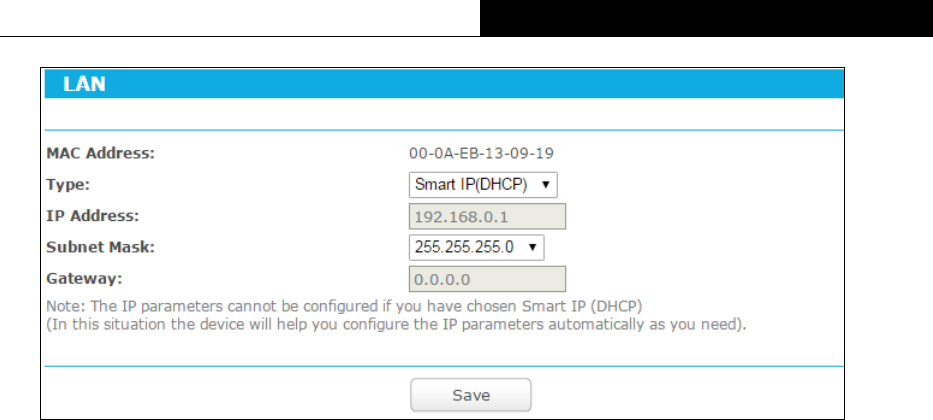
-135-
TL-WR841HP
300Mbps High Power Wireless N Router
Figure 5-3 LAN
MAC Address - The physical address of the LAN ports, as seen from the LAN. The value
can NOT be changed.
Type - Choosing Smart IP to get IP address from DHCP server, or choosing static IP to
configure IP address manually.
IP Address – If you have chosen the type of Static IP. You can set a new IP address of your
system here in dotted-decimal notation (factory default - 192.168.0.1).
Subnet Mask - An address code that determines the size of the network. Normally
255.255.255.0 is used as the subnet mask.
Gateway - The gateway should be in the same subnet as your IP address.
Click the Save button to save your settings.
Note:
If you change the IP address, you must use the new IP address to login the system.
If you select the type of Smart IP, the DHCP server in this device will not startup.
If the new IP address you set is not in the same subnet, the IP Address pool in the DHCP
server will not take effect, until they are re-configured.
This device will reboot automatically after you click the Save button.
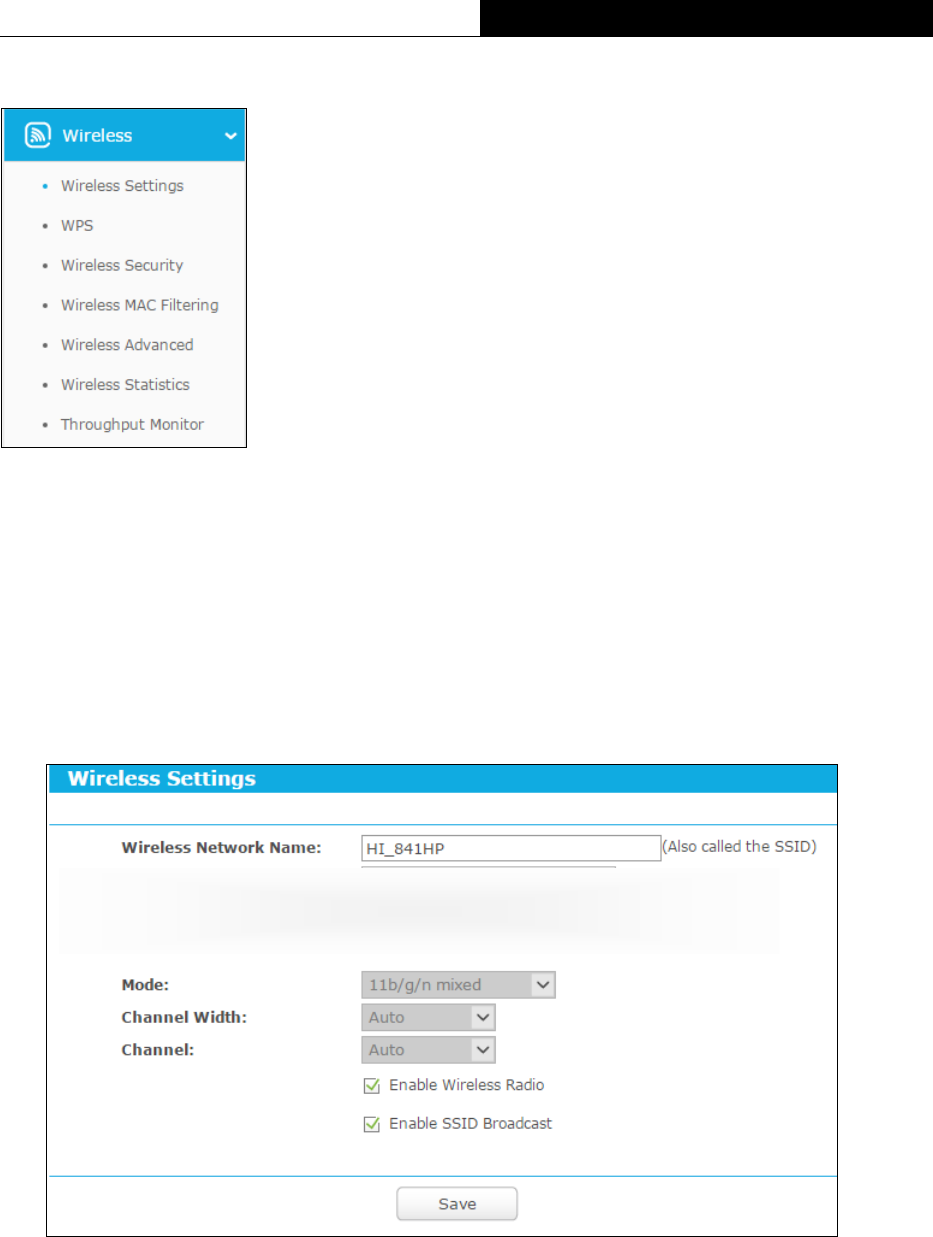
-136-
TL-WR841HP
300Mbps High Power Wireless N Router
5.3.3 Wireless
There are seven submenus under the Wireless menu: Wireless Settings, WPS, Wireless
Security, Wireless Mac Filtering, Wireless Advanced, Wireless Statistics and Throughput
Monitor. Click any of them, and you will be able to configure the corresponding function. The
detailed explanations for each submenu are provided below.
5.3.3.1. Wireless Settings
Go to “Setting→Wireless→Wireless Settings”, and then you can configure the basic settings
of wireless network.
Figure 5-4 Wireless settings
Wireless Network Name - Enter a value of up to 32 characters. The same Name (SSID)
must be assigned to all wireless devices in your network.
Mode -This field determines the wireless mode which the AP works on.
Channel Width - The bandwidth of the wireless channel.
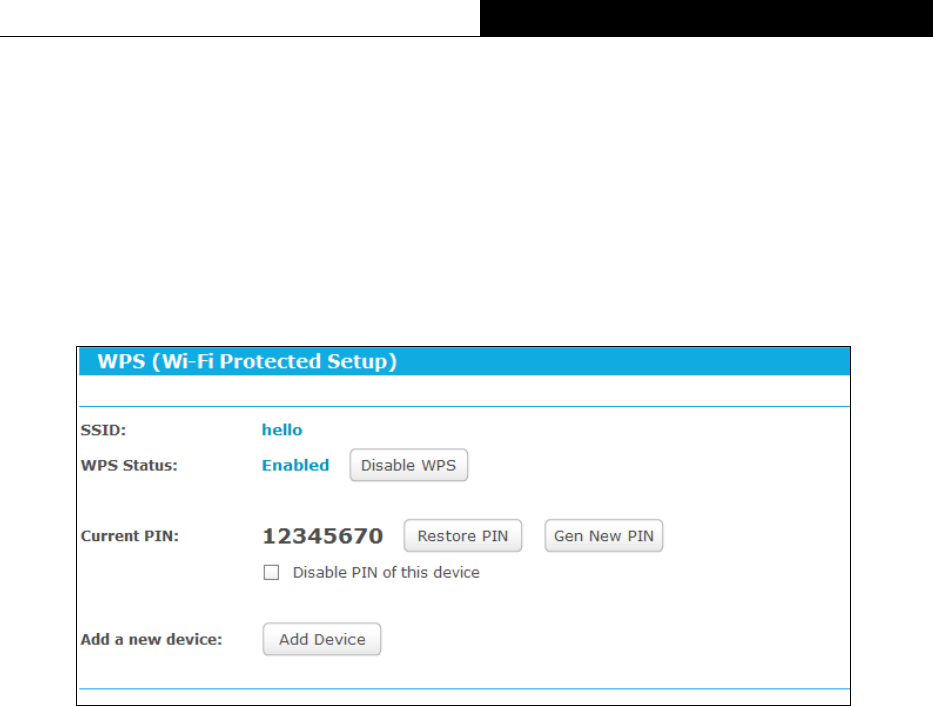
-137-
TL-WR841HP
300Mbps High Power Wireless N Router
Enable Wireless Radio - The wireless radio of the AP can be enabled or disabled to allow
or deny wireless stations to access. If enabled, the wireless stations will be able to access
the AP, otherwise, wireless stations will not be able to access the AP.
5.3.3.2. WPS
Go to “Setting→Wireless→WPS”, you can see the screen as shown in Figure 3-20. This
section will guide you to add a new wireless device to an existing network quickly by WPS
(Wi-Fi Protected Setup) function.
Figure 5-5 WPS
WPS Status - Enable or disable the WPS function here.
Current PIN - Displays the current value of the router's PIN. The default PIN of the router
can be found in the label or User Guide.
Restore PIN - Restore the PIN of the router to its default value.
Gen New PIN - Click this button, and then you can get a new random value for the router's
PIN. You can ensure the network security by generating a new PIN.
Disable PIN of this device - WPS external registrar of entering this device's PIN can be
disabled or enabled manually. If this device receives multiple failed attempts to
authenticate an external registrar, this function will be disabled automatically.
Add device - You can add a new device to the existing network manually by clicking this
button.
If the wireless adapter supports Wi-Fi Protected Setup (WPS), you can establish a wireless
connection between wireless adapter and the router using either Push Button Configuration
(PBC) method or PIN method.
IV. Use the Wi-Fi Protected Setup Button
Use this method if your client device has a WPS button.
1. Press the WPS/Reset button on the back panel of the router. You can also keep the default
WPS status as Enabled and click the Add device button in the last figure. Then choose
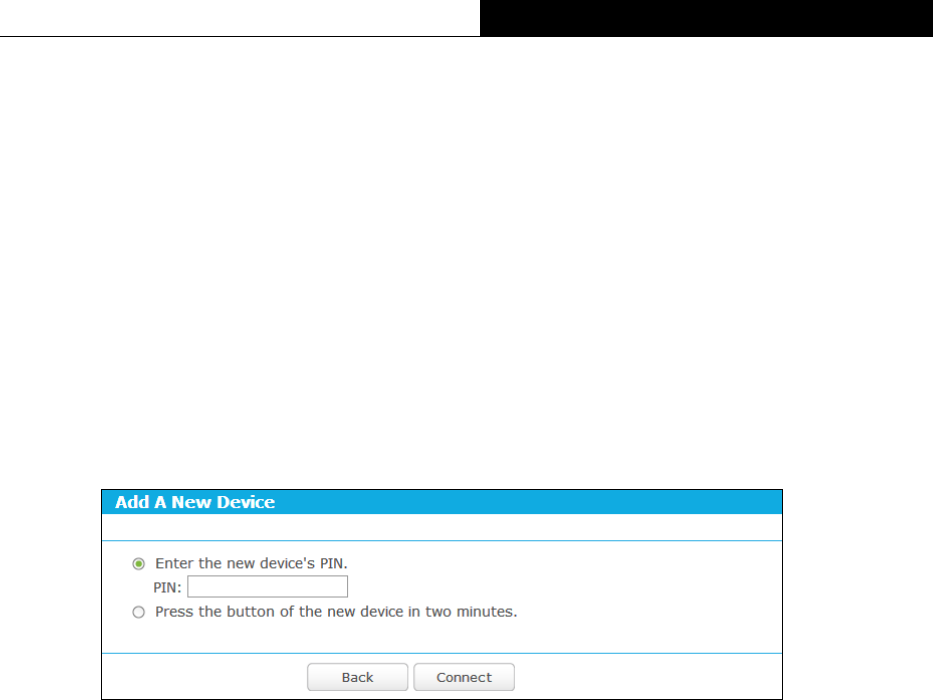
-138-
TL-WR841HP
300Mbps High Power Wireless N Router
“Press the button of the new device in two minutes” and click Connect, shown in the
next figure.
2. Press and hold the WPS button of the client. The WPS LED flashes for two minutes during
the Wi-Fi Protected Setup process.
3. When the WPS LED is on, the client has successfully connected to the router.
V. Enter the client device’s PIN on the router
Use this method if your client does not have the WPS button, but has a Wi-Fi Protected Setup
PIN number.
1. Enable WPS. The default is enabled. Click the Add device button in the last figure, then
Add A New Device page will appear.
Figure 5-6 Add A New Device
2. Enter the PIN number from the client in the field on the WPS screen above. Then click
Connect button.
3. “Connect successfully” will appear on the screen of the last figure, which means the
client has successfully connected to the router.
Note:
1) The WPS LED on the router will light blue for five minutes if the device has been successfully
added to the network.
2) The WPS function cannot be configured if the wireless function of the router is disabled.
Please make sure the wireless function is enabled before configuring the WPS.
VI. Enter the router’s PIN on your client device
Use this method if your client device asks for the router’s PIN number.
1. On the client device, enter the PIN number listed on the router’s Wi-Fi Protected Setup
screen, shown in the WPS page(It is also labeled on the bottom of the router).
2. The Wi-Fi Protected Setup LED flashes for two minutes during the Wi-Fi Protected Setup
process.
3. When the WPS LED is on, the client device has successfully connected to the router.
Note:
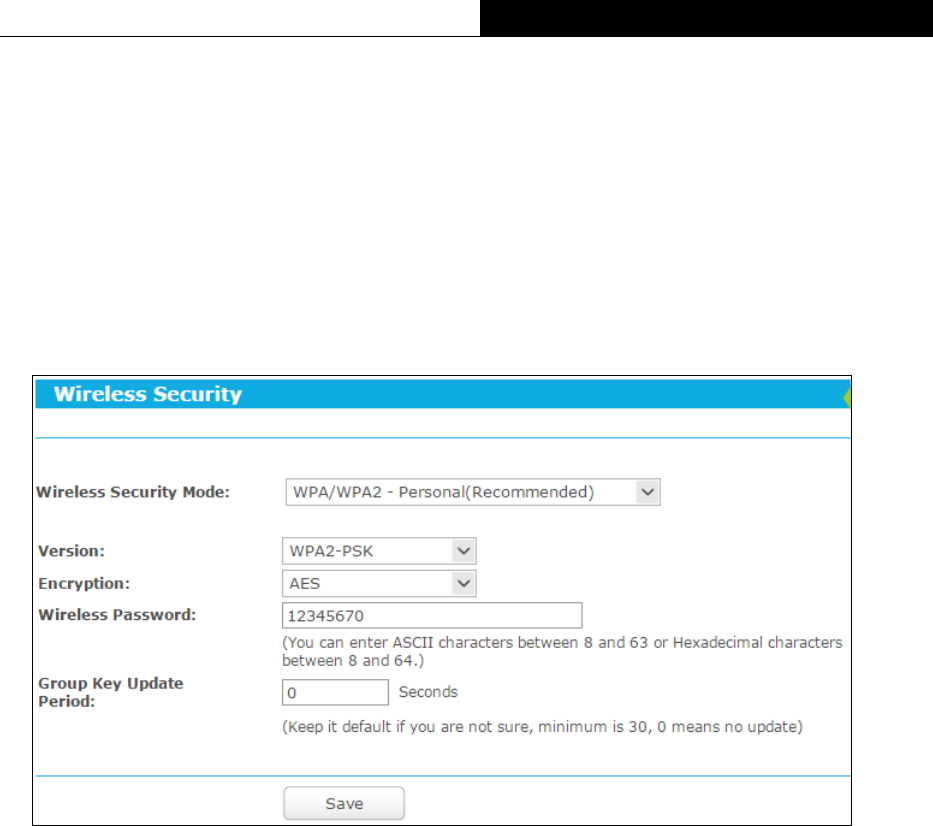
-139-
TL-WR841HP
300Mbps High Power Wireless N Router
3) The WPS LED on the router will light green for five minutes if the device has been
successfully added to the network.
The WPS function cannot be configured if the Wireless Function of the router is disabled.
Please make sure the Wireless Function is enabled before configuring the WPS.
5.3.3.3. Wireless Security
Go to “Setting→Wireless→Wireless security”, and then you can configure the security
settings of wireless network.
Figure 5-7 Wireless Security
There are three wireless security modes supported by the Router: WPA/WPA2-Personal,
WPA/WPA2 - Enterprise and WEP (Wired Equivalent Privacy). Each security option has its own
settings as described follows:
Disable Security
The wireless security function can be enabled or disabled. If disabled, the wireless stations will
be able to connect this device without encryption. It is recommended strongly that you choose
one of other options to enable security.
WPA/WPA2 – Enterprise
It’s based on Radius Server.
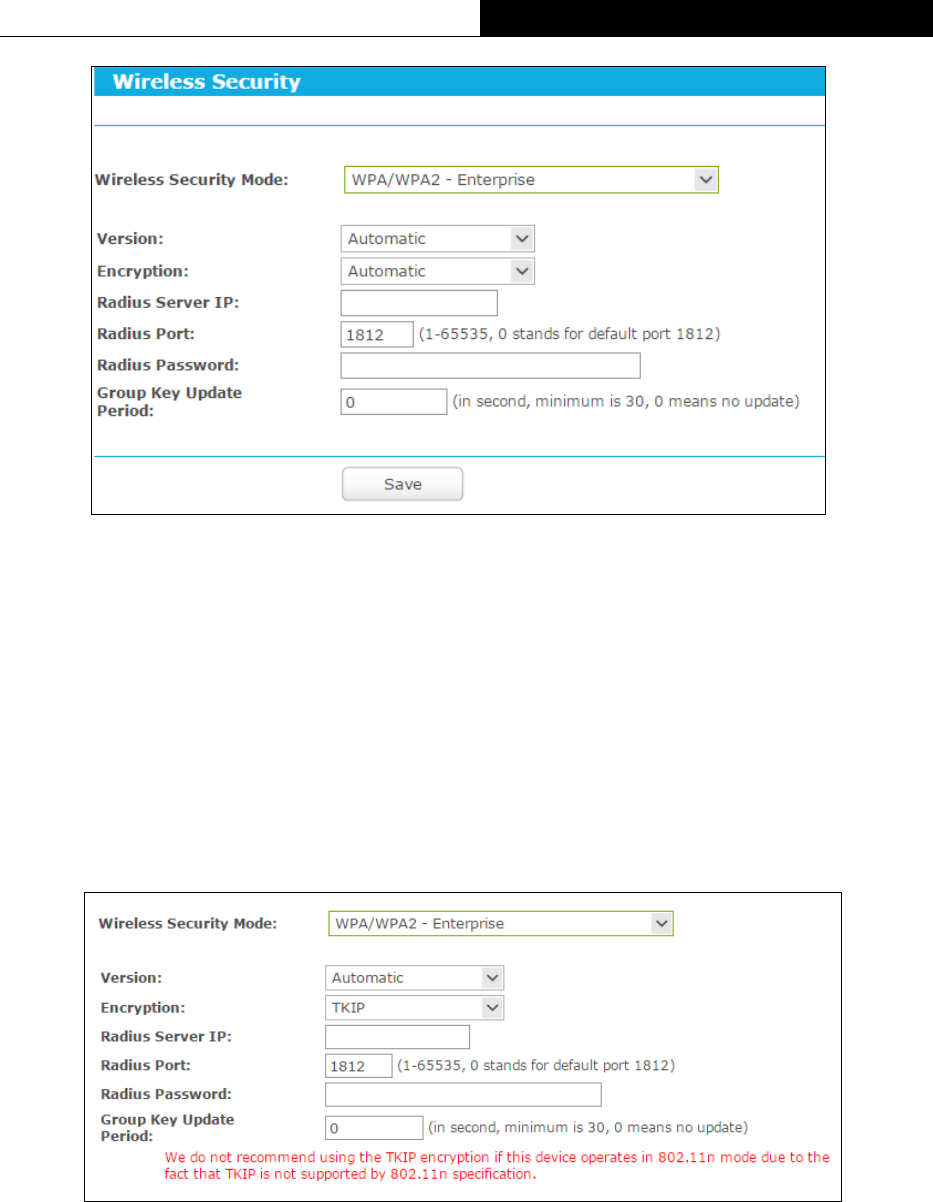
-140-
TL-WR841HP
300Mbps High Power Wireless N Router
Figure 5-8 WAP/WPA2 - Enterprise
Version - you can choose the version of the WPA security on the pull-down list. The default
setting is Automatic, which can select WPA (Wi-Fi Protected Access) or WPA2 (WPA
version 2) automatically based on the wireless station's capability and request.
Encryption - You can select either Automatic, or TKIP or AES.
Note:
If you check the WPA/WPA2 radio button and choose TKIP encryption, you will find a
notice in red as shown below.
Radius Server IP - Enter the IP address of the Radius Server.
Radius Port - Enter the port that radius service used.
Radius Password - Enter the password for the Radius Server.
Group Key Update Period - Specify the group key update interval in seconds. The value
should be 30 or above. Enter 0 to disable the update.
Click the Save button to save your settings on this page
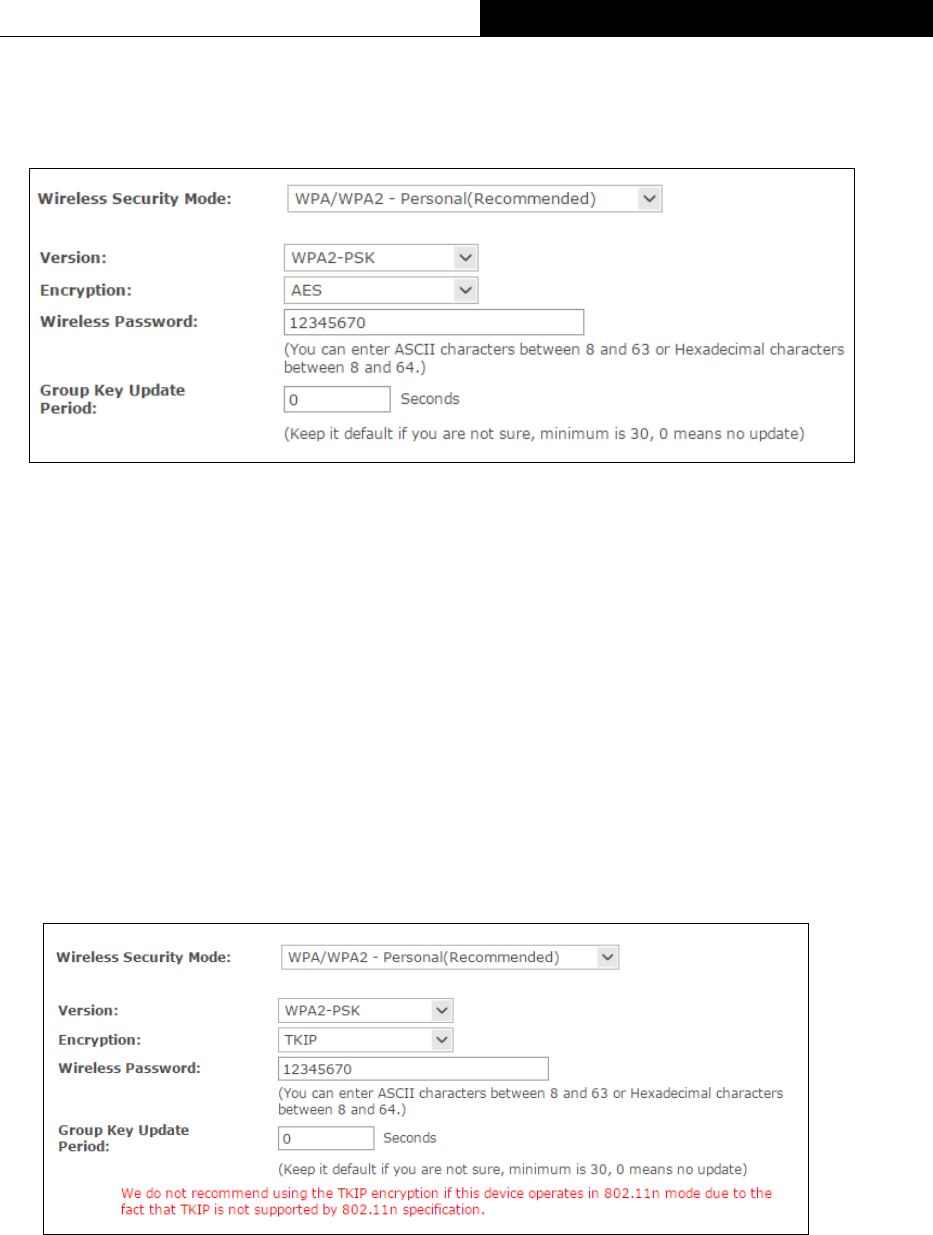
-141-
TL-WR841HP
300Mbps High Power Wireless N Router
WPA/WPA2 - Personal
It’s the WPA/WPA2 authentication type based on pre-shared passphrase.
Figure 5-9 WPA/WPA2 - Personal
Version - you can choose the version of the WPA-PSK security on the drop-down list. The
default setting is Automatic, which can select WPA-PSK (Pre-shared key of WPA) or
WPA2-PSK (Pre-shared key of WPA) automatically based on the wireless station's
capability and request.
Encryption - When WPA-PSK or WPA is set as the Authentication Type, you can select
either Automatic, or TKIP or AES as Encryption.
Note:
If you check the WPA/WPA2-Personal radio button and choose TKIP encryption, you will
find a notice in red as shown below.
Wireless Password - You can enter ASCII or Hexadecimal characters. For Hexadecimal,
the length should be between 8 and 64 characters; for ASCII, the length should be between
8 and 63 characters.
Group Key Update Period - Specify the group key update interval in seconds. The value
can be either 0 or at least 30. Enter 0 to disable the update.
Click the Save button to save your settings on this page.
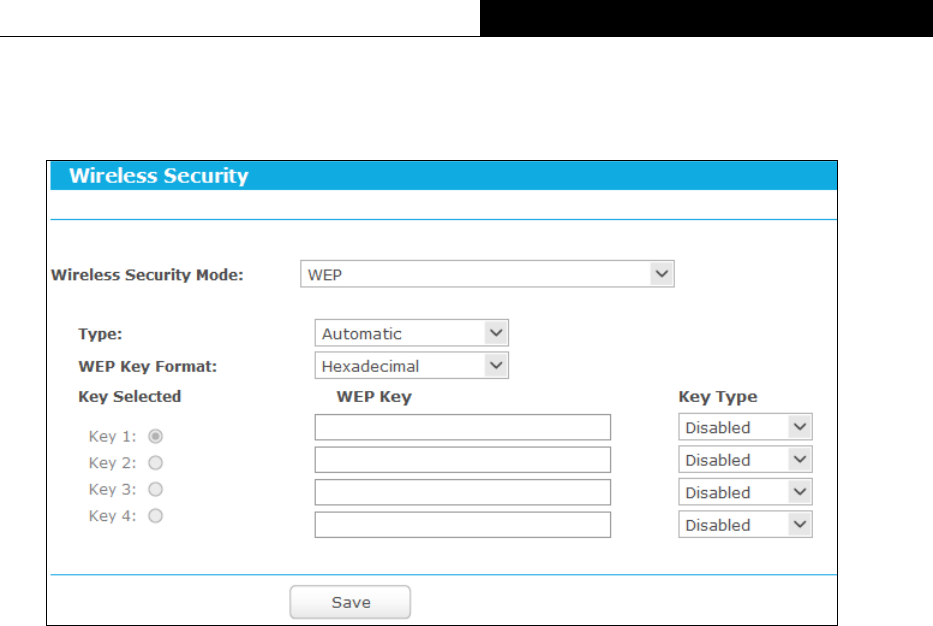
-142-
TL-WR841HP
300Mbps High Power Wireless N Router
WEP
WEP is based on the IEEE 802.11 standard.
Figure 5-10 WEP
Type - you can choose the type for the WEP security on the pull-down list. The default
setting is Automatic, which can select Shared Key or Open System authentication type
automatically based on the wireless station's capability and request.
WEP Key Format - Hexadecimal and ASCII formats are provided here. Hexadecimal
format stands for any combination of hexadecimal digits (0-9, a-f, A-F) in the specified
length. ASCII format stands for any combination of keyboard characters in the specified
length.
WEP Key (Password) - Select which of the four keys will be used and enter the matching
WEP key that you create. Make sure these values are identical on all wireless stations in
your network.
Key Type - You can select the WEP key length (64-bit, or 128-bit, or 152-bit.) for
encryption. "Disabled" means this WEP key entry is invalid.
64-bit - You can enter 10 hexadecimal digits (any combination of 0-9, a-f, A-F, zero key is
not promoted) or 5 ASCII characters.
128-bit - You can enter 26 hexadecimal digits (any combination of 0-9, a-f, A-F, zero key is
not promoted) or 13 ASCII characters.
152-bit - You can enter 32 hexadecimal digits (any combination of 0-9, a-f, A-F, zero key is
not promoted) or 16 ASCII characters.
Note:
If you do not set the key, the wireless security function is still disabled even if you have selected
Shared Key as Authentication Type.
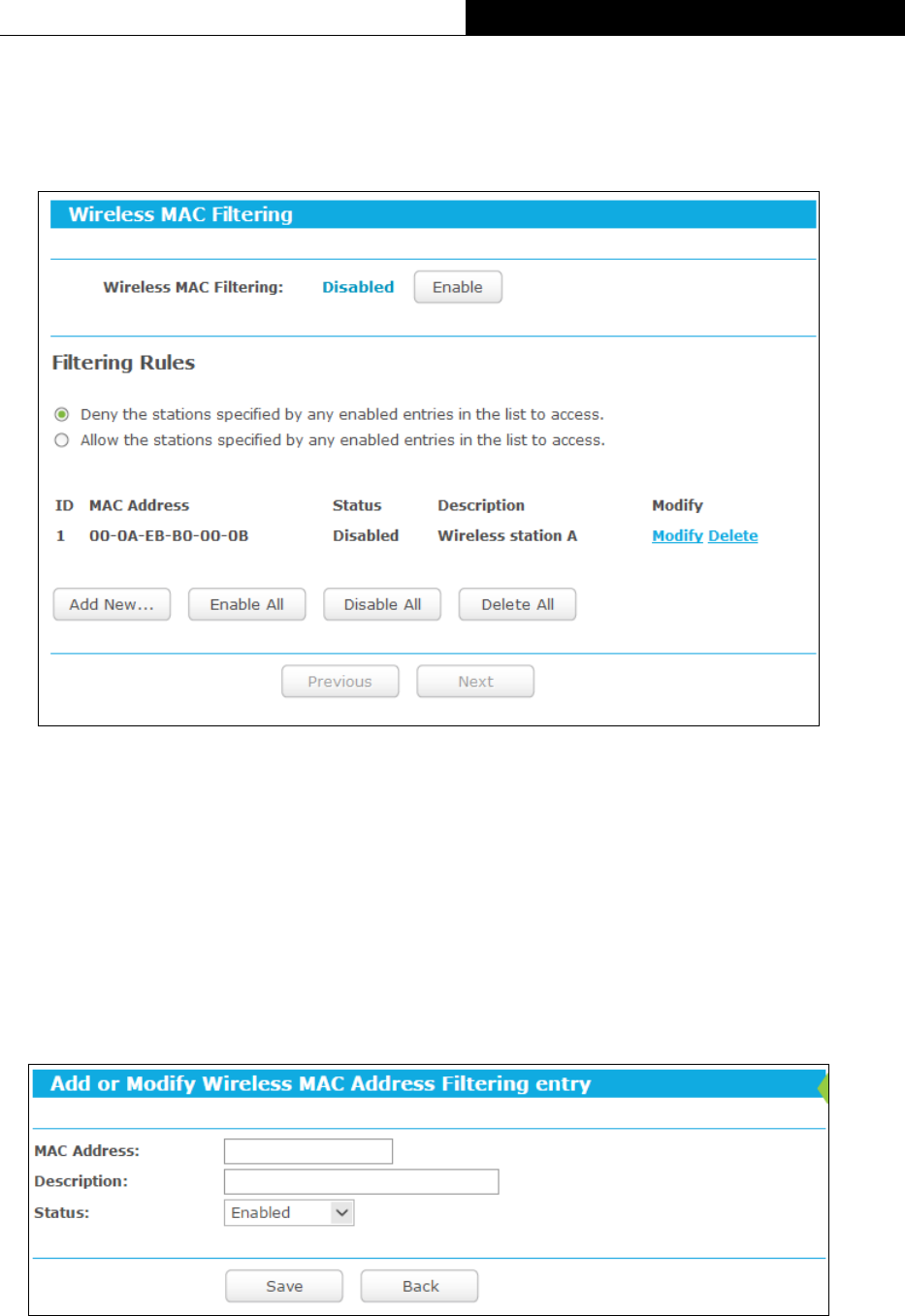
-143-
TL-WR841HP
300Mbps High Power Wireless N Router
5.3.3.4. Wireless MAC Filtering
Go to “Setting→Wireless→Wireless MAC Filtering”, and then you can control the wireless
access by configuring the Wireless MAC Filtering function.
Figure 5-11 Wireless MAC Filtering
To filter wireless users by MAC Address, click Enable. The default setting is Disabled.
MAC Address - The wireless station's MAC address that you want to access.
Status - The status of this entry, either Enabled or Disabled.
Description - A simple description of the wireless station.
To Add a Wireless MAC Address filtering entry, click the Add New… button. The "Add or
Modify Wireless MAC Address Filtering entry" page will appear.
Figure 5-12 Add and modify Wireless MAC Address Filtering entry
To add or modify a MAC Address Filtering entry, follow these instructions:
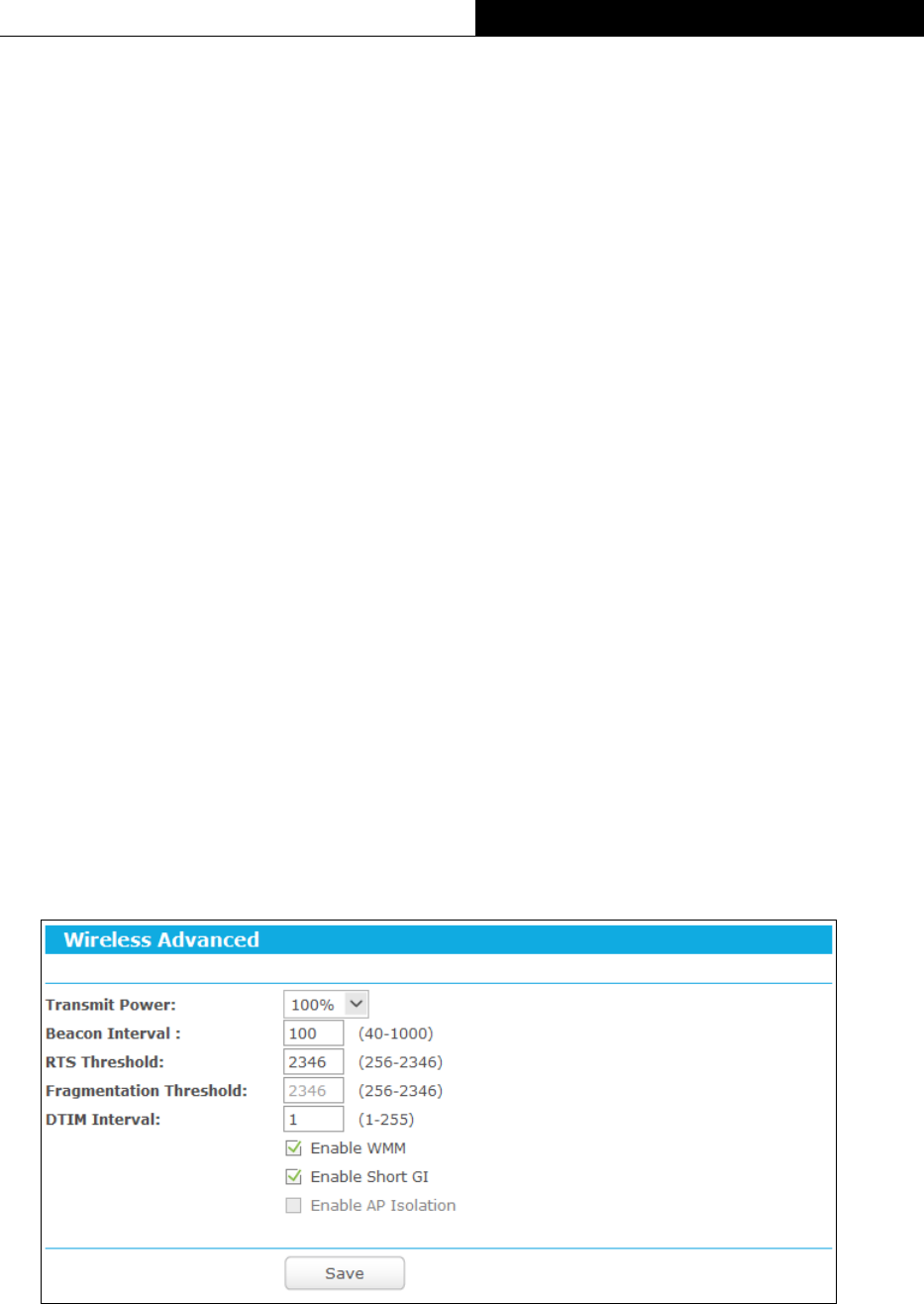
-144-
TL-WR841HP
300Mbps High Power Wireless N Router
1. Enter the appropriate MAC Address into the MAC Address field. The format of the MAC
Address is XX-XX-XX-XX-XX-XX (X is any hexadecimal digit). For example:
00-0A-EB-B0-00-0B.
2. Give a simple description for the wireless station in the Description field. For example:
Wireless station A.
3. Select Enabled or Disabled for this entry on the Status pull-down list.
4. Click the Save button to save this entry.
To modify or delete an existing entry:
1. Click the Modify in the entry you want to modify. If you want to delete the entry, click the
Delete.
2. Modify the information.
3. Click the Save button.
Click the Enable All button to make all entries enabled.
Click the Disable All button to make all entries disabled.
Click the Delete All button to delete all entries.
Click the Next button to go to the next page.
Click the Previous button to return to the previous page.
5.3.3.5. Wireless Advanced
Go to “Setting→Wireless→Wireless Advanced”, and then you can configure the advanced
settings of your wireless network.
Figure 5-13 Wireless Advanced
Transmit Power - Here you can specify the transmit power of Router. You can select
100%, 75% or 50% which you would like. 100% is the default setting and is
recommended.

-145-
TL-WR841HP
300Mbps High Power Wireless N Router
Beacon Interval - Enter a value between 40-1000 milliseconds for Beacon Interval here.
The beacons are the packets sent by the Router to synchronize a wireless network.
Beacon Interval value determines the time interval of the beacons. The default value is
100.
RTS Threshold - Here you can specify the RTS (Request to Send) Threshold. If the
packet is larger than the specified RTS Threshold size, the Router will send RTS frames
to a particular receiving station and negotiate the sending of a data frame. The default
value is 2346.
Fragmentation Threshold - This value is the maximum size determining whether
packets will be fragmented. Setting the Fragmentation Threshold too low may result in
poor network performance because of excessive packets. 2346 is the default setting and
is recommended.
DTIM Interval - This value determines the interval of the Delivery Traffic Indication
Message (DTIM). A DTIM field is a countdown field informing clients of the next window
for listening to broadcast and multicast messages. When the Router has buffered
broadcast or multicast messages for associated clients, it sends the next DTIM with a
DTIM Interval value. You can specify the value between 1-255 Beacon Intervals. The
default value is 1, which indicates the DTIM Interval is the same as Beacon Interval.
Enable WMM - WMM function can guarantee the packets with high-priority messages
being transmitted preferentially. It is strongly recommended enabled.
Enable Short GI - This function is recommended for it will increase the data capacity by
reducing the guard interval time.
Enable AP Isolation - This function isolate all connected wireless stations so that
wireless stations cannot access each other through WLAN. This function will be disabled if
WDS/Bridge is enabled.
Note:
If you are not familiar with the setting items in this page, it's strongly recommended to keep the
provided default values; otherwise it may result in lower wireless network performance.
5.3.3.6. Wireless Statistics
Go to “Setting→Wireless→Wireless Statistics”, and then you can see the MAC Address,
Current Status, Received Packets and Sent Packets for each connected wireless station.
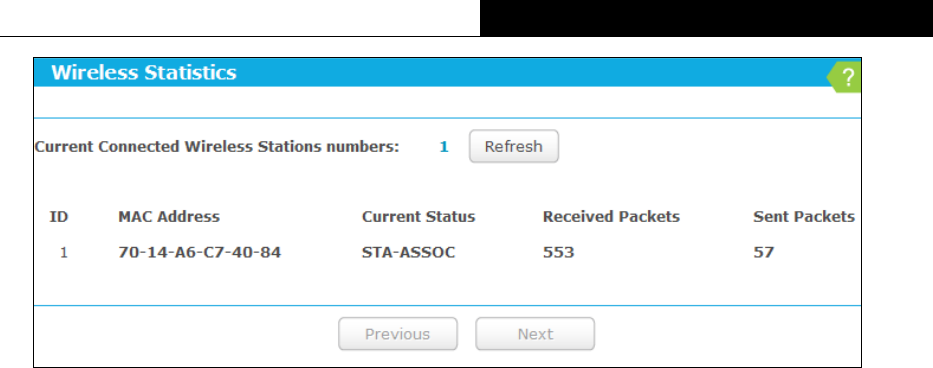
-146-
TL-WR841HP
300Mbps High Power Wireless N Router
Figure 5-14 Wireless Statistics
MAC Address - The connected wireless station's MAC address.
Current Status - The connected wireless station's running status, one of STA-AUTH /
STA-ASSOC / STA-JOINED / WPA / WPA-PSK / WPA2 / WPA2-PSK / AP-UP / AP-DOWN /
Disconnected.
Received Packets - Packets received by the station.
Sent Packets - Packets sent by the station.
Configure - The button is used for loading the item to the Wireless MAC Filtering list.
Deny - if the Wireless MAC Filtering function enable, deny the station to access.
Allow - if the Wireless MAC Filtering function enable, allow the station to access.
You cannot change any of the values on this page. To update this page and to show the
current connected wireless stations, click on the Refresh button.
If the numbers of connected wireless stations go beyond one page, click the Next button to go
to the next page and click the Previous button to return the previous page.
Note:
This page will be refreshed automatically every 5 seconds.
5.3.3.7. Throughput Monitor
Go to “Setting→Wireless→Throughput Monitor”, and then you can see watch wireless
throughput information.
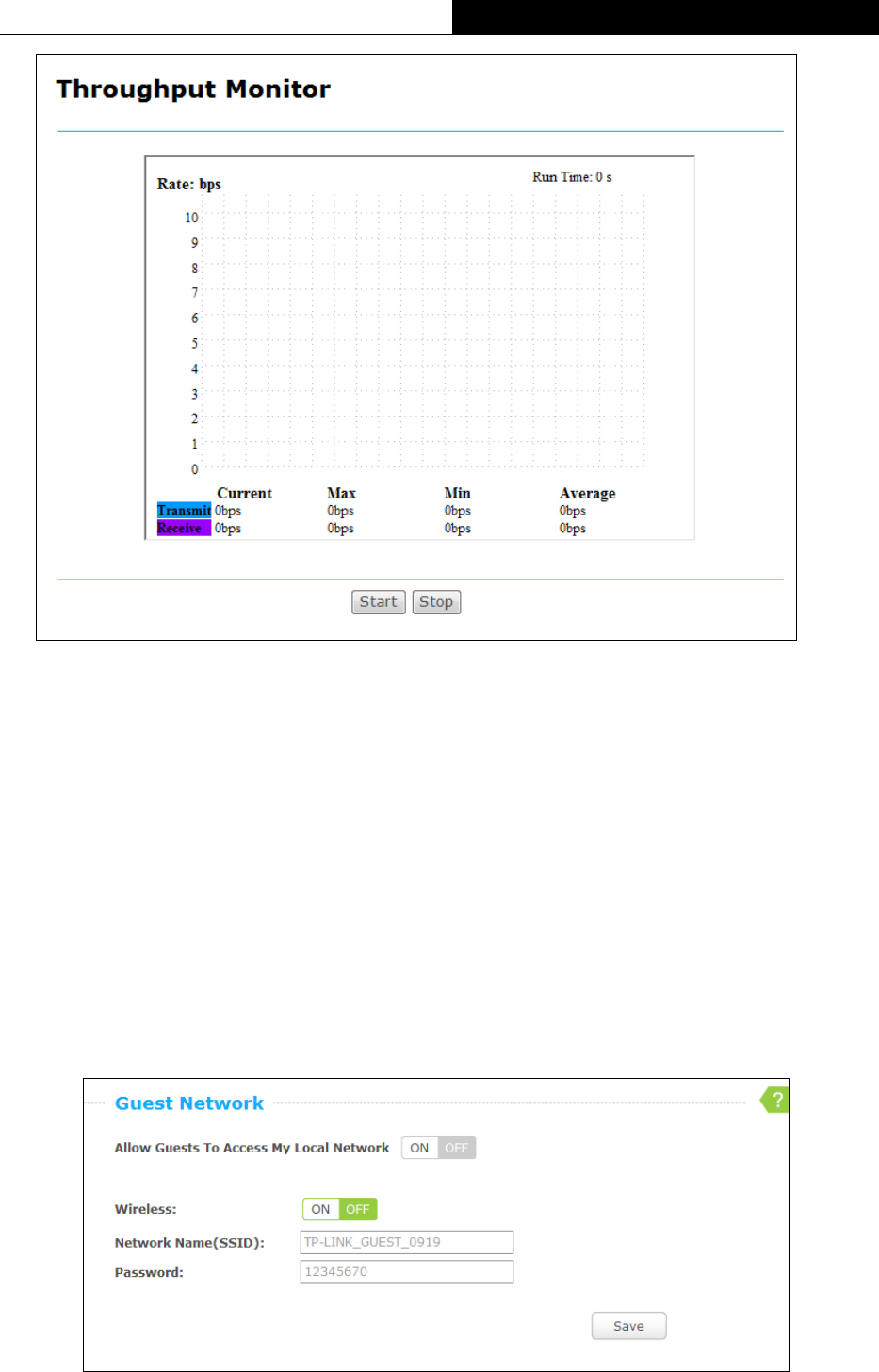
-147-
TL-WR841HP
300Mbps High Power Wireless N Router
Figure 5-15 Wireless Statistics
Rate - The Throughput unit.
Run Time – The time this function is running.
Transmit – Wireless transmit rate information.
Receive – Wireless receive rate information.
Click the Start button to start wireless throughput monitor.
Click the Stop button to start wireless throughput monitor.
5.3.4 Guest Network
Choosing menu “Setting→Guest Network”, you can configure the basic setting for guest
Network.
Figure 5-16 Guest Network
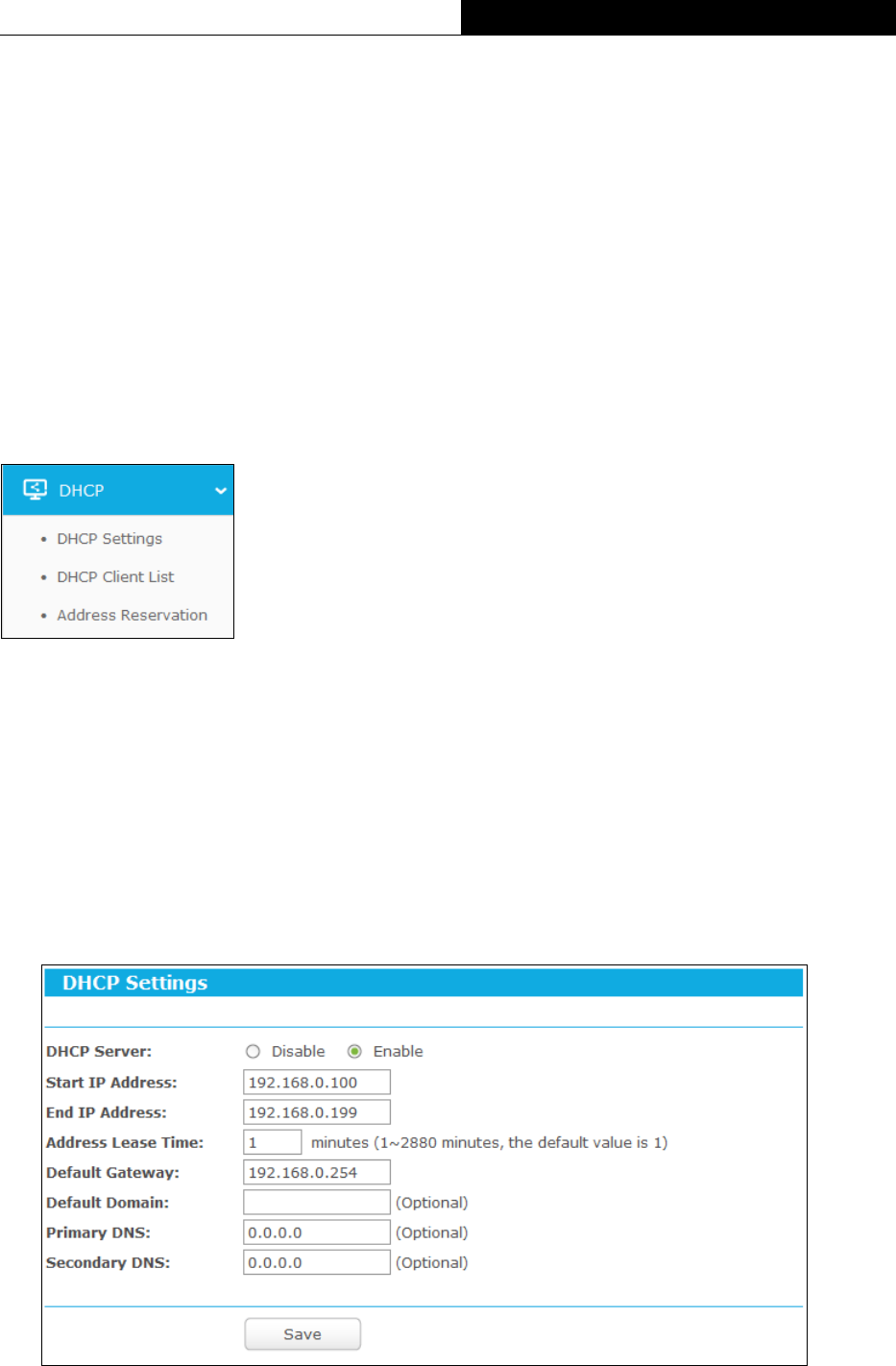
-148-
TL-WR841HP
300Mbps High Power Wireless N Router
Allow Guests To Access My Local Network - Click ON/OFF to enable or disable this
feature. If enabled, guests can communicate with hosts.
Wireless - Click ON/OFF to enable or disable your Guest network. If enabled, the wireless
stations will be able to access the Router, otherwise, wireless stations will not be able to
access the Router.
Network Name(SSID) - Create a name (up to 32 characters) for your Guest network. The
same Name(SSID) must be assigned to all wireless devices in your Guest Network.
Password - Create a password for your wireless network. The password must have a
minimum of 8 characters in length.
Click the Save button to save your settings.
5.3.5 DHCP
There are three submenus under the DHCP menu: DHCP Settings, DHCP Client List and
Address Reservation. Click any of them, and you will be able to configure the corresponding
function.
5.3.5.1. DHCP Settings
Go to “Setting→DHCP→DHCP Settings”, and then you can configure the DHCP Server on the
page as shown below. The Router is set up by default as a DHCP (Dynamic Host Configuration
Protocol) server, which provides the TCP/IP configuration for all the PC(s) that are connected to
the Router in the LAN.
Figure 5-17 DHCP Settings
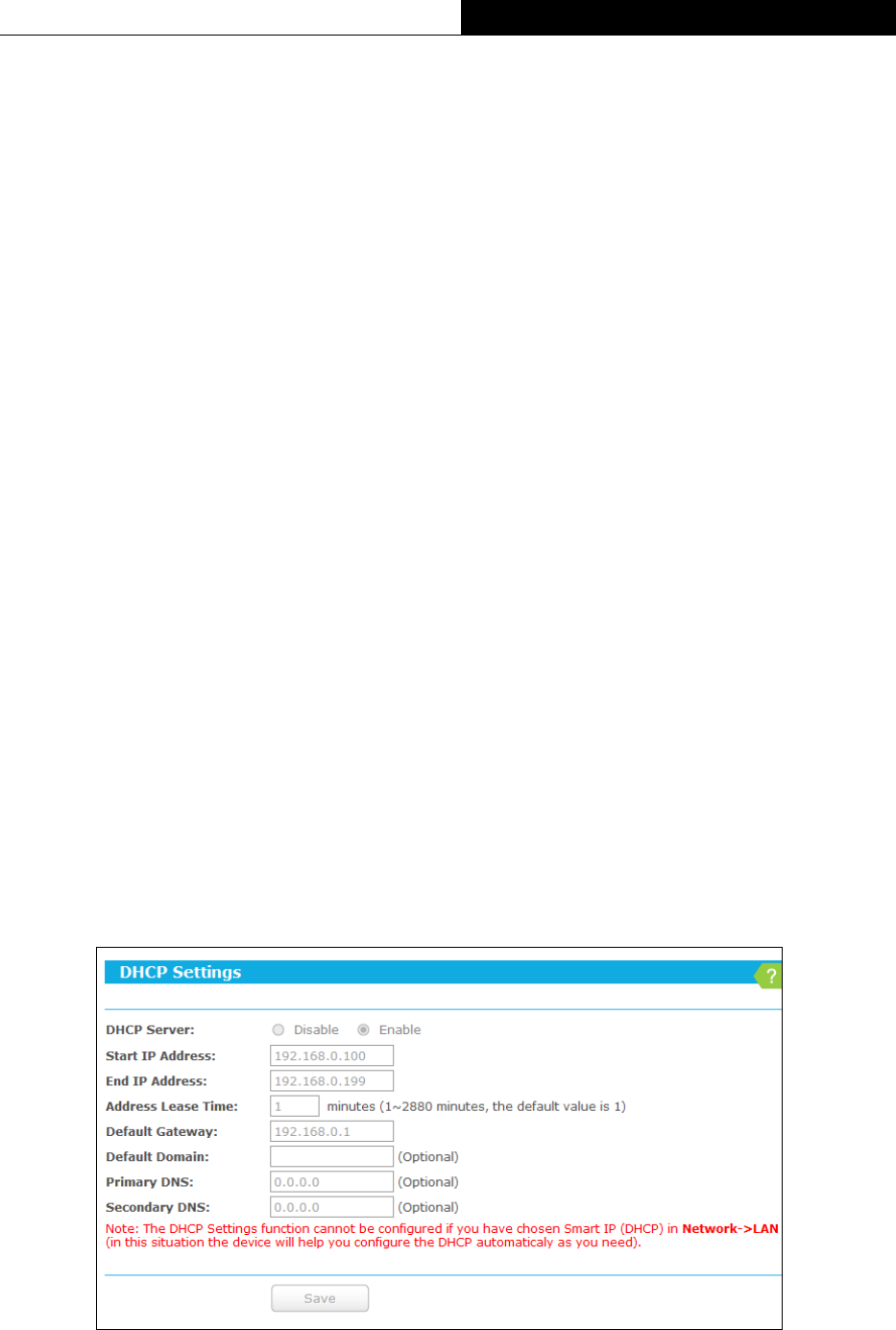
-149-
TL-WR841HP
300Mbps High Power Wireless N Router
DHCP Server - Enable or Disable the DHCP server. If you disable the Server, you must
have another DHCP server within your network or else you must configure the computer
manually.
Start IP Address - Specify an IP address for the DHCP Server to start with when
assigning IP addresses. 192.168.0.100 is the default start address.
End IP Address - Specify an IP address for the DHCP Server to end with when assigning
IP addresses. 192.168.0.199 is the default end address.
Address Lease Time - The Address Lease Time is the amount of time a network user
will be allowed connection to the Router with their current dynamic IP Address. Enter the
amount of time in minutes and the user will be "leased" this dynamic IP Address. After the
time is up, the user will be automatically assigned a new dynamic IP address. The range
of the time is 1 ~ 2880 minutes. The default value is 120 minutes.
Default Gateway (Optional) - It is suggested to input the IP address of the LAN port of the
Router. The default value is 192.168.0.254.
Default Domain (Optional) - Input the domain name of your network.
Primary DNS - (Optional) Input the DNS IP address provided by your ISP or consult your
ISP.
Secondary DNS (Optional) - Input the IP address of another DNS server if your ISP
provides two DNS servers.
Note:
1. To use the DHCP server function of the Router, you must configure all computers on the LAN
as "Obtain an IP Address automatically".
2. When you choose the Smart IP (DHCP) mode in Network → LAN, the DHCP Server
function will be disabled. You will see the page as below.
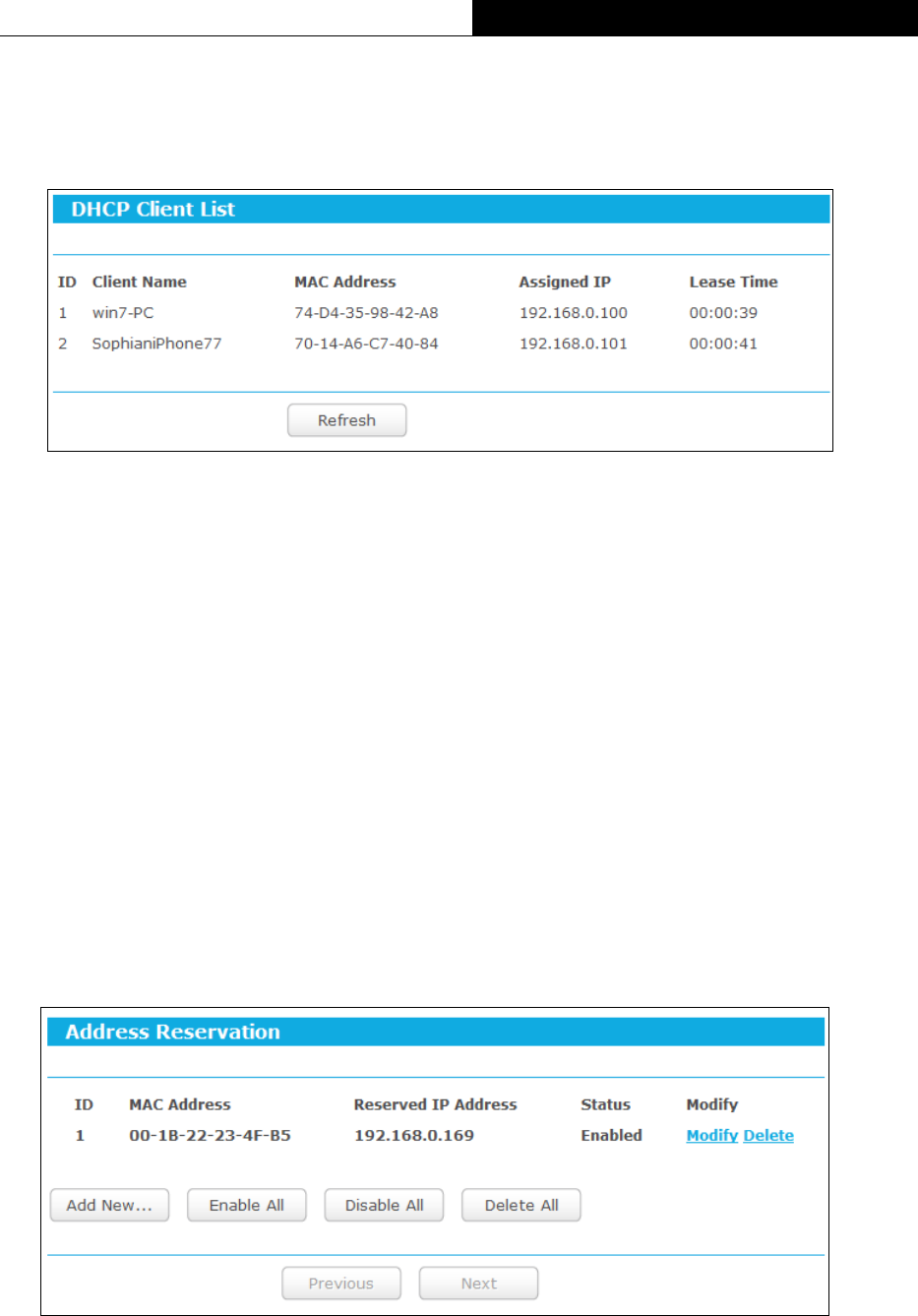
-150-
TL-WR841HP
300Mbps High Power Wireless N Router
5.3.5.2. DHCP Client List
Go to “Setting→DHCP→DHCP Client List”, and then you can view the information about the
clients attached to the Router.
Figure 5-18 DHCP Client List
Client Name - The name of the DHCP client.
MAC Address - The MAC address of the DHCP client.
Assigned IP - The IP address that the Router has allocated to the DHCP client.
Lease Time - The time of the DHCP client leased. After the dynamic IP address has
expired, a new dynamic IP address will be automatically assigned to the user.
You cannot change any of the values on this page. To update this page and to show the
current attached devices, click the Refresh button.
5.3.5.3. Address Reservation
Go to “Setting→DHCP→Address Reservation”, and then you can view and add a reserved
address for clients. When you specify a reserved IP address for a PC on the LAN, that PC will
always receive the same IP address each time when it accesses the DHCP server. Reserved IP
addresses should be assigned to the servers that require permanent IP settings.
Figure 5-19 Address Reservation
MAC Address - The MAC address of the PC for which you want to reserve an IP address.
Reserved IP Address - The IP address reserved for the PC by the Router.
Status - The status of this entry either Enabled or Disabled.
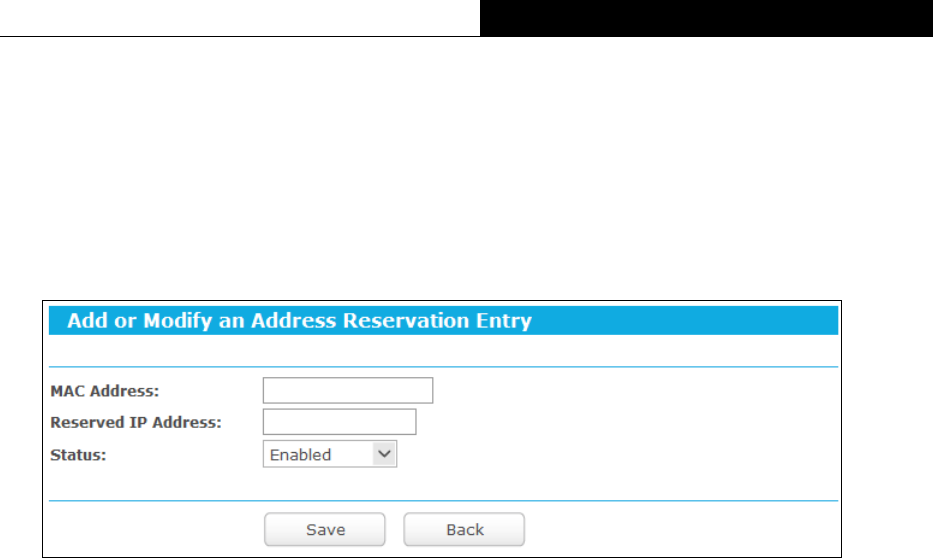
-151-
TL-WR841HP
300Mbps High Power Wireless N Router
Modify - To modify or delete an existing entry.
To Reserve an IP address:
1. Click the Add New… button.
2. Enter the MAC address (in XX-XX-XX-XX-XX-XX format) and IP address (in
dotted-decimal notation) of the computer for which you want to reserve an IP address.
3. Click the Save button.
Figure 5-20 Add or Modify an Address Reservation Entry
To modify or delete an existing entry:
1. Click the Modify in the entry you want to modify. If you want to delete the entry, click the
Delete.
2. Modify the information.
3. Click the Save button.
Click the Enable/Disable All button to make all entries enabled/disabled.
Click the Delete All button to delete all entries.
Click the Next button to go to the next page and Click the Previous button to return the
previous page.
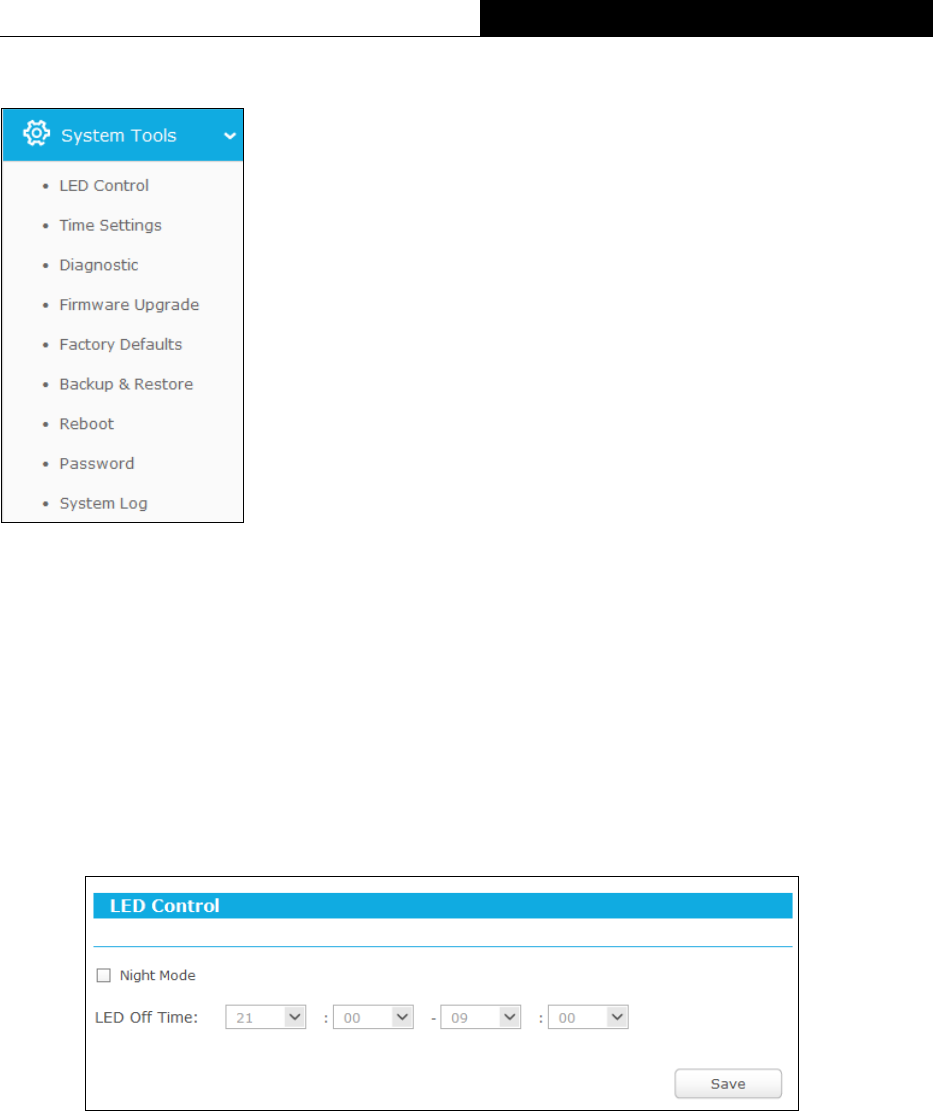
-152-
TL-WR841HP
300Mbps High Power Wireless N Router
5.3.6 System Tools
Go to “System Tools”, and then you can see the submenus under the main menu: LED
Control, Time settings, Diagnostic, Firmware Upgrade, Factory Defaults, Backup &
Restore, Reboot, Password and System Log. Click any of them, and you will be able to
configure the corresponding function. The detailed explanations for each submenu are provided
below.
5.3.6.1. LED Control
Go to “Setting→System Tools→LED Control”, and then you can turn On or Off the LEDs on
your router according to a specific time schedule.
Figure 5-21 LED Control
Night Mode - Indicates whether the Night Mode is On (enabled) or Off (disabled).
LED Off Time - Select the time schedule to turn off LEDs.
5.3.6.2. Time Settings
Go to “Setting→System Tools→Time Settings”, and then you can configure the time on the
following screen.
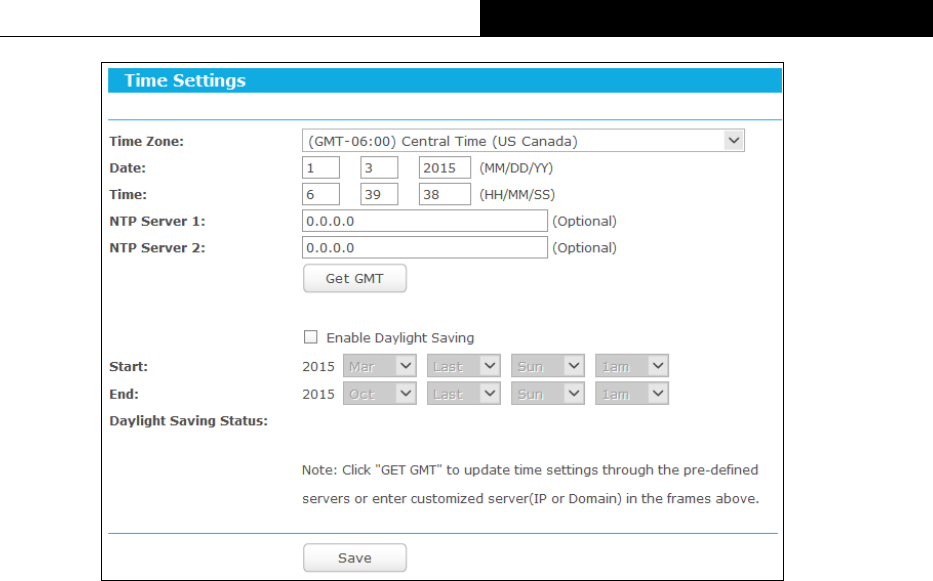
-153-
TL-WR841HP
300Mbps High Power Wireless N Router
Figure 5-22 Time settings
Time Zone - Select your local time zone from this pull down list.
Date - Enter your local date in MM/DD/YY into the right blanks.
Time - Enter your local time in HH/MM/SS into the right blanks.
NTP Server I / NTP Server II - Enter the address or domain of the NTP Server I or NTP
Server II, and then the router will get the time from the NTP Server preferentially. In
addition, the router built-in some common NTP Servers, so it can get time automatically
once it connects the Internet.
Enable Daylight Saving - Check the box to enable the Daylight Saving function.
Start - The time to start the Daylight Saving. Select the month in the first field, the week in
the second field, the day in the third field and the time in the last field.
End - The time to end the Daylight Saving. Select the month in the first field, the week in
the second field, the day in the third field and the time in the last field.
Daylight Saving Status - Displays the status whether the Daylight Saving is in use.
To set time manually:
1. Select your local time zone.
2. Enter the Date in Month/Day/Year format.
3. Enter the Time in Hour/Minute/Second format.
4. Click Save.
To set time automatically:
1. Select your local time zone.
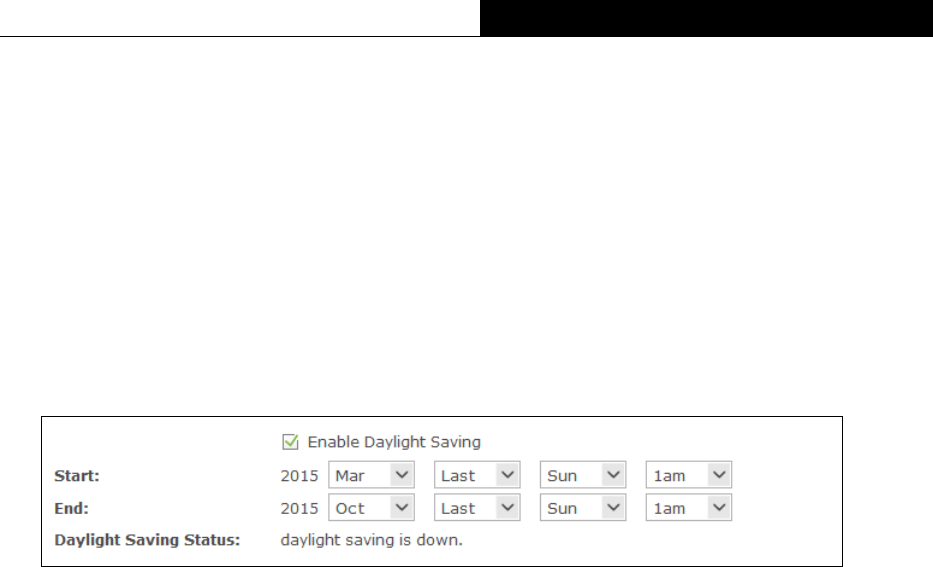
-154-
TL-WR841HP
300Mbps High Power Wireless N Router
2. Enter the address or domain of the NTP Server I or NTP Server II.
3. Click the Get GMT button to get system time from Internet if you have connected to the
Internet.
To set Daylight Saving:
1. Check the box to enable Daylight Saving.
2. Select the start time from the drop-down lists in the Start field.
3. Select the end time from the drop-down lists in the End field.
4. Click the Save button to save the settings.
Figure 5-23 Time settings
Note:
1) This setting will be used for some time-based functions such as firewall. You must specify
your time zone once you login to the router successfully; otherwise, these functions will not
take effect.
2) The time will be lost if the router is turned off.
3) The router will automatically obtain GMT from the Internet if it is configured accordingly.
4) The Daylight Saving will take effect one minute after the configurations are completed.
5.3.6.3. Diagnostic
Go to “Setting→System Tools→Diagnostic”, and then you can transact Ping or Traceroute
function to check connectivity of your network in the following screen.
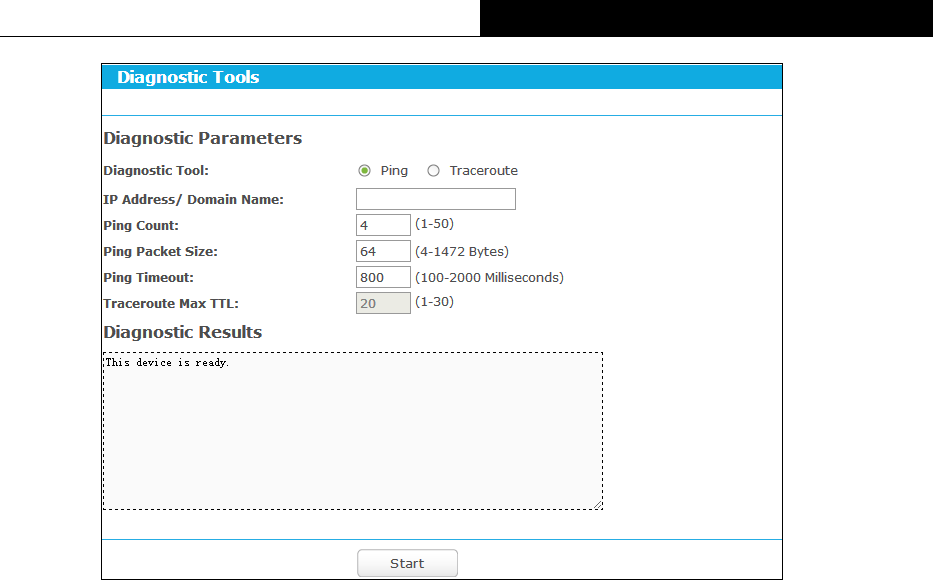
-155-
TL-WR841HP
300Mbps High Power Wireless N Router
Figure 5-24 Diagnostic Tools
Diagnostic Tool - Check the radio button to select one diagnostic too.
Ping - This diagnostic tool troubleshoots connectivity, reachability, and name
resolution to a given host or gateway.
Traceroute - This diagnostic tool tests the performance of a connection.
Note:
You can use ping/traceroute to test both numeric IP address or domain name. If
pinging/tracerouting the IP address is successful, but pinging/tracerouting the domain
name is not, you might have a name resolution problem. In this case, ensure that the
domain name you are specifying can be resolved by using Domain Name System (DNS)
queries.
IP Address/Domain Name - Enter the IP Address or Domain Name of the PC whose
connection you wish to diagnose.
Pings Count - Specifies the number of Echo Request messages sent. The default is 4.
Ping Packet Size - Specifies the number of data bytes to be sent. The default is 64.
Ping Timeout - Time to wait for a response, in milliseconds. The default is 800.
Traceroute Max TTL - Set the maximum number of hops (max TTL to be reached) in the
path to search for the target (destination). The default is 20.
Click Start to check the connectivity of the Internet.
The Diagnostic Results page displays the result of diagnosis.
If the result is similar to the following screen, the connectivity of the Internet is fine.
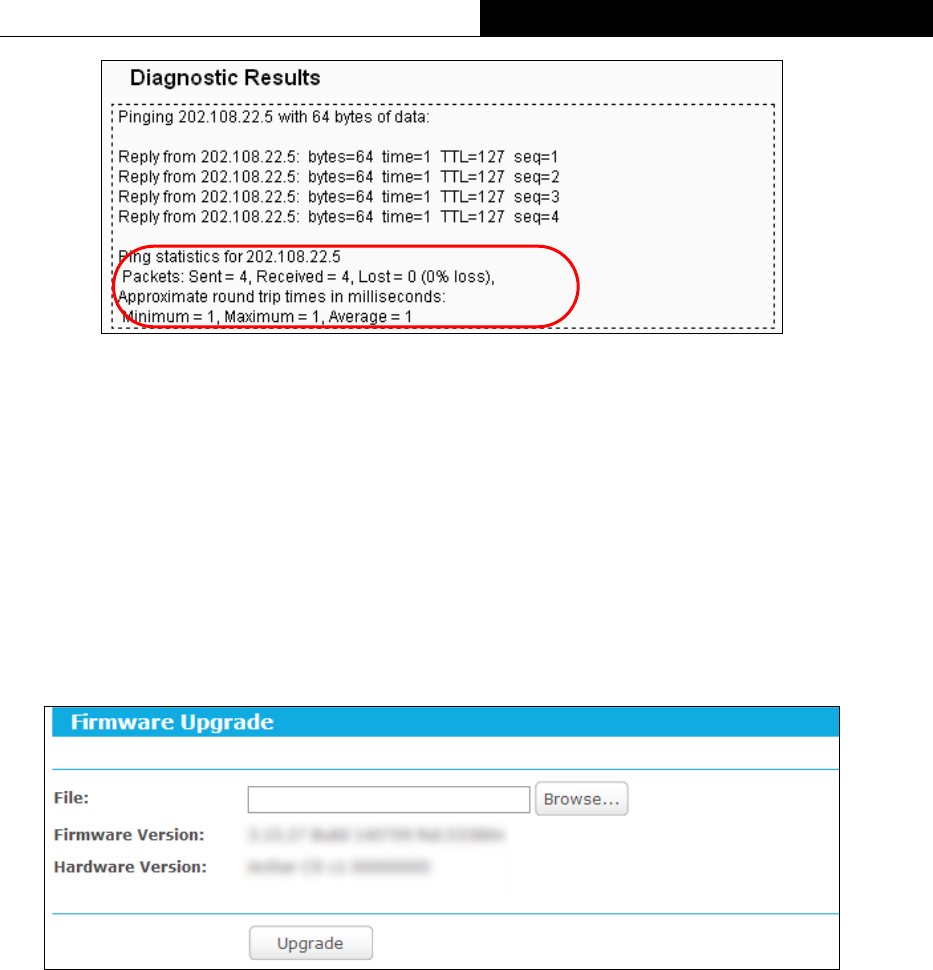
-156-
TL-WR841HP
300Mbps High Power Wireless N Router
Figure 5-25 Diagnostic Results
Note:
1. Only one user can use the diagnostic tools at one time.
2. "Ping Count", "Ping Packet Size" and "Ping Timeout" are Ping Parameters, and
"Traceroute Max TTL" is Traceroute Parameter.
5.3.6.4. Firmware Upgrade
Go to “Setting→System Tools→Firmware Upgrade”, and then you can update the latest
version of firmware for the router on the following screen.
Figure 5-26 Firmware Upgrade
Firmware Version - Displays the current firmware version.
Hardware Version - Displays the current hardware version. The hardware version of the
upgrade file must accord with the router’s current hardware version.
To upgrade the router's firmware, follow these instructions below:
1. Download a most recent firmware upgrade file from our website (www.tp-link.com).
2. Enter or select the path name where you save the downloaded file on the computer into the
File blank.
3. Click the Upgrade button.
4. The router will reboot while the upgrading has been finished.
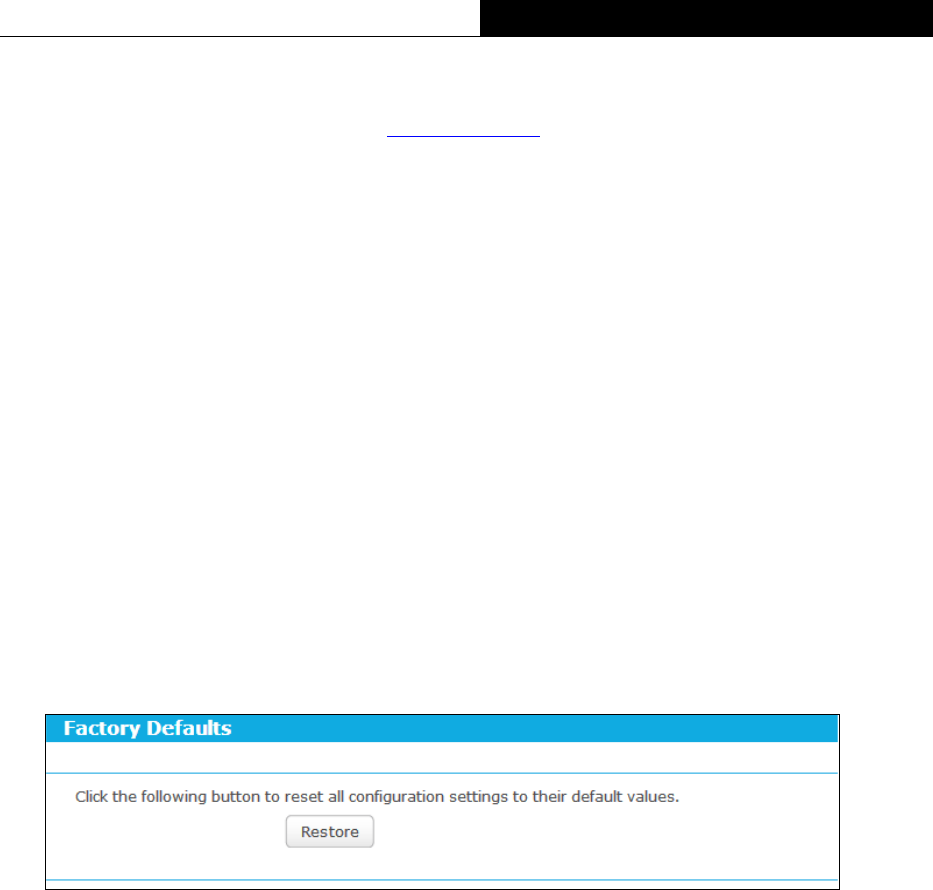
-157-
TL-WR841HP
300Mbps High Power Wireless N Router
Note:
1) New firmware versions are posted at www.tp-link.com and can be downloaded for free. There
is no need to upgrade the firmware unless the new firmware has a new feature you want to
use. However, when experiencing problems caused by the router rather than the
configuration, you can try to upgrade the firmware.
2) When you upgrade the router's firmware, you may lose its current configurations, so before
upgrading the firmware please write down some of your customized settings to avoid losing
important settings.
3) Do not turn off the router or press the Reset button while the firmware is being upgraded.
Loss of power during the upgrade could damage the router.
4) The firmware version must correspond to the hardware.
5) The upgrade process takes a few moments and the router restarts automatically when the
upgrade is complete.
5.3.6.5. Factory Defaults
Go to “Setting→System Tools→Factory Defaults”, and then and you can restore the
configurations of the router to factory defaults on the following screen
Figure 5-27 Restore Factory Default
Click the Restore button to reset all configuration settings to their default values.
The default User Name: admin
The default Password: admin
The default Subnet Mask: 255.255.255.0
Note:
All changed settings will be lost when defaults are restored.
5.3.6.6. Backup & Restore
Go to “Setting→System Tools→Backup & Restore”, and then you can save the current
configuration of the router as a backup file and restore the configuration via a backup file.
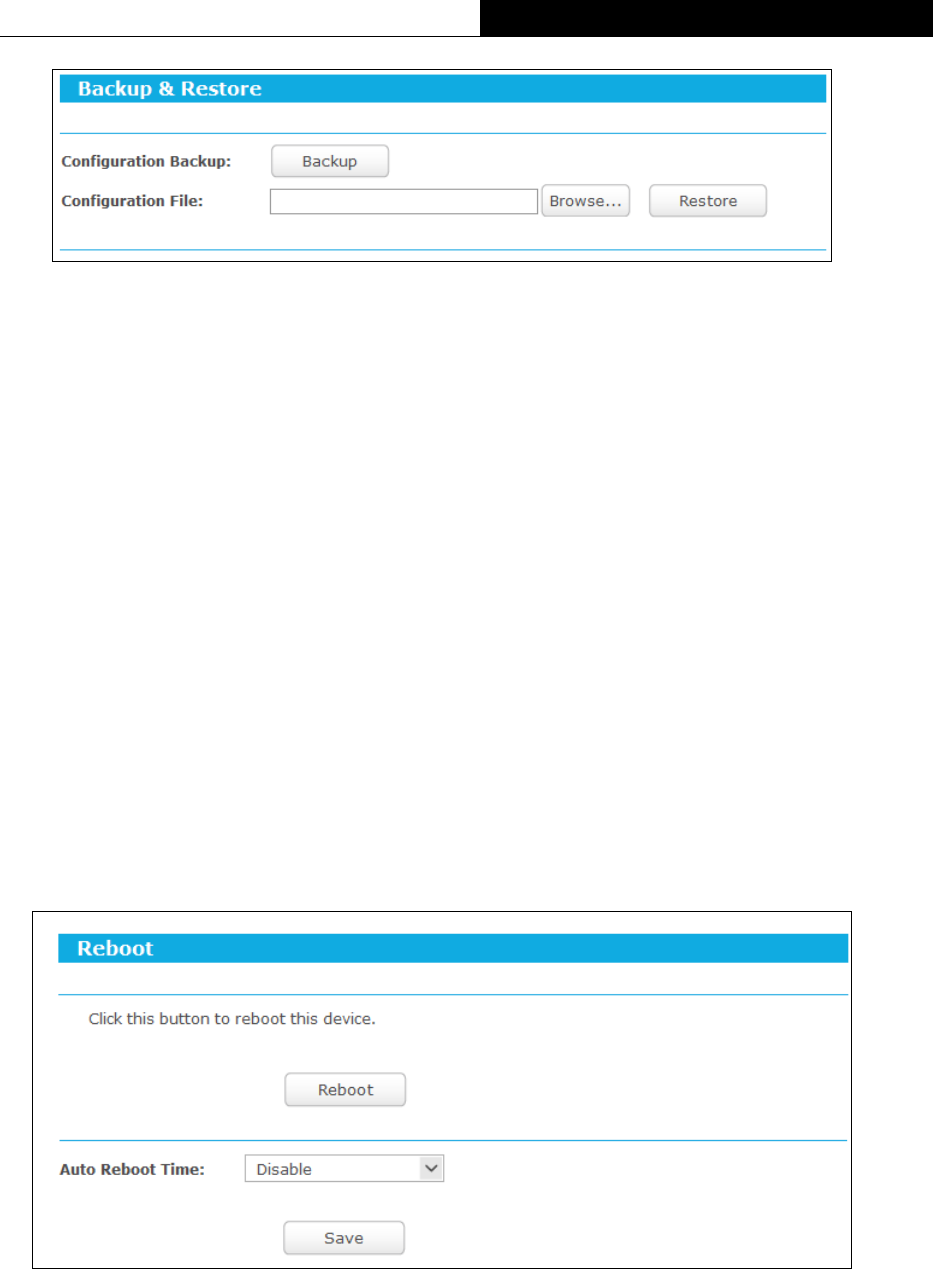
-158-
TL-WR841HP
300Mbps High Power Wireless N Router
Figure 5-28 Backup & Restore Configuration
Click the Backup button to save all configuration settings as a backup file in your local
computer.
To upgrade the router's configuration, follow these instructions.
Click the Browse button to find the configuration file which you want to restore.
Click the Restore button to update the configuration with the file whose path is the
one you have input or selected in the blank.
Note:
The current configuration will be covered with the uploading configuration file. Wrong process will
lead the device unmanaged. The restoring process lasts for 20 seconds and the router will restart
automatically then. Keep the power of the router on during the process, in case of any damage.
5.3.6.7. Reboot
Go to “Setting→→System Tools→Reboot”, and then you can reboot the router by clicking the
Reboot button or setting the auto reboot time.
Figure 5-29 Reboot the router
Click the Reboot button to reboot this device.Some settings of the router will take effect
only after rebooting, which include
Change the LAN IP Address (system will reboot automatically).
Change the DHCP Settings.
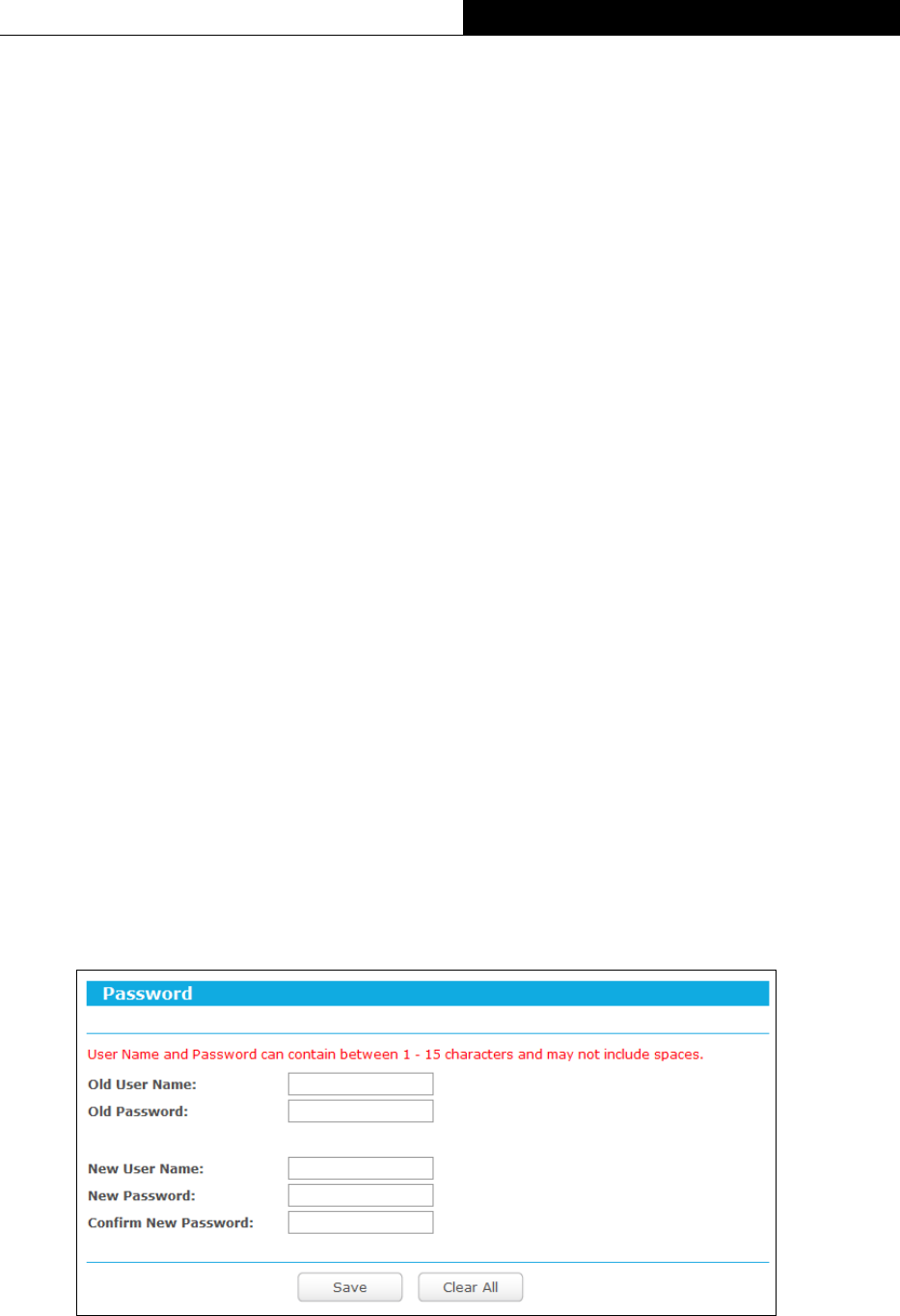
-159-
TL-WR841HP
300Mbps High Power Wireless N Router
Change the Wireless configurations.
Change the Web Management Port.
Upgrade the firmware of the router (system will reboot automatically).
Restore the router's settings to factory defaults (system will reboot automatically).
Update the configuration with the file (system will reboot automatically.
Auto Reboot Time - Here you can also reboot the router in a specific time by setting the
Auto Reboot Time. There are two options: Disable and Schedule.
Disable: If you don’t want to use this function, please choose Disable
Schedule: If you want to reboot your router at a specific time, please select Schedule.
Day: Choose Everyday, or choose Select Days and select the certain day (days) to
reboot the router.
Time: Specify the time in HHMM format for auto reboot.
Some settings of this device will take effect only after rebooting, which include:
Change the LAN IP Address (system will reboot automatically).
Change the DHCP Settings.
Upgrade the firmware of this device (system will reboot automatically).
Restore this device's settings to the factory defaults (system will reboot automatically).
Update the configuration with the file (system will reboot automatically).
5.3.6.8. Password
Go to “Setting→System Tools→Password”, and then you can change the factory default user
name and password of the router.
Figure 5-30 Password
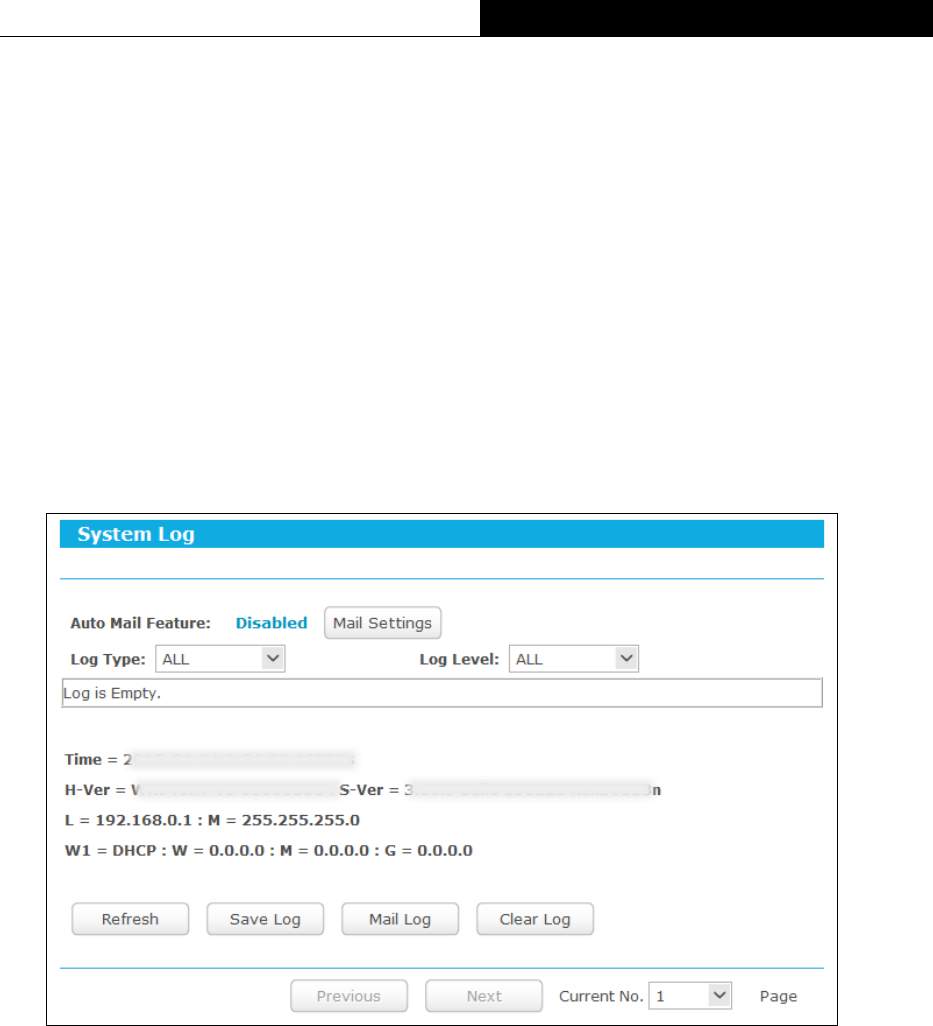
-160-
TL-WR841HP
300Mbps High Power Wireless N Router
It is strongly recommended that you should change the factory default user name and password
of the router, because all users who try to access the router's Web-based utility or Quick Setup
will be prompted for the router's default user name and password.
Note:
The new user name and password must not exceed 15 characters in length and not include any
spaces. Enter the new Password twice to confirm it.
Click the Save button when finished.
Click the Clear All button to clear all.
5.3.6.9. System Log
Go to “Setting→System Tools→System Log”, and then you can view the logs of the router.
Figure 5-31 System Log
Auto Mail Feature - Indicates whether auto mail feature is enabled or not.
Mail Settings - Set the receiving and sending mailbox address, server address, validation
information as well as the timetable for Auto Mail Feature, as shown below.
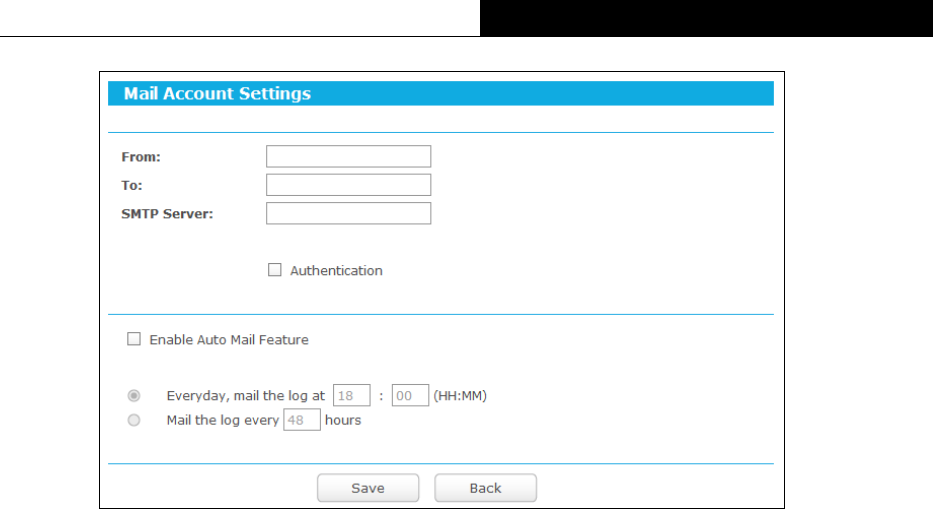
-161-
TL-WR841HP
300Mbps High Power Wireless N Router
Figure 5-32 Mail Account Settings
From - Your mail box address. The router would connect it to send logs.
To - Recipient’s address. The destination mailbox where the logs would be received.
SMTP Server - Your smtp server. It corresponds with the mailbox filled in the From
field. You can log on the relevant website for help if you are not clear with the address.
Authentication - Most SMTP Server requires Authentication. It is required by most
mailboxes that need User Name and Password to log in.
Note:
Only when you select Authentication, do you have to enter the User Name and Password
in the following fields.
User Name - Your mail account name filled in the From field. The part behind @ is
included.
Password - Your mail account password.
Confirm The Password - Enter the password again to confirm.
Enable Auto Mail Feature - Select it to mail logs automatically. You could mail the
current logs either at a specified time every day or by intervals, but only one could be
the current effective rule. Enter the desired time or intervals in the corresponding field
as shown in the last figure.
Click Save to keep your settings.
Click Back to return to the previous page.
Log Type - By selecting the log type, only logs of this type will be shown.
Log Level - By selecting the log level, only logs of this level will be shown.
Refresh - Refresh the page to show the latest log list.

-162-
TL-WR841HP
300Mbps High Power Wireless N Router
Save Log - Click to save all the logs in a txt file.
Mail Log - Click to send an email of current logs manually according to the address and
validation information set in Mail Settings.
Clear Log - All the logs will be deleted from the router permanently, not just from the page.
Click the Next button to go to the next page, or click the Previous button to return to the
previous page.
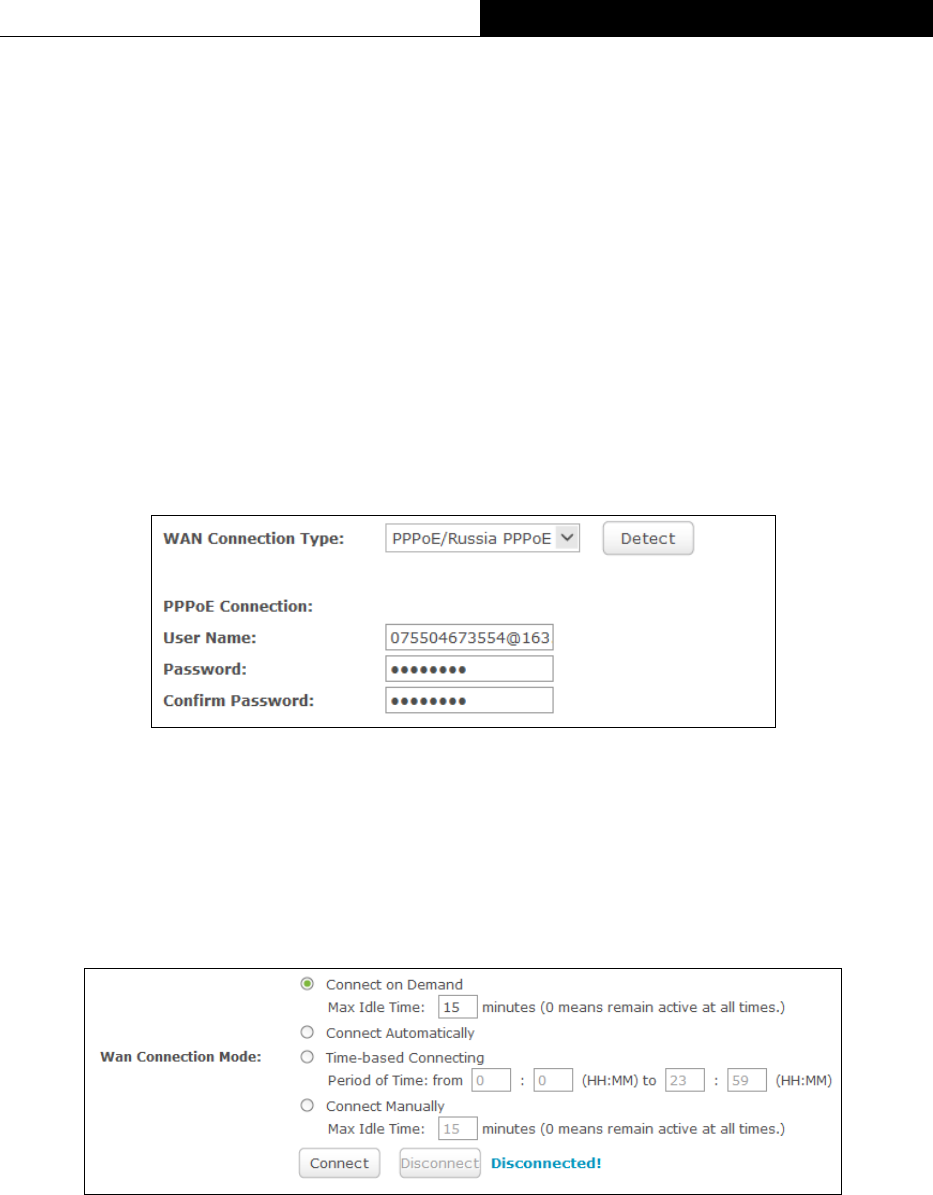
-163-
TL-WR841HP
300Mbps High Power Wireless N Router
Appendix A: FAQ
1. How do I configure the router to access Internet by ADSL users?
1) First, configure the ADSL Modem configured in RFC1483 bridge model.
2) Connect the Ethernet cable from your ADSL Modem to the Internet port on the router.
The telephone cord plugs into the Line port of the ADSL Modem.
3) Login to the router, Go to “Advanced→Network→WAN”. On the WAN page, select
“PPPoE/Russia PPPoE” for WAN Connection Type. Type user name in the “User
Name” field and password in the “Password” field, type password in the “Confirm
Password” field again, finish by clicking “Connect”.
Figure A-1 PPPoE Connection Type
4) If your ADSL lease is in “pay-according-time” mode, select “Connect on Demand” or
“Connect Manually” for Internet connection mode. Type an appropriate number for
“Max Idle Time” to avoid wasting paid time. Otherwise, you can select
“Auto-connecting” for Internet connection mode.
Figure A-2 PPPoE Connection Mode
Note:
1) Sometimes the connection cannot be disconnected although you specify a time to
Max Idle Time, since some applications is visiting the Internet continually in the
background.
2) If you are a Cable user, please configure the router following the above steps.
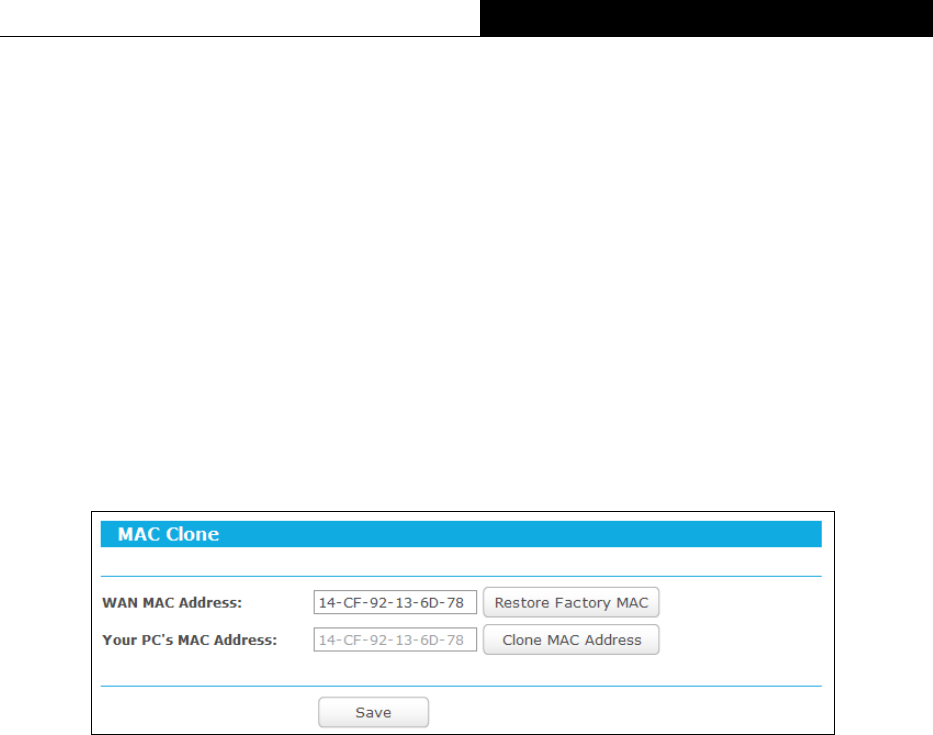
-164-
TL-WR841HP
300Mbps High Power Wireless N Router
2. How do I configure the router to access Internet by Ethernet users?
1) Login to the router, Go to “Advanced→Network→WAN”. On the WAN page, select
“Dynamic IP” for "WAN Connection Type", finish by clicking “Save”.
2) Some ISPs require that you register the MAC Address of your adapter, which is
connected to your cable/DSL Modem during installation. If your ISP requires MAC
register, login to the router and Go to “Advanced→Network→WAC Clone”. On the
"MAC Clone" page, if your PC’s MAC address is proper MAC address, click the "Clone
MAC Address" button and your PC’s MAC address will fill in the "WAN MAC Address"
field. Or else, type the MAC Address into the "WAN MAC Address" field. The format for
the MAC Address is XX-XX-XX-XX-XX-XX. Then click the "Save" button. It will take
effect after rebooting.
Figure A-3 MAC Clone
3. I want to use Netmeeting, what do I need to do?
1) If you start Netmeeting as a host, you don’t need to do anything with the router.
2) If you start as a response, you need to configure Virtual Server or DMZ Host and make
sure the H323 ALG is enabled.
3) How to configure Virtual Server: Log in to the router, Go to “Advanced→Forwarding
→Virtual Servers”. On the "Virtual Servers" page, click Add New…. Then on the
“Add or Modify a Virtual Server Entry” page, enter “1720” for the “Service Port”
blank, and your IP address for the “IP Address” blank, taking 192.168.0.169 for an
example, remember to Enable and Save.

-165-
TL-WR841HP
300Mbps High Power Wireless N Router
Figure A-4 Virtual Servers
Figure A-5 Add or Modify a Virtual server Entry
Note:
Your opposite side should call your WAN IP, which is displayed on the “Status” page.
4) How to enable DMZ Host: Log in to the router, Go to “Advanced→Forwarding→
DMZ”. On the "DMZ" page, click Enable radio button and type your IP address into the
“DMZ Host IP Address” field, using 192.168.0.169 as an example, remember to click
the Save button.
Figure A-6 DMZ
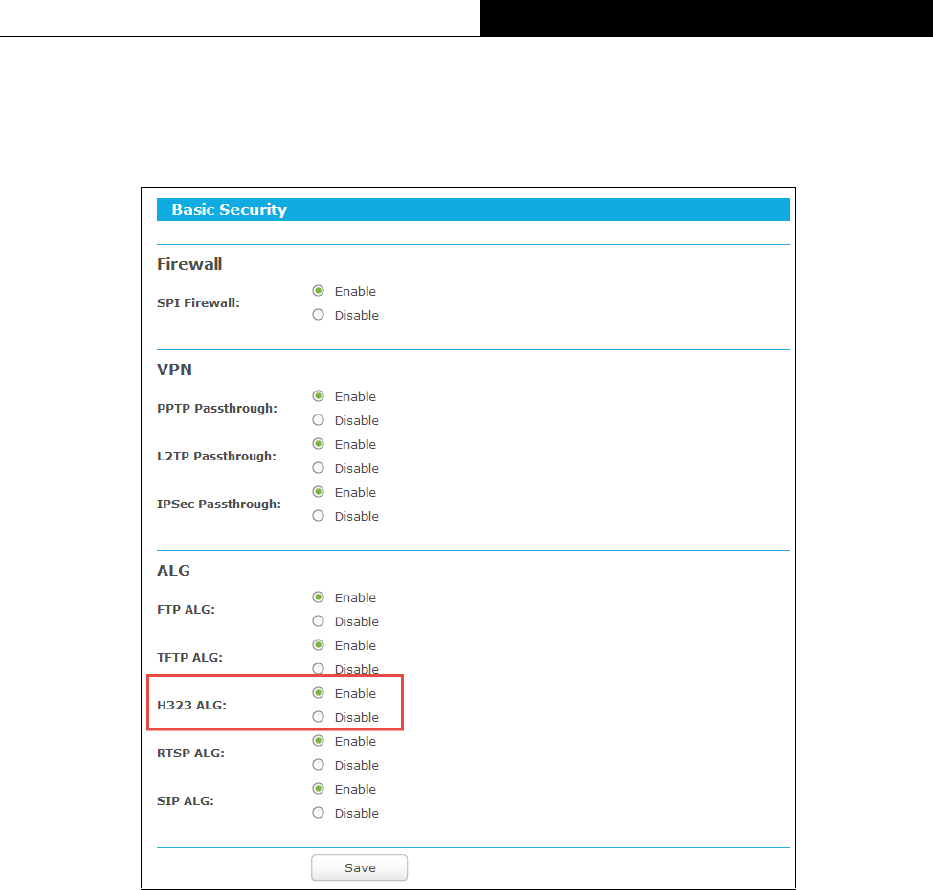
-166-
TL-WR841HP
300Mbps High Power Wireless N Router
5) How to enable H323 ALG: Log in to the router, Go to “Advanced→Security→Basic
Security”. On the “Basic Security” page, check the Enable radio button next to H323
ALG. Remember to click the Save button.
Figure A-7 Basic Security
4. I want to build a WEB Server on the LAN, what should I do?
1) Because the WEB Server port 80 will interfere with the WEB management port 80 on
the router, you must change the WEB management port number to avoid interference.
2) To change the WEB management port number: Log in to the router, Go to “Advanced
→Security→Remote Management”. On the "Remote Management" page, type a
port number except 80, such as 88, into the "Web Management Port" field. Click Save
and reboot the router.
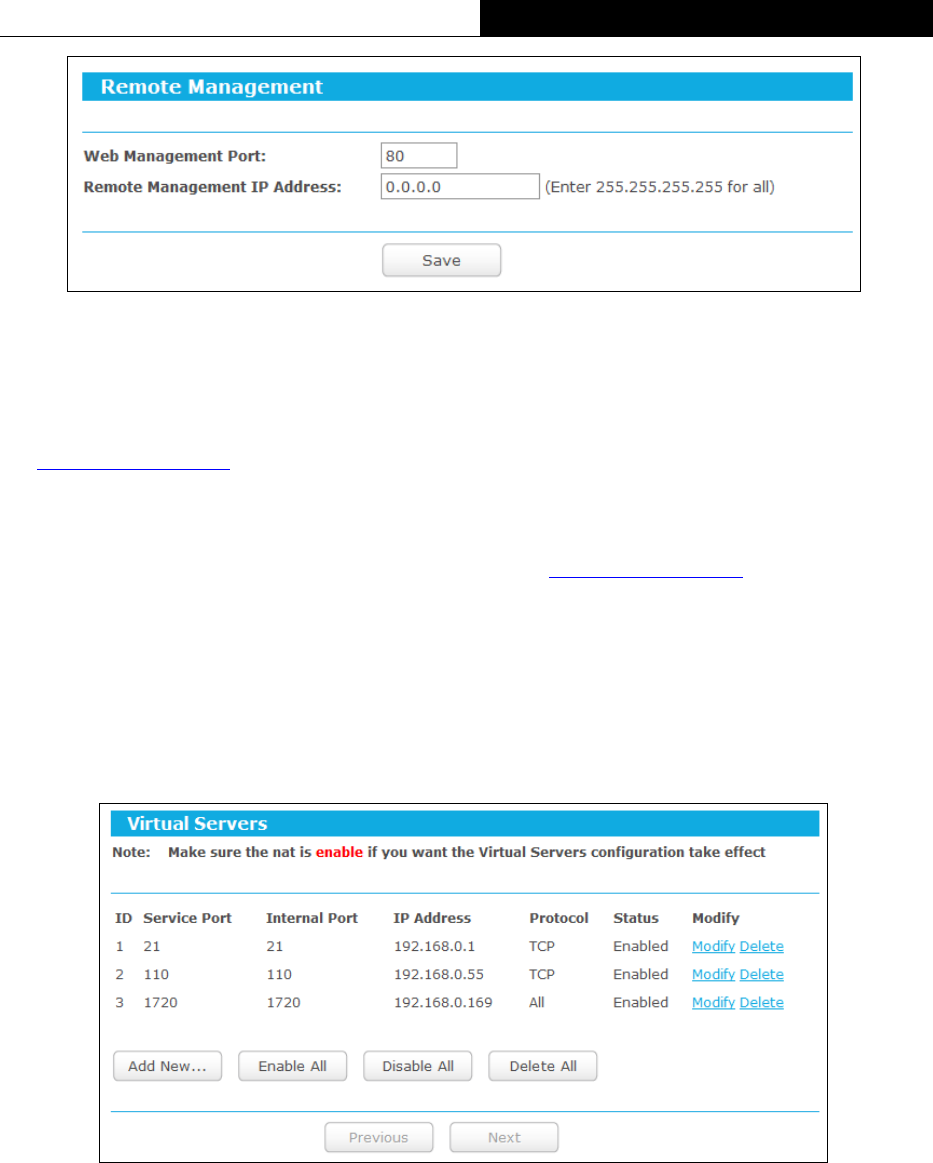
-167-
TL-WR841HP
300Mbps High Power Wireless N Router
Figure A-8 Remote Management
Note:
If the above configuration takes effect, you can visit and configure the router by typing
http://192.168.0.1:88 (the router’s LAN IP address: Web Management Port) in the address
field of the Web browser. If the LAN IP of the modem connected with your router is
192.168.0.x, the default LAN IP of the router will automatically switch from 192.168.0.1 to
192.168.1.1 to avoid IP conflict; in this case, please try http://192.168.1.1:88.
3) Log in to the router, Go to “Advanced→Forwarding→Virtual Servers”. On the
"Virtual Servers" page, click Add New…, then on the “Add or Modify a Virtual
Server” page, enter “80” into the blank next to the “Service Port”, and your IP address
next to the “IP Address”, assuming 192.168.0.188 for an example, remember to
Enable and Save.
Figure A-9 Virtual Servers
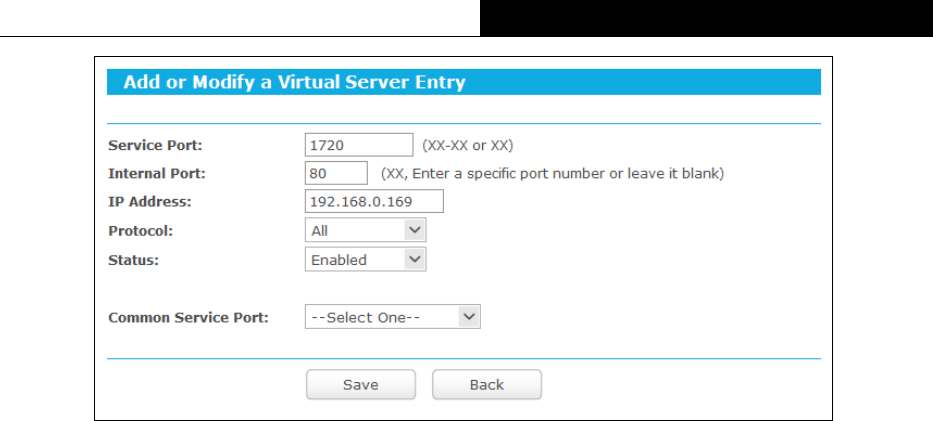
-168-
TL-WR841HP
300Mbps High Power Wireless N Router
Figure A-10 Add or Modify a Virtual server Entry
5. The wireless stations cannot connect to the router.
1) Make sure the "Wireless Router Radio" is enabled.
2) Make sure that the wireless stations' SSID accord with the router's SSID.
3) Make sure the wireless stations have right KEY for encryption when the router is
encrypted.
4) If the wireless connection is ready, but you can’t access the router, check the IP
Address of your wireless stations.
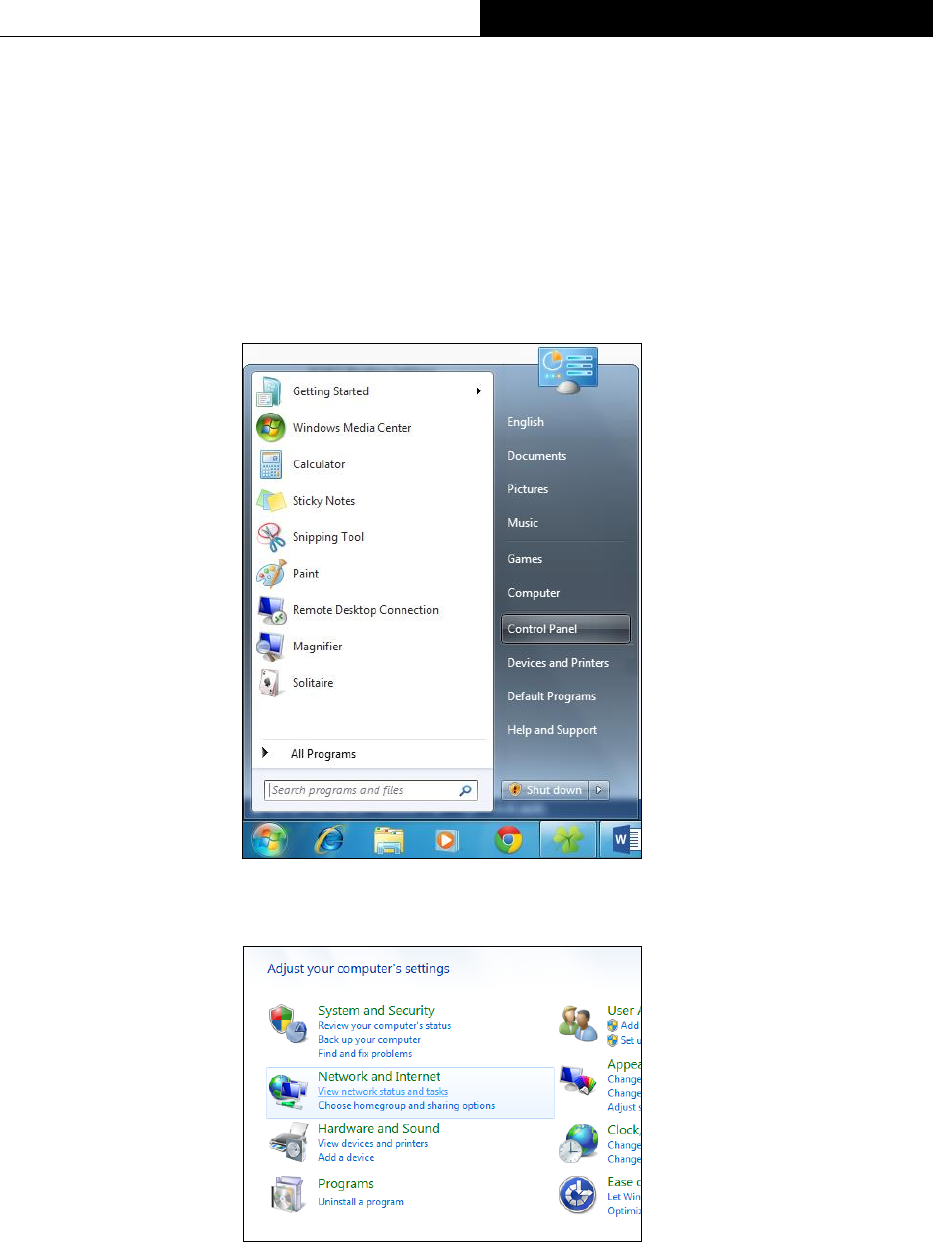
-169-
TL-WR841HP
300Mbps High Power Wireless N Router
Appendix B: Configuring the PCs
In this section, we’ll use Windows 7 as an example to introduce how to install and configure the
TCP/IP correctly. First make sure your Ethernet adapter is working, refer to the adapter’s
manual if needed.
1. Install TCP/IP component
1) On the Windows taskbar, click the Windows icon, and then select Control Panel.
Figure B-0-1
2) Click on View network status and tasks under Network and Internet.
Figure B-0-2
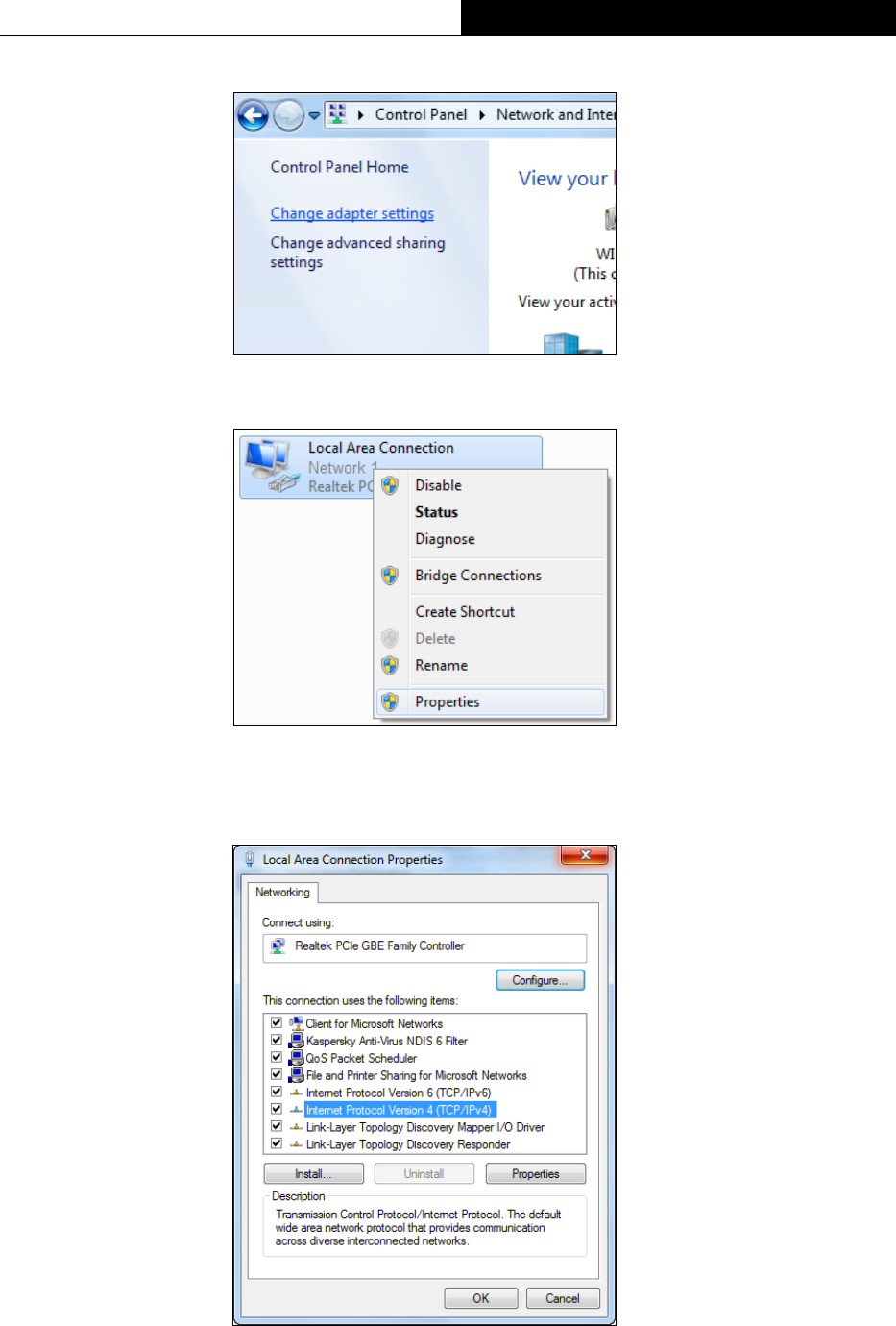
-170-
TL-WR841HP
300Mbps High Power Wireless N Router
3) Click on Change adapter settings.
Figure B-0-3
4) Right-click Local Area Connection, and then select Properties.
Figure B-0-4
5) In the Local Area Connection Properties window, click on Internet Protocol Version 4
(TCP/IPv4).
Figure B-0-5
6) Select Obtain an IP address automatically and Obtain DNS server address
automatically.
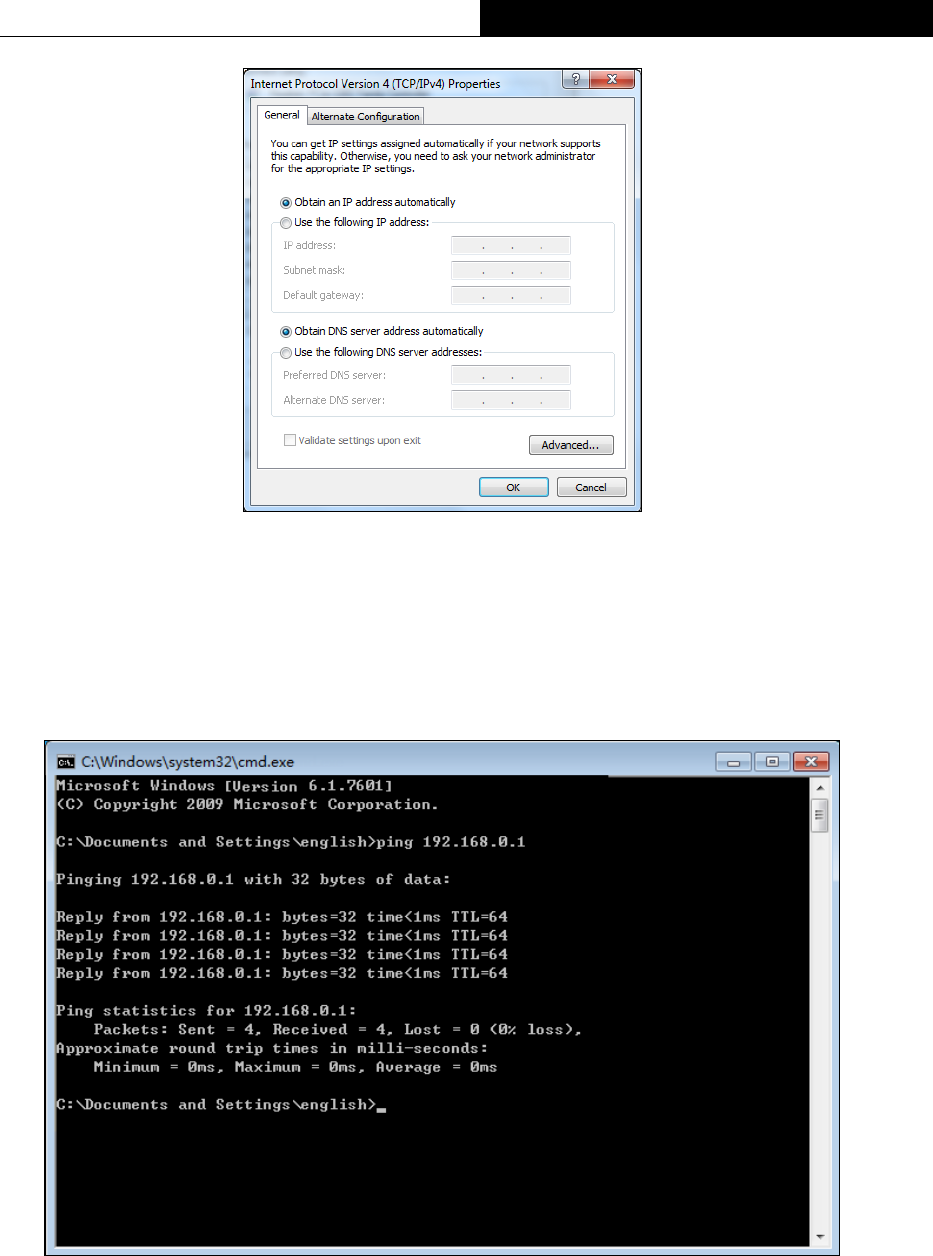
-171-
TL-WR841HP
300Mbps High Power Wireless N Router
Figure B-0-6
2. Verify the network connection between your PC and the router
Open a command prompt, and type ping 192.168.0.1, and then press Enter.
If the result displayed is similar to the Figure B-4, it means the connection between your PC
and the router has been established well.
Figure B-4 Success result of Ping command
If the result displayed is similar to Figure B-5, it means the connection between your PC
and the router failed.
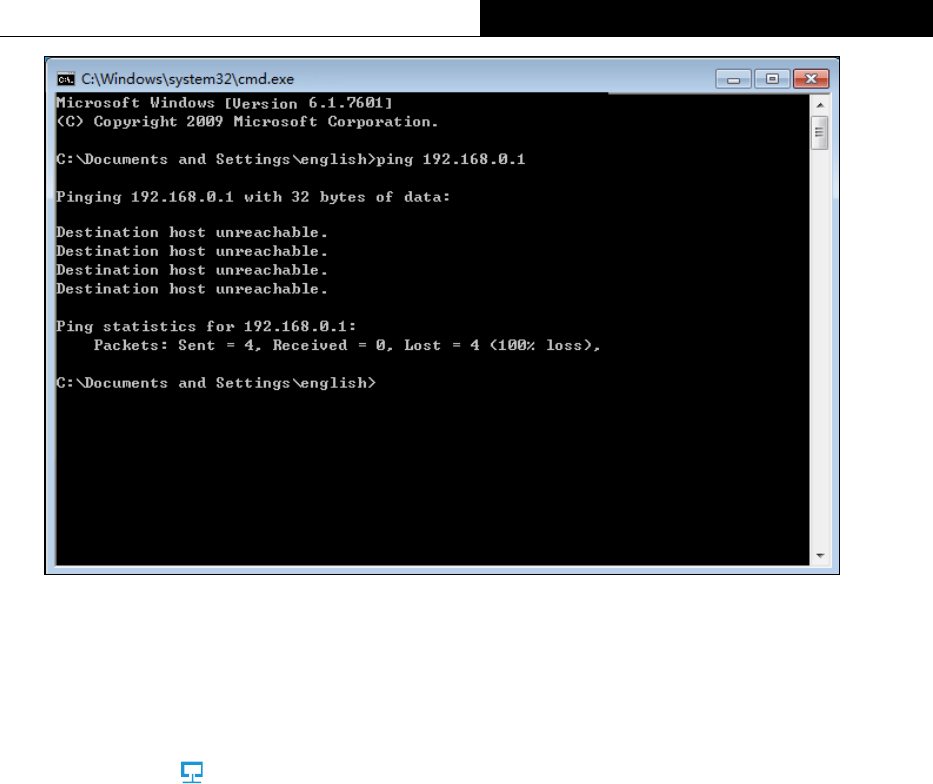
-172-
TL-WR841HP
300Mbps High Power Wireless N Router
Figure B-5 Failure result of Ping command
Please check the connection following these steps:
4. Is the connection between your PC and the router correct?
Note:
The Ethernet LED on the router and LEDs on your PC's adapter should be lit.
5. Is the TCP/IP configuration for your PC correct?
Note:
If the router's IP address is 192.168.0.1, your PC's IP address must be within the range of
192.168.0.2 ~ 192.168.0.254.
6. Is the default LAN IP of the router correct?
Note:
If the LAN IP of the modem connected with your router is 192.168.0.x, the default LAN IP of the
router will automatically switch from 192.168.0.1 to 192.168.1.1 to avoid IP conflict. Therefore,
in order to verify the network connection between your PC and the router, you can open a
command prompt, and type ping 192.168.1.1, and then press Enter.

-173-
TL-WR841HP
300Mbps High Power Wireless N Router
Appendix C: Specifications
General
Standards
IEEE 802.11g、IEEE 802.11b、IEEE 802.11n、IEEE 802.3、IEEE
802.3u、IEEE 802.3x、IEEE 802.1X、IEEE 802.11e、IEEE 802.11i
Protocols
TCP/IP, PPPoE, DHCP, ICMP, NAT, SNTP
Ports
One 10/100M Auto-Negotiation WAN RJ45 port, Four 10/100M
Auto-Negotiation LAN RJ45 ports supporting Auto MDI/MDIX
Cabling Type
10BASE-T: UTP category 3, 4, 5 cable (maximum 100m)
EIA/TIA-568 100Ω STP (maximum 100m)
100BASE-TX: UTP category 5, 5e cable (maximum 100m)
EIA/TIA-568 100Ω STP (maximum 100m)
LEDs
PWR, SYS, WLAN, LAN (1-4), WAN, WPS
Safety & Emissions
FCC
Wireless
Frequency Band
2.4~2.4835GHz
Radio Data Rate
11n:up to 300Mbps(Automatic)
11g:54/48/36/24/18/12/9/6M(Automatic)
11b:11/5.5/2/1M(Automatic)
Frequency Expansion
DSSS (Direct Sequence Spread Spectrum)
Modulation
BPSK, QPSK, CCK, OFDM, 16-QAM, 64-QAM
Security
WEP/WPA/WPA2/WPA2-PSK/WPA-PSK
Sensitivity @PER
270M: -68dBm@10% PER
130M: -68dBm@10% PER
108M: -68dBm@10% PER
54M: -68dBm@10% PER
11M: -85dBm@8% PER
6M: -88dBm@10% PER
1M: -90dBm@8% PER
Antenna Gain
7.5
dBi * 2
Environmental and Physical
Temperature
Operating : 0℃~40℃ (32℉~104℉)
Storage: -40℃~70℃(-40℉~158℉)
Humidity
Operating: 10% - 90% RH, Non-condensing
Storage: 5% - 90% RH, Non-condensing

-174-
TL-WR841HP
300Mbps High Power Wireless N Router
Appendix D: Glossary
802.11n - 802.11n builds upon previous 802.11 standards by adding MIMO (multiple-input
multiple-output). MIMO uses multiple transmitter and receiver antennas to allow for increased
data throughput via spatial multiplexing and increased range by exploiting the spatial diversity,
perhaps through coding schemes like Alamouti coding. The Enhanced Wireless Consortium
(EWC) [3] was formed to help accelerate the IEEE 802.11n development process and
promote a technology specification for interoperability of next-generation wireless local area
networking (WLAN) products.
802.11b - The 802.11b standard specifies a wireless networking at 11 Mbps using
direct-sequence spread-spectrum (DSSS) technology and operating in the unlicensed radio
spectrum at 2.4GHz, and WEP encryption for security. 802.11b networks are also referred to
as Wi-Fi networks.
802.11g - specification for wireless networking at 54 Mbps using direct-sequence
spread-spectrum (DSSS) technology, using OFDM modulation and operating in the
unlicensed radio spectrum at 2.4GHz, and backward compatibility with IEEE 802.11b devices,
and WEP encryption for security.
DDNS (Dynamic Domain Name System) - The capability of assigning a fixed host and
domain name to a dynamic Internet IP Address.
DHCP (Dynamic Host Configuration Protocol) - A protocol that automatically configure the
TCP/IP parameters for the all the PC(s) that are connected to a DHCP server.
DMZ (Demilitarized Zone) - A Demilitarized Zone allows one local host to be exposed to the
Internet for a special-purpose service such as Internet gaming or videoconferencing.
DNS (Domain Name System) - An Internet Service that translates the names of websites into
IP addresses.
Domain Name - A descriptive name for an address or group of addresses on the Internet.
DSL (Digital Subscriber Line) - A technology that allows data to be sent or received over
existing traditional phone lines.
ISP (Internet Service Provider) - A company that provides access to the Internet.
MTU (Maximum Transmission Unit) - The size in bytes of the largest packet that can be
transmitted.
NAT (Network Address Translation) - NAT technology translates IP addresses of a local area
network to a different IP address for the Internet.
PPPoE (Point to Point Protocol over Ethernet) - PPPoE is a protocol for connecting remote
hosts to the Internet over an always-on connection by simulating a dial-up connection.

-175-
TL-WR841HP
300Mbps High Power Wireless N Router
SSID - A Service Set Identification is a thirty-two character (maximum) alphanumeric key
identifying a wireless local area network. For the wireless devices in a network to
communicate with each other, all devices must be configured with the same SSID. This is
typically the configuration parameter for a wireless PC card. It corresponds to the ESSID in
the wireless Access Point and to the wireless network name.
WEP (Wired Equivalent Privacy) - A data privacy mechanism based on a 64-bit or 128-bit or
152-bit shared key algorithm, as described in the IEEE 802.11 standard.
Wi-Fi - A trade name for the 802.11b wireless networking standard, given by the Wireless
Ethernet Compatibility Alliance (WECA, see http://www.wi-fi.net), an industry standards
group promoting interoperability among 802.11b devices.
WLAN (Wireless Local Area Network) - A group of computers and associated devices
communicate with each other wirelessly, which network serving users are limited in a local
area.